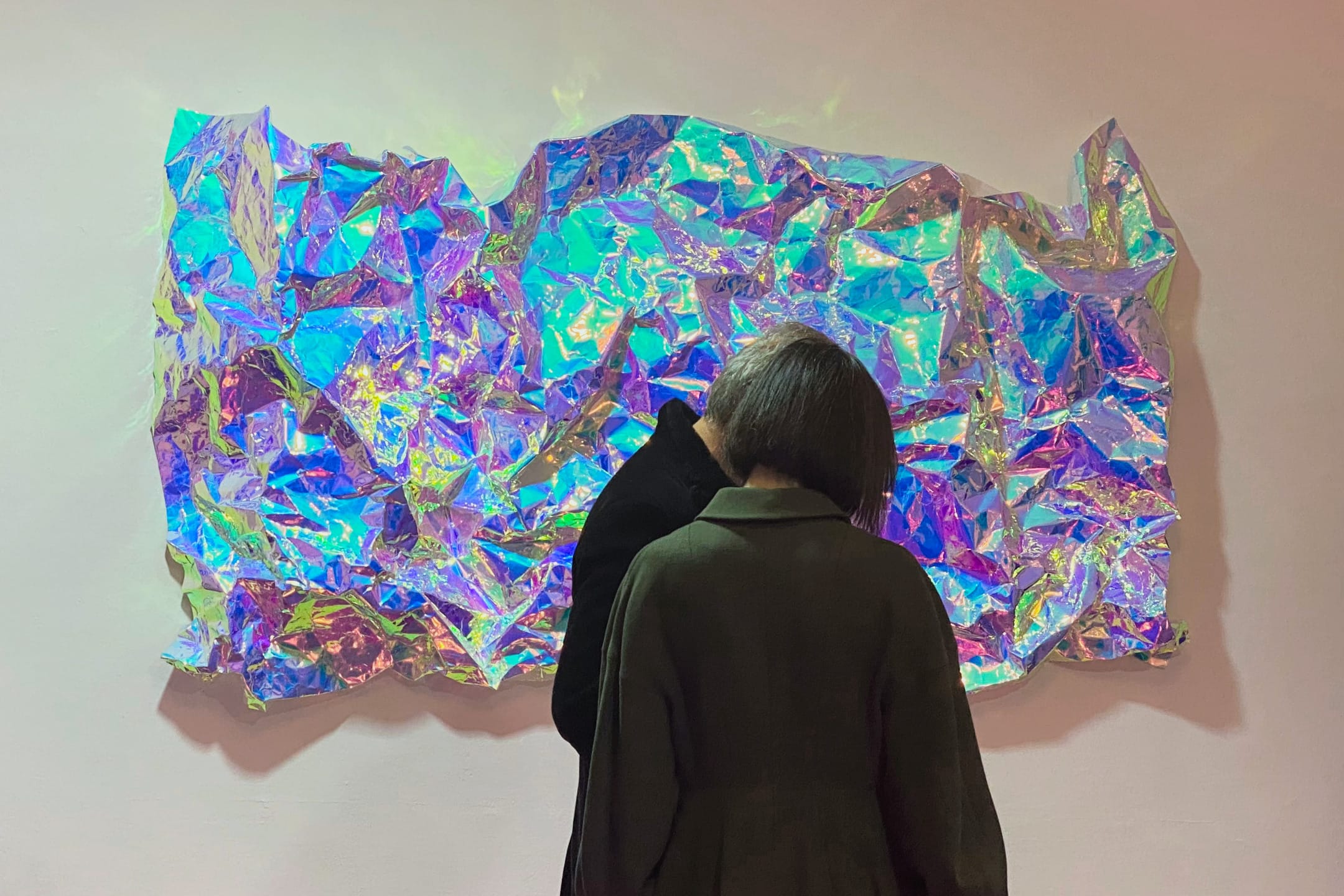
SIGNS OF THE TIMES
CURATED BY JÉRÔME SANS
APALAZZO GALLERY, BRESCIA, ITALY, 2022
:MENTALKLINIK, JOËL ANDRIANOMEARISOA, ANDREAS ANGELIDAKIS, ROMAIN BERNINI, THOMAS LÉLU, LIN ZHIPENG (NO.223) AND LUNA PAIVA
NOVEMBER 20TH, 2021-FEBRUARY 5TH, 2022
:mentalKLINIK, JOEL ANDRIANOMEARISOA, ANDREAS ANGELIDAKIS, ROMAIN BERNINI, THOMAS LELU, LIN ZHIPENG, MIKA ROTTENBERG, LUNA PAIVA
Recent events that have plunged the world into a state of global uncertainty have proven that universal truth does not exist. Our societal model, which seemed to be unanimous, turns out to be a fragile chessboard that can be shaken at any time. If, after the pandemic crisis, the world seems to have resumed its usual course and its appearance of yesteryear, the background of everyone's thoughts has inevitably changed and the signs have also evolved. It is no longer the individual who constructs his environment but the environment that defines us as human beings.
The Signs of The Times exhibition aims to put the territory of these plural questions into perspective. How to decipher and appropriate from now on the new signs emitted by our environment under this uncertain horizon? As the collision between our civilization and the limits imposed by nature becomes more and more visible, how to reconcile the lightness of the simple pleasures of the present moment with the global consciousness of our time?
By demonstrating a critical spirit, the artists brought together in this exhibition approach with a radical imagination these existential, political and societal questions which animate our experience of the current world. Under the sign of the mirage but also of semantics and the power of infinite reproduction, the exhibition offers multiple universes flirting in an uninhibited way with the anxiety of an uncertain future. Beyond their immediate expressive power, the works underlyingly address some of our most pressing current issues: global warming, the rewriting of history, the growing number of those left behind, the challenges of the younger generation faced with a consumerist society, the flood of information messages, unbridled individualism... it is not a question here of giving solutions or answers to these problems, the works tackle in a frontal way this mutation of the signs in progress. And, in our world of images, they are, in fact, an active force.
By confronting us with our consumption habits, :mentalKLINIK dismantles common materials to create an alluring new aesthetic form. Their universe can be experienced as festive and glamorous, but also surprising, abrasive, violent and nostalgic like an after party angst. A whole work of encryption suspended between the true and the false, as in the work of Luna Paiva who gilds or casts in bronze everyday and popular objects. She transforms the bottom up, giving the banality of common objects new value and identity, like so many shimmering markers of our time. The question of the production of value is developed in the disturbing video stories of Mika Rottenberg, motivated by the inequalities of our global economy, the absurd working conditions and the fragility of the human body,
A figurehead of new Chinese photography, Lin Zhipeng (No. 223) reflects a certain spirit of unconventional Chinese millennial youth. Mixing love and chaos, fantasy and eroticism, his photographs act as a poetic diary of this generation eager to escape social pressures and aspire to the pleasures of life in an indifferent and constantly changing society. Also inspired by utopian ideals, Thomas Lélu's declarations on cardboard reactivate the spirit of contestation of fusion between art and life, when art takes to the streets. With irony, he hijacks these counter-culture attitudes with slogans specific to our time, soaking up daily life and our individual and social behavior.
A metaphor for fragility as an essential vital force, the elegant collages and meanders of paper by Joël Andrianomearisoa form monochrome landscapes in permanent motion that become a total opera of ethereal architectures. From one story to another, Athens by Night (2021) by Andreas Angelidakis transforms a journey through the remains of the ancient city into an immersive environment, questioning the history of Athens in the face of other possible futures. Like so many archaeological fragments of Greek marble, the modules of foam cushions are multiplied in copies of themselves, movable, stackable and lend themselves to the free interpretation of visitors as in a collective construction game to reconstruct a common world. The changing world that is in motion in the paintings of Romain Bernini: between wandering, shifting and trembling, his psychedelic paintings are the beginnings of contemporary mythologies between symbols and spiritual worlds. His search for an ecstatic relationship with nature begins with his Trees whose iridescence remains unclear: is it a proliferation of chemicals, pollution, or self-generated irradiation as a substance for their survival? ?
Thus, the exhibition, bringing together French, Turkish, Greek, Chinese or Argentinian artists, becomes a cultural mosaic, a reflection of our contemporary era, beyond borders, areas of creation, but also generational differences. Through all these new images of the man touched by doubt, these artists very rightly affirm that uncertainty is a driving force for collectively preparing for the future.
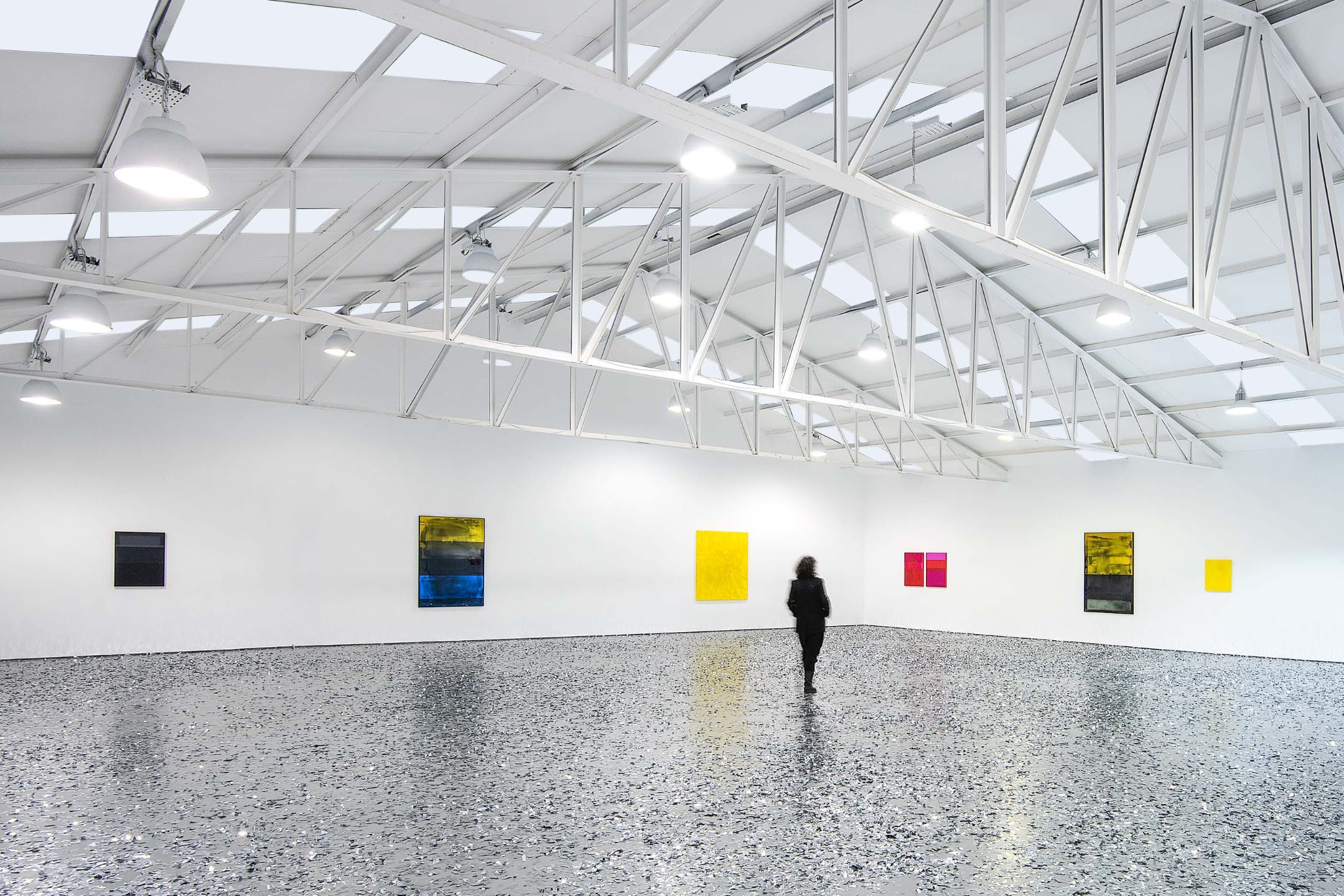
HYPERMOODY,
SABRINA AMRANI GALLERY, MADRID, 2022
FEBRUARY 19TH -MARCH 26TH, 2022
CHRISTIAN VIVEROS-FAUNÉ
Art is HYPERMOODY: The World According to :mentalKLINIK
How can art lie when the reality is not true enough?
—:mentalKLINIK
Raise your hand if you’re tired of art being the handmaiden of finance capital.
Since the time of the Medicis—and the black plague—art has historically functioned as a site of wealth, patronage, and social stratification. Simultaneously, it has also established alternative arenas for ideas, conflict, and experimentation separate from the demands of capital. Until recently, that is, when the incomplete if seemingly ineluctable process of cultural absorption of art by high and alternative finance was radically supercharged.
In 2021, as the world fought to shake off the deadly effects of COVID-19, a newly rapacious instrumental logic took hold. In the shadows of what President Joe Biden termed a global “cascade of crises,” art moved ever closer to pure commodity status (as a crypto-currency), Sotheby’s achieved an all-time record $7.3 billion of luxury goods sold in a single year, and—as the annus horribilis waned—Melania Trump floated her first NFT (titled “Melania’s Vision,” the digital “watercolor” of her grifting gaze retails at $150 a pop). In the words of critic James Rushing Daniel, while everyone slept, tens of thousands “bankers, financiers, hedge fund managers, crypto bros, promoters, collectors, and at times artists themselves aggressively vacated art’s political projects, abstracted it from labor, and transmogrified it into a format ideal for trading and speculation.” An important side effect of these developments: contemporary art has become even more uniquely representative not just of money but greed itself—this despite many artists’ overt political critique and messaging.
Enter the Turkish-born, Brussels-based artist duo of Yasemin Baydar and Birol Demir, a.k.a. :mentalKLINIK. Together since 1998, the pair has long tracked the financial world’s desire to turn art into frictionless commodities, while remaining uniquely attuned to the informational farrago behavioral economist Herbert A. Simon christened “the attention economy.” The duo’s métier is best described as an open laboratory process. Production, presentation, and authorship shift and morph, especially when projects involve additional creators or thinkers. According to supercurator Jerome Sans, the group’s strange moniker alludes “to the laboratory where practice and theory coexist, as the mind (:mental) refers to the mind, and the KLINIK to the practice.” Per the artists, they say they have merely learned to conceive of themselves (and their collaborators) as something more perverse and obstreperous—“counter-cooperators.”
At Madrid’s Sabrina Amrani gallery, the duo continues its ongoing campaign of non-compliance by introducing new aesthetic objects and experiences that above all prize an unending stream of heterogeneous and unconventional materials. To this end the artists focus on humanity’s reptilian attraction to glittering and seductive surfaces to invoke commodity fetishism—the idea that manufactured objects, like talismans, possess sacred or supernatural powers—while also underscoring the planet’s ubiquitous iPhone zeitgeist: the slippery, gleaming, mirrored surface of data-driven consumption and capital accumulation that characterizes our present age. The duo also specializes in symbolic experiences of the sort epitomized by Sculptor Richard Serra’s much quoted but rarely acknowledged phrase: “If it’s free, you’re the product.” The précis of the short Nixon-era film titled Television Delivers People, Serra’s quote, like :mentalKLINIK’s oeuvre, delivers discordant cultural universes in a nutshell.
In their latest exhibition, oxymoronically titled HYPERMOODY to underscore the split between life as lived and as advertised, :mentalKLINIK harnesses, among other materials, tempered glass, polished aluminum panels, water-based emulsion, silver confetti, robot vacuum cleaners, audio inspired by “slime ASMR” (the term refers to the involuntary tingle, or “autonomous sensory meridian response,” derived from sounds made by things going “squish”) and air diffusers spritzing champagne scented essence, collaboration with the high-concept molecular parfumerie Aether. Besides turning the tables on the use of art by major luxury brands—think Jay-Z and Beyoncé posing in front of Basquiat’s Equals Pi (1982) for Tiffany, and skin-care giant La Prairie commissioning French artist Maotik to confect installations for art fairs—:mentalKLINIK mobilizes these and other elements to create an object-laden, digitally-aided, gallery-wide sensorium. The environment’s ostensible payload: dozens of paintings that, in point of fact, are not (conventional) paintings at all.
Foursquare wall-hanging objects the artists have dubbed “showoff paintings,” each series presents the medium not as an age-old radical métier but as the cliché of an art market commodity—while sarcastically evoking tiny variations animating several decades of abstract painting styles. There are the “Wet Paintings” (transparent resin pours on sheets of tempered glass), the “Soft Paintings” (polyester woven fabric mounted onto canvas or constituting its own support), the “Dirty Mirror Paintings” (glass surfaces printed and mirrored with Mark Rothko-like horizons), the “Hyper-Chromatic Madness Paintings” (bent polyester solar film made to look like crumpled metal) and, last but not least, the “Disgustingly Awful Paintings” (everything-and-the-kitchen-sink compositions made with resin and glitter on aluminum). As a final flourish to finger our golden age of vapid financialized excess the artists deploy several pounds of confetti—signaling either carnival’s end or, lamer still (cue The Velvet Underground & Nico), all tomorrow’s parties.
Taken together, the entire exhibition resembles a Xanadu-like pleasure palace, a gleaming showroom floor so exclusive it resembles a Maserati dealership or a super-premium art fair like Art Basel Miami Beach—the trade show that, arguably, kicked off the beginning of the end of art and the start of the art market. It’s no accident that :mentalKLINIK should look to echo this and similar sales platforms: after all, they remain staging grounds for art’s cooptation by entertainment, celebrity, screen culture, and high and alternative finance. Just before the COVID-19 pandemic a young American artist named Nikita Gale portrayed ABMB in terms that, not so accidentally, also describes this :mentalKLINIK exhibition perfectly: “It’s like being inside of Instagram. . . . It feels like everything’s compressed in a bizarre way. Art, commerce, capitalism, celebrity culture, beach culture, party culture. It’s pretty surreal.”
Christian Viveros-Fauné, Brooklyn 2021
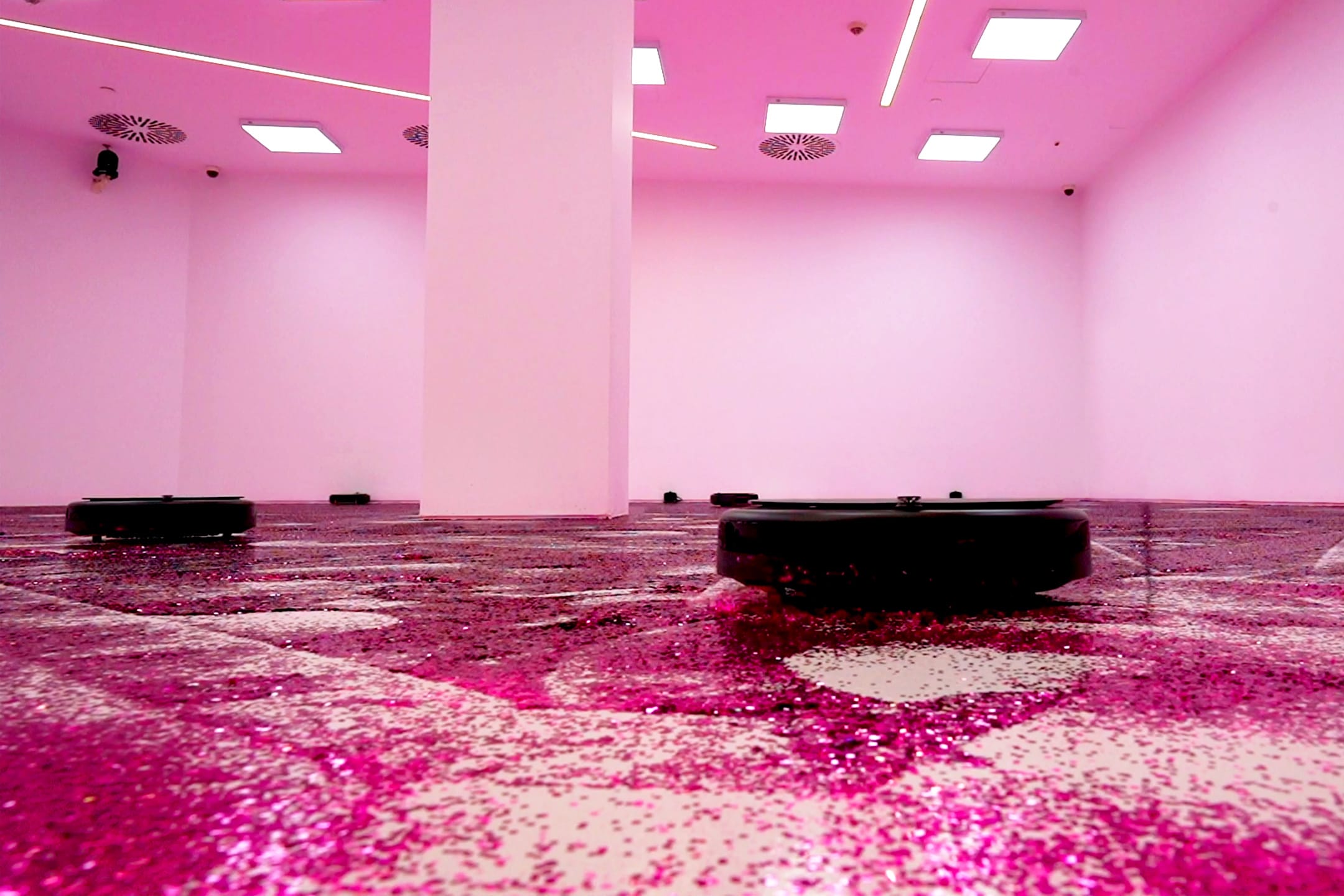
BITTER MEDICINE #02
CURATOR: NECMİ SÖNMEZ
BORUSAN CONTEMPORARY
SEPTEMBER 17, 2020- JANUARY 31, 2021
LIVE STREAM, 7/24 @ BORUSANCONTEMPORARY.COM
A Bitter Medicine for the Pandemic Conditions at Borusan Contemporary
Borusan Contemporary will greet the new season with BITTER MEDICINE #02, presented by the artist duo :mentalKLINIK as a prescription for the art world pushed to make drastic changes under the circumstances created by the COVID-19 pandemic. The exhibition reveals an urgent perspective on the precautions taken for the sake of protecting public health and is an infinite and unrepeated movement of a performative installation that streams onto the digital realm 24/7 from Borusan Contemporary.
Borusan Contemporary present BITTER MEDICINE #02 by the artist duo :mentalKLINIK (Yasemin Baydar, Birol Demir)—established in Istanbul in 1998 and who continue their work both in İstanbul and in Brussels, Belgium—, a prescription for the art world pushed to make drastic changes under the circumstances created by the COVID-19 pandemic. The work will be launched on September 17, 2020.
The exhibition includes the site-specific installation Puff Out, installed in the main gallery space of the Haunted Mansion, and streamed live 24/7 through Borusan Contemporary’s website and social media channels. As the Haunted Mansion will be closed for visits for a while due to the public health precautions, this performative installation, which is transformed into a virtual, choreographic video narrative using moving camera systems, will be on view for art viewers around the world.
Live Streaming on Istiklal Avenue from the Borusan Music House.
The exhibition, highlighting the transformative impact of the pandemic on art as well as the emphasis Borusan Contemporary places on new forms of contemporary art, presents a new visual experience for the viewers. A new perspective on the relationship between space-artwork-viewer, which has changed under the current circumstances, is offered. Curated by Dr. Necmi Sönmez, BITTER MEDICINE #02 will also be broadcasted on the screen installed in the window of Borusan Music House on Istiklal Avenue, 24/7.
Infinite and Unrepeated motion
The installation Puff Out, which is made up of 8 robot vacuums and glitter, constitutes the exhibition, which will stream onto the digital platforms live from the Haunted Mansion, creating an infinite and unrepeated motion. The momentary and striking patterns created by the mission-oriented and autonomous motion of the robots on the colorful, shiny surface created by glitter, is going to be relayed online simultaneously through systems of live broadcasting, and the viewers will be able to follow the installation digitally.
This “micro-climate” that :mentalKLINIK created at the intersection of various art forms including drawing, painting, installation, sculpture, performance, and video art, is striking in its presentation of a novel look at that “sate of ambiguity” that we are confronted with today. The exhibition refers to the shifting rhythm of contemporary life, cracking open the door on a different “world” shaped by lights that emerge suddenly and quickly. This visual journey succeeds in drawing in the viewers to the midst of “hyperrealism”, abstracted from spatial elements and thus brings up the strongest tool of digital aesthetics, the sensibility of “new beauty”.
The exhibition will last until January 31
BITTER MEDICINE #02 is a productive, questioning, provocative gesture against the ambiguity created by today’s surveillance technologies, data-driven precarious lives, technology, and service-oriented subjectivities.
Designed as a series, the first version of the Bitter Medicine project was installed at the gallery space of Belgrade Contemporary Art Museum, which was closed due to public health concerns, and streamed live 24/7 on the museum’s website between May 5-June 30, 2020.
The exhibition will be streamed live 24/7 on the website and social media accounts of Borusan Contemporary between September 17, 2020, and January 31, 2021.
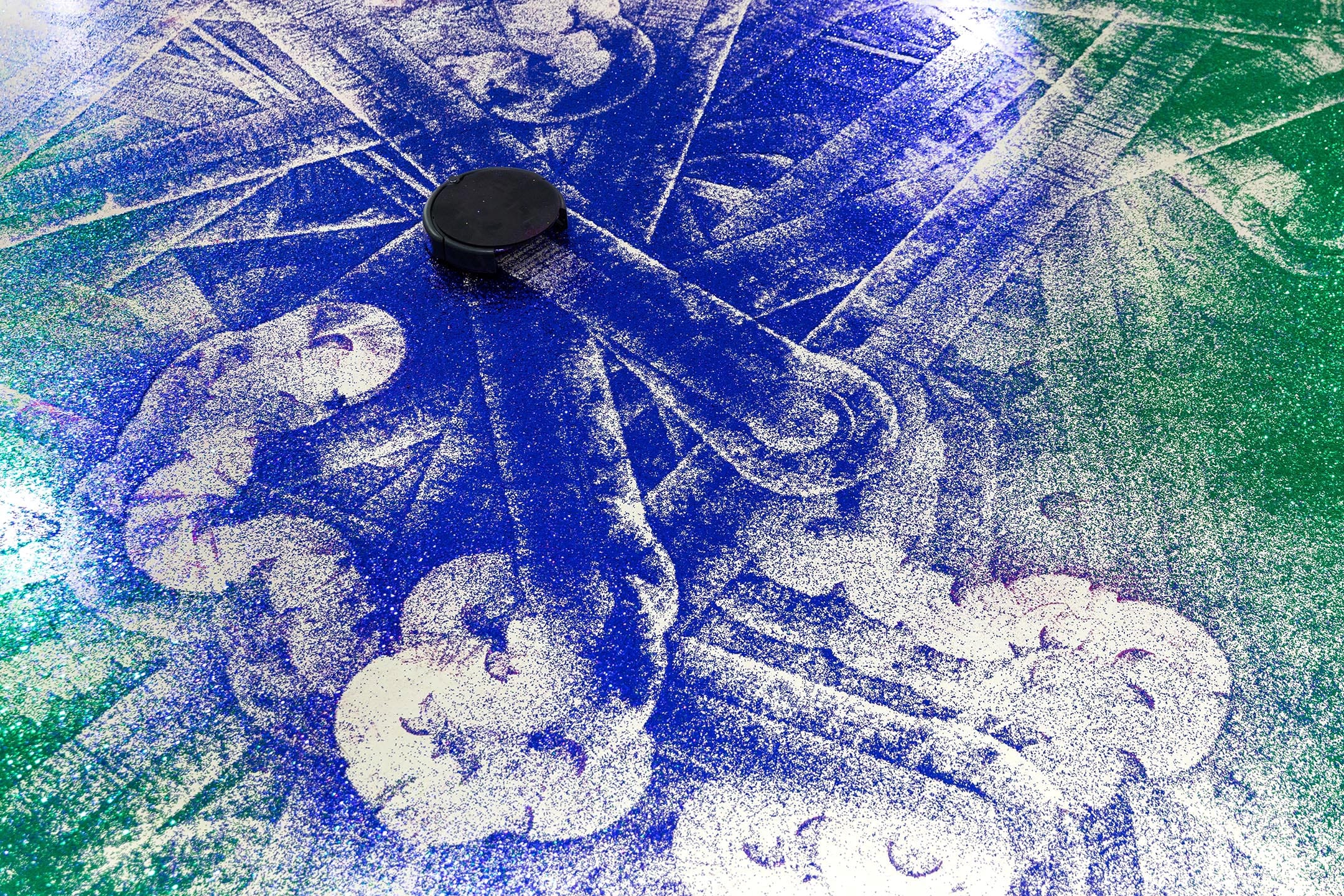
BITTER MEDICINE #01
CURATOR: CARL DE SMET
MUSEUM OF CONTEMPORARY ART IN BELGRADE (MOCAB)
MAY 06 - JUNE 07, 2020
LIVE STREAM, 7/24 @ HTTPS://ENG.MSUB.ORG.RS/
PUFF OUT is a Bitter Medicine to museums under lockdown, initiated by the artist duo :mentalKLINIK and curated by Carl De Smet for the Museum of Contemporary Art of Belgrade as the first host.
As we are now more online than ever, :mentalKLINIK offers us a bitter pill to fill the abysmal void of the emptied-out, shuttered museums. :mentalKLINIK’s PUFF OUT installation is made to be physically set in the premises of the museum, but extended onto digital platforms.
The scene is devoid of humans and occupied by six robot hoovers, programmed to detect dust in a room covered with heaps of glitter particles. Creating their own drawings and spreading the glitter throughout the empty space, they create an after- party atmosphere that celebrates the maxim: “Nothing will remain the same”.
Over-stimulated, chasing every speck of glitter, the hoovers are filmed and broadcasted live at all times on the museum’s website. As they twirl tirelessly in real time and the footage streams non-stop, a spatial dialectic emerges, redefining the concepts of viewership, exhibition-making and museum-going. This migration to the web overcompensates for a broken reality – one that can be observed via museum websites, catering to a collective voyeuristic instinct.
BLACK SWAN IS FLOATING IN THE ART WORLD. ARE YOU READY TO TAKE THE BITTER MEDICINE BY :MENTALKLINIK?

_ccidRnt
docu:mentalKLINIK, 2007
COLOPHON 2007, LUXEMBOURG
This issue is a collector’s item
Only 500 copies are published.
The issue questions what docu:mentalKLINIK is and how it works by means of the issue’s concept _ccidRnt, in the form of a fiction interview.
_Who are the founders of docu:mentalKLINIK?
We found it. It was an attempt on our side to expand mentalKLINIK. We have a broad range of interests and we found docu:mentalKLINIK in order to cover subjects that we could not as :mentalKLINIK. Our personal sensitivities urge us to carry our journey through a variety of disciplines, to think about different issues.
_What made you decide to attend COLOPHON 2007?
docu:mentalKLINIK can only be realized inside a publication, printed or digital. 15000 magazines from all over the world are attending Colophon 2007. Therefore this is a once in a lifetime opportunity we do not want to miss.
_What is your COLOPHON issue about?
Actually we decided that our Colophon issue should be about ourselves as much as the issue’s main concept. This issue elaborates on the concept of _ccidRnt.
_Why this concept?
We find such questions very cliché and passé.
…..
_Would you care for some more tea and biscuits?
Is she offended?
_How big is your team?
We don’t care about the quantity; quality is what matters for us.
_Are you a magazine / do you consider yourself to be a magazine?
No.
_What are you then?
We believe that if you read our introduction text ‘the meaning of docu:mentalKLINIK’ in detail, this will answer your question.
I believe she did not read our text…
By the way we hate the gendered 3rd person singular pronouns…
I am not actually sure if we included it in our COLOPHON issue…
I can’t remember either …
We should have…
Otherwise people will think we are just another magazine and they will not take us seriously…”
_What are the difficulties you are confronted with?
So far we did not experience any difficulties. We don’t like complaining, we would rather do our best to continue.
_What would be “the” thing to improve your magazine?
Actually as we have mentioned before, we do not define docu:mentalKLINIK as a magazine.
….
Would you care for some more sweets? You should try these ones.
They are a specific kind of Ottoman hard-candies called “Akide”. They symbolize faithfulness.
_Who are the readers of your magazine?
We are not a magazine. The readers of docu:mentalKLINIK are the readers of those magazines in which we actualize our issues. It is therefore impossible to specify any particular class of readers. It depends on in which sort of a magazine we publish our docu:mentalKLINIK issue. This can be a business magazine, one on art or a fashion magazine. There are also those readers who buy those magazines specifically to collect our issues. We are collectible you see. Some publications on the Internet and TV invited us as well –
_In any case how would you get involved with TV? TV and magazines are very different mediums.
These mediums are no longer very different or apart from each other. Within the last couple of years interactions between them has been growing and in the future there will even be a broader range of interactions between different mediums. We are particularly interested in such interactions. In this sense, our journey in these yet unidentified areas is like an adventure.
_Is remaining independent important to you?
On the contrary docu:mentalKLINIK is a form that cannot be actualized independently. It has to take place in a larger form, be it printed or digital. It is fed from and dependent on it. This is why we have come here in the first place, to meet all those 15 000 magazines. Imagine, 15 000 magazines on which we can potentially depend.
By the way it is not 15 000, it is only…
Whatever. In Turkish we have a saying stressing the importance of dependency. It would literally translate into English as “apples and pears can grow in the same garden ”
Was it apples and pears or apples and apricots….
In any case how would they know…
Does it really matter…
Literal translations never work…
Telephone rings
Hello
No, no it is ok. Tell me did everything work?
Because of you they have not still arrived here!
Only if you had done it all!
Don’t start again…don’t…
Yes we are here all together.
Ok then. Later.
_I believe you misunderstood my question about being independent. Independent, in the sense I use, means financing your magazine yourself without relying on an outside source...
We are not institutionalized. We are independent as long as we don’t get institutionalized.
_Can you elaborate more on the subject of this issue? Don’t you agree that it is a bit tough? Are not enough precautions taken against _ccidRnt? Why did you choose such a subject for your Colophon issue?
This subject provides us with methods and it creates its own plasticity. It allows us to stand on the threshold and travel to the extremes. It has the potential to take us through uneasy and uncanny areas. Precautions… On the contrary, do precautions not bring about new ones? Don’t they further deteriorate the case? Don’t they render life more complicated? Precautions put freedom under restraint… Whereas _ccidRnt gives way to contingencies. It is productive. Undesigned. Colophon issue itself is an _ccidRnt
They still have not arrived...
What condition are they in?...
We cannot intervene in anything from here…
Bilgin is asleep…
Murat is hangover…
Kaan is so tired and careless...
Who should we call for help?
So?
Sorry, we got distracted… How can we clarify it….For example very noisy…. a bit dirty…the colours blending…an anomaly...
_Is it very colourful indeed?
It is not a cute colourfulness…we can no longer separate the blended colours…the colours might have melted into each other…
Questions about colour always make us uneasy.
She thinks we are doing something cute.
Hah!
_Did you describe nine different kinds of _ccidRnt as defined by Aristotle?
We are not interested in describing anything. We only create an in-between space…we then can get lost in the extended space related to the concept and in relation with it. Aristotle’s definition of 9 kinds of _ccidRnt can be one of these but we let ourselves experience the possibilities of an adventure hidden in the transition from the abstract to the concrete.
_docu:mentalKLINİIK…..to gather, to collect, being a collector? Is it about these?
It provides the possibility to collect. It is collectable. It might be an interesting opportunity for those interested in making a collection of another form of knowledge in the 21st century .
_How do you work? What is your method?
We get invited. About a subject, for a couple of pages, for many pages, for an issue, to the publications experiencing a content crisis…we are open to different forms of relations, we are always standing on the threshold to be invited to unidentified positions as well as identified ones. Our prices range depending on the issue and the project, we might also accept invitations with a particular budget or we can barter or ….
_How do you start working when you have a new docu:mentalKLINIK project?
We invite others, assemble groups, and collaborate with artists. We always finish our projects before the deadline...
Alexis: Hi
Hi Alexis...
Alexis: did they..?
Not yet. Not yet. Bye.
To decide a concept took how many days..
how many nights....
long hours of labour...
but it is not over when you finally decide the concept....
rather it was just the beginning...
meetings day and night....do research, scan documents, collect images, convince each other....
and then the _ccidRnt.
_What is your gain from docu:mentalKLINIK?
We want to be independent. We work and we deserve it. We need to dress up as well. We need to buy clothes you know.
People in this century still think that such things so not deserve to be paid....
This is unbelievable...
Telephone rings
It is TNL
What???
What do you mean, is this a joke?
No it can’t be....
Quick give us the address...
Actually we are very sorry but we need to leave now. Perhaps we can continue tomorrow.
_Ok, I also have to attend the presentations. Thank you for today. See you tomorrow then. Same place, same time?
Yes. Thank you.
Why us!!!!
Why now!!!
Damn…
Ooooooooffffffffffffffff
Blah blah blah
Na
Aaaaaaaaaghhh
Oh dear...
Ay ay ay ay ay ay ay ay ay ay ay ay
Ouch!
Don’t..
Gosh
Oh my God!
What now???????
Fuck!!!!!!
_You look very tired today.
Changes in weather always have an affect on us. At least we had a good night’s sleep at the Grand Hotel Mercure Alfa. We can proceed though…
Nobody understands the influence of weather on our lives...
We gave a good answer though...
We cannot let her know yesterday’s incidents...
That would be scandalous...
Of course we are tired...
We look tired when we are tired...
We have to be very careful in order to cover-up as much as we can...
If we can...
_I re-read your introduction text, but I still have some questions regarding your method of working.
We believe we do not have a specific method. The most important thing is that we can actualize our issues in many different mediums and we are always looking for new collaborations. We meet new artists, new scientists everyday, we are very curious and we collaborate with people from many different areas. We like to learn new things and enjoy meeting new people. We try to start a new documentation form. We try to find new methods to document emergent cultures. But each issue is created with a method particular to it.
_Thanks for the clarification. I want to then ask you some more about your Colophon issue’s concept. How would you define _ccidRnt?
It is a paradoxical concept. For us it has both a negative and a positive connotation…
How can we still believe it has a possible connotation after all that has happened…
What if they had turned us down …
After all it did not even look like paper anymore…
Looked like an abnormality in that room among others …
Unidentifiable…
Impossible to repair…
At least they accepted them to ‘the room with a view’
And we have to pay the penalty fee before we leave.
Otherwise we will never be able to leave…
We are so unlucky…
Did the policeman have to be there at that exact moment!
Hah!
Only if the boxes were not in such ruins…
And what about the wind…
Almost like a storm…
Everything flew out of the boxes and one of them, as if it had to arrive at that destination, flew to that man…
On his face…
Poor man…
Hope he is ok now…
But who would guess that hours of our hard work would end up getting a penalty for causing environmental pollution…
And this just after we got off from our car…
That terrible ride…
We cannot even estimate the damage done to the rented car…
The monument grey coating on the car transformed into blue ink after the crash…
But that TNL…
They caused all this…
And then they call us for a meeting and tell us they want to reimburse our money and compensate for it…
As if it is ever possible to compensate for such a thing….
Not only have they delivered to the wrong address, they have also dropped the boxes …
In rain as well…
This must be a joke…
This is pure and absolute disorientation…
To prepare an issue on _ccidRnt and then really being confronted with all these _ccidRnts…
We should have developed our POKE-YOKEs, spend more time on them…
Ok let’s get a hold of ourselves…
She might suspect something…
Sorry for the distraction. We want to answer this question carefully so we took a moment to think about it. We think that _ccidRnt embodies the potential to create chaos and anarchy but at the same time it creates beauty. Beauty is an _ccidRnt. As much as the return to the fashion of the 80s in the 21st century is regarded to be a terrible incident, today the influence of the 90s in fashion is regarded as a beautiful _ccidRnt. It often occurs naturally but it can also be simulated artificially. It is a quality in distinction from the substance but it also reveals the substance. It stimulates anxiety but at the same time happiness. It is unexpected incident that reverses your expectations. It is poetic.
_What do you think about its significance in the world?
It has the power to change everything. It is capable of shifting our sense of time. It can speed time and cause an acceleration of the senses. We think that individuals moving at a speed above a certain level will go blind. We believe that one must not be blind to the treasures on the road leading to a house in ruins.
We were not blind on the road were we?...And yet we almost lost the treasure!...
But finally we arrived safely to the house in ruins…Us in ruins as well…All in ruins…
How we managed at the last moment to deliver the package to TNL…
We could not even see a hardcopy…
And then all those problems with the web links…
It was obvious that we would miss our flight…
If we don’t sleep at all the night before…
And the big fight we had with the boys…
We don’t even want to remember…
But we had to buy new tickets…
For the next day’s flight…
Already arriving late…
Missing our appointment at MUDAM…
We are grateful to Marie-Claude and Björn to find it in their hearts to forgive us…
And now we are pathetically trying to save appearance…
Save face…
We might succeed…
We will succeed…
Yes…
Yes…
Indeed…
In any case, we want to talk about our point of view on the qualities of _ccidRnt. It has the colour of a melted praline…
How some colours blended in print…of blush in shame…We were so ashamed after all…of crashed monument grey…
Crashed boxes in the rain…of spicy chilli pepper…The whole incident upset my stomach…of shadow purple like bruised flesh…
The moment that poor man hit the floor…of spilled blue ink…Spilled all over…of wax yellow faded under the sun
Our missed flight in the sky…
It has a sour taste…
We are so sleepless…
Like taste that remains on your pallet after eating spinach…
Our mothers feeding us spinach by force…
Has a shocking sensation like the one you have after tasting something for the first time…
For the first time so many _ccidRnts…
It is more bitter than sweet…
Sweet home…
But sweeter than spicy hot…
This bitter experience…
Though spicy as well…
It hurts a lot…
It smells like burnt asphalt…
Let us still be grateful; what if they got burnt…
Dusted smell…
Many car trips to the publisher…
Sharp…
The Bosphorus…
It has a rough touch on the skin…
The crash…
Like shattered glass…
The scars on our hands…
Sharp-edged…
The cover page…
It has a screaming sound…
We want to cry…
High-pitched…
The sound of falling boxes on the payment…
Like a beeping alarm…
How could we forget to set our alarm clock and miss our flight…
_This is a very interesting approach. You lead your readers through an adventurous journey of the senses. It looks like you created for yourselves an amazing, very surprising and productive _ccidRnt. I also want to ask you one last question. What is your relationship with your printer?
We have a very creative and unique relationship with OFFSET. Sermet, one of the bosses at OFFSET is a friend with whom we share the same vision. He closely follows trends. It is a big printing house, 24 years old with 12 printing units, based in Istanbul but they also work internationally. They are the printing house of the best publications in Turkey. There are about 100 people who work there. The average age of OFFSET employees is 30. They have more than 2455 clients. What is more to tell…They are the best!
How did we let this happen…
Though they are the best, we got in such a rush and hurried them everything got messed…
Mismatched…It is all our fault…
We owe them an apology…
The fonts had a post-script error…
We could not even see the printed versions before their troubled arrival here…
The worst that could happen happened…
Here, among all these professionals we now look so amateur…
How could we not figure out before that Murat was dyslexic….
All that time…
And then we put Bilgin in charge of picking colours…
Who turns out to be slightly colour-blind…
Perhaps these symptoms were waiting for this project to come to the surface…
And Kaan always falling asleep…
Always so tired…
Uploading mostly wrong and irrelevant images…
The worst is there is not a single place where _ccidRnt is spelled correctly or has the correct font…
_Since you work with such a great printing house it must have been really easy for you. I thank you for sparing time. I have to go now. Hope you come back again. Best of luck for the future.
We appreciate your comments. Perhaps we will see each other again.
Wishful thinking….
_Hi, what a coincidence to see you here again. Since Colophon is over, you are leaving today I assume?
Hi. Yes, actually in the afternoon. Having breakfast? The buffet looks quite tasty…
Shit…
She probably saw the disaster yesterday…
If she witnessed the outcome we lost our only chance to save ourselves…
She will not even publish this interview…
We don’t have any self- confidence left…
Nobody even bothered to look at our issue…
We could not meet a single person…
Not even a single business card…
All we have now is a penalty ticket…
Our only gain is an unforgettable adventure to take with us…
We have to face our own _ccidRnt
Colophon 2007, Luxembourg
Project by :mentalKLINIK.
Authors: Yasemin Baydar, Birol Demir, Ayşe Draz
Team: Bilgin Özkan, Murat Göven, Kaan
a docu:mentalKLINIK book
Published by :mentalKLINIK
www.documentalklinik.com
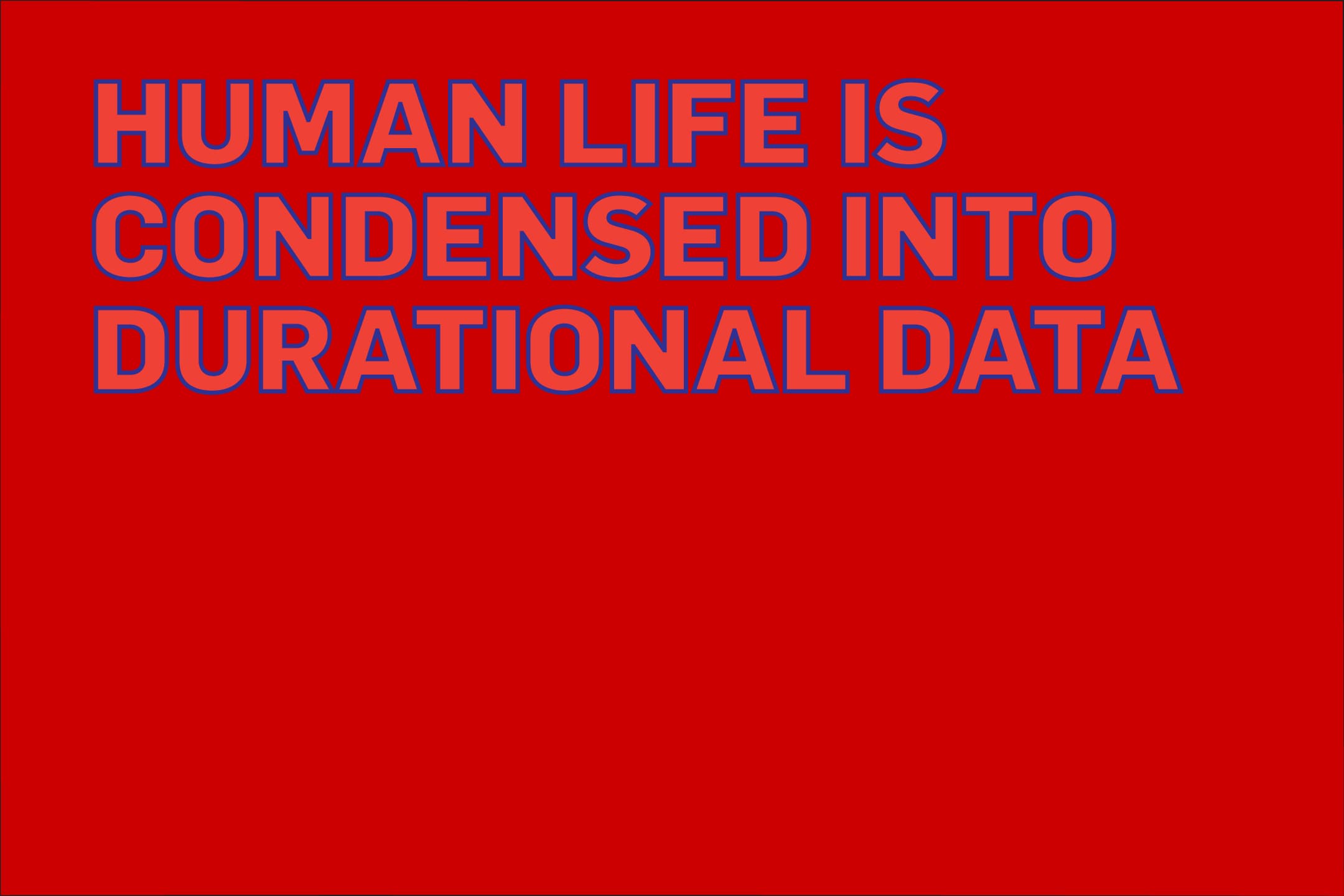
:mentalKLINIK, 2009
We think that the relations between things and humans are exhausted; locked in a world where everything is predetermined with all the details. Experiences of today are transformed into statistics for a future-time. Their medians are calculated while all errors and surprises are left out. Human life is condensed into durational data. Therefore no longer the same dynamic between the object and the subject retains. They are leveled both being treated as data for future’s consumption. The relations of consumption define us as service-oriented subjects. We as subjects always have to compromise our subjectivity with the demands of the services offered. Life itself becomes a commodity offered as a service and immortality is transformed into subject-less sustainability. In an era of passage from a world eagerly anticipating and expecting the future to a world where future is made, where the reality has new form, awareness constitutes the starting point.
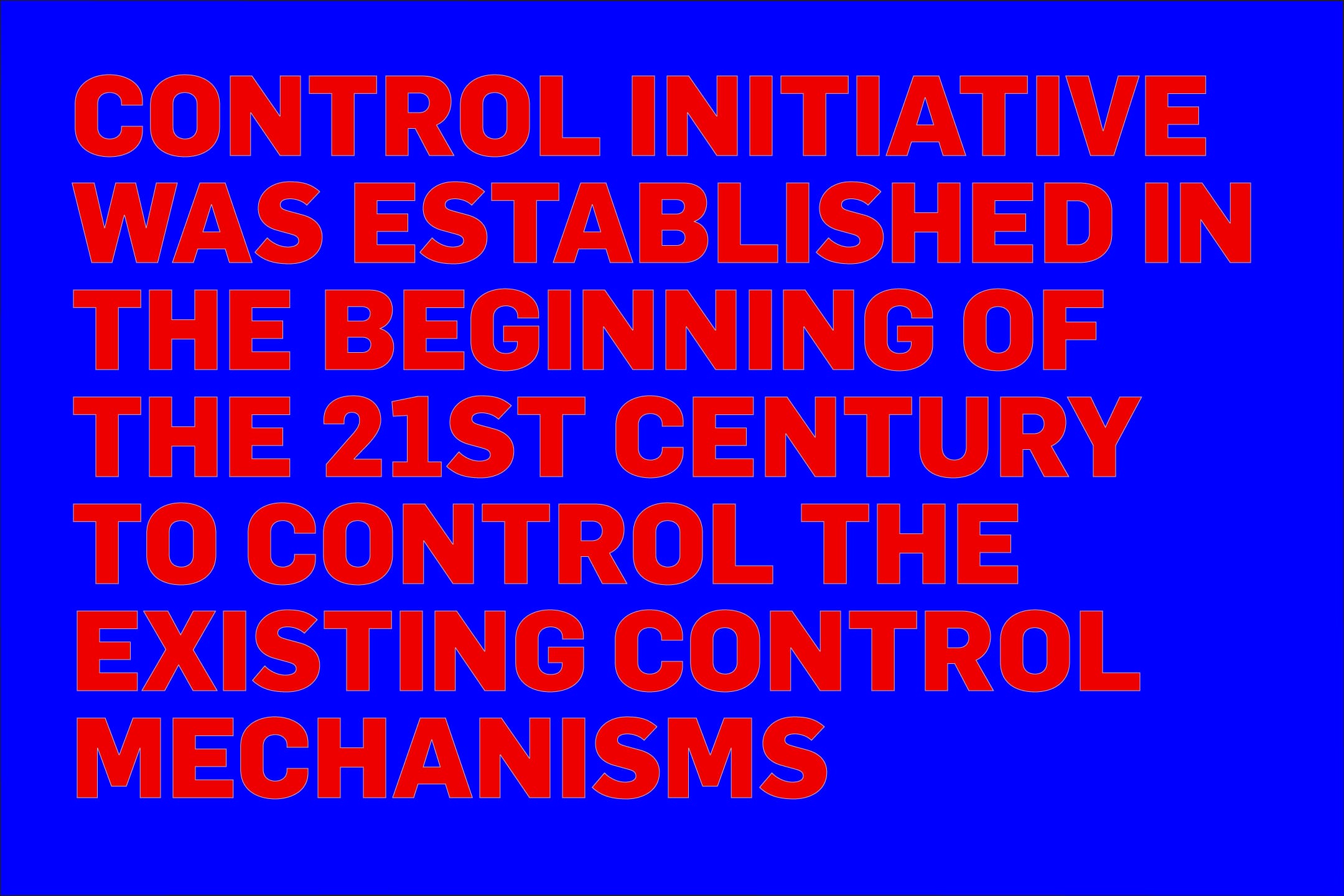
AGORAPHOBIA
CONTROL INITIATIVE
docu:mentalKLINIK, 2007
a docu:mentalKLINIK issue published in Art-ist Contemporary Art Magazine, May 2007 issue
docu:mentalKLINIK realized ‘agoraphobia/control initiative’ for art-ist’s issue focusing on public sphere and the new forms of public art. ‘Agoraphobia / Control Initiative’ questions the possibility of a real public sphere in the 21st century and looks into the problematics of ‘representation’. The issue is pronounced to be realized by a fiction character who has agoraphobia and who is the founder of the ‘control initiative’. Refusing to be represented by docu:mentalKLINIK, the fiction character does not provide answers to the questions addressed by docu:mentalKLINIK but instead delivers a finalized ‘make-process’ ready to be published in the magazine.
_How and why did your Agoraphobia started?
They came. 0.630m3. (I / 0.253m3) They asked me to answer their questions for their ‘make-process’. They told me that their ‘make-process’, for which they would use my answers, would take place in an art magazine. They told me that the art magazine would be distributed nation-wide and internationally. (I got bored) I offered 750ml of caffeinated liquid. They left 220ml of it. They assumed they would understand my answers and that they could produce material from my special case. They were curious and hasty. (however everything is under my control) As they were leaving they got even more uneasy. They could not get their answers. I told them to wait, and that I would give them my answers. As 0.630m3 got emptied of my living room, 187.63m3 was again mine. After some time I sent them my answers as a ‘make-process’ under my control.
_What does it mean to have Agoraphobia, to be privileged / to be special?
While sitting on the sofa, I saw that the paper was under the table. I took it and placed in the file. Since I had already gotten up, I wanted to wander around a bit. I felt like surfing some archives. I went to the archives at the Nederlands Textielmuseum. I scanned the history and the development of wool production.
“French historian Frederic Braudel once wrote ‘Sheep are the force that changed the world.’ Such was the impact of wool on many economic systems throughout the world, including the Colonial-era United States. A wool merchant would be necessary to help clothe the community.”
_How would you define the space you live in? What are your opinions on the rights of living and sheltering?
I don’t like plants. People who grow plants use their plants to observe time. They seek shelter in the plants’ time to get out of their monotonous lives, trying to read the days and seasons over plants. For a human being, to live like a plant signifies getting out of time, to halt at the threshold of living and non-living. I download plant images and save them in categories. I use the power, the system and the patterns of plants for the “Control Initiative”.
_Are there people or any specific group you identify with in Istanbul? Is there anyone or any institution/ foundation, which represents you in the public sphere? Did you, the ones with Agoraphobia, ever think of getting together and establishing an association?
I enter into the codes of mobility. I edit all my travels. I always include new spaces in my aorist present time. I measure distances and create transits. My travels begin and end in terminals.
_What are the impacts of the social, political, historical and urban framework of Istanbul on your Agoraphobia?
the coordinates
634.89m3
78.12m3, 50.40m3, 187.69m3, 54.30m3, 138.24m3, 24.32m3, 12.63m3, 15.85m3, 33.75m3
22 C˚
%50 humidity
20 inch
.....pixels
_What are the places you would define as ‘safety zones’ in the city?
(I) ayzek-online. “glass” from “Control Initiative” logged off. ’“hınzır” logged on. Was using the nickname “spy” when I downloaded the 73 KB file. Caught. (I) bluestates-online, am now uploading the mp3s “tasadam” asked from me. Wants the same mp3s from (I) deep-online. Couldn’t trust. Here, (I) ayzek-online, (I) bluestates-online, (I) deep-online, (I) hotpot-online, (I) cimcime-online, (I) superman-online, (I) supergirl-online, (I) veritas-online, (I) tulumba-online, (I) hip-hop-online, (I) mussakka-online, am receiving the same message.
“We are gathering in our square”
We?
_What sort of a transformation Istanbul will go through if Turkey joins EU?
Shopping List:
-liquid hydration and energy liquid,- Excel Mountain Spring, Hydractiv Color-Triclosan, sodium saccharin, titanium dioxide, tetrasodium pyrophosphate, lauryl sarcosinate, Stannous fluoride, hydrated silica-2-layer structure, taste and longer lasting flavour experience, Superior cooling sensation, Tailor made shape -UVA/UVB protection, Oil-free, Water-resistant, Free of mineral oil,homosalate 7.5%, Octinoxate 7.5%, Octisalate 5%, Oxybenzone 6%, Ethyl Alcohol, Jojoba, Acrylate Copolymer, Tocopheryl Acetate (Vitamin E), Fragrance -Ground stabilized Flax seed, Spirulina, Garlic, Lecithin, Alfalfa, Dandelion root. Hawthorn berry, Nettle leaf, Yucca root, Amino Acid Chelated Minerals, Vitamin C, Vitamin E, Niacinamide, D-Calcium Pantothenate, PABA, Vitamin B-1, Vitamin B-2, Vitamin B-6, Vitamin A Palmitate, Vitamin D-3, Vitamin B-12, Folic Acid, Biotin -Vitamin A (83% as Beta-Carotene from Palm Fruit and Blakeslea trispora extracts, 17% as Vitamin A Palmitate) 7500 IU, Vitamin C (as calcium ascorbate) 200 mg, Vitamin D (as cholecalciferol) 200 IU, Vitamin E (as D-alpha-tocopheryl acetate, tocotrienols) 75 IU, Vitamin K (as phytonadione) 20 mcg, Thiamin (as thiamine mononitrate) 3.75 mg, Riboflavin (riboflavin) 4.25 mg, Niacin (as niacinamide) 17.5 mg,Ê Vitamin B6 (as pyridoxine hydrochloride) 5 mg, Folate (as folic acid) 300 mcg, Vitamin B12 (as cyanocobalamin) 15 mcg, Biotin (as biotin) 75 mcg, Pantothenic Acid (as D-calcium pantothenate) 15 mg, Calcium (as calcium carbonate, di-calcium malate) 250 mg, Iodine (as potassium iodide) 50 mcg, Magnesium (as magnesium chelate, magnesium oxide) 125 mg, Zinc (zinc chelate) 7.5 mg, Selenium (as L-selenomethionine, sodium selenite) 70 mcg, Copper (as copper chelate ) 0.5 mg, Manganese (manganese chelate) 1.0 mg, Chromium (as chromium chelate) 100 mcg, molybdenum (molybdenum chelate) 37.5 mcg, ployphenol and flavonoid BlendÊ 97.5, catechins (from Camellia sinensis) (45 mg) leaf extract (20:1), Quercetin (25 mg), Grape seed extract (min. 95% polyphenols) (12.5 mg), Citrus Bioflavonoids (from citrus fruits) (12.5 mg) Resveratrol (2.5 mg), Gamma-Tocopherols 37.5 mg, Beta-and Delta-Tocopherols 16 mg, Alpha-Lipoic Acid 15 mg, Inositol (inositol) 5 mg,Ê Carotenoid Blend (other than Beta-Carotene) 4.5 mg, Lycopene (as Lycopene) (2.5 mg), Alpha-Carotene (from Palm Fruit Extract) (1 mg), Boron (as Boron Citrate) 1.5 mg, Silicon ( As sodium Metasilicate) 1.5 mg, Vanadium (as Vanadyl sulfate) 10 mcg
-Do you know that Istanbul is selected as the European Capital of Culture in 2010? Are you, the ones with Agoraphobia, working on a cultural project that will represent you in 2010?
Called on the phone. I told, could come. (I am waiting). 0.257m3 “AmericanWay”er came. Started the monologue:
“Our corporation, “AmericanWay” the global leader in direct selling since 1959, today has over 3 million independent business owners in over 80 countries. No other direct selling company can compare with our longevity, stability, and global reach.” (they always tell the same)
“All our independent business owners, besides earning a profit on each sale, sponsor others to join the business and become independent business owners, so that we can all make a profit. What is important for us is sharing.” (who’s selling whom to whom?)
What does public space and public sphere mean for you?
THE RIO CARNIVAL 2008 GUIDE: Programs, Venues, Tickets, Costumes
The Rio Carnival 2008 Guide with all events, programs, venues, tickets, costumes and recommendations.
rio-carnival.net/ - 34k - Önbellek - Benzer sayfalar
Trinidad Carnival
Information on Carnival from the Tourism and Industrial Development Corporation of Trinidad and Tobago. Includes the history of Carnival, ...
www.visittnt.com/todo/events/carnival/ - 7k - Önbellek - Benzer sayfalar
Venice Carnival / Carnevale of Venice
Information and resources for the annual carnival of Venice: dates, events, history, masks and where to stay in Venice during Carnevale.
www.visitvenice.co.uk/venice-carnival.html - 21k - Önbellek - Benzer sayfalar
“Carnivalisation thus ‘makes it possible to extend the narrow sense of life. …Carnival is the place for working out a new mode of interrelationship between individuals . . . People who in life are separated by impenetrable hierarchical barriers enter into free and familiar contact on the carnival square’(Bakhtin)”
-Do you feel you are being watched/observed in the public space?
Acarinas live all around the house. I can see some of them on a black surface with my magnifier. They usually have a length of 420 µm and a width of 285 µm. I cannot differentiate their sex. They like the temperature and the humidity of my house; they don’t like the sunshine just like me. I know that they feed on the skin cells I shed. In every space where I breath, perspire and salivate there is a community of Acarinas living.
“hinzir”, “tasadam”, “spirator”, “miniminimaynimo”, ”turlama”, “sicrayanceylan” “susam”, “iq5” from the ‘control initiative we started, leave some designated spaces open for me to watch at all times.
What do you think about the privatization of the public space?
www.milliondolllarhomepage.com
What will be the impacts of urban transformation on the restructuring of the public space? Do you think the re-structured public spaces will create public sphere?
0.167m3 came. Told me about the walk in the park. (my green sofa)
They are building new sidewalks in (Beyoğlu). (I have to get my parquets polished)
0.230m3 came. Been to a Concert. (I have the CD)
Bought a cashmere cardigan. (22C˚ cotton is enough)
0.304m3 came. Tired. Has swollen feet from walking too much. Hands with blisters. (I watched it on live broadcast)
0.118m3 came. Had too many lattes at the café, suffers fast heart palpitations. (I do decaffeinated coffee)
0.297m3 came. Been to the new exhibition. (I surf a different exhibition everyday)
0.189m3 came. Ears hurting from the flight. Afraid to have a jetlag. (I have no such fears in my simulation flights)
-Where may the boundaries between public space and private space ‘melt’? Where may these ‘meltings’ come unto the surface?
“Control Initiative” was established in the beginning of the 21st Century to control the existing control mechanisms, and to deliver the ones under control their space. It created formulas for deconstructing representation, curating the complex trigonometric functions. Developed anti-control mechanisms at the i***qb phase to heighten the perceptions, to expand the senses and to create desire narrowers. Created the permeable/transitive space layer by keeping the emerging free spaces under control.
“Control Initiative”,
*Renders invisibility visible developing Nano-Visors.
*Measures the freedom that the narrowed desires will create using the Bio-pixel technology in its test residency units.
*Develops custom-made camouflage techniques using the Skin-pattern programme.
*Enables ‘safety-zones’ to come unto the surface using ‘innerized control’ tablets.
*‘Control Initiative’ will start a ‘residency programme’ in Istanbul, 2010.
-Do you think that a public sphere as a project can ever really be a public sphere?
“Man is small, and, therefore, small is beautiful” (I am beautiful)
"...sees the essence of civilisation not in a multiplication of wants but in the purification of human character. Character, at the same time, is formed primarily by a man's work. And work, properly conducted in conditions of human dignity and freedom, blesses those who do it and equally their products." Small is beautiful E. F. Schumacher
.......
They are classified as ‘biotic’ and ‘abiotic’. ‘biotic’s are derived from animals and plants. ‘abiotic’s are derived from the non-living world. Water, land and air are examples. Minerals and power are ‘abiotic’s derived from nature.
Manpower is insufficient to produce ‘biotic’s or ‘abiotic’s on its own.
_Do you think that the resources, coming from both inside and outside, have an impact on the creation of public sphere?
[email protected] can be used to contact me directly. Get rid of intermediaries.
...
...
These questions are compiled by docu:mentalKLINIK. They do not have a particular order, coherency or an expectation of a result.
This ‘make-process’ sent to docu:mentalKLINIK in reply to its questions, was delivered to art-ist magazine as it was received.
agorophobia ]control initiative[
art_ist magazine, 2007 (an insert book)
Project by :mentalKLINIK
Authors: Yasemin Baydar, Birol Demir, Ayşe Draz
1000 copies, 32 pages
a docu:mentalKLINIK book
Published by :mentalKLINIK
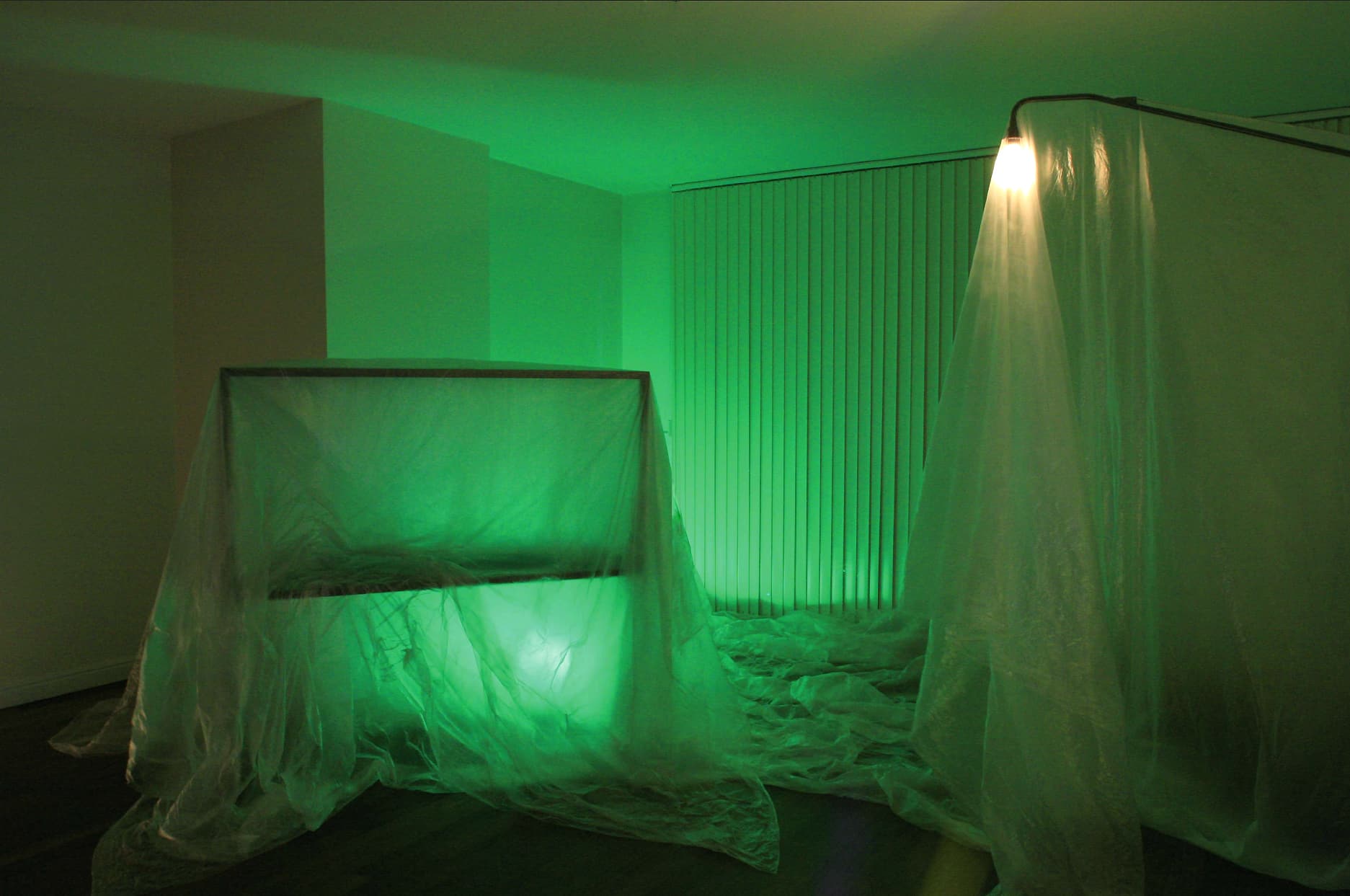
IMAGE/IMAGINE_ENJOY THE SILENCE
docu:mentalKLINIK, 2007
A fashion photo shoot by docu:mentalKLINIK published in NICO Magazine, April, 2007 (14 pages)
ENJOY THE SILENCE...
the fashion shoot we did with our sub-heading docu:mentalKLINIK for the spring/summer 2007 edition of ‘Nico Magazine, fashion&interviews’
After an invitation for doing a fashion shoot in Nico Magazine interviews & fashion, Spring / Summer 2007 issue, docu:mentalKLİNİK realized a fashion photo shoot titled ‘Image/Imagine’ also referring to the concept of absence. Although a model and some real and virtual fashion items were used in the shootings, only the images of the locations, where the model and the fashion items were absent, were published. Also texts describing in detail the absent model and the fashion items were published along with the images.
…..a lengthy shoot by Turkish experimentalists docu:mentalKLINIK. This uses model-free images with extended, flowery captions describing what the model would look like if she/he were there. A clever conceit, extended by the final spread that shows the preparation (hair, make up etc) that an actual model went through before the shoot..Jeremy Leslie
CONCEPT by :mentalKLINIK
Styling / make-up / hair styling / texts by docu:mentalKLINIK_ Yasemin Baydar, Birol Demir, Ayşe Draz
Model: Ayşe Orhon
Photographer: Ahmet Elhan
Imagine…she is 30 years old… she has a tall and slender but robust figure…the bone structure of her face is what initially catches your attention…she has a long neck and an oval face…fair, pastel rose complexion and straight ash brown hair with natural shades of dark blonde…above her slant up cocoa brown eyes, she has curved medium eyebrows, a tone darker than her hair…thick curled eyelashes…there is an intense but soothing expression in her eyes…she has a small nose, convex but soft… the strongest feature of her face is her high cheekbones…. her full down-turned peach blossom lips…she has a vaguely wide jaw…a narrow chin on the left side of which there is a tiny scar...she has small, high ears…a muscular, up-right figure…long muscular arms and legs…rather broad shoulders… slightly flat chest…narrow waist and hips, hips tapering only slightly from the waist…when she moves, it is as if her body silently envelopes the space around her…
Imagine…-Shiseido- The Skincare Foam, Hydro-Refining Softener, Visible Luminizer Serum, The Skincare Day Moisturizer, Matifying Stick and BOP Eye Contour Cream are applied oh her face in order of appearance as preparation for the make-up…her make-up is done using -Uslu Airlines- airbrush make-up system air(o)pack, liquid colours, loose powders and concealers… the make-up achieves an effect of varying sun-tanning on the face…her face has a gradient colour with ranging shades of exposure to sun…the same make-up is applied on both of her arms…x liquid colour is airbrushed on the inner side of her eye socket…-Shiseido- after make-up Soothing Spray is used for finish…
Imagine…her hair is pulled back in a tight but low ponytail…no hair band is used… the base of her ponytail is dyed with shades of shocking pink… her hair on the neckline is shaved… along the left side of her forehead her hair is shaved irregularly small triangular shapes… -Alterna- Hemp line products are used in hair styling…
(All descriptions are made from the viewer’s standpoint)
IMAGE 1
Imagine…she is there standing sideways on the right of the two-storey rectangular object…facing left… she is leaning her body‘s front side softly on the object’s right plane as if lying on a perpendicular bed…her arms are hanging loose by her sides… her head reposes on top of the object as if on a pillow, facing back…there is a mute inter-space left between her body and the object…she is wearing a strapless dress which reveals only the curvature of her left arm and shoulder…her neck is covered by her hair…the dress she is wearing looks at first sight like a green balloon deflated in time…the complexity of this dress is suspended in its plain look…fluid and elegant…she is wearing the Jill Sander Spring/Summer 2007, strapless full-length one piece dress…the dress leaves her arms and shoulders bare… the dress is fluorescent bright green…its colour dissolves in the colour of the space as the lights suppress the green… the dress is made of thin but heavy weight material with a silky touch on her skin…the surface of the dress‘s material is smooth… its fabric is pleated on the front and the back centre of its strapless belt with invisible stitches…it hangs loosely inflating the dress as its downfall tapers at the ankles…this voluminous dress conceals her body‘s curvatures only revealing a soft and rounded silhouette…the volume of air enveloped inside is in constant change…only a whispering sound of the dress is heard vaguely in the silence of the space…
IMAGE 2
Imagine…she is there behind the dark perpendicular object on the right…she is standing straight on a platform, her body facing front…only her bust can be seen…her arms are held up as if suspended in the motion of putting on a pullover…however she is already wearing two pieces…a skirt and a vest/blouse…her head is bowed down…her chin rests on her chest…the skirt‘s waistline is caught motionlessly in the space in-between…it hangs loosely from just above the line of her armpits… she is wearing a sleeveless vest/blouse on top of the skirt…the vest/blouse is held up by the skirt‘s waistline covering her neck at the back…it hangs down in front on both sides…both pieces are black…one matt and the other shiny… she is wearing the Prada 2006 bias-cut, A-line, double-flared skirt…it has a low-cut waist… it is made from a crepe fabric with a mix of acetate and viscose…its colour is moonless night black…there is a knitted rib trim on the skirt‘s waistband…this generous skirt‘s heavy weight material flows down creating a variety of inner and outer volumes in its folds... it waves quietly in the space...the vest/blouse she is wearing on top is from Joel Andrianomearisoa’s 2005 collection...its light chiffon fabric has horizontal lines with different densities...two rectangular pieces of this jet black material is sawn on the sides leaving space for the arms, and on the top leaving space for the neck...it is cut perpendicularly in the centre on the front...on both sides there are many triangle pieces of the same fabric inserted in the shoulder and side stitches...due to its irregular cut and the raw edges, this vest/blouse adorns the body with a variety of secret cross fading patterns... the skirt and the vest/blouse dreamily melt into each other as they silently converge into one piece…
IMAGE 3
Imagine…she is there on the floor by the right wall… she is leaning her back on the wall…her legs are stretched in front on the floor side by side…her right arm rests closely by her right side…her body is slightly tilted to her left…she looks like a lifeless doll that is captured motionless in the moment just before it falls down on its left side…the surface of her left forearm and her hand on the floor hold the whole tension of her body‘s weight…she is wearing an evening dress which appears to be floating in air…it is as if this dress is pulling her body up from the floor but she is suspended in this silent tension between the gravity of the floor and the floating of the dress…she is wearing the Lanvin Spring/Summer 2007 halter-neck dress…the hemline of the dress falls just below her knee…its fabric is a mixture of silk and lurex with silver tinsel…some parts of this lamé dress dissolve into darkness, while some parts on its surface glitter…a zip fastening runs down its back…the dress is so light that even where it touches her skin she feels vulnerably exposed rather than covered… its straps are made from the same fabric and they tie at the back of her neck… a tightly pleated panel is placed on the dress’s low slit v-neck which is pulled up by the straps…this rather stiff panel with a futuristic Greek draping around it, curves up and away from her bust….along with the panel, the tapering of the dress at the hemline creates a 3-dimensional volume inside the dress’s surface on the front…her body’s form is hidden in this 3-dimensional space…when she moves, a low trembling metallic noise is heard from the dress…
IMAGE 4
Imagine…she is there in the centre…standing sideways facing right…she is bending her torso down from the waist in a 30º angle…her right arm above the elbow is parallel to her torso while her forearm hangs down…her left arm is wrapped around her head…she is holding in her left hand just above her head one end of a rope…the rope is wrapped around her waist, passing through the space under her right armpit, reaching up to her left hand…there are rectangular pleated clothes in varying sizes sawn to the rope …a small rectangular piece with three layers hides her face while another covers her chest…it is a piece by Bruno Pieters, 2004…this piece is a long waistband with many buttons and buttonholes…pleated paper-like cotton pieces with varying widths and lengths are layered on each other in bundles along the waistband… it has a balm like ‘after dark’ black coating…the waistband and the pleated pieces are of the same rigid material … she feels safe…it wraps air inside and keeps it safe covered with multiple layers….it always leaves a breathing space between the pleated folds, between the overlapping layers…the pleats are very disciplined…sharp… clean-cut edges…the top layers lift up as the piece gets wrapped around…this uncommon piece mutters something but the words are inarticulate…
IMAGE 5
Imagine…she is there sitting on the first level of the dark platform…in the centre…facing front…her body above the waist is tilted to her right side…her head is resting on top of the platform behind her…there is something bundled like a pillow under her head…some fabric…her hands on her knees…her calves hanging down…her right sole touches the floor, while her left is perpendicular to it…there is a reluctant tension between the right and left halves of her body…her shoulders appear bare…her cleavage down to almost her bellybutton appears bare…yet she is wearing a shirt…cloud dancer white…it is the Viktor& Rolf Spring/Summer 2007 shirt…with tricky zigzags, a transparent flesh coloured lycra fabric around the collar and down through her cleavage suggests nudity…but this fabric is holding back a white shirt from its downfall…the nudity is silenced and rather the body’s silhouette appears to be pushed down along with the white shirt…sharp….frivolous but complicated… elegant and romantic…romanticizing modernity…under her head bundled is the Viktor& Rolf Spring/Summer 2007 pants…it is another piece creating a dreamy illusion…straight-slim cut cotton trousers that disappear towards the legs…fading from peat black to castor grey…from castor grey to elephant skin….from elephant skin to flint grey…from flint grey to silver cloud…dissolving into air…foggy and dusted…the vision gets blurred…the absence of sound gives an illusion of silence…
IMAGE 6
Imagine…she is there sitting sideways on the right corner of the object…facing right…she is slightly leaning down…it is as if she is trying to look at something…only her right arm from the shoulder and her right leg as it reaches down to the floor can be seen…her profile and her torso are covered under what appears to be a caviar black armour…with her left arm stretched up she is holding the hemline of a skirt…the skirt prolonged along the straight line of her back and her arm, comes down in a half circle… through the waistband of the skirt, her right arm is coming out…it is a tailor-made flare ballroom skirt from the 40s…hemline just below the knee…fitted waist, the skirt is made up of more than 100 triangular silk taffeta fabric pieces sawn side by side…while the skirt makes a round silhouette, its fabric creates sharp forms in the space…there are hidden but clean and careful stitches…in the absence of an original belt, the skirt now has a raw cut waistband…this absence is intensified with traces of stitch-holes…it has a zip fastening on the side…motion is arrested inside the rigid folds of the skirt…the straight lines of the skirt layer on top of each other creating ruptures…deconstructionism silences constructionism…only a low rustling sound is heard…
IMAGE 7
Imagine…she is there lying on the pile in the centre…she is lying on her right side…her body is twisted…her legs are not seen…only her torso…her left shoulder…her right arm and head pulled down by the gravity of the empty space…the rest hidden behind the pile…her left shoulder is partially covered with a black cropped cloth…it looks like pieces of different black clothes are thrown over her in a bundle…as if to terminate the convulsion of her body…it is the Comme Des Garçons 2004 black jacket…its black ranges from night shade to raven…this 40’s style cropped cotton jacket has silk insets and sheer ethereal shawl bits…the jacket closes at the waist with a hook and eye…it has a slightly asymmetrical fit…though very subtle around the bust…the jacket is an encounter of three different models…its backside has different styled jacket cuts layered on top of each other…leaving graphical traces of its stitches…its backside is made up of only one fabric…cotton…on the front side of its sleeves there are asymmetrical silk fabric pieces…the combination of different fabrics and shades of black gives the jacket an animated appearance…however it is introverted…looks like tailor-made…unique…the front piece of the jacket is slightly longer than its back piece…different collars made from different fabrics are layered on each other…shiny, matt, transparent…sometimes like a shawl…sometimes very geometrical…the shades of black wipes out the jacket’s sound…
IMAGE 8
Imagine…she is there sitting on the up and right corner of the low platform…her weight suspended on the edge…she is facing backwards…staring at the reserved darkness…her arms are lifted up slightly from the shoulders…fingers pointing the floor…it is as if she is surrendering to eternity… only her back is seen through the phantom black chiffon…no zip line is seen on her back… she is wearing the Martine Sitbon 2002 batwing sleeve chiffon blouse…the front side of the blouse is covering her back…revealing her flesh through the black transparency…the blouse has a round neckline… soft silk fabric borders the neckline and makes a small upside-down rounded triangle on the front of the blouse… it is opaque and matt….a thick line of the same fabric stripes down the sleeves…there is a hidden zip fastening down the blouses’ back…the hemline tapers and fits just below the hips…the chiffon fabric sawn to the epaulet-like silk stripe panels on the arms, comes down like drapery…creating loose chiffon batwing sleeves…inside this fragile blouse, the wind falls asleep…
IMAGE 9
Imagine…she is there behind the dark horizontal object…standing sideways…facing left…her legs slightly bent…her head levelling the height of the other object on the left…a stagnant profile…her neck and her left arm just down to her elbow are seen...the rest hidden behind the darkness…it appears as if she is wearing an off shoulder t-shirt…covered with a transparent layer…the t-shirt inside is bundled on the shoulder under its transparent cover…it also makes her appear hunched as it also bundles at her back… the t-shirt comes down to her hips…it fits tightly trapped inside the transparent layer….she is wearing the Martin Margiela 1994 piece…it is a combination of two pieces…a moon mist grey sleeveless t-shirt…and a sand-shell long sleeve, tight fitting fishnet body on top…the fishnet body with small patterns, while trapping the cotton t-shirt inside, leaves a breathing space for it through its tiny pores…the over size t-shirt has a wide rounded collar…it fits her body wrinkling and bundling here and there…searching for a place to rest trapped inside the fishnet…its loose left shoulder is arrested by the fishnet on the arm…the t-shirt is transformed into an off shoulder t-shirt…wrinkled irregularly inside its cage, it gives an impression of a faulty creation…the fishnet body on top has a smooth and fine surface… while the fishnet fits tightly on her body, her body’s silhouette is transformed with wrinkled fabric of the t-shirt…this mismatched layering creates mute shadows…
IMAGE 10
Imagine…she is there just behind the pile…on the right corner… standing upright…facing front…her arms opening down from the shoulders…her forearms lifted up, perpendicular to the floor… on both hands she is holding the ends of a white cloth…her head is bowed down…the cloth is caught in the centre under her chin…she is pressing her chin tightly on her chest…the cloth falls down irregularly…the irregular white form and her arms appear like the wings of a white seagull…there are blue shades on the cloth…the blue ice cubes stringed on her neck are melting…she is holding in her hands the white wrap around Martin Margiela 2000 skirt…made up of two different fabrics…satin and viscose…it has a wide satin waistband…down the waistband there are rectangular viscose fabrics in varying lengths and widths stitched to each other…as it is wrapped around, different shapes layer on top of each other…long and short…wide and narrow…it has a raw cut hemline…an irregular downfall… sometimes below the knee…sometimes above… it is voluminous…quivering waves appear on its surface…the skirt is playful but speechless… the Martin Margiela, 2006 ice necklace is made up of ice cubes with blue textile dye...cyan blue…the melting of ice leaves its blue traces on the skirt…one expects to hear the cracking of ice as it melts, though only a shiver is felt and no sound heard…
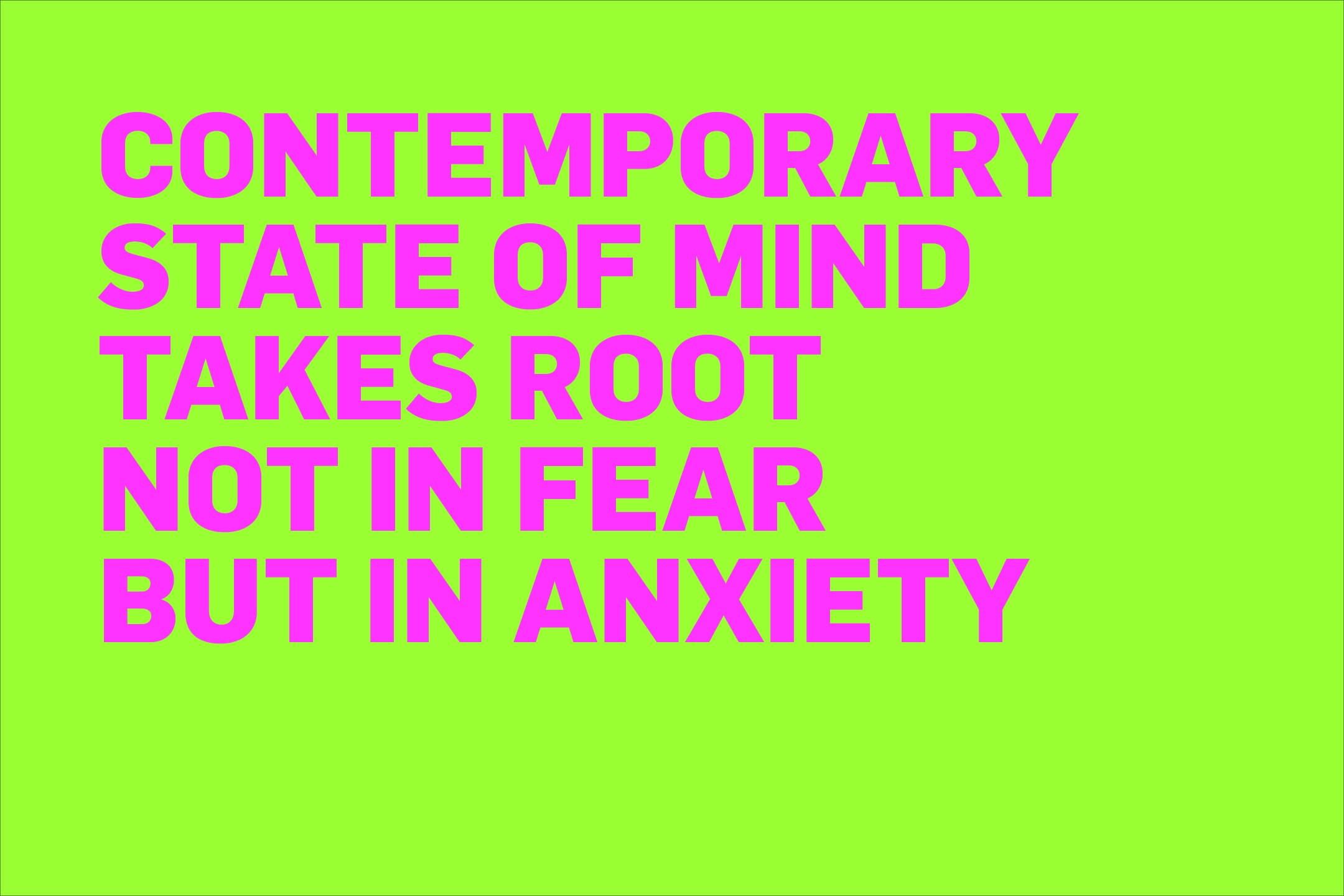
INTERVIEW
CAIA HAGEL, 2015
_I wonder if, especially in secular Western society where spiritual poverty is increasing, artists play a spiritual role more than ever. Living and working in Istanbul, you're straddling the West and the East and have insight and experience in/to both. What are your thoughts on this?
As :mK rather than assuming a spiritual role we are interested in emancipating and empowering the sensory faculties of man that is impoverished within the contemporary context. Today, the notion of touching upon the ‘other’, metaphorically as well as physically, is invalidated since the notion of the ‘other’ itself has become meaningless in a world where trust is lost forever. We intend with our works to appeal to the viewer’s senses to such an extent that at times the works almost violate the viewer’s personal space, however during this process the viewer becomes aware of his/her senses and this awareness is very central to our works.
_If artists are 'oracles', you seem to be aware of, and telling us, that we are on the brink of a very big shift - what are you seeing and how do you place this in history (Industrial Revolution to post-capitalism)?
This shift has already been in effect as the contemporary state of mind takes root not in fear but in anxiety since today’s reality is a hypercomplex one of the networked world. Today we are no longer able to envision a future but rather a future without hope occupies our here and now. :mentalKLINIK works with a retrospective point of view from the future transposing the possibilities of the future into today.
_When we spoke in Sardinia, and we were discussing how human desire keeps us bound to a painful 'unfulfilled state', which can perhaps never be broached because of the barrier that the human body creates between fantasy and reality - you mentioned how you predict that Oculus will help us break through this barrier. Can you explain this more deeply, from your
point of view? We discussed Oculus being able to heal as well, because of its ability to help us live out our taboos and perversions. How do you see this working?
The question of reality has always been a driving force for :mentalKLINIK. :mentalKLINIK deals with augmented reality because it shifts our perceptional relations. We try to record augmented reality’s effects on our ways of seeing and sensing. Augmented reality is an environment that includes both virtual reality and real-world elements at the threshold of the future and the present. The possibility of breaching the barrier that you mention is created by tools of augmented reality such as Oculus. Such tools enable an ubiquitous presence, a simultaneous presence both in fantasy and reality engaging the senses at the same time. These tools’ function is neither positive nor negative by nature however they can be applied for either a positive or a negative end. They can be applied as a vehicle for mass control or as an apparatus for breaching the above-mentioned barrier and thus for healing our painful, unfulfilled state. If man could afford not to take himself/herself so serious s/he would be able to build a new notion of trust and to create a collective mind that is without ego, capable of merging the physical and the virtual worlds for a better end.
_Carl Jung discovered the 'Collective Unconscious' and theorized about its contents. Do you see cyberspace as a place where these previously invisible things - desires, impulses, longings - as well as 'oneness' have been made visible?
Neuro-scientific studies along with developments in cyberspace enable the datafication of these elements which used to be previously invisible. As they get datafied they are subject to being measured and therefore to being manipulated. While the oneness of the collective unconscious of the past signified rather a domain of liberation, the oneness of the new datafied collective unconscious is a totalitarian domain. Within this domain man is no longer free to express his/her desires, impulses or longings but rather his/her desires, impulses and longings are programmed.
_Did you read that article Ars Erotica by Mario Vargas Llosa in Harper's? He laments pornography's influence on imagery and the imaginary - as an erosion of the sophisticated art of loving and sexing between human beings. He says the way technology deals with the erotic reduces it to crude biology, when as the only animals on earth with minds, we are able to do so much more with our desires and erotics. In light of the themes in 83% Satisfaction Guaranteed, how do you feel about this?
Our works appeal to and trigger/stimulate the senses. They are erotic but not pornographic. By this we mean that they do not impose themselves upon the viewer but invite him/her into their own reality where all senses are engaged. For example with poprocks both the senses of hearing and taste are engaged and an intoxicating process that continues in the body is triggered. In addition, rather than offering just erotic imagery our works trigger all sorts of sensual responses from the viewer and lets him/her revel in his/her own imaginary eroticism.
_You're looking at the digital self and the interrelating of technology with humanity in many ways in this show - from Woo (robotic intimacy) to the Profiles series (featuring people presented as words on mirrors as manufactured brands). As we move deeper into the digital world, what do you feel is metamorphosing in us and how is the human experience changing? You seem to be introducing an aesthetics of this. How would you describe this aesthetics and do you have a name for it?
This metamorphosis that is taking place while robotifying the human beings humanizes the robots at the same time, therefore it is a dual relationship, one that only an oxymoron is capable of defining. We are also a transitional generation that knows both worlds, that of our physical reality and of the virtual one. Our aesthetic is rooted in this threshold where the physical looks virtual and the virtual appears physical. Between the sound loop of digital noises, the many different angles on contemporary dissatisfaction and the pop rocks/champagne participative performance on opening night, 83% Satisfaction Guaranteed assaults us with stimulation. Some artist-theorists (Hito Steyerl, Jalal Toufic) are beginning to wonder if humans are parasites of technology, solicited by 'technology's intelligence' to generate, like, store, share its hyper data production. Others (Jon Rafman) feel that digital experience is less to do with technology and much more about human consciousness, that humans manipulate technology to express their consciousness. Whether it is humans or technology that acts as parasite, our relationship with technology is blurring the line between image/object and information/material.
_How do you hope this show addresses this, and makes us feel?
Lost, anxious and depressive. Lost in our senses, anxious to feel and depressive about our state or being.
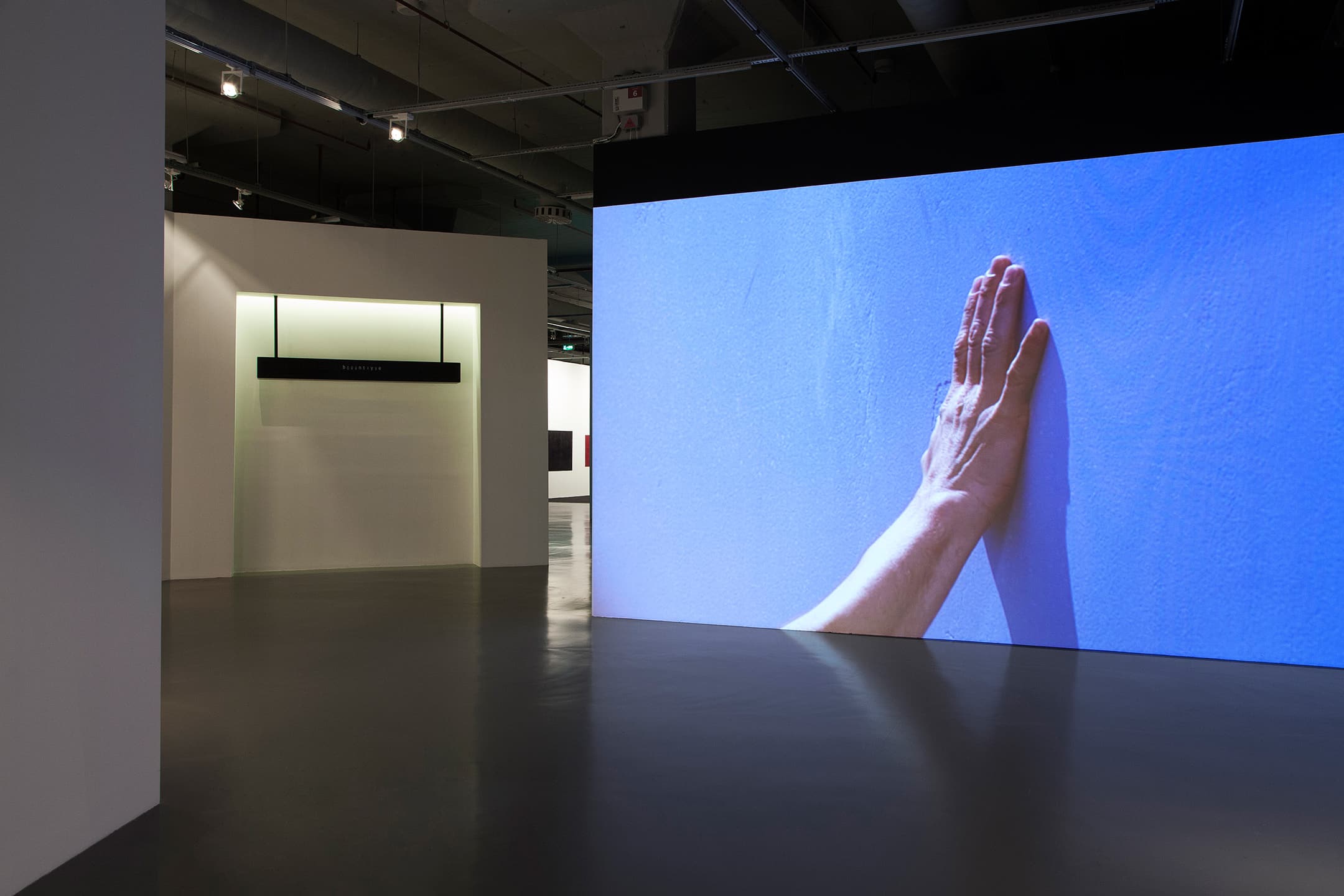
PLURIVOCALITY, 2014
GROUP SHOW AT İSTANBUL MODERN
CURATED BY LEVENT ÇALIKOĞLU & ÇELENK BAFRA
Founded in 1998 by Yasemin Baydar and Birol Demir, :mentalKLINIK uses all kinds of materials and forms, drawn from today’s art, to question the dynamics of contemporary art and design. They produce projects by analyzing and reinventing the processes of production, selection, presentation, use and perception in art, like an open laboratory or clinic. :mentalKLINIK do not hesitate to use anything that represents the zeitgeist of today in their art, pointing to the contemporary reality by using action, objects, sculpture, texts, sound and moving image in the compositions they conceive. The duo’s artistic practice pays homage to the concept of interdisciplinarity. At first the artists give the impression that they use the glossy and flashy language and production practices of the realm of contemporary design, industry and technology. However, in their works, they succeed in building a minimalist approach and a multilayered, conceptual structure. Detaching everyday industrial or ordinary objects and materials from their contexts and functions, the artists aim to reveal existing patterns and the modes of relation underlying these. While the materials they use in their works continue to refl ect their existing references, forms and characteristics, they are also metamorphosed through the interventions of the artists so as to offer a new aesthetic form, perception and area for interpretation that could be considered awkward, uncanny and extraordinary.
“True Blue (Left)”, :mentalKLINIK’s first work in “Plurivocality”, is a looped moving image which covers the entire wall. Even though there is no sound in the work, one feels as if one can hear the sound of the wall being touched, even pushed. One watches the very slow yet determined motions of a hand moving toward, then touching, and softly pushing the blue surface of what might be a wall, a void, or the sky. Is it the hand itself or its shadow that first reaches the surface? In any case, the work tries to render visible the potential in the act of touching and reminds us that sound does exist even though one cannot hear it. According to writer and composer Zafer Aracagök, the work is suggestive of the concept of “tinnitus”, which means hearing sounds that are not there or the sensation caused by the vibration of inner hair cells; for Aracagök, “True Blue” invites us to a visual tinnitus. What this hand, whose context is deliberately left out, points to or tries to touch might be the rabbit hole that opens up to an entirely different world in Alice in Wonderland, the same rabbit hole referred to in the project “rABBIThOLE” exhibited in 2011, in which “True Blue” was projected as two videos, one on the right, the other on the left.
The second work in the exhibition can be interpreted as a soul-mate of the sculpture “Double Cherry” in Istanbul Modern’s collection. In “Double Cherry”, :mentalKLINIK proposes two cherries sharing the same pit are embodied into a single form, like Siamese twins. They represent a hitech 3D self-portrait of the artist duo who are closely bound to each another through their intellectual production. As for “Plurivocality”, the artists used double French horns inspired by the shape of a snail’s shell and bound to each other as a single whole. Made of brass tubes, they resemble an animal’s horns. The source of inspiration for work, the French horn is one of the indispensable instruments of brass bands and orchestras especially in classical music. The title “FrenchKiss” is a wordplay both on the “Frenchness” of horns and on the French kiss, a style of kissing known for being emotionally and physically intense. The horns are joined by their flared bells, right from where sound would normally come out; they are thus rendered soundless and detached from their musical function. The lip-to-lip horns share an intimate and romantic closeness. With its powerful sound, the horn should be heard from long distances and has generally been used in history as a communication device for sending signals to far-off places or for leading the way. This time, it is as close as possible to another horn and cannot make any sound. The work points to the intimate nature of human encounters as well as the process of communication and interaction between people.
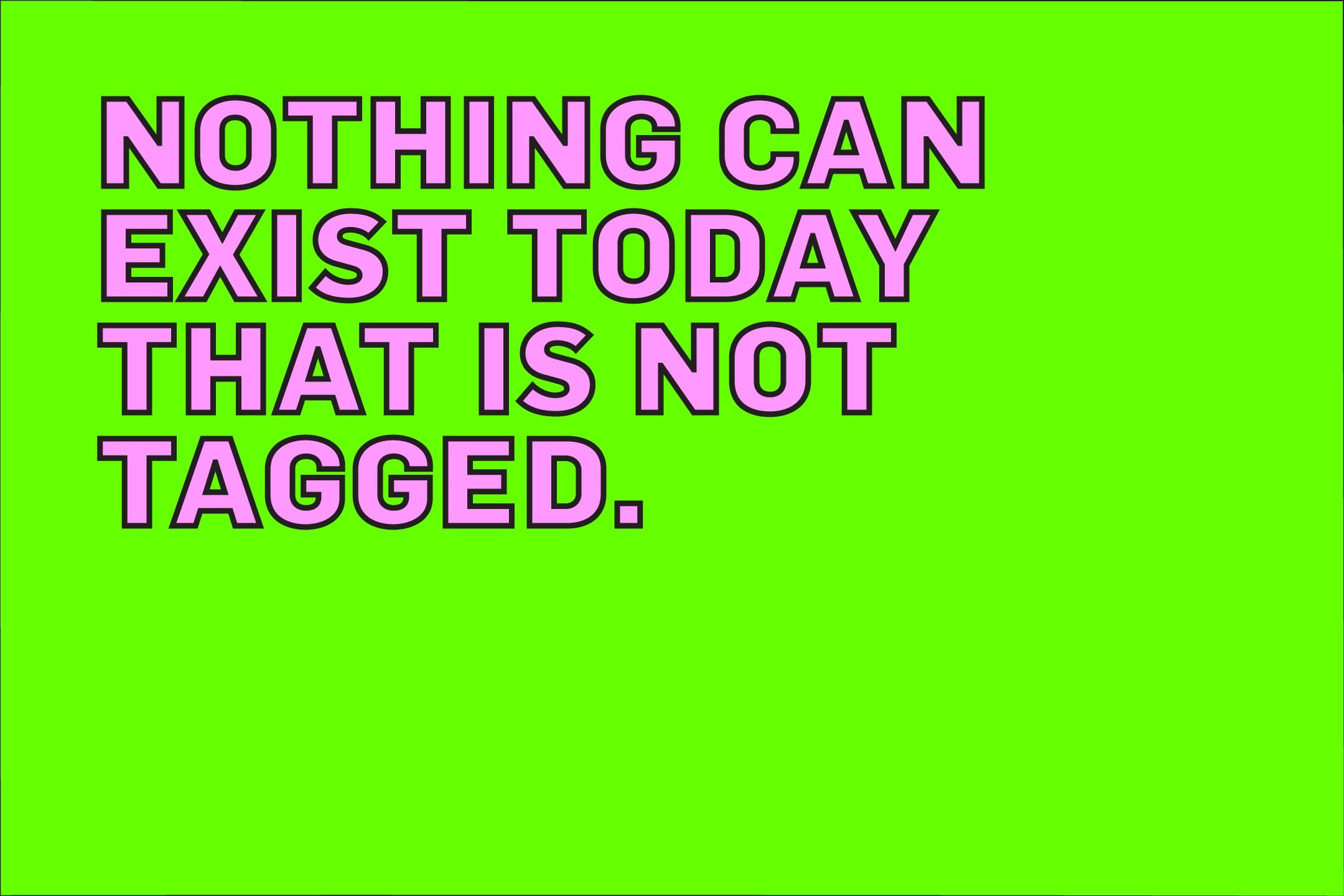
SUBSCRIBER SUBJECTS
TAGCLOUD
2008
TagCloud explores mentalKLINIK’s concept of frozen time, its way of appending to time, its relationship to art, its perspective and idea of production with tags like blurred, fragment, joseph beuys, ad hoc, cloud, open source, dust, merzbau.
:mentalKLINIK fictionalizes an occupied time and place at its location in a designated timeframe. This requires the spectator’s active engagement in order to generate a direction of flow, to create tension, to change the movement’s direction, to deposit residue and to generate a blur by removing and adding.
Nothing can exist today that is not tagged. Tags are present on products, in our memory and in the relationships we establish. With works of ‘augmented reality’, human beings are being drifted from the material world further and further into a cloudlike zone.:mentalKLINIK attempts to challenge the threshold of the cloudlike world born of the tag’s reinforced autonomy by the constructed reality of the work as tag.
‘Tagcloud’ transforms the gallery into a workshop, the exhibition space into a construction site, while :mentalKLINIK develops a ‘source’ for the future with works that are replaced and shift place & presentation from time to time to time.
Tag Cloud exhibition is a continuously changing form and simultaneously a form of continuity. It presents an unusual augmented experience. A gallery’s routine of holding multiple exhibitions a year by different artists is replaced with an exhibition that hosts the same artist multiple times a year. This exhibition demands from service oriented and subscriber subjects to visit the site repeatedly as a constantly updated webpage.
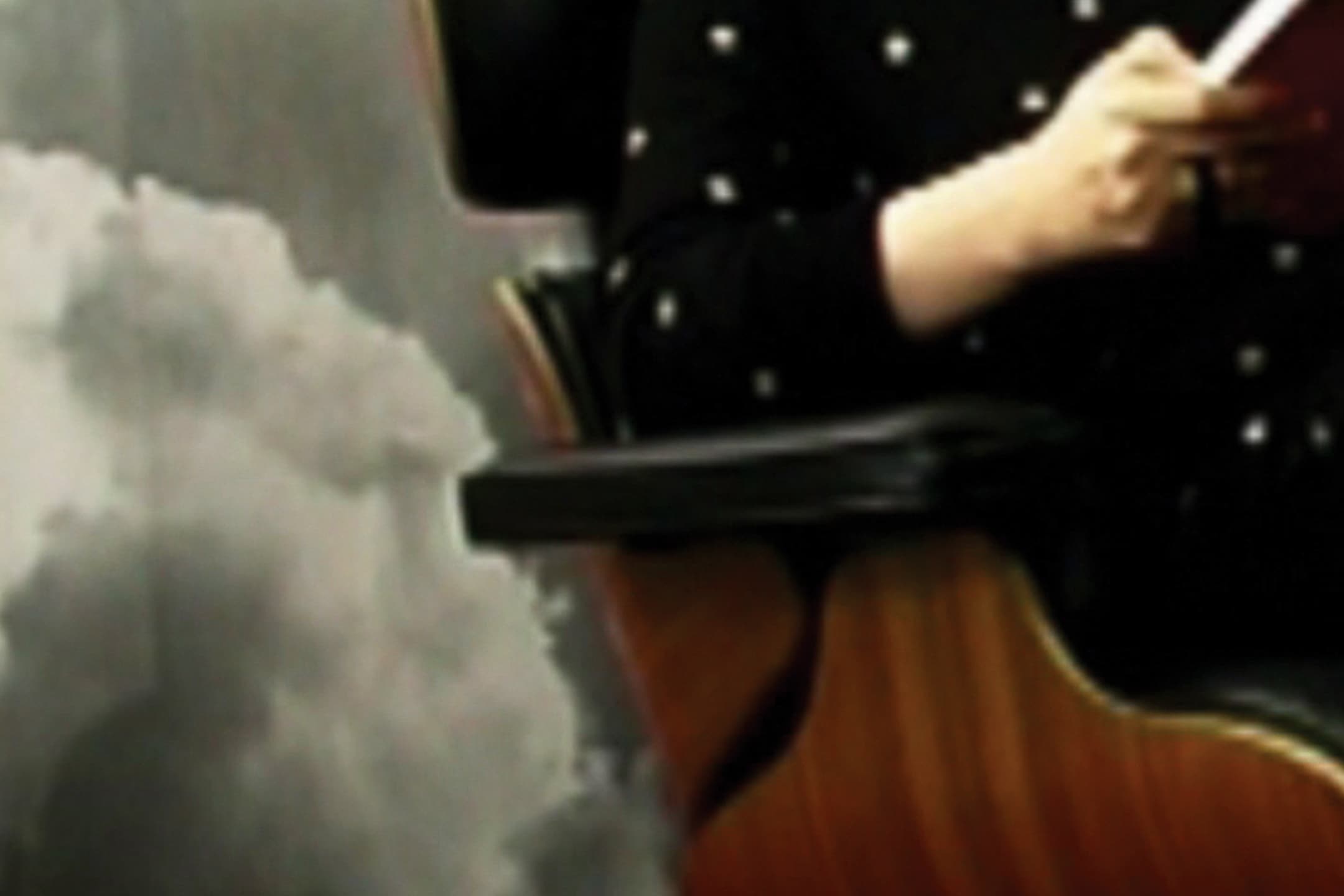
MONODIALOGUE__:MENTALKLINIK
Contemporary art debates series 10
May 14, 2008
Participants: HaZaVuZu, :mentalKLINIK
Moderator: Seçil Yersel
Subject: Independent Bodies
Organized by Azra Tüzünoğlu
:mentalKLINIK preferred to make a dialogue with Seçil Yersel and HaZaVuZu within a monologue, by making a fictional monodialogue as a way of relating with the two participants and the moderator in “Contemporary Art Debates”.
A “state” of :mentalKLINIK which oscillates between to-be-understood or wish-to-be-understood and their opposites. This work was prepared for “Series of contemporary art debates 10”, it desires to cause an interruption and occupation in the encounter of audience/spectator and speaker-even it is not physically present.
MonoDialog Liquidware 2.1 :mK version was produced as a “work” which reproduces the forms of relations within its own specific understanding of time and space.
MonoDialog Liquidware 2.1 :mK
Its non-operating, autonomous processing structure is the distinguishing characteristic of the MDL 2.1 :mK version. Befitting its particular purpose, it possesses a specific structure. It has human failures and irregularities. It does not have a defined mission, order or timing. It neither belongs to any institution, nor does it bear any possibility for institutionalizing. It takes initiative, yet it in and of itself is not an initiative. While enabling the adaptability of hardware devices, it may restrict the possible methods for its users’ actions or it may create as yet unforeseen liberty. These liberties are stored within the concentration of pleasure smoke and kept in permanent memory, when the institutional collapses.
MDL 2.1 :mK enables more than one operation simultaneously. While the impossibility engine in kerne is taking the full advantage of open source structure, MDL 2.1 :mK adopts disadvantages against itself as destructive-and-reconstructive strategy. Its operating algorithm enables the symphonic interplay of actions, momentary peeks and shots define user tools. Limited responsible usage of a library of arbitrariness enables consistent and stable irregularity. Thus the pursuit of processes requires not only user participation, but also submission to a tolerable extent. The submission representation converter arises from hybridization of digital-analog converters with artificial intelligence applications.
Calculable and incalculable errors supported with hardware components result in temporary stuck, freezes and leaps. These time-space stuck are directed to output devices by expert operators. When outcomes are analyzed, cross sections and frozen processes show themselves as critical productive experiences. Time-space paradoxes have references to a multidimensional world of live visuals and wander-able moments.
Intersected data of nervous network which have galactic impacts -yet imprisoned to one point-are dead born technologies of MDL 2.1 :mK version’s nebulous memory. The absence of function is uselessness as absence. It marks itself with its absence and it gains a function in and through marking. This depends on the wealth of donated data. Intersection and co-existence of network and counter-network results in the working of the version, both as an operating system and as a malware. Thus, instead of defining such a fluid software as an operating system, it is better to define it as an oscillating system. These oscillations result in the hovering of manipulative functions between being loyal to pattern structure and subverting it. Selectable parts of the software plant its own wills, designs, digital dreams and hallucinations onto these pixel fields.
The kernel of MDL 2.1 :mK are designed and modeled with respect to mercury molecules. The fluid metal kernel model does not only enable a unifying magnetic field and is susceptible to encounter or transition, but also preserves its singularity. Shell is structured with the capability to have unsustainable attitudes, which are placed in a spectrum between commanding and fascinating. The interfaces which accumulate, pinched in, twisted, twirled onto this structure and forced into two directions exhibit an appearance that is counter to the natural order of things. Needless to say, they are artificial. Yet these dynamic interfaces, with their unbending lawlessness, play hide-and-go-seek with subjects with the expressions of taking a stand, a position, uncontrollable and unruly techno state of mind. This ritualistic relation where the one who sacrifices the excess in stead of the winner indicates a revolution in daily life. Consequently, there arise realms on which data are thrown into air, burned, sacrificed and poured. In this manner, MDL 2.1 :mK succeeds in transforming into an intermediary which enables one to receive a gift on her birthday.
The server-client structure of MDL 2.1 :mK version is defined with contexts, not with geographies. Local area networks are placed into these contexts. This structure, far from impositions and directions, is secured from the intentional pessimism of fetish-izations and pornographic appearances -without forgetting that data are wet with some climates’ rains, yet those raindrops are made up with acid components. Creation of portable climates against the risk of “homelessness”, is thought to be an exhilarating element against the overcharges of the processor.
Profiles are not quantified when users and system administrators are defined. Thus displacements, hidden presences, binary occupations and bad wills cannot be blocked since it is not configured in the default setting of the firewall of system. However, such permeability enables software to practice its own intentions. Spectator mode does not permit the preservation of distance; such connection attempts are dried in order to annihilate anything to watch. Software, with its code structure, which self-ruling, yet does not restrict the possibility of temporary and principled unions, does resist to any illusion of mutual and operational democracy.
The MDL 2.1 :mK interface includes a tool palette in which rule-breaking is defined as rule-less. These tools, which can be considered on many layers, stand out not only with their functions, but also specifically with their accordance and discordance during the usage. Tools, which are used in order to transform, vaporize, blur, freeze and melt the form, show activity on the level of interface. While supplementating, subtracting and labeling tools relate objects with each other, they transform and rupture some relations. Coding, distorting and mixing tools are arranged with non-linear algorithms, thereby allowing the structure to set rules onto itself. Manipulation of user-user, user-object and object-object connections may then be possible.
Products exhibited as MDL 2.1 :mK interfaces does rely on the occupation of the consumer, not his/her satisfaction. Users are flexibly worked; meanwhile there is no room for the illusions of pleasure. Costs of user occupation with the interfaces are paid with the products’ occupation with the user. Left marks are kept in -273oK.
MDL 2.1 :mK establishes its relation with visual-audial spaces without abusing the possibilities of control. With its anti-control mechanisms switched to iq***b phase, it acknowledges possible realms of freedom for short circuits and eternal circles. Trojans, viruses and worms that are uncontrollable to the extent that they do not control, grow in the ecosystems among the feet of microchips. With its iceberg model that invites underworld powers, MDL 2.1 :mK effaces itself under its visibility by forming a different realm.
MDL 2.1 :mK transforms confrontations into annoying joys and sensational states.
Present production that you watch/ read, looms large with its utility. However, it is a fictional source due to its usage being defined with the user. This thin, yet tense line finds itself a ground in the complicated relation that subjects on-a-knife-edge establishes with the reality. As a result of oscillations between simulation and representation, abstract and concrete, reality and illusion, an excursion beyond-disciplines is a kind of production that can not be disciplined. It is expected that such an activity gain value thanks to its place in the network, its relations and its effort to integrate its fragmented body.
In fact, none of these are intentional attitudes.
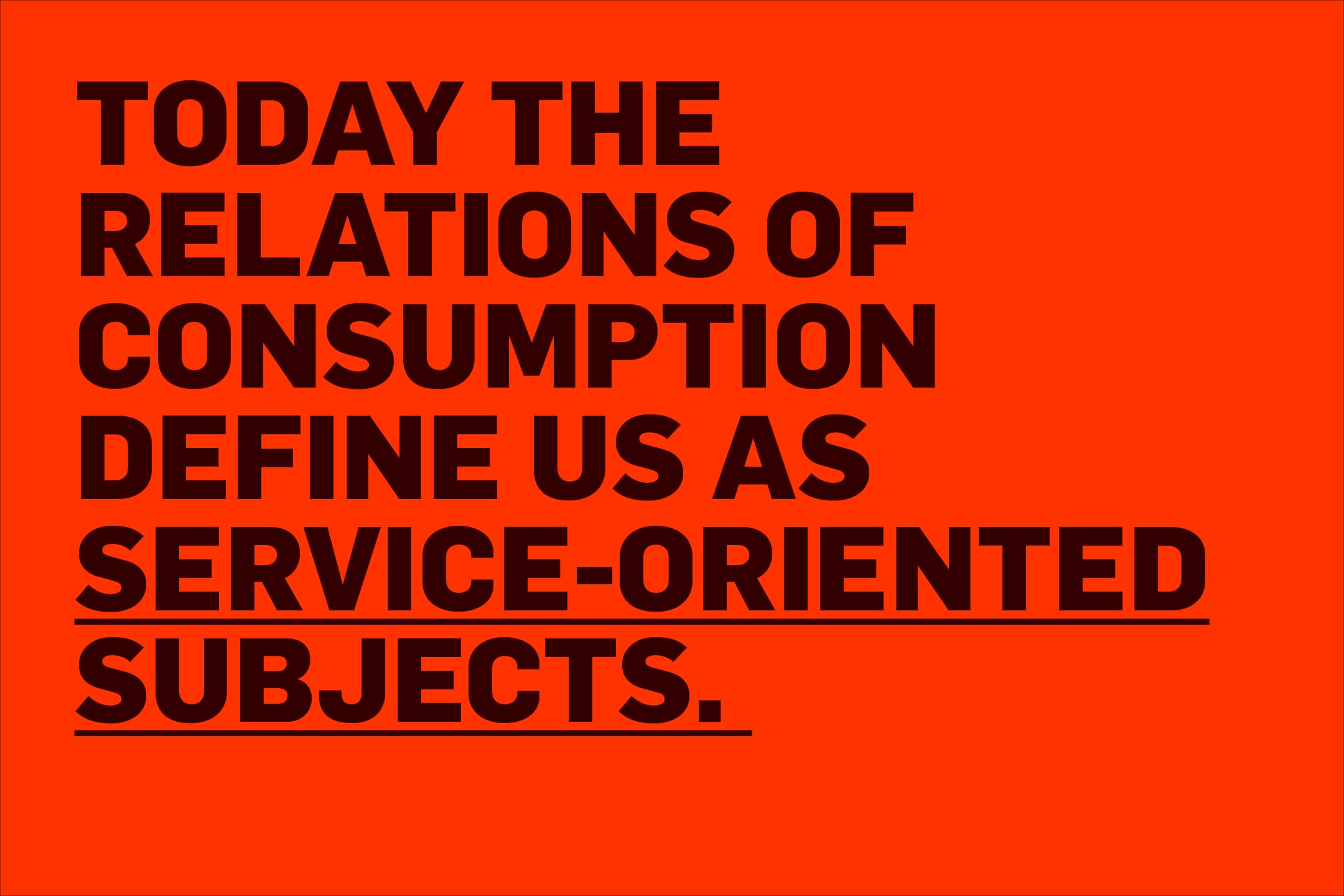
PRESENT FUTURE, TENT, ROTTERDAM / NETHERLANDS
FEBRUARY 22, 2009
MUSEUM OF NONPARTICIPATION (KARACHI), :MENTALKLINIK (ISTANBUL),
ZEYNEP TUL SUALP AKBAL (ISTANBUL)
MODERATOR: FATOS ÜSTEK
:mentalKLINIK between 1998-2004
:mentalKLINIK, with its “undisciplinable” state of mind, founds spaces of movement within the limits of art.
In the beginning :mentalKLINIK’s constructs problematized the relation between the work, its users and its participants. The question of consumption laid at its pivotal point. and ssipration, which itere it is located. n and ssipration, which itere it is located. n We think that the relations between things and humans are exhausted; locked in a world where everything is predetermined with all the details. Experiences of today are transformed into statistics for a future-time. Their medians are calculated while all errors and surprises are left out. Human life is condensed into durational datas. Therefore no longer the same dynamic between the object and the subject retains. They are levelled both being treated as datas for future’s consumption. :mentalKLINIK exposes interfaces of this transformation. First four projects, Sleep, Game, Copy and Self were prototypes questioning the processes of art-design-production-consumption previous to the final process of “data-fication”.
Since 2004,
:mentalKLINIK tags 21st century’s fragments with its own point of view. :mentalKLINIK, locates itself in the passage between two centuries. It slits open spaces between the material and the immaterial world, while being nurtured by emergent cultures and the changes between the centuries in forms of production and lifestyles.:mentalKLINIK creates encounters in its own microclimate and these encounters define the forms of the works. It discusses value relations, it reduces senses and reflects augmented realities, it proposes joyful anxieties and it offers occupations. It designs unidentified spaces, indecisive zones and frozen times. Approaching the immaterial world, :mentalKLINIK keeps records of relations with materials. Archives its views upon objects and states as a “contents" project. Uses processes of creation, design, production and consumption as sources for its works. Names the objects as interfaces. :mentalKLINIK, shifts its view from the object to the back side of it. There, it finds the necessary inspiration. Not only considers technologies as gifts, but also produces forms of struggle aganist the given to overcome these techologies.:mentalKLINIK works on meeting the expectations of the day multiplying its identity as an artist. It mimics the overwhelming multiplication of Internet network.
In an era of passage from a world eagerly anticipating and expecting the future to a world where future is made, where the reality has new form, awareness constitutes the starting point for :mentalKLINIK. Today we are no longer able to envision a future, rather a future without hope occupies our here and now. Nicolas Bourriaud refers that contemporary artists work with possibilities of today but :mentalKLINIK moves beyond this. It assumes a retrospective point of view from the future melting the future in today.
:mentalKLINIK defines a new space of action for the viewers who have become transient refugees in a frozen time as Z. Baumann would define. It exposes the side effects of a frozen time where present and future are merged.
Today the relations of consumption define us as service-oriented subjects. We as subjects always have to compromise our subjectivity with the demands of the services offered. Life itself becomes a commodity offered as a service and immortality is transformed into subject-less sustainability. :mentalKLINIK deals with this shift from immortality to sustainability. It also deals with augmented reality.
The question of reality has always been a driving force for artists and :mentalKLINIK recognizes that the future defines today as an augmented reality. Augmented reality is an environment that includes both virtual reality and real-world elements at the threshold of future and present. In its works and constructs :mentalKLINIK deals with Augmented Reality because it shifts our perceptional relations. :mentalKLINIK wants to record Augmented Reality’s effects on our ways of seeing.
One of the fields where :mentalKLINIK directs its gaze is the emergent use of nanotechnology. While the ambiguity in areas of application created by its talented structure and its invisibility alters human perception and scales of reality, nanotechnology also transforms dreams of immortality into a presentation of a sustainable life. Nanotechnology, capable of making small scale suggestions unfamiliar to us about main issues such as security, health and raw material, presents itself as an essential agent in the physical and social transformation of Subjcets of the future. Even the political and economical rules just defined about it are uncertain. This dangerous but fertile world of nanotechnology evoking anxiety provokes :mentalKLINIK’s perspective and prompts it to think on and produce probabilities. What interests :mentalKLINIK is ofcourse the complex realm where the problematics of side effects and of a possible asthetics brought about by the transformation of materials merge.
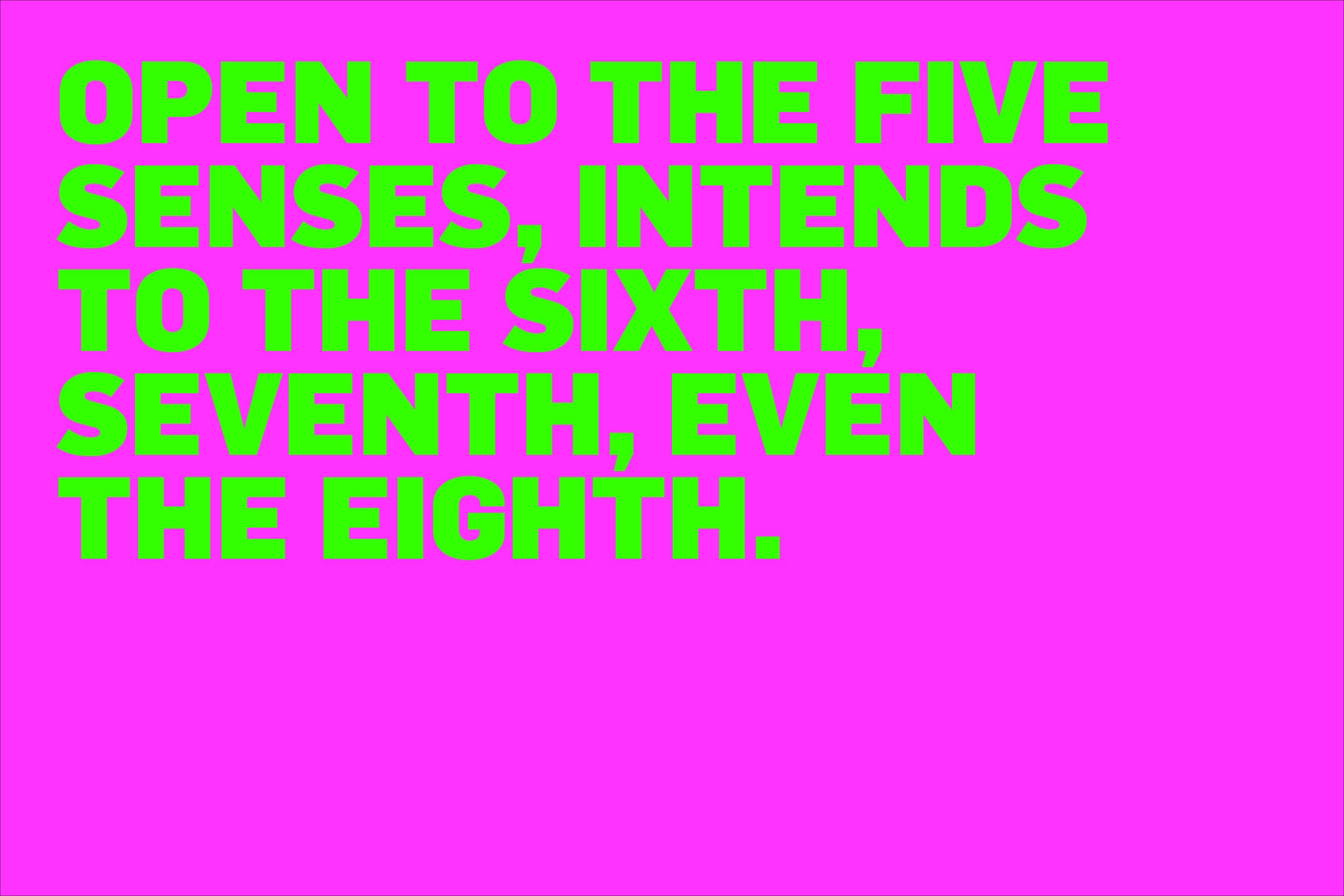
:MENTALKLINIK, 2000
:mentalKLINIK is interested in concepts/ideas. It devotes certain periods of the year to certain concepts. It undertakes the projects within the person-object-culture triangle. And yet these are not necessarily determined behaviors. The production phase is significant as the result itself. :mentalKLINIK is neither a store, nor a gallery. It is a space open to the five senses and intends to the sixth, seventh and even the eighth. It realizes its projects through team work, without ever denying individuality. The naive, the amateur and the professional can coexist at :mentalKLINIK.
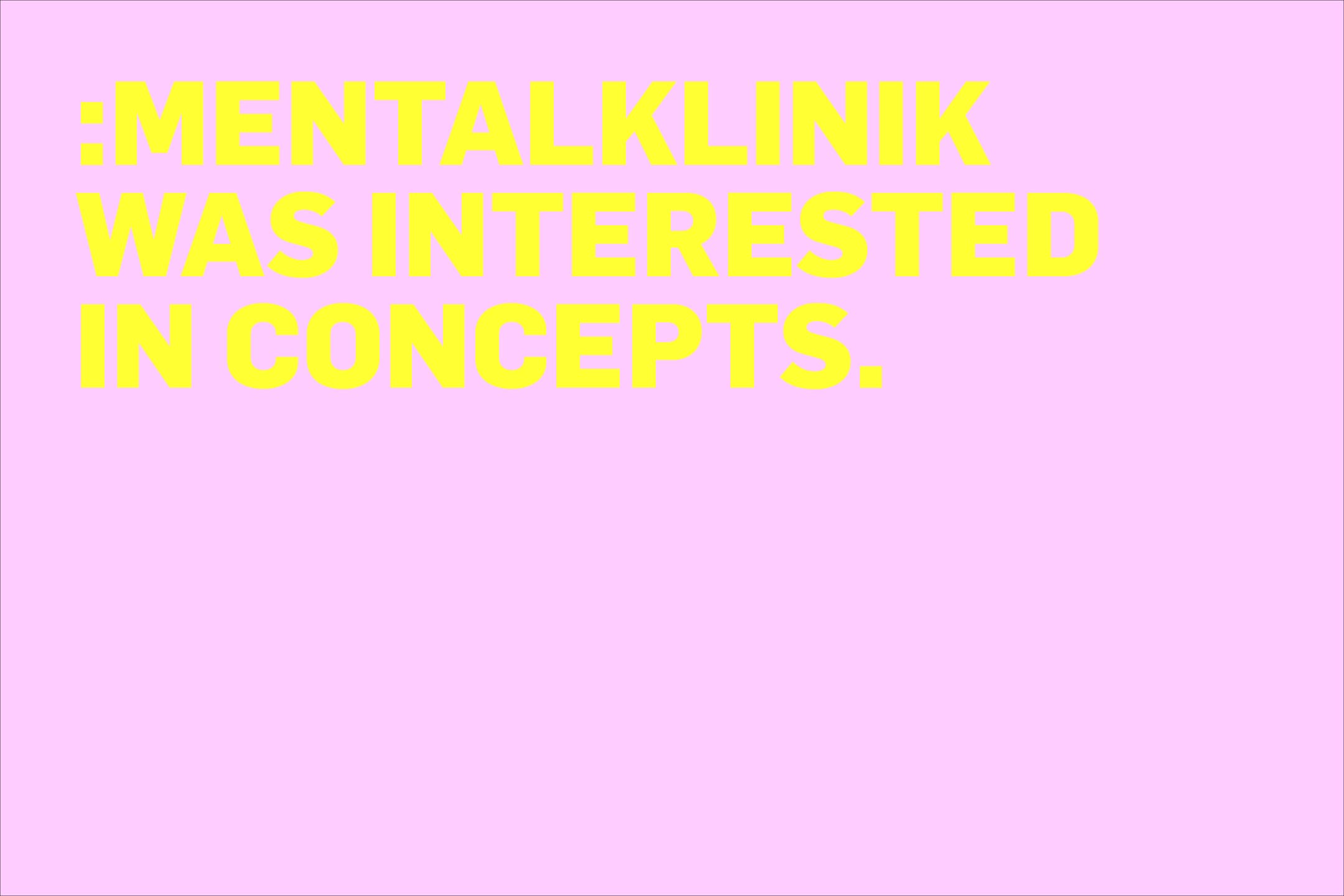
:MENTALKLINIK, 2005
:mentalKLINIK was interested in concepts. It produced projects around certain concepts. It carried out these projects from within the human-object-culture-value quartet. Nonetheless these actions were not that deliberate. The production process was just as important as the result itself. :mentalKLINIK projects made the spaces where they were hosted available to all senses by adding new dimensions to them. :mentalKLINIK engaged in group work but never denied individuality. Since 1998, :mentalKLINIK realized (sleep), {game}, [copy], and ~self projects; it carries on working
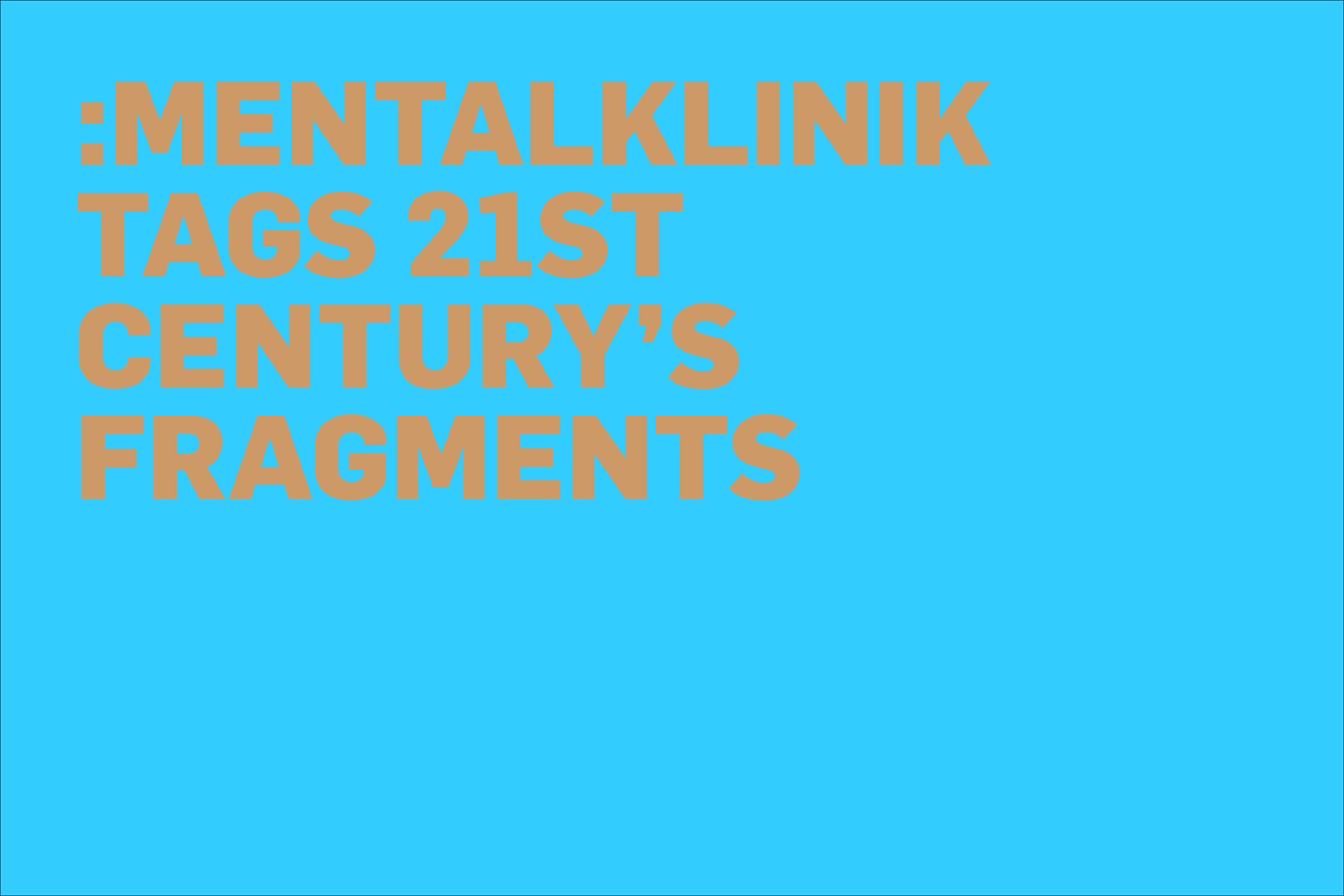
:mentalKLINIK, 2008
:mentalKLINIK tags 21st century’s fragments with its own point of view. It designs unidentified spaces, indefinite zones and frozen times. Keeps records of relations with materials, while approaching to the immaterial world. Works on the subjects/concepts/states/behaviors. Produces forms of relations with participants in its defined time and space. Uses processes of creation, design, production and consumption as sources of its works. :mentalKLINIK with its “undisciplined” state of mind, finds space of movement within the limits of art.
Thinks over the relations between time and space, subject and object, object and time and produces. Names the objects as interfaces. Introduces new dimensions in the space where it is located; opens the space for all senses.
:mentalKLINIK, slides its view from the object to the behind of it. There, finds the necessary insipration. “Archives” its views upon objects and states as an “ingredients/contents" project. :mentalKLİNİK, locating itself between the subject and the object, creates a joyful anxiety with its methods of “causing an accident” in its own interface. Not only considers technologies as gifts, but also produces forms of struggles against the given to overcome these techologies.
:mentalKLINIK is interested in the unidentified, the indefinite, the interrupted, the distorted, the damaged, the abraded, the frozen, the volatile, the immaterial, the uncertain and the unpredictable. This interest brings the consideration of fictions regarding the future with a critical perspective.
Materialized blurred things are suggestions concerning the reconsideration and redesign of the one that already exists and that is believed to exist inevitably. :mentalKLINIK works on meeting the expectations of the day and the consequent multiple identity of the artist. Encounters identities and states, multiplied in the network, with multiplying artist’s identity. Inıtial point of :mentalKLINIK’s works, is the awareness in a time of passing from the world, eagerly anticipating and expecting the future, to the world where future is made.
:mentalKLINIK, locates itself in the passage between two centuries, wants to hole inbetween the material and the immaterial world in its own understanding of time and space, while being reinforced by the emergent cultures and the changes of forms of production and life between the centuries. :mentalKLINIK, with the constructs on which value relations are discussed, the joyful anxiety, the works that reflect augmented realities with reduced senses, the exhibitions that offer occupations, produces encounters in its own microclimate. These encounters define the forms of the works.
Nonethless these actions are not that delibarete.
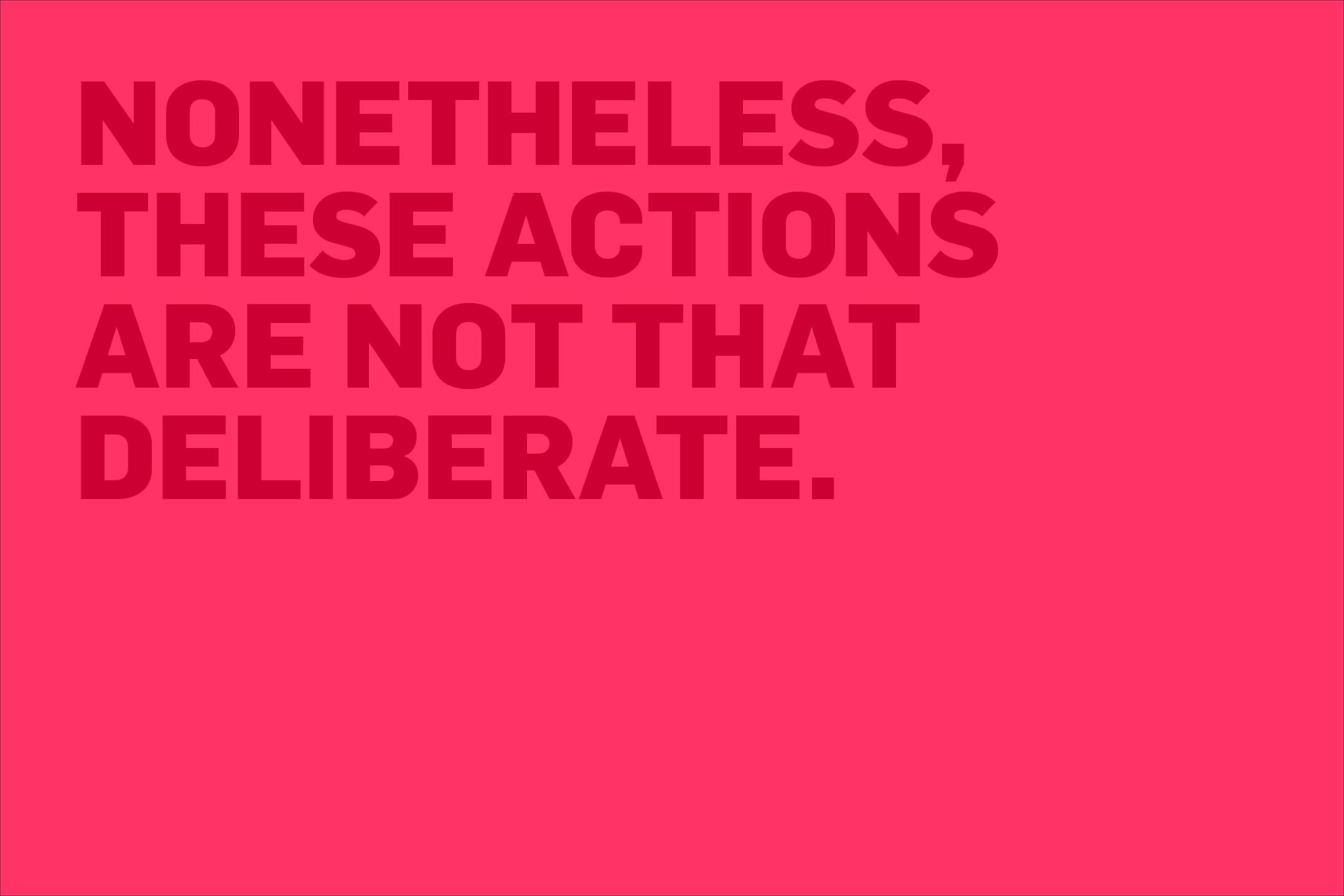
:mentalKLINIK 2004
:mentalKLINIK was conceived by Yasemin Baydar and Birol Demir in 1998 and it was brought to life in an apartment floor in Istanbul/Topağacı in 2000.
:mentalKLINIK has been founded with the aim of redefining and recreating the processes of artistic creation, design, production and consumption, on the basis of a form particular to itself. Given :mentalKLINIK’s interest towards concepts, it always constructs its projects on the basis of a concept and goes on by reframing this concept by means of individual and collective efforts. In :mentalKLINIK’s projects action and knowledge, practice and theory, the amateur and the professional, the naive and the constructed are all equally important and valuable.
:mentalKLINIK is not a space. But it does have physical space of its own. It carries out some of its projects in this space. It perceives the space as a shell that can be filled and emptied. :mentalKLINIK itself is also a shell. Within the time and space that it defines, it creates relationship forms with people it invites. In each space that it positions itself, it adds new dimensions to the space and aims to open the space to all senses. :mentalKLINIK is not a space but it opens and alters spaces.
:mentalKLINIK positions itself in the thin line emerging where borders start to dissolve and create its projects. :mentalKLINIK posits its critical view in the relationships between the consumer and the consumed product, similarly between the production and the producer, between the viewer and the exhibition, in forms of presentation but can at the same time incorporate some of the existing forms without altering them. It constructs the distances in its relationships; with institutions, with firms, with artists, with participants and with audience/consumers and between all these, it specifically arranges the distances.
:mentalKLINIK orients its projects towards processes rather than results. The result takes on their form when they encounter the audience/consumer in the spaces that :mentalKLINIK positions itself in.
:mentalKLINIK deliberates and produces on time and space, human and object, object and time relations; it labels objects as interfaces. It evaluates and discusses technologies with underlying intentions in mind. :mentalKLINIK is open to the five senses; it is willing to open the way to the sixth, seventh, eighth senses. Opening new layers in the world of objects, moving inward, making the hidden knowledge there visible. Multiplying the meaning of objects, rendering them meaningless, attributing new meanings to them, selling, bartering, gifting, copy-left distributions, copyright limited productions, limited productions, numbered products, software programs, games, beverages, undefined smells, tastes, fictional stories, virtual initiatives, relationships suffering accidents are all present within :mentalKLINIK.
:mentalKLINIK endeavors to alter and dislodge existing relations, to devise new types of relationships and possibilities, It tags the fragments of the 21st century through its own point of view. It designs undefined areas, undecided regions, frozen times, and records relations with materials as we approach an immaterial world.
Nonetheless, these actions are not that deliberate.
In order to multiply its identity and its outlook from its current position,:mentalKLINIK created subtitles such as semi:mentalKLINIK, docu:mentalKLINIK, and :mK. Thus it invented forms for the acts of taking, giving, distributing, disseminating, busying, combining, mixing, archiving, and accommodating.

semi:mentalKLINIK
semi:mentalKLINIK is a sub-title of :mentalKLINIK which introduces to the audience national and international projects other than its own and which likes host, share and realize mutual projects. semi:mentalKLINIK, like the other titles of :mentalKLINIK, chooses subjects and guests which share its perspective and its expansive standpoint. At different times of the year :mentalKLINIKwelcomes these subjects and guests for a certain period of time; and when it meets a guest or a subject it is deeply fond of, it makes sure to underline its affection by hosting them over and over again.
semi:mentalKLINIK is neither a shop nor a gallery but rather a space that brings the two together under a common denominator. Thus, both the transient and the enduring meet with :mentalKLINIK’s concepts of time and space.
:mentalKLINIK presented two shows of Joel Andrianomearisoa titled THE EPHEMERAL BOUTIQUE and BLACK OUT under semi:mentalKLINIK in its own space.
Joel Andrianomearisoa
BLACKOUT
8 November_22 November_ everyday_ 14:00_19:00
:mentalKLINIK
BLACK OUT / BLACK OUT WILL BE AN ENIGME, A SURPRISE BLACK WALLS /
BLACK LIGHTS / BLACK THINGS FOR A LOTS OF SURPRISE
SURPRISE : THINGS / MATERIALS / IMAGES / LIGHTS / OBJECTS / PIECES / SENSATIONS /// NO DEFINITION
BLACK OUT IS NOTHING AND EVERTHING
NO LIMIT / DARK /
THE END OR THE BEGINNING ?
THE FIRST OR THE LAST ?
Joel Andrianomearisoa
THE EPHEMERAL BOUTIQUE
30 May_12 June_everyday_
:mentalKLINIK
semi:mentalKLINIK realized its first project in 2004 with Joël Andrianomearisoa's 2004 summer collection entitled 'la boutique éphémère'. Joël Andrianomearisoa defines his project 'la boutique éphémère' as an installation, a staging, and a boutique at a certain place and for a limited period of time, where one can get various things such as dresses from his 2004 summer ready to wear collection or dresses produced in a limited edition for his istanbul show. the 'Ephemeral Boutique' was open between may 30- june 12 at :mentalKLINIK. 'dinner by bobo paris', another installation by Joël Andrianomearisoa, which he calls 'an installation based on smells', was also exhibited there. 'la boutique éphémère' - The Ephemeral Boutique was made possible with the support of the İstanbul French Cultural Institute.
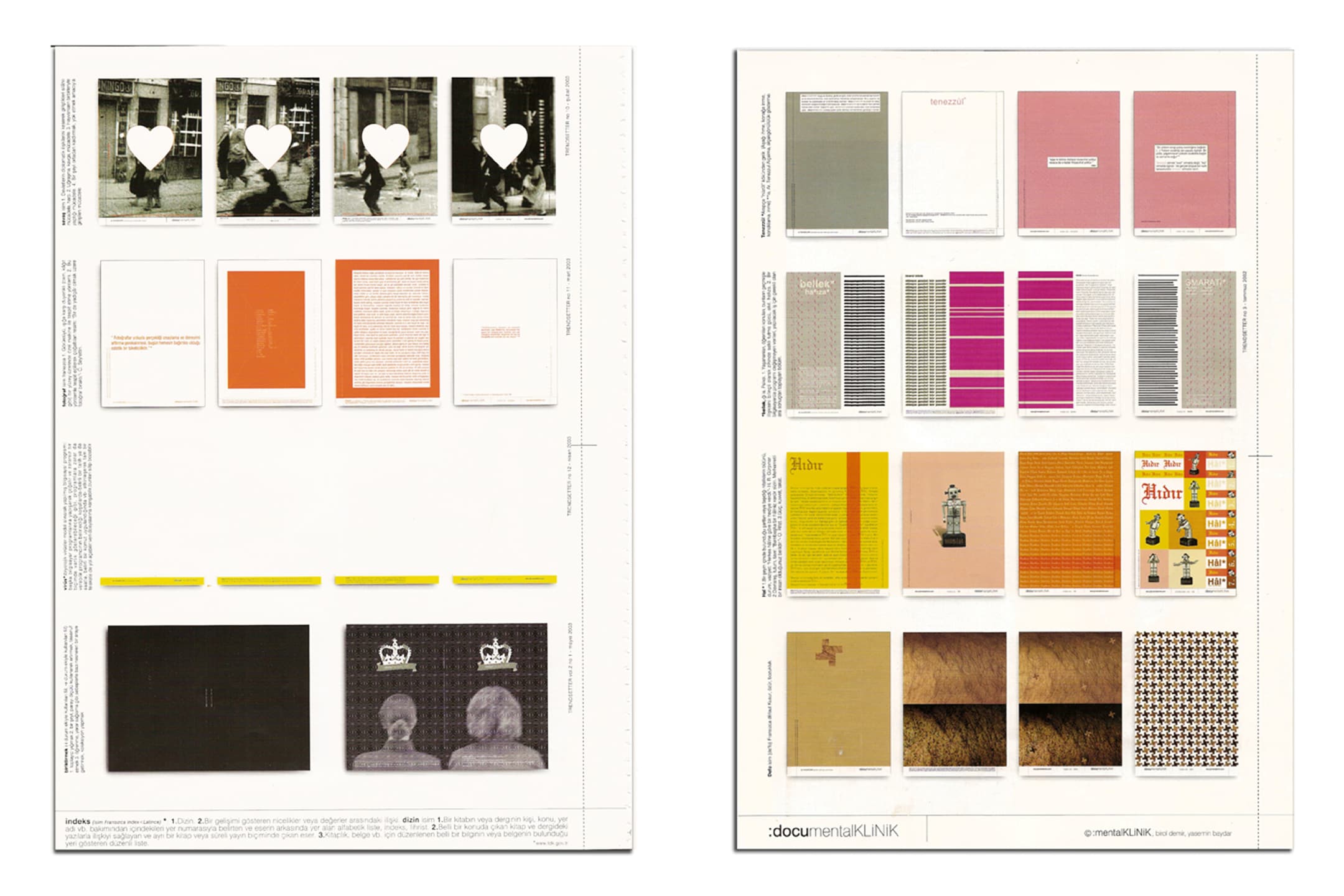
:documentalKLINIK
A form of documentation seeking to explore, point out, and remind one of certain concepts and contexts pertaining to emotions and behaviour, form and content, culture and identity. Transforms its aorist present point of view, on what it has documented related to concepts and contexts, into a collectable form.
Interested in the journey of point of view in time and space. Plans encounters during its journey. Gets interested, asks questions, answers, relates, arranges collisions, plans encounters, multiplies, sorts out, creates in-between spaces, expands the time and space it is located in, realize accidents for time and space. By locating itself in the space between the abstract and the concrete, creates temporary, transitive and permeable contexts. Is interested in all states of in-between spaces. It is a fluid and nomadic form.
docu:mentalKLINIK can locate itself in and can take its point of view on a journey in magazines, web sites, CDs, publications, newspapers, etc. Does not have a permanent address other than its web address. Invites, gets invitations, makes itself invited. Wants to establish relations between different publications and mediums. Wants to provide solutions for content crisis. “Emergent cultures” are among its areas of interest. As much as it can have long-term relationships, it can also have short-term relationships. Is available for multiple relations simultaneously.
*docu: mentalKLINIK is a subheading of :mentalKLINIK.
docu:mentalKLINIK issues (2002-2007)
:mentalKLINIK duo has founded docu:mentalKLINIK in 2002 as a form of documentation.
TENEZZUL (condescension),
Trendsetter, Vol.1, No.2, June, 2002
BELLEK (memory),
Trendsetter, Vol.1, No.3, July, 2002
HAL (state of being)
Trendsetter, Vol.1, No.4, August, 2002
DEFO (flaw, defect)
Trendsetter, Vol.1, No.5, September, 2002
ALTÜST/TERSYÜZ (upside-down/inside-out)
Trendsetter, Vol.1, No.6, October, 2002
SİMYA (alchemy)
Trendsetter, Vol.1, No.7, November, 2002
HİÇ (nothing)
Trendsetter, Vol.1, No.8, December, 2002
REKLAM (advertisement)
Trendsetter, Vol.1, No.9, January, 2003
SAVAŞ (war)
Trendsetter, Vol.1, No.10, February, 2003
FOTOĞRAF (photography)
Trendsetter, Vol.1, No.11, March, 2003
VİRUS (virus)
Trendsetter, Vol.1, No.12, April, 2003
BİRİKTİRMEK (to collect)
Trendsetter, Vol.2, No.1, May, 2003
ALKIŞLAMAK(to applaud / to clap)
Trendsetter, Vol.2, No.2, June, 2003
YELLENMEK(to fan/ fanning)
Trendsetter, Vol.2, No.3, July, 2003
TASVİR (description)
Trendsetter, Vol.2, No.4, August, 2003
SURET (appearance, copy)
Trendsetter, Vol.2, No.5, September, 2003
INDEKS(index)
Trendsetter, Vol.2, No.6, October, 2003
_ccidRnt
Colophon 2007, Luxembourg
IMAGE / IMAGINE
Fashion Shoot for Nico Magazine, Sping/Summer 2007
AGORAPHOBIA ]control initiative[, 2007
art_ist magazine
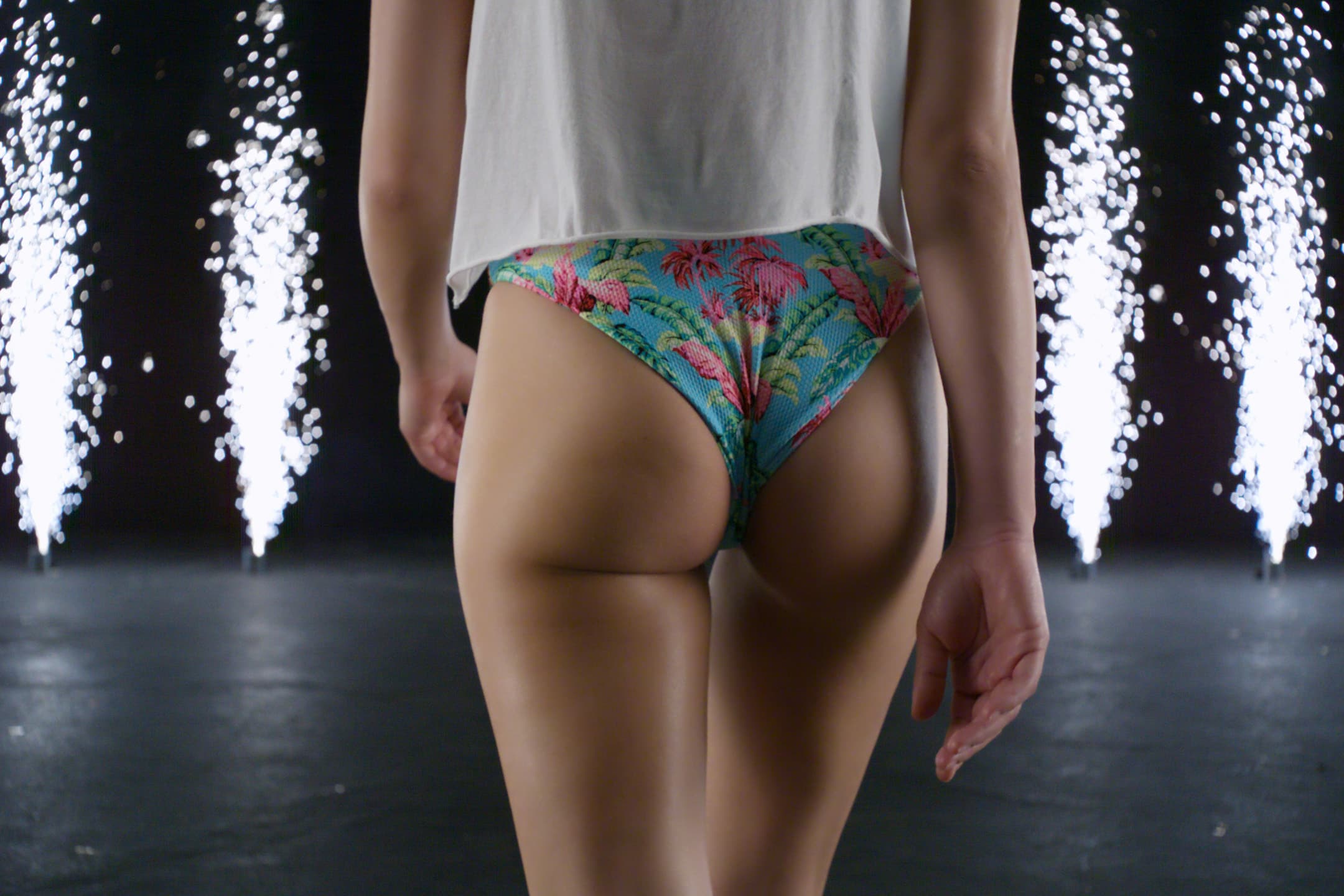
THE MEANING OF LIFE ACCORDING TO :MENTALKLINIK
BE SEDUCED
DAMN MAGAZINE, DECEMBER 2015
The cheerful, cigar-smoking duo behind :mentalKLINIK produces the kind of neat and bright glitter & glamour that appears easy to consume. However, behind its seductive façade glimmers a much deeper significance that at once surprises and disturbs. “We never start with a message, but in the end each of our works somehow radiates significance.” From their base in Istanbul, Yasemin Baydar and Birol Demir lure their audience into a multi-layered universe.
When in 1998 they started to collaborate with a few fellow artists, the pair had no idea that this casual group would soon grow into a crowd of some 150 people. In 2000 they established their own artist space in Istanbul. “We did so out of necessity, because in Istanbul existing galleries were boring. We used our space to experiment; we challenged our audience to take up a different attitude, and we started to play with taste, smell, and sound long before triggering the senses became mainstream salesmanship in commercial businesses.” This DIY, experimental, and collaborative approach duly culminated in :mentalKLINIK. Even though since 2007 the two go through life as a duo, they still work in close collaboration with various specialists from different disciplines – artists, philosophers, poets, scientists, computer programmers, and software designers. Typically, the mediums employed range from painting to software, performance, sound experience, installation, video, and taste happenings. Any medium might be suitable to voice their message.
“You won’t see much Yasemin or Birol in our work, which distinguishes us from other artist duos. We think of :mentalKLINIK as a third person; we don’t put our own personal emotions into it”, they explain, although Baydar would seem to be the mental component, and Demir the klinik. “It’s a creative, factory-like entity that researches ideas and consequently transforms the result of the research into something appealing.” Sharing all stadia of their work with the audience is still part of their artistic practice: they also occasionally open their studio – located in the affluent neighbourhood of Nisantasi – to the public. :mentalKLINIK’s international career began at Art Basel in 2009 with the installation PuFF: a never-ending ballet whereby glitter is continually vacuumed-up by little black robots in the form of discs. The international audience became curious to know more.
The pair’s oeuvre flirts with marketing and entertainment. “Just like commercial brands and the entire capitalist system, we manipulate people’s anxieties and desires.” Titles like FASCIST - OPENLY GAY - DOGMATIC - WHITE COLLAR - ANIMAL LOVER - SUBMISSIVE - ELITIST and THAT’S FUCKING AWESOME catch one’s attention. “All humans are tempted to be excessively attracted by shiny-happy selfies, by flashy gadgets, etc. We present our work in exactly the same way products are launched into the market, using invisible strategies to make you buy things you actually don’t need. Of course, we don’t stop there: behind the sparkly façade, we have created awareness.” Yasemin Baydar and Birol Demir often use oxymorons in their language works (i.e. He is disgustingly handsome / She is awfully beautiful). “We use them as amplifiers, intensifiers. We think that oxymorons reveal the deep duality of the world and reflect the complex feelings that people are usually unable to express. It is necessary to add conflict into our expression in order to show what we really feel deep inside.”
Baydar and Demir usually take their inspiration from what is happening today. “We are trying to enlarge that moment, to enlarge the ‘now’ and to explore it. It’s important to fully understand what is going-on in the present, since heavy changes are taking place in people’s lives all over the world: we’re all becoming part of a totalitarian system which is being developed through data processing. While people are being overwhelmed by an increasing amount of data, institutions like the G8 are making us obey” (a fact that they refer to literally in their work Thank You For Your Cooperation). “The result of this evolution is that we are becoming highly predictable and controllable human beings. Our species is being robotified. And the irony is that meanwhile, robots are being humanised ... they are becoming more emotional than humans...!” mentalKLINIK’s exhibition at Louise Alexander Gallery in Sardinia this past summer, entitled 83%SatisfactionGuaranteed, referenced that evolution. “Publicity promises 100% satisfaction, which is of course not possible, and not even desirable. Unsated desire always exists, which enables surprises to occur in our daily lives. Unfortunately, nowadays surprises and desire are being reduced by the data calculation mentioned earlier, which wants to make people ‘predictable’.”
Their art might be critical of our way of living, of capitalism, and of Turkish society (“Because of the troubled history, Turks are obsessed by all that is new and shiny. They would gladly take a pill enabling them to fast-forward 20 years …”), but thanks to the gleam and sparkle of the work, it remains outside the radar of the Turkish government – where you can easily see ONLY the lovely façade. Coincident with the current Istanbul Biennial, for instance, :mentalKLINIK is participating in Art International İstanbul with a solo exhibition. But they’ll wait and see about travelling to Athens, where they’ve been invited to make an exhibition, if even their work raises critical questions about the inhumane capitalist system the Greeks have fallen prey to. “Through various experiences with the Gezi Park protests in Istanbul, we know that in the middle of a crisis, people consider art a luxury and won’t fall-in with the idea.” Especially not when it twinkles…
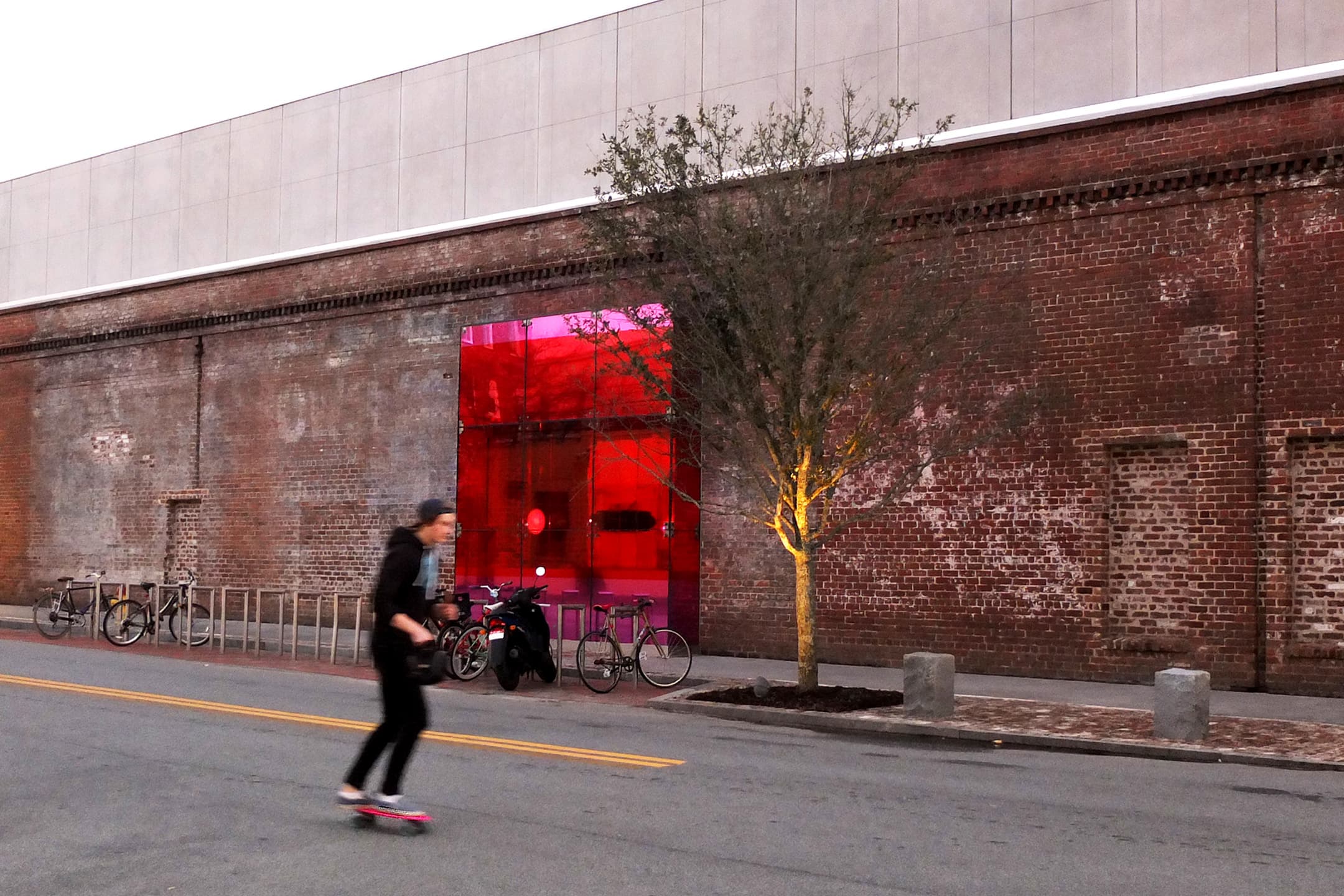
TURKISH DUO :MENTALKLINIK DISPLAYS WORK AT US
RUMEYSA KIGER / ISTANBUL
TODAY'S ZAMAN, April 14, 2015
İstanbul-based artist duo :mentalKLINIK, composed of Yasemin Baydar and Birol Demir who have been working together since 1998, are currently presenting their first-ever exhibition in the United States, at the Savannah College of Art and Design's (SCAD) Museum of Art in Georgia.
Titled “Co-operation will be highly appreciated,” :mentalKLINIK's installation reflects the spirit of the present day through the use of technology. For the exhibition, the artists used robotic moving lights seen in nightclubs and concerts that are programmed into an endless, looping choreography mimicking human interaction.
“The attempt to replicate body language, sensations and feelings results in a dynamic set of movements, reminiscent of [being at] play, and is in contrast to human interaction and interpersonal communication that is increasingly mediated by technology. A soundscape … places the spectator into that stand-by mode of attention that we all maintain in relation to our gadgets,” according to a recent press release about the exhibition.
Using colorful reflective surfaces, billboard-style signs and rhetoric to explore new languages and alternative textures in their work, :mentalKLINIK steers away from the regular, normal and rational as, according to the press release, the artists “attempt to reveal what our new order looks like -- an altered, through-the-looking-glass reality.”
Storm Janse van Rensburg, head curator of the exhibitions in the museum, explained in an interview with Today's Zaman that the show explored current capitalistic trends where exercising free will is arguably being eroded.
“The title of the installation refers to living in an age when we think we are individuals but continue to consume and socialize in a choreographed and restrictive existence. The phrase is a polite instruction to conform, behave and toe the line,” he said.
Having been familiar with :mentalKLINIK for several years, Rensburg was interested in the translation of their ideas into a very public and visible aspect of the SCAD Museum of Art facade. “Their approach convinced me that they could realize a project which engaged the iconic architecture of the museum in a refreshing way, but also catch the passersby using the busy pedestrian and street corridor. Their work draws on several senses, pulling in viewers,” he said, adding that he loved the concept from the first moment.
According to Rensburg, :mentalKLINIK's interests are issues dominating our time and, in many cases, things we take for granted. “Our lives are entangled with the digital world and there continues to be less distinction between what's real and what's virtual. Our social lives are mediated through mobile devices. We talk, meet and date online. This change is radically shifting how we relate to each other and the world. This is the ‘through the looking-glass' reality [we] refer to,” he notes.
As to the usage of technology in their works, the curator explains that it is a tool the artists adopt and employ in carefully considered choreographies. “These elements are familiar to us, but the artists use them in new and unexpected ways. For example, moving headlights feature prominently in the installation and are a technology we know from concerts or advertising events. But the artists create a conversation between two lights in close proximity to each other giving them a human quality,” he said.
He further underlined that an important aspect of working with :mentalKLINIK was the opportunity it provided to students at SCAD to contemplate important present-day issues. “Their novel approach to materials offers a language that's accessible and thought-provoking. :mentalKLINIK [touches upon] various disciplines including art history, visual art and design,” he added.
The exhibition, which will run until May 3 at SCAD Museum of Art, is part of deFINE ART -- the university's annual fine art showcase designed to bring together artists, curators and professionals actively shaping and giving rise to new artistic expression, dialogue and innovation.
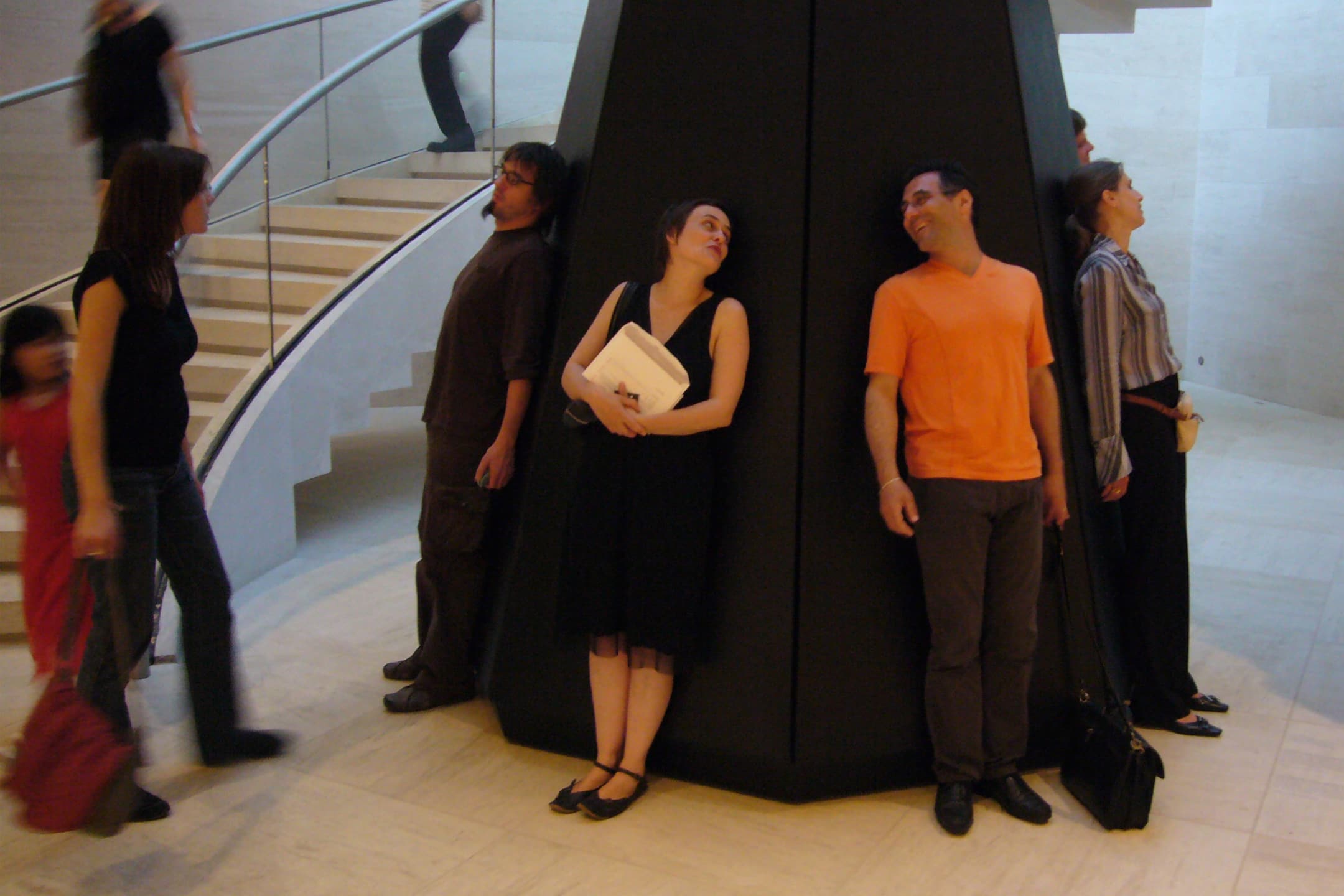
TO FREEZE THE TIME
BJÖRN DAHLSTÖRM,
INDEPENDENT CURATOR
2007
Frozen 45” by :mentalKLINIK transports us into an era yet to come, the Biot technosociety where we can model our own bodies becoming the actor and the subject simultaneously. Indiscernible in its application, Frozen 45” is a treatment of the future whose effects are discerned through the Biot transformation process and it offers to fix the transformation of the skin. The faces of the visitors become then an invisible sculpture disclosing the way the museums may exhibit the Biot when the frontiers between humans and objects no longer exist.
This is the principle of this miraculous product, a cosmetic, regulator of time and portrait sculptor, conceived by :mentalKLINIKand praised by the mini guide of Tomorrow Now when design meets science fiction exposition for which Frozen 45” has been imagined. The public is invited to experiment it at Mudam, Musée d’Art Moderne Grand-Duc Jean, Luxembourg until the 25th of September 2007.
It is around the theme of pharmacopoeia that :mentalKLINIK takes advantage of the secular sweaty dream of humanity: to master the time and its effects. Psycho-pharmacy is largely addressed in the exposition, notably with the presentation of Hans Hollein’s architecture pill, a representative project of homeostasis at the service of modified environments. A simple colored pill in a transparent wrapping, «control kit of the non-physical environment» to quote the expression of its author, that takes responsibility - with irony- for creating a sane equilibrium between the environment and its occupant. With Frozen 45” the medication no longer works orally but through spraying onto the face, the solution effects in priority the body and no longer the spirit immediately. The subject receives the treatment leaning against a conical octagonal stupa which looks like a trans-door and which becomes a treatment cabin. Also a thermo-sensitive, self-sticking pastille applied again onto the skin, controls the effects of the medication on the patient during 45 minutes, the amount of time required to visit the Tomorrow Now exhibition, as indicated by the product. All is at the cost of 3 €.
Is Frozen 45” a placebo? What matters is the predisposition of the patient- A Dorian Gray feeble for three-quarters of an hour-in the naive follow up of the ceremony imagined by the Turkish Collective which takes the visitor into pleasured anxiety. What is the validity of the treatment and its potential danger? Is the museum still today one of the last places where such experiments can be conducted?
One is tempted to believe that it is the case, abandoned to the treatments of the mediators of the museum who apply the process literally, activating humor and conviviality, the relational esthetic as defined by Nicolas Bourriaud, or the esthetic of communication as initiated by Fred Forest in the 80s which queries the problematics attached to our perception of time and space, and even more here, to our relation to art as a model of simulation against powers- the salesman of eternal youth, their industrial cosmetics and their possible placebo effect which may be even nocebo. As it is exemplified in their global projects GAME, COPY, SELF..., that is where :mentalKLINIKis situated, beyond the merchants of systems and institutions of art in a world where everything happens as if art evades the traditional modes of diffusion and takes possession of everything.
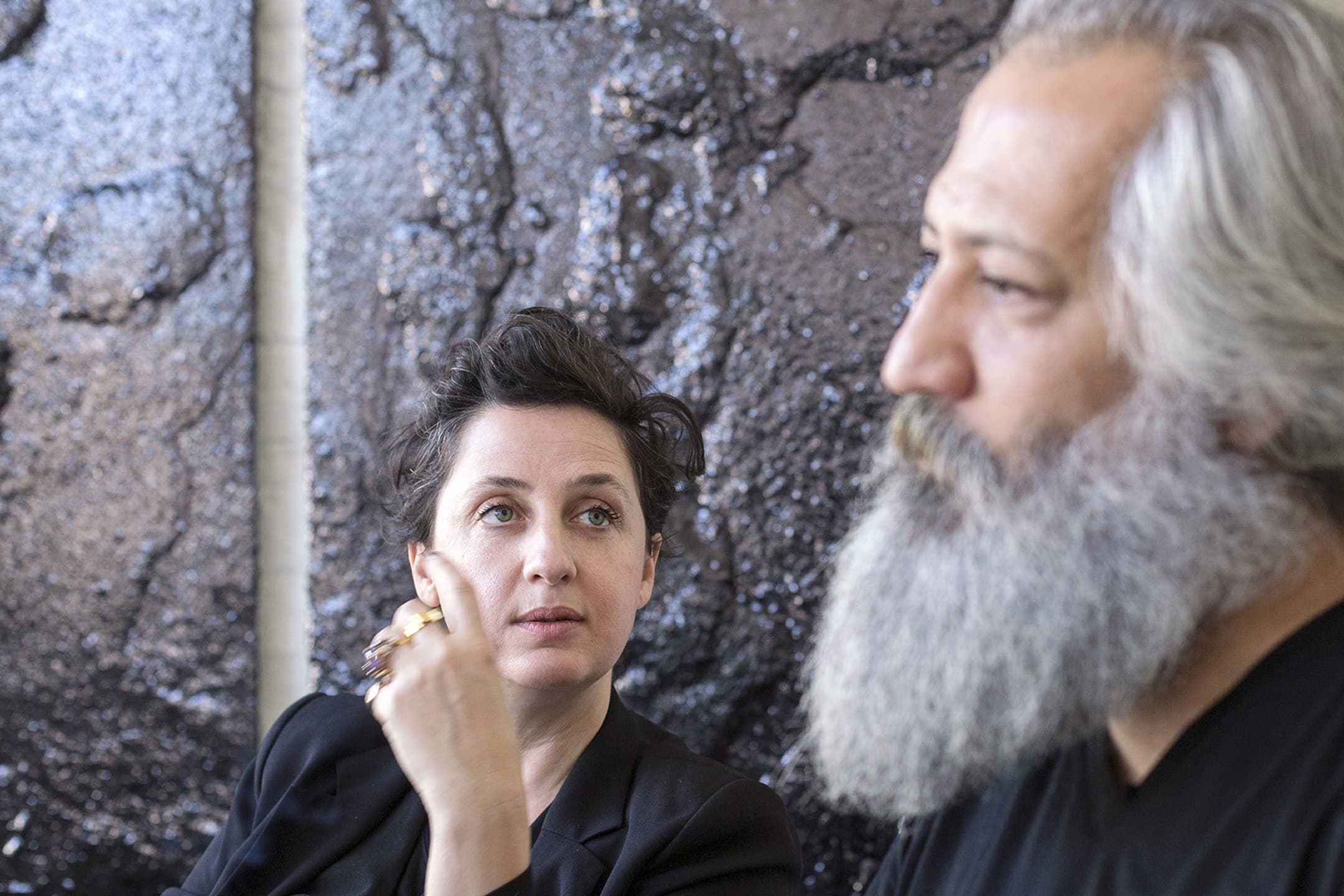
MONODIALOGUE BY :MENTALKLINIK,
Interview by Oktay Tutuş
SKYLIFE BUSINESS, 2011
We conducted an interview at Art Basel this year with :mentalKLINIK, which consists of Birol Demir and Yasemin Baydar.
Yasemin: Giving interviews causes me a lot of stress. Many things are causes for stress; interviewing is just one of these. When I give interviews, it’s as if I have to stop time and look at the past. I don’t like looking at the past. I prefer looking at the present, living in the present, and capturing the past and future within it. Perhaps I feel like I’m being put to a test in every interview for this reason. Are the things I have so far thought consistent? If they are consistent, it’s scarier anyway… Within all these thoughts, I must review my own thoughts, what I did, my work, and my life, thus the interviews we give create breaking points in our production.
Birol: What sort of pleasure do you think following someone else’s time is ? I mean, they both want to get to know you, and they want to be with you within the time you make. Thus, there is a large likelihood that interview format has been the most read section in publications.
Y: Following became the most important action. How many people do you follow on Twitter, Facebook, and similar places; how many people follow you, and how much do you write? It’s very quantified. I think following your own time and someone else’s time has to do with living, thus someone else’s time and your time overlap. The concept of being everywhere at all times, omnipresence or ubiquity, describes the person of today and their lifestyle very well. Thus, relationships, perceptions, and values are changing, and brand new forms of behavior are emerging.
B: What do you think the reader wonders about when interviews are conducted with artists like us, who work as a duo?
Y: Every state of being a pair is a different experience; it can be mired in conflict, or it could be harmonious. I don’t know what the reader wants, but ours might be a little confusing.
B: Yes, for us, it’s conflict, tension, and harmony. We experience all of these intertwined, and there is no rhythm to it.
Y: Perhaps because we don’t work in a very planned manner.
B: Yes, because we actually look at the same things every minute, or because we see different things.
Y: We don’t have a single method; we work without a method.
B: Every time we get up, that day starts anew. We try to find a road again, as if we never worked together before.
Y: Every work and project sets its own system and method. For some, we work physically with a very concentrated bodily force, and for others, without touching anything. Thus, every method changes a lot depending on the character of the work we are doing, in my opinion.
B: Do you remember? How had the PuFF project, robots, and glitter exhibited at Art Basel 40 and Art Unlimited two years ago come together?
Y: Years ago, we had seen the robot brooms in a sales catalog on a plane, and we thought it was a fantastic idea.
B: I saw it first.
Y: No, I saw it.
B: No, you’re mistaken; it was I.
Y: I saw it first.
B: Are you sure?
Y: I’m sure.
B: Well then, how did we produce this work after that?
Y: I don’t remember so clearly… I think you thought of the glitter, cleaning, and dust.
B: Where’d the glitter come from?
Y: From your arabesque tastes… [They laugh]
B: Yes, that could be so.
Y: Sometimes you say the feminine things, and I choose those that are masculine. Because I don’t like working physically, I choose the robots, and you the sparkliness.
B: What about DoubleCherry?
Y: From the woman’s earrings.
B: Ah, yes, the woman at the table next to us. But I was the one who liked her.
Y: I liked the earrings, but you related them with us.
B: I converted it for us because it was a very surprising thing, and it looked quite beautiful on the woman.
Y: Yes, it was lovely—straw hat, cherry earrings…
B: Where did we see her?
Y: At Balıkçı Sabahattin [a fish restaurant].
B: Quite interesting, I had never engaged in thought looking backward like this.
Y: Here we have turned back, don’t you see? We have memories too.
B: How did the “Sliver” series start?
Y: The Slivers are the fusion of the world of industrial products we reached during our search for materials while preparing the dual occupation exhibit and, of course, the era in which we followed Tül Akbal Süalp’s doctoral classes. It coincided exactly with a period in which practice was intertwined with theory.
B: Yes, so far as I can remember, Tül’s theory she described as “Imaginary Subject,” and the texts we read and films we watched in class throughout the year.
Y: We were constantly talking about the idea of the lack of an adhesive; there is something missing and things can’t hang on to one another. The possibility to be multipartite, with multiple options and categorized, to again be multiple yet heteretopical in today’s world determined the aura of the Silver series.
B: Today, we talk of subjects trapped in the surface.
Y: We’re not debating whether this is good or bad; we are talking about a world that is on the surface and doesn’t actually leave much of a trace. We can see the traces of today as data. Data recorded in flux can be related and manipulated by data miners many times in various forms. Just as we have no belief in historiography, I look at the excavations to be made from the future to the present with suspicion already.
B: Flux?
Y: Lives in flux continue, and if we are to speak of being societal there, societalizations sparkle up suddenly like lightning, and then they disappear very quickly.
B: Like fireworks, actually.
Y: Like fireworks, like confetti… Why is heavy confetti thrown at political celebrations, openings, and politicians’ speeches when we look at them today? Fleeting promises flow away in the lightness of celebration in the moment’s energy.
B: What does art promise?
Y: I mostly think that we believe in making and continuing without being tripped up by the generalization of art, because we exist for a reaction to the time in which we live—we’re exhibiting a reflex.
B: Yes, in fact, we’re exhibiting side effects.
Y: We return to the same point; corporatization bugs us and stresses us a lot; the idea of being trapped in a single world is distressing.
B: We do our work without being caught up by limitations of form and category. We are concerned with expanding the dimensions of perception; for that, perception is what first determines the work’s form and dimensions. So the viewer’s perception and the idea to work to his or her perception constantly renew the aesthetics, dimensions, volume, and material of our work, perhaps.
Y: We could say that we reject making art that just sees, that just activates the sense of sight.
B: We want what first appears to be suspected. We provoke suspicion.
Y: We always inject the suspicion that the reality that is being looked at or the thing being looked at is not itself. Of course, today’s new conception of reality, in which technology and the virtual world is fused with the physical world, provokes us as well.
B: The dialogue within the exhibit changes place frequently for this reason; we have amassed quite a few viewers who have discovered this feeling.
Y: Because we can’t arrive at the idea that there is rightness in everything we do, we’re not after a style either. In fact, we always actually make a suspicious relationship with what we do ourselves. So the idea of meeting viewers’, buyers’, museums’, and curators’ expectations is a very discomforting idea. Perhaps this is why we don’t pursue a style—we don’t want to give expectations to anyone.
B: This is actually the reflection of time upon itself…
Y: Always being overflowing with the feeling that we missed the moment, and not just meeting expectations, but creating the unexpected and shocking, widening the distance even. Maybe that’s why our process of cognition took so long. But I still don’t want this to be a process of acceptance.
B: We don’t want it.
Y: Yes, we were a duo. Gilbert & George are a duo too; interestingly, every duo has its own world, a different world.
B: Like with Felix Gonzales Torres.
Y: In his art, Felix Gonzales starts out with an idea of duality that comes from his own life; he doesn’t actually produce together, but he speaks on the singularity of the love he feels for the person before him. There is a singularity in Gilbert and George too—moving together, we are together too, but it’s also like we’re not together; something emerges that is neither you nor me and neither what you think nor what I think. This is sometimes 80 percent Birol and 20 percent Yasemin, and sometimes 70 percent Yasemin and 30 percent Birol, we don’t know for sure.
B: But I do know that I’m the best.
Y: You’re always the best.
B: Don’t you think I am?
Y: You’re fabulous.
B: You too.
Y: Thanks.
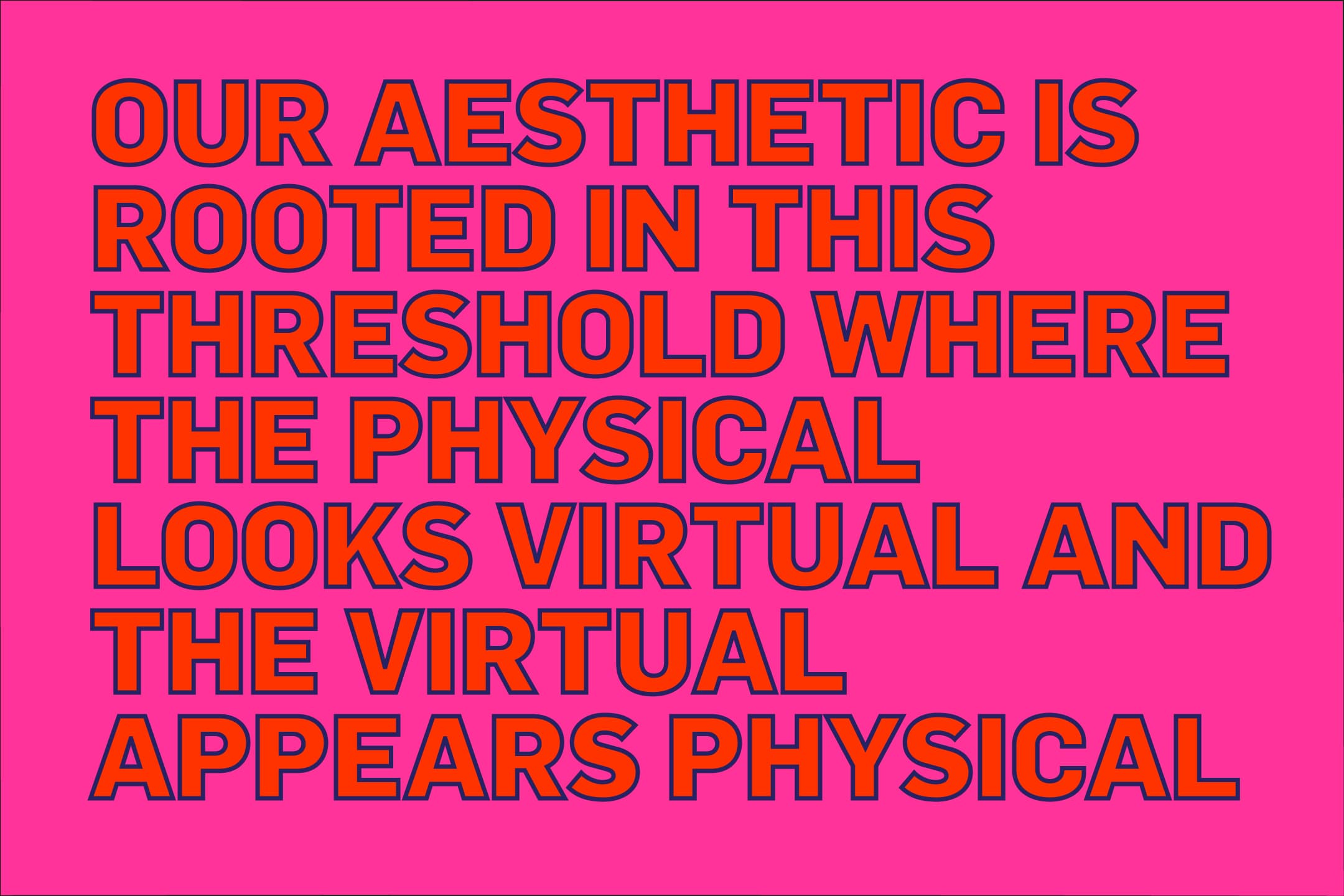
MICROCLIMATE ZONE
:MENTALKLINIK INTERVIEWED BY JÉRÔME SANS, 2018
When did you start your collaboration and why?
You might not recognize at first but we are very different both with a usual disposition. The anticipation of an uncanny outcome triggered us to collaborate. We started working together in 1995 during the first project we held in Devlet Han that was used for exhibitions as well as functioning as a studio on Istiklal Street. After the collaboration in 1995, our individual works and production styles started to gradually converge and engendered a common ground. In 1998 the inception of :mentalKLINIK as both an idea and a space. We decided as a duo to start up a space where we would be able to develop our art practice as well as art theory in an interdisciplinary setting. We never limited things to only one form; on the contrary, we were interested in the multiplicity of forms. Actually, since the beginning of our collaboration we are aiming to achieve what one might define as the third position while working as a duo. This is perhaps where our idea of plurality is grounded.
Why have you chosen to work under the generic name :mentalKLINIK?
It has a reference to our early phase when we also contemplated on the concept and phenomena of clinic; what does it mean to work on a case? What does it mean to gather a group of people around a case and discuss the matter in hand with them? It also represents something where theory and practice coexist like the ‘mental’ referring to the mind and the ‘clinic’ to the practice. Last but not the least it was the catchiness of the name which interested and attracted us the most. Rather than using two separate artist’s names we wanted an anonymous name which would also be catchy. We should not forget that the therapeutic effect is a part of our work as well from time to time!
Is this an affirmation that your art is about ideas rather than marketable objects and that your work a reactionary form of open laboratory, a think tank that you develop together?
We might talk of something where the idea and the object are superposed, overlapped. Since the beginning, even when we started first with a concept, we let the objects develop always in relation with the concept, the idea. We let the participants produce and create something rejecting the preliminary concept if they wished. Therefore, the objects and the ideas constantly collided with each other; the energy thus created carried things beyond the five senses. :mentalKLINIK’s theory and practice is never meant to explain one another; only when they are brought together do they create anew. We can talk of openness in the sense of breaking down the strict boundaries of disciplines. Not in the sense of being an open laboratory, open to anyone’s participation. It was always with our initiation first that we started to collaborate with friends or theoreticians. We opened up a laboratory space within the concept, subject we were interested in. That space had an open quality once we invited people.
The fact that we work as a duo might also contribute to the sense of openness in our work. The idea of being crowded, populous, especially when you work within arts and culture, as well as the fact of being within Turkey’s geography might at times breed very tiring processes. On the other hand, we address the notion of crowdedness as polyphony. It is not singularity but polyphony which interests us.
Why did you choose to install your “laboratory” between Brussels and Istanbul, a few years ago?
After the Gezi Protests in Istanbul we withdrew into ourselves in this silent, resentful period during which everybody at every moment talked about politics though without any impact. We started to not get out of the neighborhood where we lived and also where our studio was located. It became painful to carry on in a city where we did (could) not participate in its life. Our minds and bodies started to be disconnected. Censorship began to normalize as self-censorship, judgments of value and surveillance rapidly eroded, there was totalitarian oppression, working in the field of culture became to be considered as a luxury without any priority, and furthermore there was peer pressure (including the social media community) about how embarrassing it is to take an interest in or make ‘art’ in the midst of such naked and bitter reality… So, what primarily triggered this move was naturally the political climate in Turkey; however, the motivation was not a formal necessity but rather a personal one since we could not think or produce anymore under the circumstances. In that period, there was only one thing occupying our minds, “what is happening in the country, what will happen tomorrow, how can we change it, and what shall we do if cannot change it?” Even to think ‘art’ was a luxury. So, we decided to be effective in the world by moving to Brussels rather than remain inactive. We did not close down our studio and we continue our work in both cities. But we live in Brussels.
How the daily experience to live in this European capital impacts on your work?
Brussels enables us to once again remember that we are individuals.
How would you define your work?
We don’t like definitions… 21st century brought about a distinctive model of artistic existence. As artists of this generation we create open-ended works which don’t subject an art work to exact definitions. There is simultaneity between the materials used and the techniques employed. As an artist duo, we work to open up unfamiliar dimensions, new spaces and unknown senses. The aesthetics of design, new technologies and new media are all among our inspirations. :mentalKLINIK’s aesthetic rather than create a visual style stimulates various senses. We present the audience with a new visuality which they have not consumed before. We use the materials of today and the language of today. We are interested in the present moment, in the “now”. We look for the ideologies behind everything that stimulates us; we are under an immense bombardment in the extremely short duration of the moment. These ideologies provoke the suspense and anxiety in our works. There came first a generation who wanted to dominate nature and now our generation wants to make peace with it but in a utilitarian manner. Along with this attitude come many anxieties. The electrification in the body and the state of mind this anxiety generates provides the vibrancy and the ambiguous aesthetic of our works.
Your production has multiple facets, not a single visual vocabulary. How do you link all your pieces?
We create our own vocabularies; material vocabulary, sound vocabulary…all sorts of sensuous vocabularies. We build our story by associating these various parts and vocabularies within a network. Linear narrative is a pretty straight line or there are some zigzags. There are very emotional pieces as well as robots next to one another since our present day accommodates them all. Today it is impossible to talk of a single thing, a linear approach to history. After all these fractures, we now have fragmented identities. We are like the archeologists of today. Thus, our narrative is always fragmented and interwoven. Besides the teddy bears today are not hand-sawn; they are probably manufactured in factories operated by robots. The inhuman and the emotional stand overlapped or face to face. A very inhuman thing can dwell in a humanly place or next to a humanly thing where such an encounter, confrontation is taking place. On the other hand, all these robots are produced by humans to enable more leisure time. Technology is progressed for the benefit of mankind and that benefit is oriented towards the notion of leisure time. In the same process, we observe also the robotification of humans. The tension in our works stems from such an anxiety. The applications of biochemistry and biotechnology in interaction with the human body, is a sort of robotification process. We are in a gap where the robot enters into the human body and where the human might transform into a robot. In the past, there was such a binary opposition; the mankind and the nature. The man produced and improved technology looking at the nature. Today the robots are manufactured looking at men or animals. It is funny that all those robotic movements of the robots, barely freed of the organic quality of human movements, are very primitive for the time being. Once they start uniting with our bodies they will become invisible. By using robots, we point at this ongoing process. It is also probable that what is emotional is getting robotic. How much does what we define as emotional today resemble what was defined as emotional a hundred years ago?
Once, Yasemin Baydar said “We found the robots to be emotional”. Can you explain your fascination towards robots which are omnipresent in your works such as the choreographic and robotic work WOOO-OOO (2014), or PUFF OUT (2017)? Are you interested in such themes as transhumanism?
Robots were produced in order to save man from doing work that is a waste of time and harmful to his body, mind and soul such as mass production. They were most of the time built by looking at and mimicking nature and man; and then they were also used in wars and for reducing human death. And in the process, the idea of robotization began to infiltrate the human body and to change its behavior. At the same time, you can observe robotization in the relationship man has with time; the idea of conforming to time frames, of regulating one’s life, these all exemplify robotization in order to build a so-called desired life. On the other hand, there have been many useful developments in the health sector but along with it, (micro) chips began to enter the human body. This process has been going on for quite a while, but today the robots together with artificial intelligence define the human mind. Actually, let’s call these robots new entities that can do and process things much faster than man since it is not meaningful to compare artificial intelligence with human beings. Robots are new entities and we need to regard this not as a matter of comparison but living together in a shared environment. For this reason, the psychological effects and impacts in general that robots along with artificial intelligence have in our lives occupy a significant place in our works.
We sometimes find robots more emotional because they appear like they are in need of protection due to the humanity and animalism attributed to them. The behavior of robots also generates this sense of being in need of protection similar to the one that a cat or a baby generates since they are yet incomplete as beings. For Woo-ooo, we use entertainment robots, they are moving lights usually used in nightclubs or shows for entertainment, pleasure and celebration. We do not refashion them but simply give them a different context. These moving lights (robots) both give light and at the same time move like the human eye or head; what we do with them is a sequence or choreography of flirtation. They function as actors set to a choreography that loops endlessly, a repetitive script that remains unfulfilled and unresolved. The work references the catcall or whistle used as an attempt to capture the attentions of an attractive passerby. This attempt to seduce is often met with repulsion and the lights are choreographed to replicate this shaky flirtation in computer-programmed choreography. Attempts to replicate body language, sensation and feeling result in a playful and dynamic set of movements, reminiscent of play in contrast to the development of human interaction and interpersonal communication which has become increasingly mediated by technology. We treat it like a scene of two doves courting each other and this scene of meeting, interacting, moving away and longing creates a sense of empathy. The moment you have a feeling that you are watching a scene of them courting each other it transforms into a terrific love story, and this is very impressive, very emotional. In Woo-ooo the inhuman and emotional stand overlapped and reflect the ways in which robots are being designed to be relatable to humans. Only an oxymoron is capable of defining this dual relationship that is taking place, human beings being robotified and robots being humanized. We are a transitional generation that knows both worlds, that of our physical reality and of the virtual one. Our aesthetic is rooted in this threshold where the physical looks virtual and the virtual appears physical.
What is your relationship to language, to words?
Language is one of the vocabularies of our aesthetics. We search for diversified means of expression. Language comes into play in our works it is shaped within our aesthetics. When we write an independent text, we want it create a new meaning as it interacts, collides with other works. We don’t use language to explain things, in fact we use it to blur things. We might use it also to blur what it points at. There is always a dynamic relationship. We say what we want to say by distorting it. Besides we defeat it once more by our aesthetics as we say it. To blur meaning, to make it awry, to open up space for a new meaning; these are what inform our work.
How do you understand the requirement for happiness and success in our contemporary societies, a transversal theme of your recent exhibitions?
We actually regard it as violence, because the requirement for happiness and success brings out the wild feelings and destroys empathy among people. If we return to the phenomenon of defining oneself as an object, making oneself, showing oneself as very beautiful or being very healthy are all examples of violence on the body, and besides, there is no continuity in the relationship with the body, it is constantly interrupted. In the meantime, the erotic body also suffered a lot of damage; we are talking about a bodily process here that also contains aesthetic surgeries triggered by desires to be happy and successful. Additionally, to be happy and successful appear today to be the same concept and they are linked at the same time to making money, because it is socially defined as if you cannot actually be happy and successful if you do not earn money. And everyone is anxious today in many senses; some experience these symptoms much more clearly and take medication in order to survive, while others can handle it and move on but even then, even if they do not realize, they are still living and moving on with this anxiety. Since the relationship we establish with time has been reduced to a single moment or even to shorter periods, we lost our ability to empathize; there is no such thing anymore as taking into consideration another person, giving priority to him/her or defining oneself according to others. What we really call self is not the self we know; it is a made-self. Happiness indeed refers, just like the title of this exhibition Obnoxiously Happy, to being happy by hurting someone. When you are, or you think you are happy by hurting others, this is a wild thing, like murdering someone and thus being happy. If there is so much unhappiness, and so many people are unhappy and poor, and you are happy, we believe this already makes you a very violent person. Yet this is not a natural wilderness but an urban violence.
Does art is about the alchemy of changing lies into truth or fake into real?
In our opinion art has its own reality. We never refer to such a transformational power of art. But we rather regard it as an area where it is possible to create a reality of its own. We always examine the tension between imagining and realizing something and that is what we did also in our works like Cheater and Liar. To experience falsification many times in that process and to create works with the aesthetical elements conditioned by it. Our works were the results of a very long process which had many fluxes and refluxes. When we work as a duo we subvert each other and this subversion informs our process. Actually, more than changing lies into truth or fake into real, our work generates a sense of playing a poker game; you never know if your counter-partner is bluffing or not, if what she says is true or not…and the tension in the game, even the game itself feeds on that ambiguousness...
Your works often play on the ambivalence of situations, the feeling to be early or late on an event, to be in the wrong place at the wrong time like in TERRIBLYJOLLY (2012). What do you want to express by conveying the visitor to such experiences? Do you think there is no longer place to be?
We still consider art as a place of possibilities. We use it as a space, a time and a situation exempt from all those categorized definitions that daily life imposes on us. Therefore, we create microclimates and highlight the fictional power of art. On the other hand, it’s also a possibility and a surprise to be in a place when one is not supposed to be. And we love surprises because it is something that cannot be measured in an age where everything has become measurable and measurability is so much praised. Surprise is very significant, very human, and very entertaining in these days where technologies tell you everything about yourself including things you did not know, and where they define, by measuring your heartbeat and pupil, your likes before you do when you encounter new objects.
Many of your works saturate our senses and destabilize us. Why do you want to cause a visual or sensory hyperstimulation, an emotional overload?
When we founded :mentalKLINIK we had a very brief manifesto that :mentalKLINIK is open to five senses and is willing to pave the way for the 6th, 7th and 8th senses. This was back in 2000. What we foresaw, observed then was that technology effects and changes daily life, the way it is experienced and the perception of time. We were also observing how culture of shopping was changing and how easily and quickly people were inclined to consumption. People’s senses were being blocked, so we addressed the senses such as smell, sound and taste. In our exhibitions, we wanted to approach art not only as a visual thing but also as something open to all other senses. Over time, all brands began to employ these strategies as we had foreseen, and the line between art and life got even more blurred. Besides, gradually everything began to have the same effect. Today people take their pictures with a cheesy promotional object as well as with artworks. In many art fairs artworks get damaged because people want selfies with them; people no longer perceive a difference in value between an art object or other objects so it seems an art object, just like any other, can be broken. Normally an art object has an aura and you know you cannot touch it. Today everything can be touched and photographed; if it is a photographable artwork even better since it can be shared on Instagram or Facebook, and the artist can get even more popular.
We always play around with these ideas and our works appeal and trigger the senses. We simulate in our exhibitions a micro-climate of what goes on daily outside, but outside people are not really aware of it while in our exhibitions, by exaggerating it, we want them to become aware of this torture and recognize it as one. This is why we use vibrating and phone sounds, or scents that mix with each. Today everything is getting more and more synthetic and all our senses are subject to the system, ready to be manipulated. We are interested in emancipating and empowering the sensory faculties of man that is impoverished within the contemporary context. We intend with our works to appeal to the viewer’s senses to such an extent that at times the works almost violate the viewer’s personal space, however during this process we want the viewer to become aware of his/her senses and this awareness is central to our works. One can say that our works are erotic but not pornographic, in the sense that they do not impose themselves upon the viewer but invite him/her into their reality by engaging all of his/her senses. Furthermore, the works, rather than offering just erotic imagery, trigger all sorts of sensual responses from the viewer and let him/her revel in his/her imaginary eroticism.
Recently, you conceived the AIRLESS series (2015), ready-mades of toys and deflated balloons which are icons of the popular culture in your globalized world. Did your aim was to return the image of a society always more oriented towards entertainment and leisure?
The Airless series makes use of readymade toys, balloons that have become enormously popular in many places through the rapid increase of globalization of cheap labor coming from South Asia, while at the same time playing with the notion of air, space and potentialities that are hidden in the atmosphere of social living. These cute balloons become uncanny objects after the air is taken out or before the air is given in, thus showing the awkwardness, absurdity and the tactlessness of what we currently consider cute, nice and sweet. This series interrogates the idea of commodified cute by also reminding us of the mobility of objects, capital, products that are manufactured in the zones of child labor, authoritarian regimes and the amalgamated force of law, surveillance and capitalism.
These inflatable balloons entertain, make happy and attract the attention of not only children but also adults in this world of entertainment and culture of leisure; they are like sculptures. Many artists have already used them like Jeff Koons or Philippe Parreno. However what interests us the most about these balloons is the fact that they are mostly produced in China and then packaged and sent; what we see are very small versions of huge volumes, produced identically and packed in layers. When packed, they are without air, in other words lifeless, but they still seem joyful yet with a certain dose of weirdness. There is a joy, happiness that we cannot reach unless these balloons are inflated. At the same time, their mass production points out the idea that such joyful things are being produced under such horrible manufacturing conditions. These popular products are sold very cheaply but already in a richer world; at the end of the day those who have money can buy them. In the beginning, the contrast between this and the joy these balloons promise attracted had our attention. First of all, we wanted to make each one unique; they were already unique as plastic but we wanted to freeze them. We produced them in electroformed copper and then painted in acrylic after the originals. The resulting works, like a crooked cartoon duck or a wide-eyed smiling face, freeze in time the moment a lighthearted plaything becomes disposable. We end up with a unique, deflated and worthless balloon, and when we look at it we can’t tell whether it is fun, scary, joyful or sad since some of them have really lost their expressions; they become semi-recognizable in their crumpled state. And this also leads us to the idea of happiness or showing yourself as beautiful. Maybe they are very beautiful when they are inflated, but they are not so joyful when all life is taken out of them.
You often deal with the question of seduction of objects. How the choice of object founded in everyday life takes place? Why do you choose in particular attractive or “flashy” objects?
We wear only black and the objects we choose and use in our daily lives are not really bright or colorful, but if we look at today’s art, design, technology and objects, they are oriented to be the center of attraction, and we have to take into consideration that we are creating works for this ‘moment’. We cannot ignore the seduction of capitalism and its camouflage. Therefore, we are interested in flashy objects because shiny, bright, sparkling things are very seductive and they fascinate people. They reflect one’s own image and one quickly desires to possess them. Fascination with shiny things is also the case in our relationship to nature if you think for example of the phosphorescence in the sea. Or consider the admiration for diamond and looking for gold dating back to centuries past. When we look at the objects of daily life and art objects today, the ones that stand out are actually those that seduce us and make us blind to the importance and seriousness of life by entertaining us. This relates to the notion of visibility and non-visibility since strategies and ideologies are hidden behind objects. On the other hand, objects are no longer what we thought of them to be; consider for example the chips that have such small dimensions. Chips create a pool of data by transferring, receiving and storing information to be used later. With it they can make our profiling. Therefore today, they are trying to make objects even more attractive since they do not want us to recognize or relate to the reality behind them. We simulate this process of seduction in our exhibitions. We want to fascinate the audience with the exhibited objects’ charm. We show the madness of our lives and also have fun with it. Our works exist on this very thin line-between where the audience encounters an unpalatable reality and oscillates between moments of joy and despair.
The participation of the public is often requested in your work. Why such display, trap or metaphor of the leisure time? Which are the devices you use to include spectators in your works?
In fact, we regard participation as torture, we torture the audience as artists. Our works and exhibitions pretend to require participation, but do not actually give the audience enough opportunity to participate yet they still make the audience feel as if they have participated. Even if a work is very static it still makes the audience encounter him/herself as well as encounter the space. We draw a path for the audience to follow in the space and the artworks shift as the audience walks around them. However, just as it is with capitalism, we believe the audience is not aware of this. In any case when and if s/he becomes aware then s/he establishes a different kind of relationship to the work or s/he might have fun as if s/he is in an amusement park. Take for example the robotic sweepers in Puff. We show them as if they are interacting but they are actually doing just their tasks. We highlight that robots are able to do works people do and that this makes it easier for us leaving us more leisure time. But can we go beyond being a society that fills its leisure time again with entertainment as Lefebvre once asked. Can one make use of that time to make oneself, to read, to watch something, to improve oneself, but not in the sense of personal development? Could leisure time really create the individual that modernism idealized in the past? Otherwise it is wasted again by spending money or being entertained. On the other hand, we recognize and accept the need for having fun but under the circumstances it does not lead to joy but to waste culture.
How do you see the evolution of Turkey in our present time and in regard to the recent sociopolitical context?
Evolution in a reverse way!
How do you imagine the future?
Future is now and totalitarian. Lost, anxious and depressive. Lost in our senses, anxious to feel and depressive about our state or being.
What would be your next dream?
Constantly living our dream.
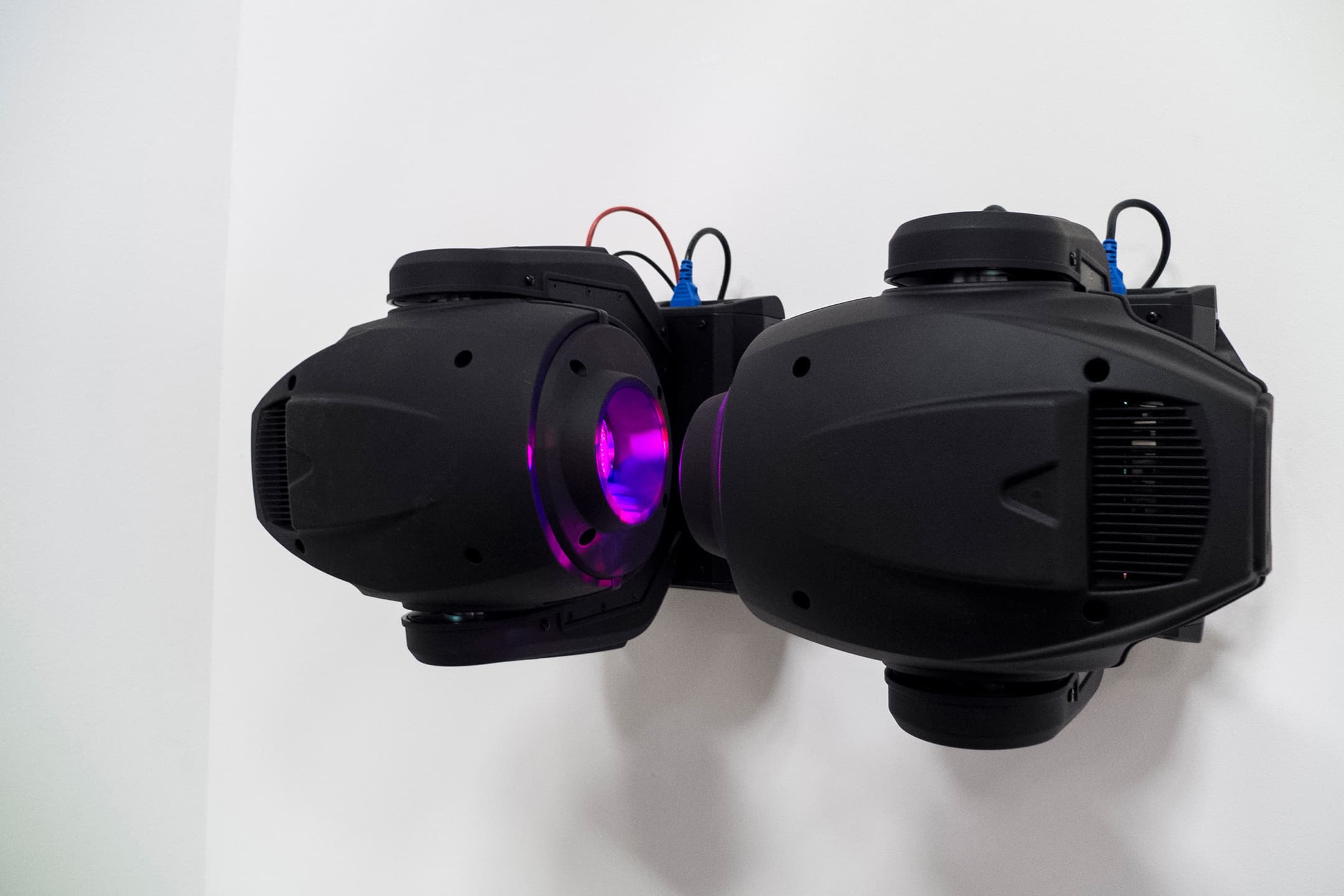
#FOMO AND SELFIES: THANK YOU FOR YOUR COOPERATION BY
:MENTALKLINIK AT GALLERY ISABELLE VAN DEN EYNDE
DANA HEWITT, 2014
The Istanbul-based duo made up of Yasemin Baydar and Birol Demir are known for their playful installations and performance pieces that examine contemporary culture’s pleasures through a neutral lens that is neither judgmental nor sympathetic, and their latest show at Gallery Isabelle Van Den Eynde continues the project. The duo's esoteric name and the fact that the show is highly conceptual might intimidate someone who doesn't normally flit confidently between galleries, but in reality this show is all about contemporary pop culture, with messages accessible to anyone with a mobile phone who has ever snapped a selfie.
Right from the start, the show assaults us at the gallery’s entrance, as we’re forced to pass a chain link fence lit up with a neon sculpture spelling out the message that has been made trite by over-rehearsed flight attendants and telemarketers the world over, Thank You for Your Cooperation. The signage implies that everyone who enters is complicit in submitting to an order, but exactly what we are guilty of upholding is initially puzzling. Was there a waiver that we somehow missed signing?
Stepping into the exhibition offers the sensation of abruptly landing in a candy-colored universe populated by various mirrored installations and sculptures all of which demand examination. But before you can cross the polished concrete floor to take a closer read, your cell phone rings and you fumble through your pockets in an embarrassed panic. You could have sworn you'd switched your settings to silent mode!
However, upon listening to an electronic orchestra composed of other staccato notifications in quick succession, it becomes clear that the tones are part of a layered sound sculpture titled FOMO. As in #FOMO: The 21st century term that stands for fear of missing out, popularized by the Tweet-savvy to name the unsatisfying sentiment that wherever one is, there is always someplace trendier to be. Social media exploits this restless mood by encouraging users to take selfies, check into glamorous geographic locations, and otherwise incite envy in friends and acquaintances alike.
By rattling off these sounds, all of which will have varying relevance to each visitor (depending upon one’s phone model and settings) the artists are calling to consciousness how our emotions and sense of self-worth are ruled by the virtual world, and in consequence how rarely our minds are connected to our bodies in a state of present tense being.
The PROFILE series, which consists of four jewel-toned tempered glass panels printed with capitalized block letter font, further explores today’s notion of time. When regarded quickly, the letters appear to spell out gibberish, but upon slow study it becomes clear that these are widely used hash tags such as: THE_NEXT_KATE_MOSS, EXHIBITIONIST, TRIPPING, NO RELIGION, FRENEMY, HISTRIONIC. It’s impossible to scrutinize the work without finding yourself reflected in the mirror as an accomplice to the art, posing for a kind of compulsory selfie.
Nestled among the truly pretty (note that use of the adjective is not meant to imply an absence of meaning) works, is the WALKING ON AIR series, which presents generic family photos sullied by thick layers of artificial mud. The images reference precious photographs found floating in the remains of America’s 2012 Hurricane Sandy, a natural disaster that will go down in history for the devastation and displacement it caused. In this series, :mentalKLINIK cleverly counters the FOMO predilection by calling into question what lasting happiness is really about.
Solid conceptual exhibitions remain relatively new to the region, and although Thank You for your Cooperation is quite open-ended, it is also entirely relevant to our times and thus for the most part (other than the ambiguous SIMON, Floor 23rd which features a child’s teddy bear trapped in a gold diptych, which felt like someone was trying so hard to be evocative that the work's message became convoluted) relevant to anyone with a social media account. The show also further establishes Gallery Isabelle Van Den Eynde as the space to visit in Dubai to take in a program of boundary-pushing yet eloquent contemporary art.
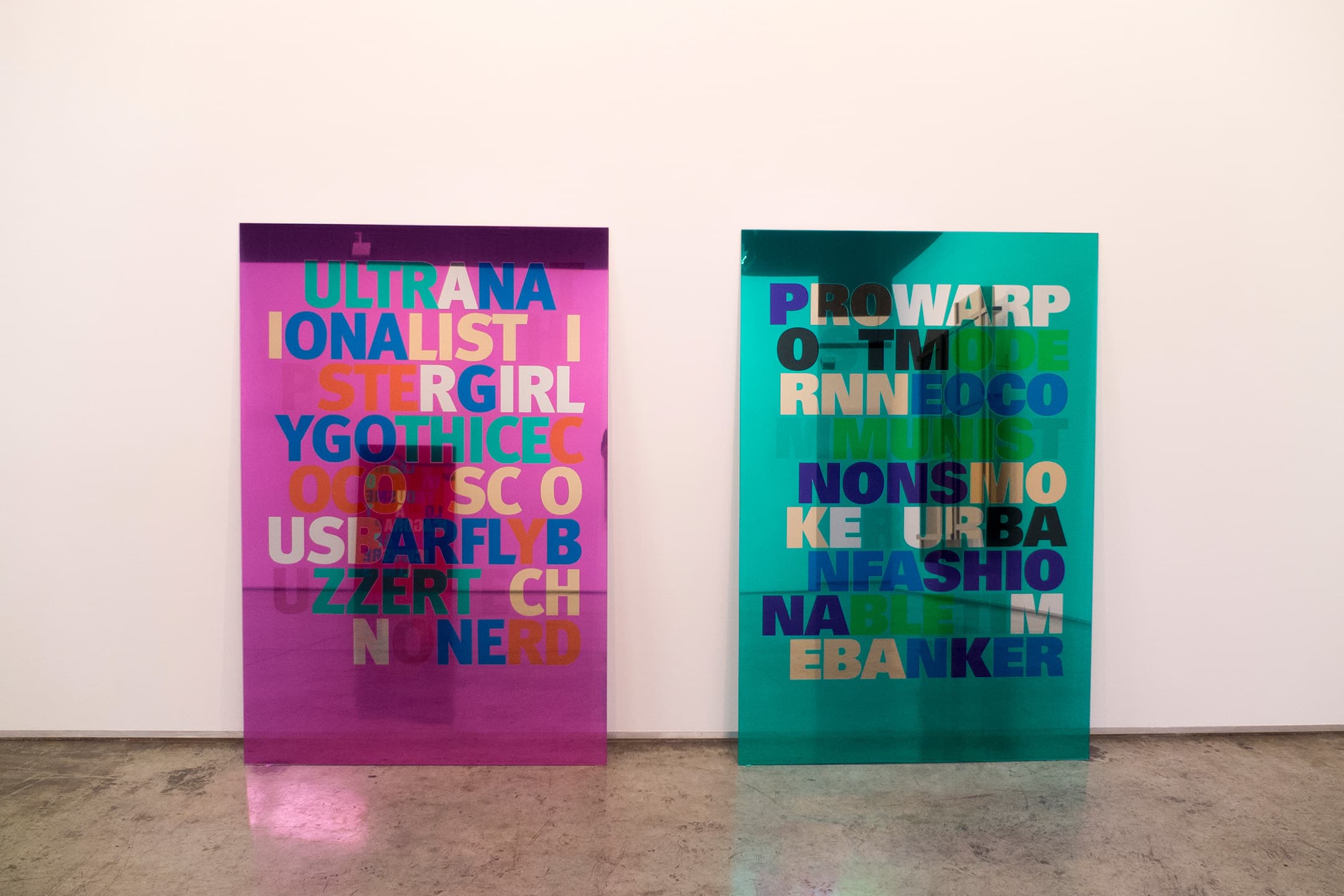
:MENTALKLINIK NEGOTIATING THE DIGITISED
DATAFIED SELF IN THANK YOU FOR YOUR COOPERATION
ROB HORNING
FAD MAGAZINE, 2014
Ahead of the new Dubai art season, commencing next week, we have another flashback to a last-season highlight
“With all of social media’s feedback loops, we get a comprehensive status update from ourselves, allowing us to consume our own personality as novelty.”-
Goolge Alert for the Soul, Rob Horning
This year, in Dubai’s industrial zone, a quasi-clinic stood within a warehouse building. The building was inhabited by sounds and mirrors, works which dynamically evolved the perceptions and the position of those who witnessed it. Their cooperation in this was appreciated – the exhibition’s title, Thank You for Your Cooperation, scrawled in light on a chain-link fence at the entrance – a portent of the participatory experience within.
:mentalKLINIK were the orchestrators, a Turkish duo often lauded for the complexity of their oeuvre, deftly shifting between emotional and robotic attitudes, fusing materiality and concepts vividly, each method, each artist, each exchange, progressively enhancing the other. The viewer was rewarded for their perceptual participation with a complexity that momentarily challenged their sense of self.
Within, we found ourselves in a fiction of digitisation and technology, both 21st century Goliaths evoked but not present. Ceci n’est pas un ringtone! one might observe, as FOMO, a ‘subcutaneous sound sculpture’ of disruptive disembodied phone noises, ricochets around the room. The title is meant to alert us to anxiety as we consider what we are missing out on elsewhere. But isn’t that noise a kick? It’s been demonstrated that the human brain responds to our phone tones with the release of dopamine. So we brace ourselves, aurally coiled in a heightened sense of alertness for its arrhythmic arrival, unnerved, imagining the other who is trying to communicate, and simultaneously aware this fiction is a drill to test our bizarre consumption and communication habit.
A mud-smeared (stock?) photograph of a woman is an anachronism, perhaps carelessly discarded then salvaged in an attempt to invoke the sentiments once associated with it. It is oversized, loaded with probable, possible meanings, and its mundane physicality drab in a room saturated with candy-coloured mirrors and aural treats. On the same wall another sentimental object has been discarded – a teddy bear trapped within Simon Floor 23rd. The physicality of these objects is unexpected – this is an ephemeral space composed of noises and reflected lights that have cohered into a continuum – these objects are so static it feels appropriate that they have been left behind, too heavy in their presence to become part of the dynamism of the space. An ironic emphasis of the metaphysical heaviness of the pieces is contained within the titles – the photograph series is Walking on Air and the teddy bear should be up there somewhere, high on the 23rd floor.
Again we recognise our consumption habits guiding us, we are comfortable with the social media ephemera made ‘reality’ – the profile as object, the ring tone as sculpture – but the photograph and the teddy bear seem disingenuous. We consume information as it streams by, we are individuals in constant flux – the exhibition catalogue goes some way to identifying the origins of this feeling: “if disorientation, as Jameson suggested way back at the dawn of postmodernism, is the inability to cognitively map space and time in a new era of full-time consumption, then nowadays, in what some are calling post-postmodernism, disorientation is simply a way of being in the world.” But what if there was a third way, one that is not about consumption of products at all, but rather motivated that most fundamental of desires – identity and finding a means to consume it.
The pieces in the show – both the ‘heavy objects’ – the mud smeared photographs and the teddy bear – and the virtual-made-real Profiles – are individual’s names – the implicit question posed – which represents a person? How can the self be constituted? Lacan’s conception of the self as fractured and objectified is useful here, demonstrating that disorientation in a soup of culture, society and externalities – what Lacan terms the other or Other – is not a new concern. In brief, his theory posited we might have a sense of self, but it is always deferred and unknowable because we can only approach it through the other / Other – we have no tools at our disposal but those outside of us, and these are insufficient. We can recognise ‘ourselves’ externally but this is always an act of objectification because it reduces the immutable self to a static image or moment in so far as it can be understood, even that figure in the mirror is detached.
As an appropriate challenge then, mirrors line the walls – we see ‘ourselves’ at every turn. These mirrors are Profile, a series of ‘blurbs’ that initially seem to reiterate a truth universally acknowledged, that our social, digitised selves are void of real character – here are your uni-personalities! Comodified, projected, distilled, deficient! And yet, their striving is very human and very real – like that eternal desire to commune with our ‘authentic’ selves. The linguistic element is no more or less adequate at giving us some sense of our identity than the image of our self we see reflected.
For Jack Halberstam Profile is composed of “random markers that are circulated to try to distinguish one subject from another” and which transform “the uniqueness of the human subject…into lists of adjectives, profiles, one word signifiers expected to introduce lost and lonely souls to one another.”
And yet, perhaps Profile and the social / online commodification of self with the ‘blurbs’ it seemingly emulates, strives beyond categorisation. Evolved into a set, it gestures towards a ‘grammatization of the social’ – a concept identified by Bernard Stiegler to denote the template driven mode of expression imposed (or facilitated?) by social media.
This new grammar, with its codified structures – newsfeeds and X-Pro II filters, hashtags and likes – might be the means to guard against the “immense bombardment in the extremely short duration of the moment” (:mentalKLINIK in conversation with Jérome Sans). Even more than this, there might be a latent potential in this structure – that of coherent individuation. Rob Horning speaks to this “the templates of social media hold the self in place and reveal it as it emerges”. Perhaps then, Profile is not as random and constricting as the flawed signifier / signified relationships it is composed of. The linguistic constriction risks objectification, yet, does objectification of the self-matter and is our social self really objectified? Surely the social process is sufficiently evolutionary to be a new kind of identity making? For :mentalKLINIK it may be a moot point, they recognise that “there is a tense relationship between the object and the human in our age, they are equalized ?as both are datified.” But it is this datification which perhaps allows the dynamic between authentic self and knowing self to shift.
Their conception of this relationship echoes an astonishing foresight identified in Baudrillard’s early-1980s writings on the masses, and its relevance to the viewer’s encounter with Profile is striking. Baudrillard seemingly predicts social media and the significance of “anticipated statistical verification of our behaviour”, that it is a “permanent refraction of our least movements [meaning] we are no longer confronted with our own will. We are no longer even alienated, because for that it is necessary for the subject to be divided in itself, confronted with the other, contradictory. Now, where there is no other, the scene of the other, like that of politics and society, has disappeared. Each individual is forced despite himself into the undivided coherency of statistics.”
Profile focuses its dynamic gaze on this refraction, literally a mirror, we see ourselves, yet the blurbs – so coherent the words elide – are not the signifiers we elect for ourselves. We try to recognise our self, are forced to try on first one profile then another. Ultimately, we are situated in a disorientating space between a plurality of identity modes – the eternal desire to know and realise the authentic self, the sense of self mediated through the ‘other / Other’ and that more modern and preoccupying desire for equilibrium between that mediated self who negotiates the world, and the new coherent social, datified self.
We turn to the evolving, dynamic and externalised other that our mediated self could cohere with, redirecting our desire to know that ‘authentic’ self we sense but can’t know – located beyond the language we have to reach it – towards this more knowable aspirational sense of self. And we see a new way, can accept that “no one is as self-contained as the ideology of individualism asserts. Social media seem to afford more control over this interdependent individuation process, making the burden of self-surveillance into a procedure of self-care” – Google Alert for the Soul, Rob Horning
:mentalKLINIK reveal this new feedback loop and situate us within it, indicating a new point of departure, where we can productively, progressively leave behind the always frustrated desire to know our authentic self. Like the text tones of FOMO that provide the kick of dopamine – satisfying that urge – without signifying anything, we have cooperated and been rewarded with new potential. And with this, elemental drives can be directed productively towards a new kind of individuation no more or less authentic than the impossible pursuit of the unreachable self, and more dynamic than an objectification of self through stable external signifiers.
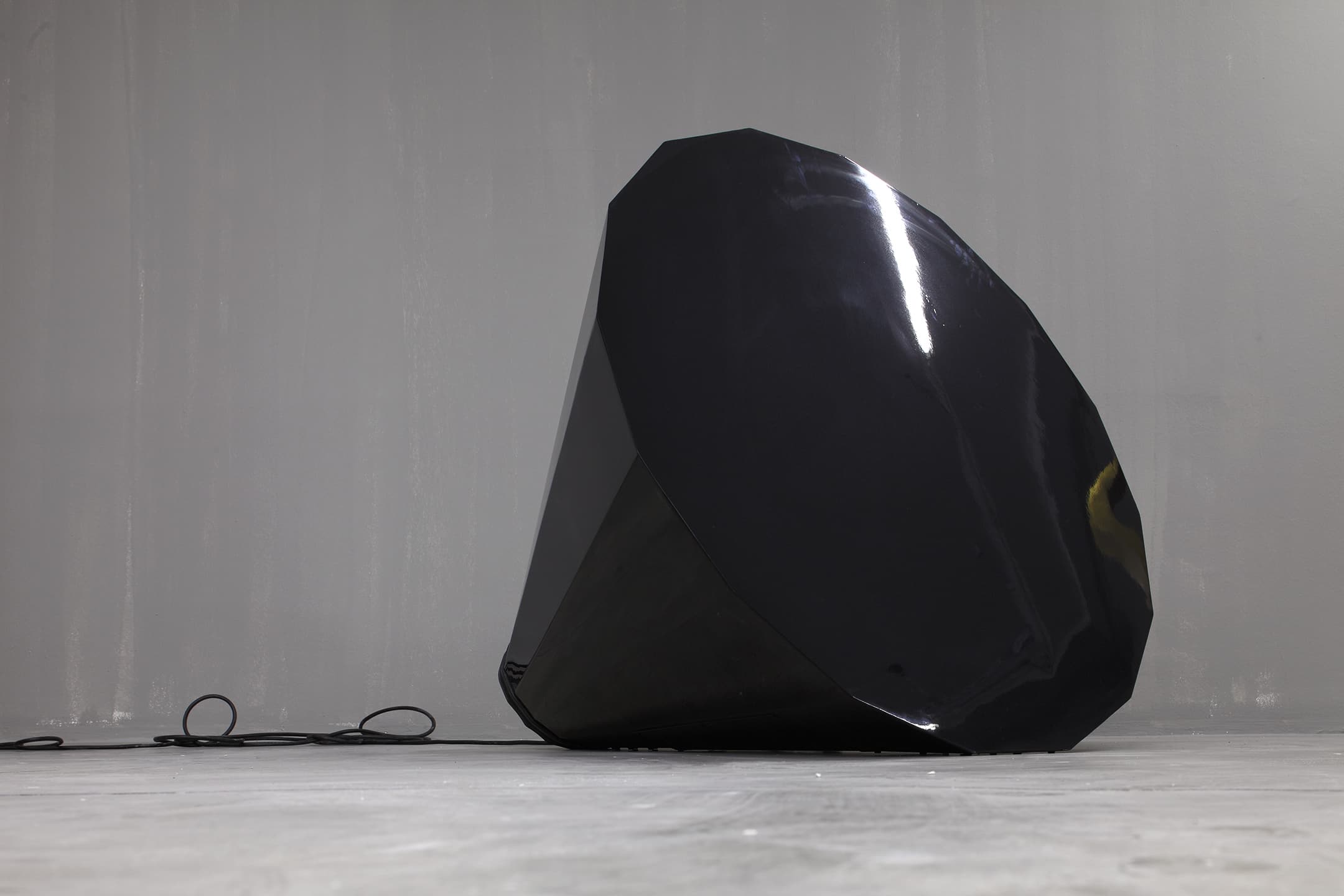
:MENTALKLINIK _ RABBITHOLE
ZAFER ARACAGÖK
WRITER / COMPOSER
2009
Is it obligatory to have spent some time in a mental clinic so as to be able to know when not a hand, but its shadow touches the wall? Or, is it because the shadow of the walls never falls on walls that a mental clinic has always existed – even before any patient has knocked on the door? Perhaps we should lend an ear to what this hand points at, reaching out as if a door will open the moment it arrives on the blue shadowless wall. Since we are in a :mentalKLINIK show where ears could have well been made of hands and, eyes of ears, we might incidentally get a bit bored because we cannot walk on our heads.
As we step into the exhibition at Galerist, the “Blink 01,” projected on a wall that separates the main entrance into right and left, reduces the field of visuality to a moment of dazzlement, thereby both adumbrating that we will per chance stumble on our entry no matter through which door we enter the hole, and underlining risks specific to stepping into “a colon[:].” All because, it is by means of the latter that :mentalKLINIK brings out the parody of what is right via tiptoeing on the thin line separating the proper punctuation from the improper one.Turning Hegel inside out, it shows that in contrast to Hegelian dictum which holds that all events exist as a tragedy first and as a farce the second time, everything exists as humour since from the start yet only when within the framework of a mental clinic.
Either from right or from left: nothing will change from whatever direction you enter the hall.What matters is that all the series which start vibrating simultaneously should get into resonance. When propositional phrases “like everybody knows” call into resonance another series, “like nobody knows, ”Alice tumbles down the rabbit hole and falls into a topsy-turvy world. People get smaller as they grow bigger, and the meaning of all words, names given to all objects and subjects start changing at any moment; not only the grammer but also the assumed relationship between the signifier and the signified through which we produce meaning in language is turned upside down. As the big black hole, entitled, “Tune,” is presented to us as an “object” to be experienced with no reference to a metaphor, that is, as an incomparable experience, mirrors get bored of functioning as mirrors and start radiating their surface, giving way to a horizonless horizon. A horizonless horizon implies neither being blind nor deaf: it is the moment when colour, sound and “form” vanish, when man’s act of seeing starts seeing itself as his act of hearing strats hearing itself.
If there is no mirror set between the two videos of a hand touching a wall – named “True Blue (right)” and “True Blue (left)” and placed as a mirror image of one another – these hands either point the way to the rABBIThOLE, or they invite us to a visual “tinnitus.” If tinnitus is to hear sounds which are not there, or the generation of a hearing effect by the capillary hairs vibrating in the absence of stimuli, this, in the hands of :mentalKLINIK, turns into a territory of visual and aural tinnitus where objects which have declared their independence create an earthquake-sensation by vibrating occasionally, or where the act of seeing is transformed via distorting and corroding the object of visuality into such works, say, “Eclipse.” The success of Yasemin Baydar and Birol Demir lies in the fact that they have managed to erase and lose the origins of sounds and objects as in tinnitus experience, and precisely at this moment tinnitus transforms from being solely an aural discomfort to a liberating horizonless horizon.
What is left behind of colours at such a moment? As we might predict, right at the entrance, from the dazzling Blink 01 flashing on the wall, that is, even before we face the series, or even before they get into resonance, colours will obviously be in death throes in the rABBIThOLE. Despite everything, even if the pink polymer resin had made an effort to return to the exhibition hall by leaking out of metal plates in the works entitled “Bias 01” and “Bias 02,” this attack from outside fails, and it remains solely as a tactless intervention of re-introducing “perspective” to the horizonlessness of the horizonless horizon. Yet another series, “Eclipse,” hung on the opposite wall produces an apt response to this intervention which is possible only in a mental clinic: in these works which might easily be perceived as an earthquake-diary – and there’s no reason why they shouldn’t be perceived as such – surfaces sliding on top of each other extend the visuality onto the surface of small boxes where form and colour are subjected to an eclipse, and it is asserted that depth can be obtained only on the surface just as Deleuze put it with reference to Alice in Wonderland. If colour and form drag the artistic effort into the depths of “meaning,” yet remaining on the surface requires an effort of letting oneself to the current of waves without possessing form and colour, without attaining depth, as it were. This is in a way similar to Kafka’s swimming-champion who doesn’t know how to swim. If surface is a territory, based on “sense” rather than understanding, the earthquake-sensation created by the vibrating pipes (Twitter) can be regarded as the visualisation and the auralisation of the resonance that the series in the exhibition enter into with each other. Resonance in this sense does not operate only with sonic units but it also establishes an ironical relationship with form and colour by traversing all units of visibility.
Once upon a time Edgar Varése invented a definition for his concept of music: “Sound organisation.” The latter meant forcing the sounds to a crystallisation-process by stepping away from any concern for traditional composition. Crystallisation in rABBIThOLE operates both visually and aurally, and in the resulting “audio-visual” assemblages, visual and aural materials confined into boxes or frames, crystallise by corroding from within the works they are jammed into, and they touch our walls by overflowing from that thin undecidable line between what is aesthetic and not.
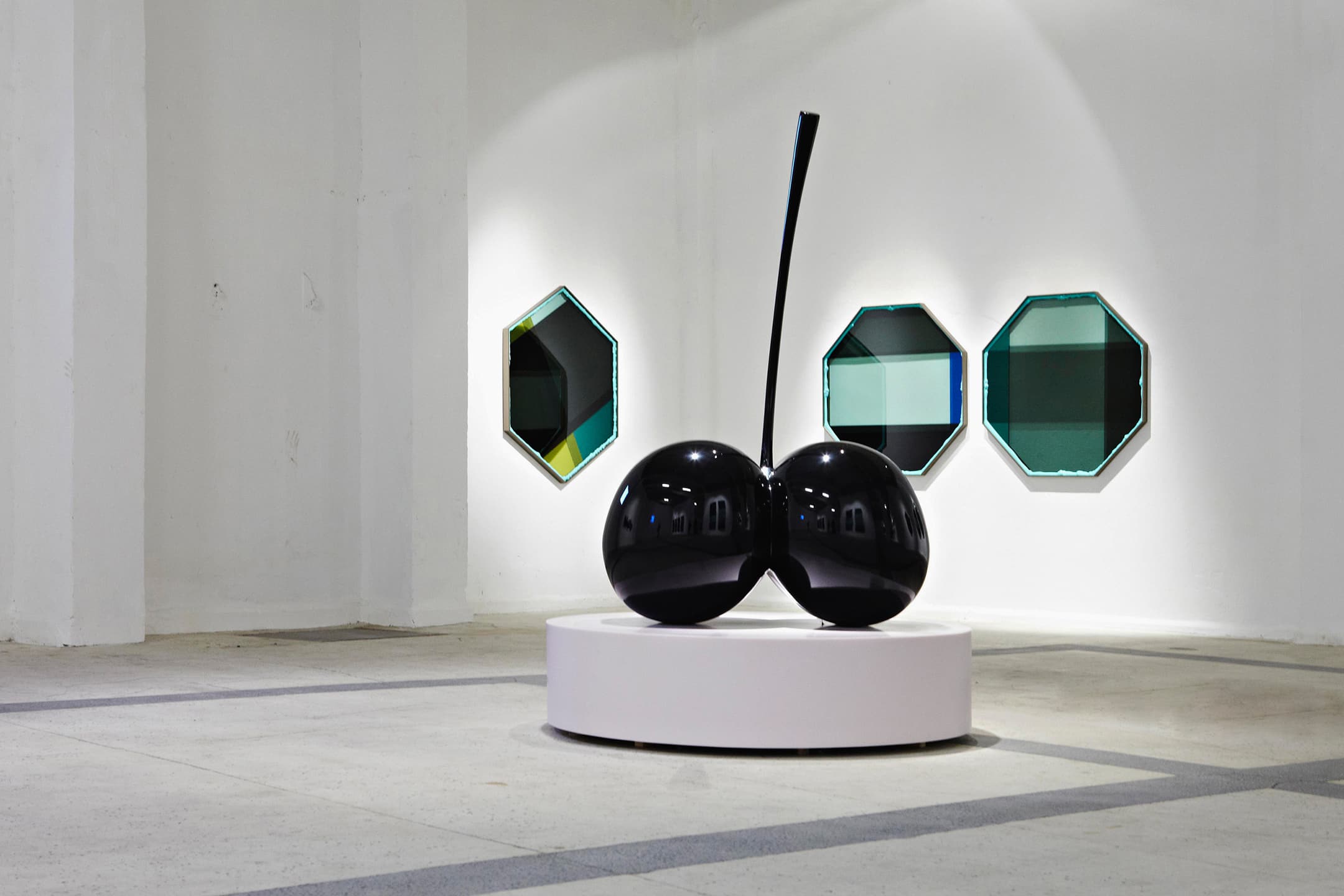
ON SPECIAL OCCASIONS AND THE TIME OF THE OBJECTS
JACK HALBERSTAM*, LOS ANGELES
2014
On special occasions we used to open champagne bottles and toast the unexpected, the fortunate, the well deserved, the truly awesome. On special occasions, we threw confetti, we dressed up, we cast caution to the wind. On special occasions, we did things we don’t usually do and all bets were off and it was so much fun, and we looked forward as we slid back into the mundane and the quotidian to the next special occasion. And the next one and the one after that, and we lived lives punctuated by odd eruptions of celebration, chance encounters with glamor and temporary immersions in utopian experiments with the unlikely, the possible and the still to come.
But, the logic of capitalism does not allow us to cordon off the special from the mundane – the goal of capitalism is to squeeze every last drop out of every opportunity and so the special becomes a daily occurrence, and the special occasion becomes a “special offer,” and as we bounce from one holiday to the next, from one market produced occasion for celebration to the next. Slowly, the special sinks into the scheduled: every night a party, every party a winner, every day a new case for celebration. And instead of a world mired in the ordinary and punctuated by the unusual, we became a society of celebration, a community with endless good news to tell, so many amazing things to toast. And now the confetti flows like wine, the party never ends and there is always somewhere else, somewhere more special to be. As we fling ourselves around in the increasingly evacuated realm of the social looking for stimulation, events, pleasure, we are more and more pre-occupied with a growing sense of missing out – is it here? Are we in the right place? Is this party the one? Or am I missing the real event that, like an altered-through-the-looking-glass reality, exists just outside of my purview, and remains a fantasy of the better, the more awesome, the place to be.
There are no longer places to be; nothing remains of the cool; hipsters are just captains of capital staying one step ahead of the future and two steps behind redundancy. And as the economic crisis generated by a fantasy of unending wealth and undergirded by a series of bad promises allows a few winners to take all the goodies, everyone else is left holding nothing but empty glasses. In the aftermath of this banker’s holiday, there is little for the financial sector to say to the dispirited, abandoned and destitute public but: thank you, thank you all for your cooperation.
Thank You For Your Cooperation is the title of this new show by Turkish art duo :mentalKLINIK. As in other work of theirs, the themes here are the rapaciousness of capital, the enhanced and elevated nature of reality, the seduction of objects and, ultimately, the “hypercomplexity,” as Franco Berardi calls it in The Uprising, of the realm of communication in an age of mediatized control and financial capitalism. :mentalKLINIK, as their name suggests, do not seek to return us to the regular, the normal, the sane or the rational, rather their work immerses us completely in the messaging systems of this new order and seeks out places where the messages reverse direction and signify wildly and anew.
If you spend time with their work, you are buffeted by the quotations of the culture of celebration but you are also knocked into new arrangements of pleasure and perception. You will find, as you go, to quote Berardi again, moments of wisdom and “sensuous meaning” amid the buzz of the new.
And this is not a moralizing body of work. Not a massive push back against the media or celebrity or glamour. The work does not romanticize the true and the real while railing against the inauthentic and the mediated. Instead, :mentalKLINIK explore new languages and alternative textures of pleasure and dynamism and they play with colorful reflective surfaces, billboard type signs and rhetorical operations. They try to hijack the never ending celebration that stands in for finance capitalism’s greed and exclusivity and they do so in order to reflect upon the meaning of glitter and glamour in the aftermath of economic collapse. In one piece their previous show ‘That’s Fucking Awesome’ a work titled Moet featured titled “Moet”, large-scale twist off tops from champagne bottles that lay strewn on the gallery floor like remnants from a party hosted by giants. The giants here are not simply celebrities or the famous, the giants are the mammoth banks that are “too big to fail,” and that turn their success into our catastrophic loss. In another :mentalKLINIK piece, “Double Cherry,” a black lacquered sculpture elevates the garnish of an alcoholic beverage into a shiny signifier of excess and a twisted monument to the end of art and the arrival of the art market.
Candy colored reflective spheres abound in this show, and the spectator is captured by a soundscape of ring tones and communicative alerts. The sounds in FOMO, a layered, subcutaneous noise sculpture, are designed to trigger the spectator into that stand by mode of attention that we all maintain now in relation to our gadgets – at any moment, we may be called – not by a person but by the machine itself telling us that is it time…time for a meeting, time to prepare for an event, time to take a pill, to leave the house, to exercise, time to set another alert. We may be called from one event to another by the buzz of FOMO or the “fear of missing out” that lends its name to this buzzing landscape of sound without fury. And as the event to which we have been alerted begins to transform from “the place to be” to the place from which you are missing another more relevant event, we start to lose the sense of ecstatic celebration and enter into another state that these installations frame and name as disappointment, disappearance, disorientation and disassociation.
If disorientation, as Jameson suggested way back at the dawn of postmodernism, is the inability to cognitively map space and time in a new era of full-time consumption, then nowadays in what some are calling post-postmodernism, disorientation is simply a way of being in the world. We no longer seek to understand, to know, to explain, we just try to stay upright, stay above water, stay afloat. And part of what has disoriented the human subject in this era of collapse and crisis, is an increasingly confused sense of what we should be fighting for and who we should be fighting with. In addition to the scrambling of political options, we are also surrounded by new relations between subjects and objects. These objects, which transform before our eyes through the magic of commodity fetishism, make star appearances in :mentalKLINIK’s work as mannequins, words, sounds and mirrored surfaces.
And as the objects become more real, more dynamically connected with the ebbs and flows of a haptic real, the subject, in turn, becomes a stew of random markers that are circulated to try to distinguish one subject from another. The much hallowed uniqueness of the human subject, under the pressure of endless publicity, has been transformed into lists of adjectives, profiles, one word signifiers expected to introduce lost and lonely souls to one another. :mentalKKLINIK delve deep into the culture of self-advertising with their glitzy personal ads in their work PROFILE. These works, compilations of subjects transformed now into subject headings, run supposedly distinct qualities (“tolerant,” “kissable,” “bitchy,”) into one another so that characteristics take on the quality of advertisements, carefully crafted blurbs and bylines designed to introduce one to the other with as little fuss as possible. And as the human becomes a profile among many other profiles, it is not simply that we lose sight of the distinct, the located self, rather we simply become a society of salesmen and products to be marketed all at once. The magic of commodity fetishism that Marx described so well has been lost in the process by which the alternative is on sale, the ordinary is in crisis, and the personal has ceased to be political and has become an ad.
As Lauren Berlant explains in her latest book Cruel Optimism (2011), we hold out hope for alternatives even though we see the limitations of our own fantasies; she calls this contradictory set of desires “cruel optimism.” After showing us its forms in our congested present —fantasies that sustain our attachments to objects and things that are the obstacle to getting what we want—Berlant, remarkably, turns to anarchy by way of conclusion and argues that anarchists enact “repair” by recommitting to politics without believing either in “good life fantasies” or in “the transformative effectiveness of one’s actions”. Instead, the anarchist “does politics” she says, “to be in the political with others.” In other words, when we engage in political action of any kind, we do not simply seek evidence of impact in order to feel that it was worthwhile; we engage in fantasies of living otherwise with groups of other people because the embrace of a common cause leads to alternative modes of satisfaction and even happiness whether or not the political outcome is successful. The desperation that produces “cruel optimism” according to Berlant is born of a “crisis of ordinariness”, a mode of living within which we experience life more as “desperate doggy paddling than like a magnificent swim out to the horizon”. “Desperate doggy paddling” describes a wild methodology within which we are less preoccupied with form and aesthetics (the “magnificent swim”), less worried about a destination (the horizon) and more involved in the struggle to stay afloat and perhaps even reach the shore, any shore.
And while we are destined to remain floating, paddling, barely cutting through the current, let us reimagine the horizon toward which we make imperceptible progress. While for other generations the horizon was a brand new world of collective passions and new forms of work and play, our horizon, diminishing with every stroke cannot represent the grand hopes and dreams of future any more. When cooperation has lost its anarchist sensibility and become a code word for selling out, it is time to dream small, make tiny adjustments and inch towards the next dream. :mentalKLINIK’s work offers us a laboratory for making, marking and inhabiting the next dream of a somewhere, an anywhere, a new place to be.
*Jack Halberstam’s previous books include In a Queer Time and Place: Transgender Bodies, Subcultural Lives (2005), The Queer Art of Failure (2011, Duke University Press) and Gaga Feminism: Sex, Gender and the End of Normal (2012, Beacon Press)
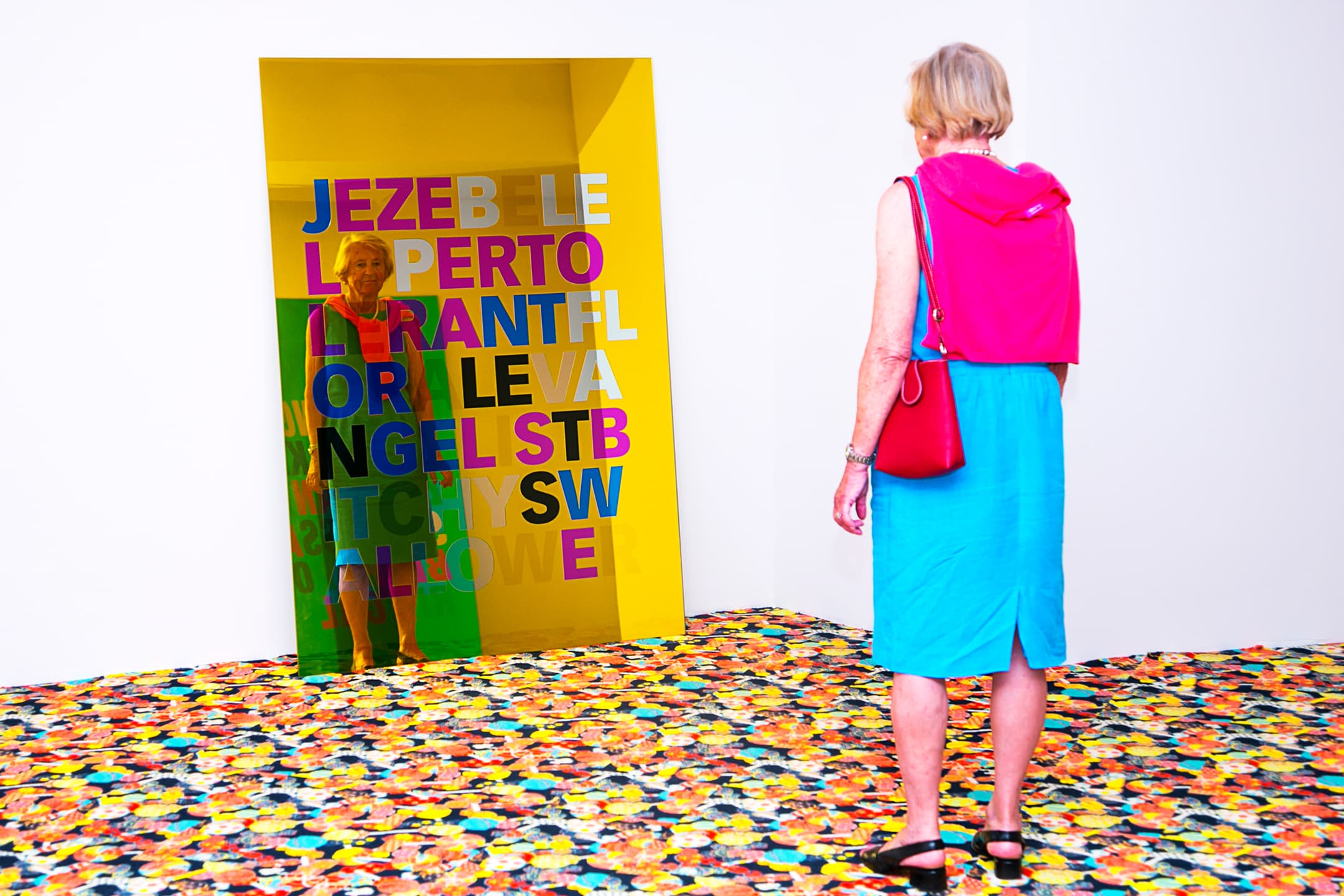
DESIRE FOR THE INFINITE
BURÇE ÇELİK
HISTORY AND POLITICS OF MEDIA
83%SatisfactionGuaranteed. We cannot get the whole, can we? Yet, we desire it. We desire for the infinite. The missing percentages of the fulfillment become the very fuel and the force for desiring all the more. The endless flow of desire is once said to be the ontological motive for human kind for it to continue its life, for it to endure its existence and for it to maintain the very play of fort/da, becoming and/or unbecoming. However, hiding behind the theory of ontology of human species blinds us to see what comes to be concrete through the socialization of peoples. Desire seems to be irreducible in our present. Not precisely because we are ontologically, structurally, biologically or neurologically programmed to be endless desiring machines. But more aptly, it is because; we see no other possibilities in the metropolis and the mediapolis of ultra-capitalism and neo-liberal globality. In this age, in the very present that we share globally, the fantasy of good life is conditioned on the collective and individual desire for the infinite. The imaginary today is the imaginary of infinite expansion. The junk and the cute, the rules of efficiency and beauty, the practices of technology and connectivity, the modes of self-expression and the value of collectivity contribute to the limitless expansion of desire.
Developments in neuro-marketing, in shopping-science, in genetic engineering, in artificial intelligence, in advertising and so on, succumb to the self-limitations of desire. Cornelius Castoriadis once wrote that we, the humans of modern-capitalism, must know how to be self-limiting, if we really want to be free and autonomous subjects (2011). The very notion of self-limiting is integral to the continuing resistance against the flow of shining, fascinating, blinding, entertaining, sugary-energizing flows of objects, slogans, and codes that alter our very experiences, communications and movements today. Self-limiting is neither a call for an esoteric happiness nor a call for repression. On the contrary, it is a call for an agency or a conscious stance towards a new relationship with desire. Desire should not be repressed, and yet needs to be activated to create new forms of being in this world and being with others.
:mentalKLINIK does not promise a cure for the sickened desire of our age. It/they invite the viewers to reside in the moments of oscillation between fascination and disturbance, allurement and estrangement, vision and blindness, and clarity and ambivalence. One can suggest that what they do through their artistic production is to invite the viewers to “know” and “sense” our present, by moving them into the state of “depressive realism” – an ethico-political position that sees “awkwardness, incoherence, and the difficulty of staying in sync with the world at the heart of what also binds people to the social” (Laurent Berlant, 2011). The 83%SatisfactionGuarenteed does not offer a dark and tragic constellation of our present; rather, it manifests an account of fantasy in imagining other ways of relating with the world of objects. While the exhibition makes us to question the fantasies of the good life, happiness, self-optimism and intoxicated surfaces of capitalist realities, it also urges us to reflect on the potentialities of creating a new relationship with the world, objects, matters and the very space that we live in.
Darkmatters is a work that invites us to think of the potentialities that are suppressed in the spatio-temporal zones of our present reality. The surface of the dark-sparkling glitter has the affect of a geological evolution of the surface of a planet – where the matter has its own agency, its own nature of movement that opens onto the infinite potentialities of creation. The new developments in physics, such as quantum physics, show us that what we see as dark air and space is not a continuum of emptiness, rather it is a balanced constellation of objects and matters that are pregnant to potentialities of creativity. It is a choice that we make to limit the potentialities of natural or otherwise objects into the seemingly shining and intoxicating commodities that are by nature unfit to the freedom of human kind. It is a choice that the present assemblage of power that functions through the corporate capitalism, digital surveillance and the systems of code to fix the endless potentialities of the world of objects/matters into the mechanisms of profitable efficiency and commodified beauty.
Airless – which makes use of the readymade toys that have become enormously popular in many places through the rapid increase of the global flow of cheap labor products coming from the south Asia – is also a play with the notion of air, space and potentialities that are hidden in the atmosphere of social living. The cute balloons become uncanny objects after the air is taken out or before the air is given in – showing the awkwardness, absurdity and the tactlessness of what we currently find cute, nice and sweet. :mentalKLINIK interrogates the idea of commodified cute by also reminding us of the mobility of objects, capital, produces that are manufactured in the zones of child labor, authoritarian regimes, and the amalgamated force of law, surveillance and capitalism.
BitterSweat (video, 24 hours, loop) is an allegory to an endless stasis where the seeming movement of bodies fixates the potentialities of corporeal activity into a form of passivity. The “beautiful” body of a walking woman is not going anywhere, not even approaching the glorified brightness of the world of entertainment and full satisfaction. It is a sweat that moving and yet static body produces in her endless endeavor to reach a celebrated fulfillment of a bodily presence in joy, entertainment and happiness. Yet the sweat is bitter: what appears to be neat and symmetrical is indeed messy, what appears to be activity is indeed an ultimate stasis of desiring machinic bodies.
CandyCrash carpet covering the floor of Exhibition Avenue is there to remind us of what we do to deny the relentless feeling of stasis in the world where everything seems to flow at high speed. The feeling of stasis is an inevitable and integral part of our accelerated reality. The constant and endless movement of data, commodity, body, information and goods paradoxically manufactures the affectivity of stasis and even of boredom at times. Yet in contemporary mobile ecology where we cannot bare the moments of slow thinking, boredom, contemplation and reflection, we prefer to enjoy cutting candies, fruits in every kind on our mobile, portable and individual touch screen at those moments. The “activity” or “interactivity” with the interface is there to help us to kill the spare time. The CandyCrash of :mentalKLINIK is also cut into pieces and pasted to be a whole to cover up the floor from wall to wall. Just as the continuum of daily life is constantly cut and interrupted with the moments of gaming; the ground of viewing experience in the exhibition is constellated out of pieces of cut candies.
The very notion of cutting – both in metaphorical and literal sense- can be used in many different ways, when we try to “know” and “sense” the present. If one necessary way is to speak of how the time is cut into pieces where the working time and spare time is fragmented into pieces while spare time is also cut into many other moments in which the subjects subjectify themselves into the culture of junk and distraction. The other sense of cut, interruption or fragmentation can be put into use to reflect on way in which we define ourselves in our present. The cutting of present from its historicity, the cutting of words and concepts from their historical and contingent contexts and the constellation of fragmented notions in a juxtaposition where unfamiliar, unrelated, conflicting and contradictory signifiers come together to produce oxymoron.
Profiles, in this exhibition, plays with the discursive world of contemporary time such as slogans, words, concepts, orders etc., which we use as we attempt to name and identify what/who/how we are, we want, demand and desire in this life. The words/slogans/concepts etc. seem to function as free-floating signifiers that have no relations to history nor to the socio-historical contexts, let alone to the ethico-political positions that care for the self and others.
The search for consistency in subjecthood has long been disappeared. And this could be counted as a progress in the history of social relations and self-making. It could be considered as a decline of a burdening chain on the modern individual’s neck – yes, express yourself in the way you desire, curate your own story in the way that seems the most appealing to you and others. Order a cappuccino; write your pro-activist slogans on your Facebook wall; show altruism for the starving kids in the south; vote for the parties that promise to cut the taxes and to bring freedom and democracy to the other ends of the world… The whole social regime propped on the pattern of picking the suitable commodities available in the market, of curating one’s social appearance on social media, and of creating sexy slogans with the fear of missing anything desirable out of the statement perish the potentialities for imagining alternative ways of social and economic relations as well as ways of caring for oneself and for others. The Profiles that :mentalKLINIK has been creating for a while touches on the loss of a “person” who seeks for a new relationship with patterns of desire, a new understanding of the social world and a creative presentation of oneself and encountering with others – precisely outside of the heteronormative world of statistical, moral and conventional norms.
One of the most interesting works of this exhibition, PopRocks – a sparkling wine containing poprock candies in it – is a performative work that would be experiences by those who are present in the opening of the exhibition. The ephemerality of joyful tastes of our present could not be experienced in better ways. Performance art is said to be about the body – the artwork in performance triggers the senses and the affectivities of our bodies of finitude. The PopRocks moves us from inside our body to contemplate on the affectivity of junk, entertainment and desire of our present times. It is not only the outside of body or the surface of the body, but also the very inside that becomes the ground for the production of intoxicating desire for expansion. As the PopRocks explode in our stomach and in our mouth, we can sense more and more how the toxic power invades our very inside.
As a couple and a double who move between being one in two bodies to being many in one body, :mentalKLINIK searches for the creative ways of thinking about our present through their art. 83%SatisfactionGuaranteed is a collection of their works –each of which invites the viewer to know and sense our present and to create a new. They do philosophy by way of conceptual and contemporary art. And they take the risk of 17%.
*Castoriadis, C. (2011). Postscript on Insignificance: Dialogues with Cornelius Castoriadis. Tr. By G. Rockhill and J. V. Garner. London: Continuum.
*Berlant, L. (2011). “Depressive Realism: An Interview with Lauren Berlant”. Hypocrite Reader, Vol. 5. [http://hypocritereader.com/5/depressive-realism]
* She received her doctoral degree from McGill University, Department of Art History and Communications. She taught history and politics of media and communications in Istanbul (Bahcesehir University, Faculty of Communications) before she joined Loughborough University London. Her doctoral supervision is mostly focused on the materialist history of media and political communication, especially in the context of less-privileged places of global capitalism.
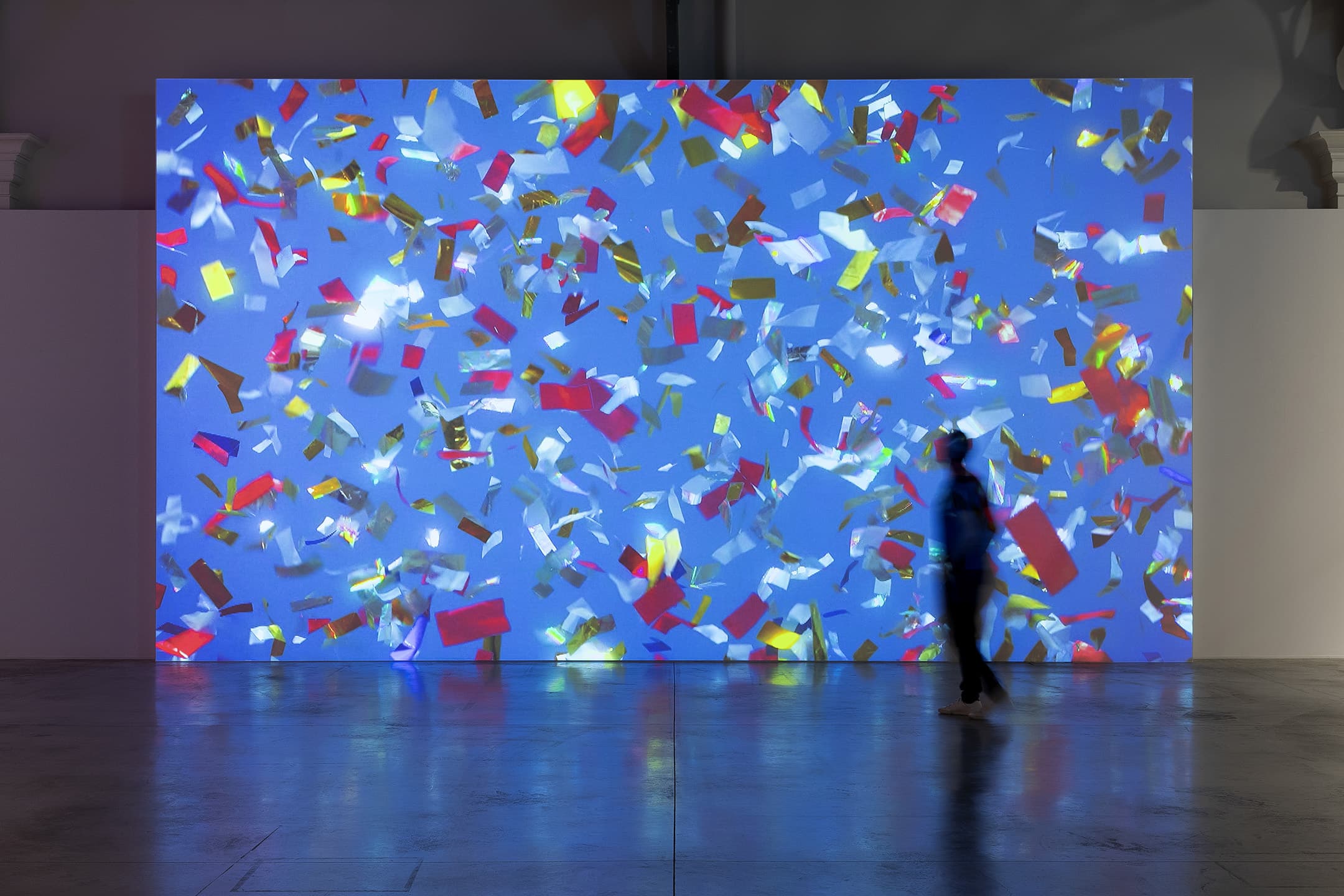
CONCEPTS OF IMAGES ARE HAUNTING US
HATİCE UTKAN
HURRIYET DAILY NEWS
OCTOBER 23, 2018
:mentalKLINIK, an artist duo from Istanbul composed of Yasemin Baydar and Birol Demir, who lives and works in Brussels now, once again marked its sign with three simultaneous exhibitions in Europe. Shows in Brussels, Vienna, and Belgrade gather both new and previous artworks focusing on different themes around technology, social media, internet, codes, attention economy, psychology and how the perception of happiness change in world. In some way they want us to discover how life with technology and on the Internet develops and in another way they want us to become fully aware of the effects of this culture. However, their power of creativity is not only creating works around these themes, but it is also how they present these works to the viewer. For them, artworks are just a presentation, a vessel (just like language humans use to communicate). :mentalKLINIK’s works let us discover the broad language of the world we are not aware of in our daily lives.
‘‘We define ourselves as Bridge-generation. We have born in the 20th century but began creating works in the 21st century. The first :mentalKLINIK exhibition was in 2000,’’ said :mK. :mentalKLINIK’s works are a passage between the 20th century and 21st century. They believe their works are a transition from their generation to this generation.
‘‘We do not mean to exalt technology, but on the contrary, we try to show people how technology affects us in the physical world,’’ said :mK
That’s why the works of the duo are controversial, provocative and almost seductive. These artworks are destined to give the viewer deep thoughts on the life we are living and maybe the dark side of the contemporary life, which may be perceived as a good life fantasy, technology, accelerated capitalism, hyper-connectivity and desire.
However, it is not easy to gather all of these notions in one exhibition. That’s why they work carefully and meticulously. Artist duo said :mentalKLINIK’s ‘mental’ part is Yasemin and ‘klinik’ is Birol Demir, but they also might shift. Together they create something that is desirable though, and somehow they position :mentalKLINIK as an organism or a creation, which can exist separately from them. ‘‘Our idea is to give the torch to another artist for a while and :mentalKLINIK can continue to exist separate from us as well’’ This kind of a revolutionary idea can almost exist with the revolutionary artworks. The duo shows us details that we encounter in everyday life but are not aware of, such as the absurdity of social media language, the seductive world of marketing. ‘‘We use a high-speed camera in our video works. Some Ads are also made with this technique. It is forbidden to use this camera more than a few seconds, cause it affects how we feel, how we think and our body. And that’s what :mentalKLINIK is looking for, The high-speed camera works are taking the viewer into the artwork and create layered scenery and affects the erotic body.
AESTHETICS OF CELEBRATION
In :mentalKLINIK’s works there is always an aesthetic of celebration. In most of their famous works such as Moet, (large-scale twist off tops from champagne bottles that lay strewn on the floors) or Whiff (taken with the high-speed camera technique video), shiny walls, fluorescent lights... Somehow all of these works are reminding us that there is a celebration. However, there is no subject or object. You cannot see who is celebrating what. You can only see the end or the moment of celebration. We do this on purpose, said :mK nothing that the important thing about celebration is its aesthetics. According to the duo, there is a therapeutic way of watching Whiff. ‘‘In this sense, we want to create a feeling of slowing down in this fast life we experience each day and In fact, we are celebrating a beginning of an end.’’ said the :mK
Language is an essential part of :mentalKLINIK’s works. Their exhibition’s name ‘Obnoxiously Happy’ is also proving this. They provoke the audiance by using oxymorons and show people how two unrelated words stand together and create a new meaning. This is also a significant effect on social media according to the duo. As it changes everything, it also changes the language we use, they said.
The language and the #hashtags takes the viewer to the images and media. The duo follows each issue of Time magazine. In a way the magazine is a dominant player in this media world creating new concepts and perception of American politics on the world and changing strategies of the economy by manipulating its readers. The headlines and the cover image is the main power of the magazine. The duo, on the other hand, likes to show the irony behind this by sticking different (shiny and childish) stickers on the magazine. ‘‘Working on this is almost like therapy for us,’’ said :mK adding that they do not work on each cover only the ones that they see as important and influential. However, it is fair to say they also do not believe the power of media as they define the press is also a code that is given to us in the world.
PROFILE SERIES AND GOOD LIFE FANTASY
We all get used to hear and see made up words on social media and on the Internet. Since we had Twitter or Instagram, people are doing everything they can to define themselves with labels. These labels are a concern of :mentalKLINIK. That’s why they started to create profile series in 2015. ‘‘We believe that we are living in an era where the language is very dominant in our lives. Maybe people do not read, but people write, and the text is open to codes and brave. People love to define themselves with made up or real words such as frenemy, religious, celebritytwit, , etc...’’ In a way :mentalKLINIK feed itself from the creativity of these words and in another way they would like to show the viewer how humans are destined to get recognition out of these profile words. ‘‘This precarious lifestyle drives everyone to design themselves again and again. So, a person becomes both subject and object at the same time while being datafied,’’ said :mK.
Behind all of these, there is a desire to be recognized. This is a part of a good life fantasy, according to :mK. The duo, on the other hand, believe in good life is only to be aware of the environment we are living in and what is happening around us. It is a must to be aware these times, said :mK and added each word serves as a code and Internet industry giants are just looking for these codes, and each person is only a data in the system.
Among all these dark sided works people are having fun at :mentalKLINIK shows. For example, their current exhibition at Brussels attracted many visitors. ‘‘There are two sides of :mentalKLINIK shows,’’ said :mK, you can have tremendous fun in it and add selfies to your good-life fantasy, or you can see the dark side of the system. It is only a matter of how images turn into a concept in your mind. ‘’
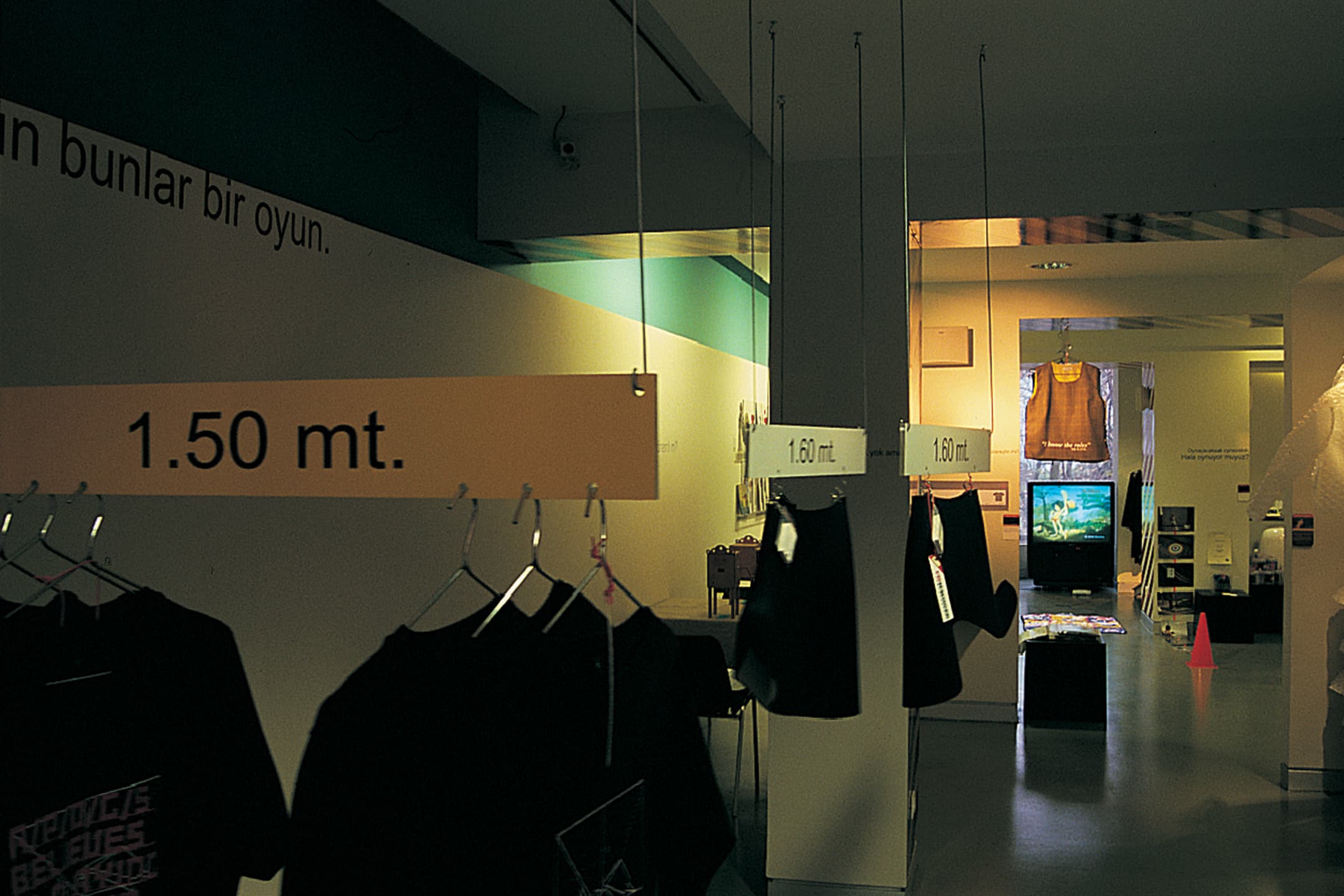
:MENTALKLINIK-02.{GAME} ISTANBUL 2002
TÜL AKBAL SÜALP
If life is a game, what is game?
Games may be all about life, experience, production and giving a try to live in different ways. It most probably takes away the socially well-defined boundaries and rules. It is like another country or at least an unlimitedly open domain for its players in which everything can be switched, replaced, shifted; child can become an adult, an adult can become a child. One can put everything upside down; inside out and vice versa.
Game might be an experience of getting dirty or purifying oneself, having filled with satisfaction, pleasure but at the same time feeling disposable, emptied or exhausted. It is on the thin border of being god like or being a dust. Therefore it comes close to bakhtinian carnival where death can rebirth; joy intervenes dullness. For, it is the most harmless way to discharge anger, aggression and violence. It can be the best well-known address for refill and disposition of energy according to Freud.
In games there is always a space for irresponsibility, for staying untouched, for surviving sterilized since whatever you do is just a game; you cannot be held responsible for any harm because you are just being someone or something; you don't need to carry the burdens on your shoulders, you don't need to pay for damages you caused.
yet games carry and hold the possibilities of being social since they can be about experiences of being in and through a society in which players can also produce a new world and unknown, untold experiences.
Tül Akbal Süalp
cinema, media and cultural studies
curator: yasemin baydar, birol demir
editor: tül akbal süalp
participants: zehra tümertekin, ela cindoruk, nermin er, dara kılıçoğlu, /a/p/o/g/s/; sofie fischer, carl connaughton, ture anderson, mads quistgaard,
özer yalçınkaya, ayşin aşkar, serkan şedele, melis ağazat, asuman krause, demet yoruç, göksun çam, yasmin iris yağlıyan, ulaş eryavuz,
teri roditi, yael roditi alau, aysim türkmen, ethem özgüven, aykut erdoğan, dd, yasemin baydar, birol demir, ethem özgüven, dilek winchester,
aleksandra seculic, snezana skoko pabic
graphic design: ulaş eryavuz
book design: :mentalKLİNİK, pınar akkurt
photography: serkan şedele
moving images: ethem özgüven
jingle: özer yalçınkaya, dd
supported by: açık radyo 94.9, avrupa baskı merkezi, beydur group, derin design, enforma IT, illy, lumina,
mimeray, nova, imaj, sony, timeout istanbul, wall, stil matbaası, studio, gökhan plastik
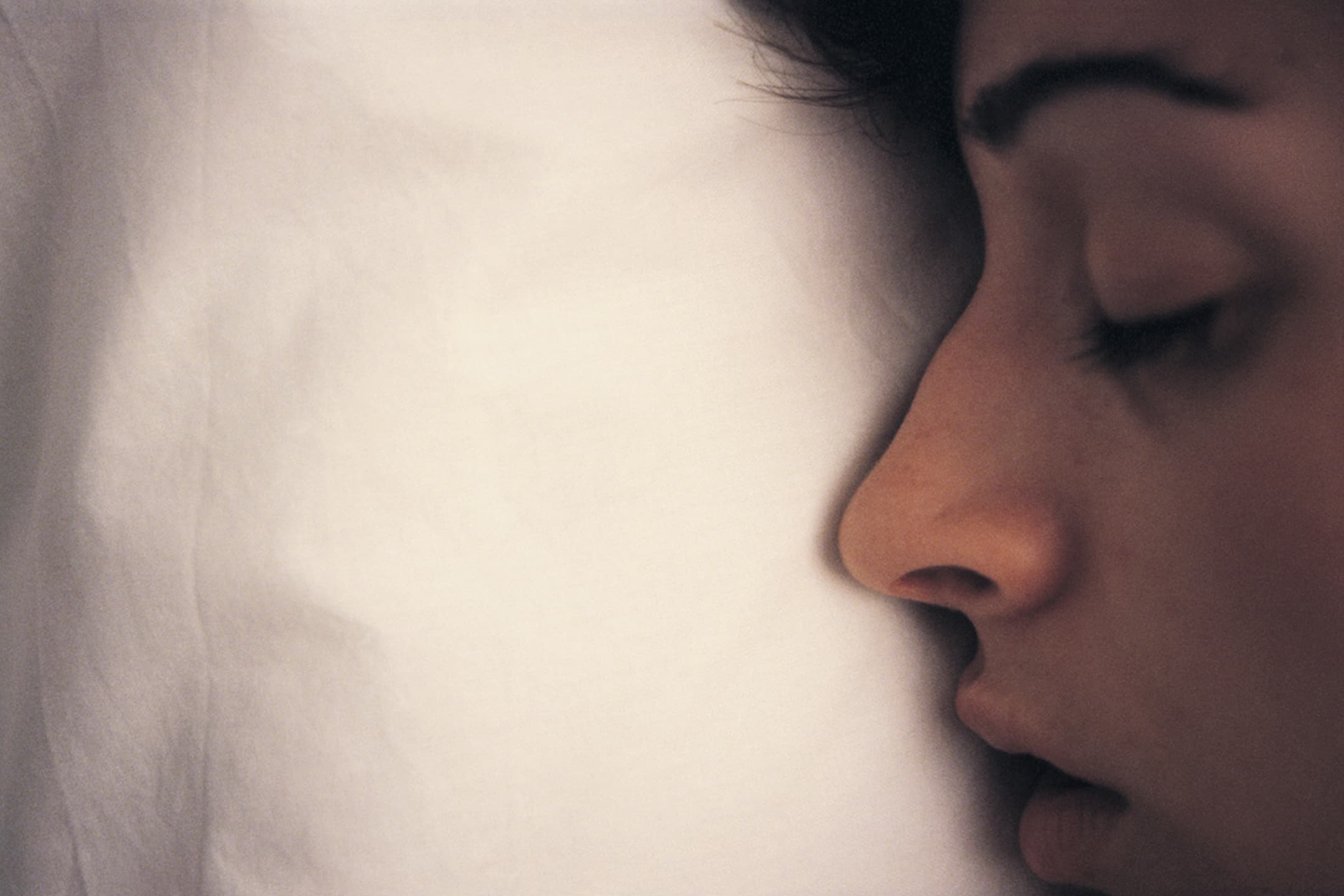
:MENTALKLINIK-01.(SLEEP) ISTANBUL 2000-2001
:MENTALKLINIK SPACE
CLEAN AS A BLANK PAGE
'Since the beginning, mankind is sleeping. Without any resistance against. Without knowing the reason why. In fact, the answer is as easy as sleep itself; we just fall into sleep as all other living creatures do on earth! Although science explains the process, findings are insufficient to clarify it all. It's still a "dark light" or a "white shadow" for us. It's shapeless, slippery, sleepy that means it's like "love" we'd say... It comes, seizes and flies you away. Just therefore it is a "poetic" concept.'
Birhan Keskin
Poet
curator: yasemin baydar, birol demir
editor: birhan keskin
participants: yasmin iris yağlıyan, levent morgök, tanju özelgin, dilek aksu,
bettina franckenberg, seza paker, yasemin baydar, birol demir
graphic design: ilkay aydın türün
book design: :mentalKLINIK, didem ateş
photography: ömer kokal
illustration: kazumi yamamoto takaya
sleeping girl: gülnihal haliloğlu
supporters: avrupa baskı merkezi, enforma it, illy, lumina, nova, tekno/ barissol türkiye,
gerekli şeyler, ohan matbaacılık, grafik film
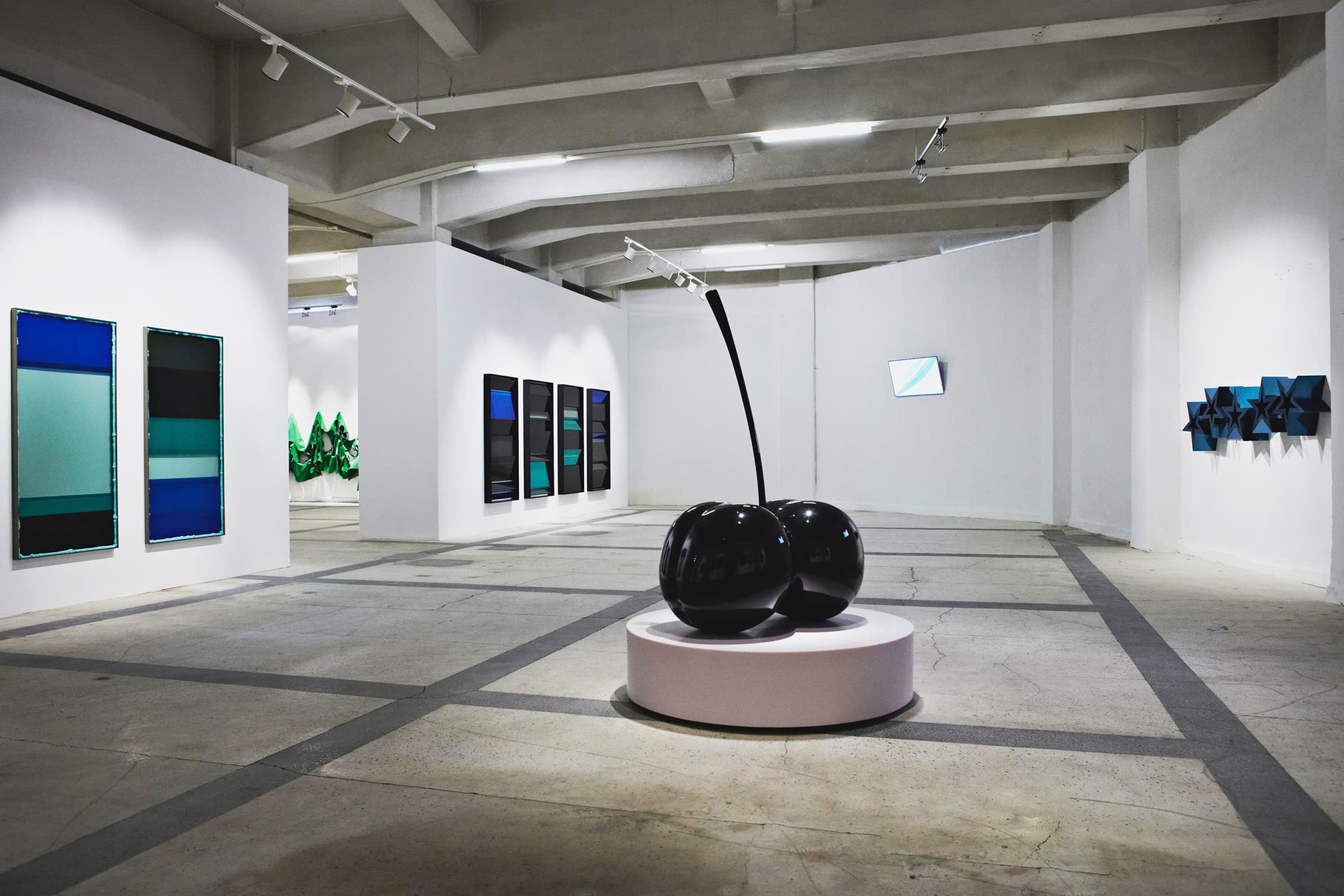
FAR FROM THE MADDING CROWD
AYLA JEAN YACKLEY
CANVAS MAGAZINE
MAY/JUNE 2012
Husband-and-wife team :mentalKLINIK operate on the fringes of the Istanbul art establishment, challenging formal artistic representation through often fantastical and cutting-edge works. Ayla Jean Yackley meets Yasemin Baydar and Birol Demir in Istanbul.
When the Turkish artist duo :mentalKLINIK opened the exhibition That’s F*****g Awesome last year in a former factory in a working-class Istanbul district, enthusiastic residents flocked to the space for a peek. “They came to wish us well, thinking it was ahospital that was opening,” says YaseminBaydar,one half of :mentalKLINIK,whichalso includes her husband Birol Demir. Both are used to causing confusion. After insomniacs mistakenly came to the first show Sleep in 2000, Demir and Baydar felt compelled to find an institute for sleep dis- orders that could help them. A year later, parents showed up with small children to the exhibit, Game.
Misunderstood by the masses and the Istanbul art elite alike, from its name onwards, :mentalKLINIK confounds. “If you look at us from the perspective of the Turkish art scene, what we do is madness. We take our time, we don’t follow a schedule, our shows can last a couple of weeks or as long as two years,” says Demir. “You have to immerse yourself in :mentalKLINIK to understand it. It’s not clear from the outside; we keep the window onto our world shut. We are trying to create an inner world that is separate from the real one,” adds Baydar.
ABSTRACTED AND OVERSIZED
Most of their collectors are in Europe or the Middle East. :mentalKLINIK has yet to find as large a following on its home turf, where figurative and decorative techniques still hold sway, five centuries after the first Ottoman miniatures. “We want to open a space for abstract thinking. That’s something that collectors here are not used to,” says Baydar. Also vexing is :mentalK- LINIK’s embrace of mass production and anonymity. It is left up to the viewer to decide whether what it does is art or not. In 2003 :mentalKLINIK produced giant sticks of chewing gum, called Mimesis, which the couple sold for about $6 each. One could chew the gum or save it for posterity. :mentalKLINIK offers few hints about the artists’ origins; the usual tropes about identity that Turks are accustomed to seeing are absent. “History, memory and identity dominate here, but we don’t believe in that. Our take on history is different, and so we are outsid- ers,” says Baydar. “The world we have created has always been disconnected and fan- tastical.” The closest :mentalKLINIK comes to saluting the homeland is when it needles stereotypes. In Untitled 152 from 2011, a hand- woven Oriental woollen rug is drained of its colours and pierced by brass studs. The patterns are authentic but form an asymmetric jumble of symbols and regional motifs. It’s an urban take on the most rural of Anatolian traditions, mas- culinity spiking a feminine craft. More typically, :mentalKLINIK exists in the Pop Art historical space. They often recycle and remix recognisable works by other artists. Moet from 2011 is an homage to Claes Oldenburg’s small-made-big monumentalism. The two oversized aluminium muselets from champagne bottles neatly echo the Swedish-American sculptor’s rendering of a discarded object at a moment frozen forever. The scale makes it more profound than the off- screen revelry that the champagne is meant to lubricate.
:mentalKLINIK’s work [is] darkly humorous, self-contained and as much concerned with design as with content.
Heretics, it has been said, are the only remedy against intellectual entropy. Puff, from 2009, takes the absurdist’s view of our inevitable decline. Eight hockey-puck-shaped, robotic vacuum cleaners glide across a hexagonal black stage, sucking up the glitter that is periodically ejected like cascades of water from fountain spouts. Again and again, ad nauseum, the vacuums undertake their Sisyphean task. :mentalKLINIK illuminates the stage with banks of miniature floodlights, as if the audience is ob- serving an experiment and the sleek robots are animals in the lab. (This is where the‘clinic’part of the moniker becomes clear). Like the shoal of vacuum cleaners in Joseph Beuys’s 1969 piece The Pack, the inherent silliness of the appliance – their odd shapes, the frantic noise they make – is a reminder of the fallacy that they liberate us from the drudgery of everyday life. Quite the contrary, we are trapped by mundanity and pointlessness. Puff is also beautiful. It is typical of much of :mentalKLINIK’s work: darkly humorous, self-contained and as much concerned with design as with content.
MAKING MAGIC
“Their work is like a disco ball, different facets that are all connected together. As the ball turns, it makes magic,” says Jérôme Sans, the French curator who put together That’s F*****g Awesome. “The work is droll, light; it can look very playful and fun, like a party. At the same time, it is violent, very abrasive,veryquestioningoftheworldwelivein.”Sansfirstencountered:mentalKLINIKwhilestroll- ing down a Hong Kong street, when he literally stopped in his tracks after spotting its work on the wall of a gallery. “I was totally fascinated,” he says. Meeting the duo only confirmed his interest: “They are very exciting. They are the new emerging artists of their generation. They use a Pop vocabulary that gives their work a relationship with different references and backgrounds. At the same time, it’s not a simple reverence for the past. For me their work is highly actual. They are opening the door of tomorrow.”
Sans and :mentalKLINIK quickly agreed to work together, and That’s F*****g Awesome opened in September 2011. The pop-up ex- hibit in a section of the 30,000 square-metre old Hasköy Yarn Factory on the banks of the Golden Horn featured some 35 pieces of :mentalKLINIK’s work from the last decade and drew 1500 peo- ple in the month it opened. Sans insisted it not be called a retrospective but an introspective, a view onto the inner workings of :mentalKLINIK. Like the name of the exhibit, the show was a mix of oxymora and paradoxes. The 2011 works
She’s Awfully Beautiful and He’s Disgustingly Hand- some use two quirks of the English language written large in nails hammered into the wall. The Faker series, also in the show from 2011, are more sober, hyper-modernised Rothko-esque works made of glass coated in coloured film and framed with a tough-as-bone anodised liquid resin that Baydar and Demir concocted in an Istanbul chemical lab.
“:mentalKLINIK is the third person in our relationship, which allows us to create something distinct from ourselves.”
“The show was made to look flawless, like a product right out of its package, something that excites you and prompts you to ask, ‘how was this made?’ The gadget aesthetic is very impor- tant,”addsBaydar.“Artisconsumed.Wedon’tsee a problem in addressing the audience as consumers. At this point, to say art and consump- tion are distinct is rather naïve. We tread the line between creating works of art and making prod- ucts,” ventures Demir.
That’s F*****g Awesome coincided with the 12th edition of the Istanbul Biennial, now one of the biggest events in the art world. The Bien- nial Baydar argues, has become preoccupied with the themes of identity, history and memory that :mentalKLINIK eschews. The duo doesn’t take its cue just from the art world, anyway. Baydar and Demir are avid readers, devouring books and articles on science and technology, fashion and philosophy. Curiosity informs their work.“They are in a back-and-forth with so many disciplines because Contemporary art in Turkey is relatively new, and much of it is superficial,” says Galerist’s Eda Berkman, who represents the duo. “:mentalKLINIK have had to seek out other branches, whether it’s film or technology, to find nourishment.”
THIRD PARTIES
Demir, 45, and Baydar, 40, met in 1994 as art stu- dents at Istanbul’s Mimar Sinan Fine Arts Univer- sity, where he studied ceramics and glassmaking and she worked with textiles and took painting classes. :mentalKLINIK was established in 1998, and Sleep came two years later. More than a decade on, they have published five books, maintain an archive of collected textual, visual and other material called docu:mentalklinik and are in the early stages of making a film. They are planning to open a studio in New York later in 2012, where they will work for part of the year. “Our personalities are very different. Birol is more emotional and acts more sensitively, whereas I use my head more than my heart. We are con- stantly deconstructing each other,” says Baydar, a pretty brunette whose short bob keeps her curls in check. Demir sports Karl Marx-style long hair and a beard, and both are dressed entirely in black. “:mentalKLINIK is the third person in our relationship, which allows us to create some- thing distinct from ourselves,” Demir says over coffee and cigarillos at a sidewalk café in upmar ket Topağac, once Istanbul’s main gallery district until it handed the baton to Beyoğlu. Across a small green verge is their studio on the ground floor of an apartment block that also houses medical clinics. “:mentalKLINIK made sure that the space was open to any passer-by and the locals of the neighbourhood,” adds Ayşe Draz, a member of the performance group Studio Play- ers, who began formally collaborating with the duo in 2006. “The new form of exhibiting they had devised was something I had not witnessed anywhere else before.”
The duo also works with game theorists, film critics, physicists and astronomers. The approach to production is also collaborative, with as many as a dozen people helping them pro- duce certain items. :mentalKLINIK work with local manufacturers, who are sometimes be- wildered by their requests to make new mate- rials, such as the sealant for the Faker series or the fibre epoxy coating for Superhero (2010), the teddy bears that are painful to the touch. Both are examples of the minimalist strain that runs through the work. This lack of grandiosity may cause the viewer to err and think that the work is simplistic. In fact, it is the product of painstaking labour. Draz described an “obsession” to make the pieces playful to engage the audience.“They somehow manage to transform the anxiety of always looking for new forms and devising new experiences into a very productive process,” she says.
Much of the work is tension-fuelled but it is adeptly managed, like the orderliness at, well, a hospital. “There is a therapeutic quality to :mentalKLINIK,” says Baydar. “It can be lyrical and calming, but just beneath there is cutting, shattering, violence – the other side of therapy. Everyone needs a mental clinic.”
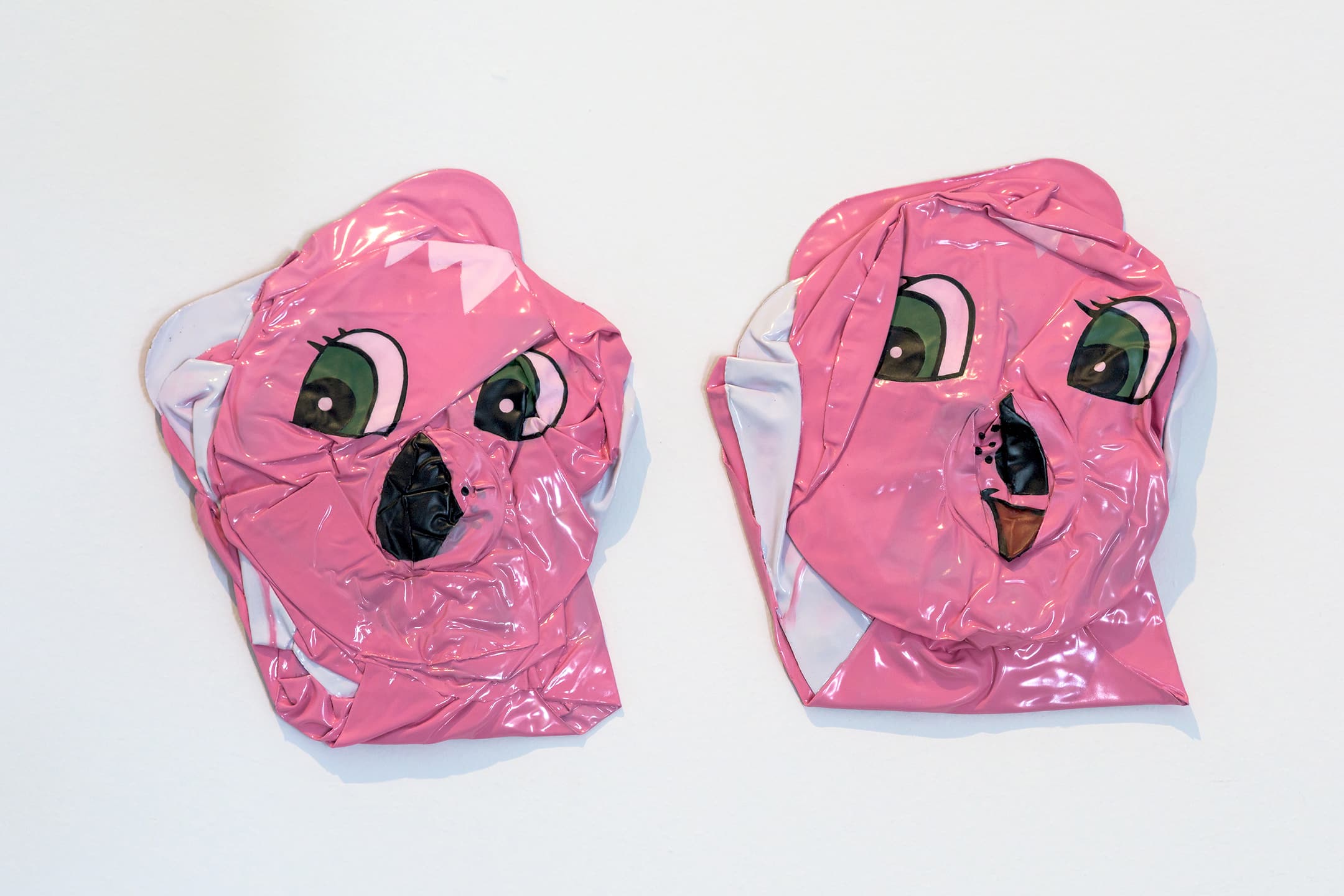
BEAUTIFUL SENSUAL RUIN
CAIA HAGEL
ART PAPERS
SEPTEMBER/OCTOBER 2015
Are You Happy Enough without a question mark flashes in two-tone neon at the entrance of the Louise Alexander Gallery in Porto Cervo, Italy, a stylish space that overlooks a leafy piazza, that itself overlooks a vast expanse of shimmering sea. This idyll setting, where gallerists Frédéric and Ayse Arnal pivot provocative contemporary artworks aside age-old Italian traditions, infuses the space, and the exhibition by Turkish duo :mentalKLINIK, with a dreamlike aura that masks the irony of the work, at first.
Upstairs, the irony begins to take hold while the audience gathered for the opening, a vertiginous mix of locals, international superyachtists, press, collectors and friends, stand vertiginously grounded on Candy Crush, a wall- to-wall carpet artwork printed with so much candy that looking down at it brings on nausea. Ahead is BitterSweat, a film shot on a military high resolution camera at 1500 frames per second that the show’s artists, Yasemin Baydar and Birol Demir [:mentalKLINIK], say evokes the unconscious via subliminal messaging—of a girl walking away with a very inviting bum, towards a row of exploding water spouts.
This visual combination creates a cruel optimism wherein libidinous celebration will not be delivered. BitterSweat (on an endless unattainable loop) foreshadows the now deepening irony of this teasing oeuvre in its luxury setting: a symbolic re-enactment in several acts of our contemporary malaise, one in which we are riddled with desire that can never be satisfied.
Near BitterSweat on the surrounding walls are Profiles, portraits painted in words on solar-film mirrors where “Tom” and “Emma”, fictional Internet users, are described in adjectives like Eloper, Evangelist and Swallower. These are set amongst Airless, sculptural renditions of deflated once- balloons with giddy Disney faces, now limp and ruined, and cast in electro clad copper.
A sound sculpture booms from below with ringtones, email inbox alerts, chat notifications and text arrival noises. Suitably entitled FOMO, these audial prompts, the same ones that once excited us, now, we begin to realize, just make us feel anxious.
The globality of stimulation that we are assaulted with here, from shiny, reflective surfaces, glowing, seductive body parts, sugar-coated Disneyfications and FOMO invigorators, to the spumante we are served as an installation piece, an already bubbling aphrodisiac now spiked with poprocks, the carbonated candies that fizzle in your mouth and turn it shades of purple, blue and orange—erased now bring on the full irony, and the full ill of the human condition: the excruciating gap between desire and fulfillment that technology, our unstoppable progress, only intensifies.
But :mentalKLINIK does not leave us lurking in the underworld without some means of redemption. Downstairs, quietly to the right of Are You Happy Enough, in the gallery window, is WOO-OOO, an installation featuring two robotic heads facing each other, performing a series of movements that feel intimate, even loving. Created in our likeness via neuroscience and biotechnologies, we recognize instantly that amidst the other, more human-referencing works, these simulated humans are enviably naïve. Their kissing won’t lead to being liked or unliked, followed or unfollowed. Their intimacy can be meaningful and savored because even if they are our own technological creations, the WOOers are immune to the human world that created them.
This robotic respite from what the rest of the show makes us feel; the many painful forms of sensual burnout, the melancholic fallout of hyper- capitalism; introduces a cryptic messianic octave to the exhibition. Watching these robots, who appear by our projections to be pure and in love, indistractibly devoted and way more than 83% satisfied, we start to wonder: ‘what is missing in me?’
What is missing may be the gravity and integrity that digital existence has apparently eroded. As we enter this zone with this art, we may feel hungover. We may look at the robots and think: are these artificial lovers more authentic that we are? Are they safe from the side-effects of adrenalized surveillance? Of Google DeepDream psychedelic porn? Of the early 21st century whirlpool where analogue collides with digital, identity goes into flux, cities grow wild, economic insecurity blows up, materialism gets holier, corporate colonization sinks its dentures in, environments fall into catastrophe, people pass through but don’t stay, fame becomes instantly accessible, public and private headbutt each other, hook up apps and fetish auto-erotica replace intimacy à deux, and society doesn’t really know what it
is anymore? Can these uncomplicated artificial things save us by stopping the turbulent portal where human body, mind and soul are so yearning, and so vulnerable?
Robots are unable to feel pain or pleasure. Scientists are researching the means to create emotional experiences in androids to more greatly fulfill humans. Many of them, especially the robot friends employed in hospitals for sick children, are already equipped with facial recognition tools that allow them to be experienced as empathetic to humans. If robots appear to understand us, and empathize with us in our deepest emotions, does it matter if they are not people and that their reactions are programmed from a set of scientific algorithms?
This is the metaphysical frontier of :mentalKLINIK, a metaphorical place where people have exhausted their vices and this deflated state has collapsed into a virtual demarcation where sensual torture, extended into technological advancement, has manifested the power to metamorphosize longings, shyness, disappointment and shame, into healing.
In July of this year, the first ever photos of Pluto, the planet the lightest years away from Earth, were taken and sent back to us—by Ralph, a camera-cum- cosmic artist robot, equipped with sharper eyes than many living things combined. Ralph was specially designed for this exceptional mission. The images gone viral of Ralph’s NASA lab headquarters celebrations reminded us of how we love the mythic quest of Us versus Universe, and how there is nothing more satisfying than a triumph for Us, even if that Us is Ralph, a camerabot.
Around the same time in July that Ralph was snapping Pluto, a robot that was being assembled by a twenty-one-year-old Volkswagen factory worker near Kassel, Germany, mistook its assembler for a machinery part. The robot gripped and pressed this young man up against a metal plate, crushed his chest and killed him. In this anti-hero mission exceptional for foul play, prosecutors struggled with wheather to prosecute and if so, whom. At this new gateway where :mentalKLINIK likes to work, post-humanist ethical questions glimmer loudly in the shadows, along with debates around molecular and nano-carbon based self-replicating machines, which may choose without human consent to play hero or anti-hero.
Some artist-theorists (Hito Steyerl, Jalal Toufic) are romancing the idea that humans are parasites of technology, solicited by technology’s intelligence to generate, like, store, and share its hyper data production. Others (Jon Rafman, Daniel Keller) deal with digital experience as a tangible extension of human (un)consciousness, a hyperconnected, always-on, overloaded, violent short-message entertainment where technology is manipulated to express its creators’ troubled, but sometimes sublime, reality.
The psychology of gratification enabled by the Internet and its vessels, the aesthetic rapture as a representation of democratic demise and melancholy via the penetration of global capitalism into every area of living, is the place in-between theories where the body has to respond to the pace and enormity of technologically-engendered change. :mentalKLINIK takes us and keeps us in that place, in a collective consciousness littered with glitter and empty champagne bottles, leftovers of a party that never happened, or happened too hard, too fast, and too often.
83% Satisfaction Guaranteed builds on previous shows and works, Thank you For Your Cooperation; That’s Fucking Awesome; Moët—where remnants of happiness, parties, excess, glamour, the promise of pleasure, go too far in their delivered or undelivered vows, and become gruesome. As an accumulating oeuvre, it’s a voice that takes a stand on the transformational potential in sensual ruin by binding the aesthetic, the cognitive and the critical.
Our mysterious relationship with technology camouflages the doorways between image/object, information/material and the energies that bind our bodies with our souls. Our techno-zeitgeist is shot with forlornness. “Lost in our senses, anxious to feel, and depressive about our state of being,” according to the artists, who elaborated on this existential sensation while we vertiginously looked on, and they sipped the last of the spiked spumante:
“Neuro-scientific studies along with developments in cyberspace enable the datafication of elements [of human experience] that used to be invisible. As
they get datafied they are subject to being measured and therefore to being manipulated. While the oneness of the collective unconscious of the past signified rather a domain of liberation, the oneness of the new datafied collective unconscious is a totalitarian domain. Within this domain humankind is no longer free to express his/her desires, impulses or longings but rather his/her desires, impulses and longings are programmed.
Our works appeal to and trigger and stimulate the senses. They are erotic but not pornographic. By this we mean that they do not impose themselves upon the viewer but invite him/her into their own reality, where all senses are engaged. For example, with poprocks both the senses of hearing and taste are engaged and an intoxicating process that continues in the body is triggered. In addition, rather than offering just erotic imagery, our works trigger all sorts of sensual responses from the viewer and lets him/her revel in his/her own imaginary eroticism.
This metamorphosis that is taking place is one in which while the robotifying of human beings happens, this process humanizes robots at the same time. It is therefore a dual relationship, one that only an oxymoron is capable of defining. We are also a transitional generation that knows both worlds, that of our physical reality and of the virtual one. Our aesthetic is rooted in this threshold where the physical looks virtual and the virtual appears physical.
A shift has already been in effect as the contemporary state of mind takes root not in fear but in anxiety, since today’s reality is a hypercomplex one, emerging of the networked world. Today we are no longer able to envision a future but rather a future without hope occupies our here and now. :mentalKLINIK works with a retrospective point of view from the future transposing the possibilities of the future into today.
Rather than assuming a spiritual role we are interested in emancipating and empowering the sensory faculties of humankind that are impoverished within the contemporary context. Today, the notion of touching upon the ‘other’, metaphorically as well as physically, is invalidated since the notion of the ‘other’ itself has become meaningless in a world where trust is lost forever. We intend with our works to appeal to the viewer’s senses to such an extent that at times the works almost violate the viewer’s personal space. During this process the viewer becomes aware of his/her senses and this awareness is very central to our works.
The question of reality has always been a driving force for :mentalKLİNİK. We deal with augmented reality because it shifts our perceptional relations. We try to record augmented reality’s effects on our ways of seeing and sensing. Augmented reality is an environment that
includes both virtual reality and real-world elements at the threshold of the future and the present. The possibility of breaching the barrier is created by tools of augmented reality such as Oculus. Such tools enable a ubiquitous presence, a simultaneous presence both in fantasy and reality, engaging the senses at the same time. These tools’ function is neither positive nor negative by nature, however they can be applied for either a positive or a negative end. They can be applied as a vehicle for mass control or as an apparatus for breaching the above-mentioned barrier and thus for healing our painful, unfulfilled state. If humankind could afford not to take himself/herself so seriously s/he would be able to build a new notion of trust and to create a collective mind that is without ego, capable of merging the physical and the virtual worlds for a better end.”
:mentalKLINIK 83% Satisfaction Guaranteed @Louise Alexander Gallery, Sardinia
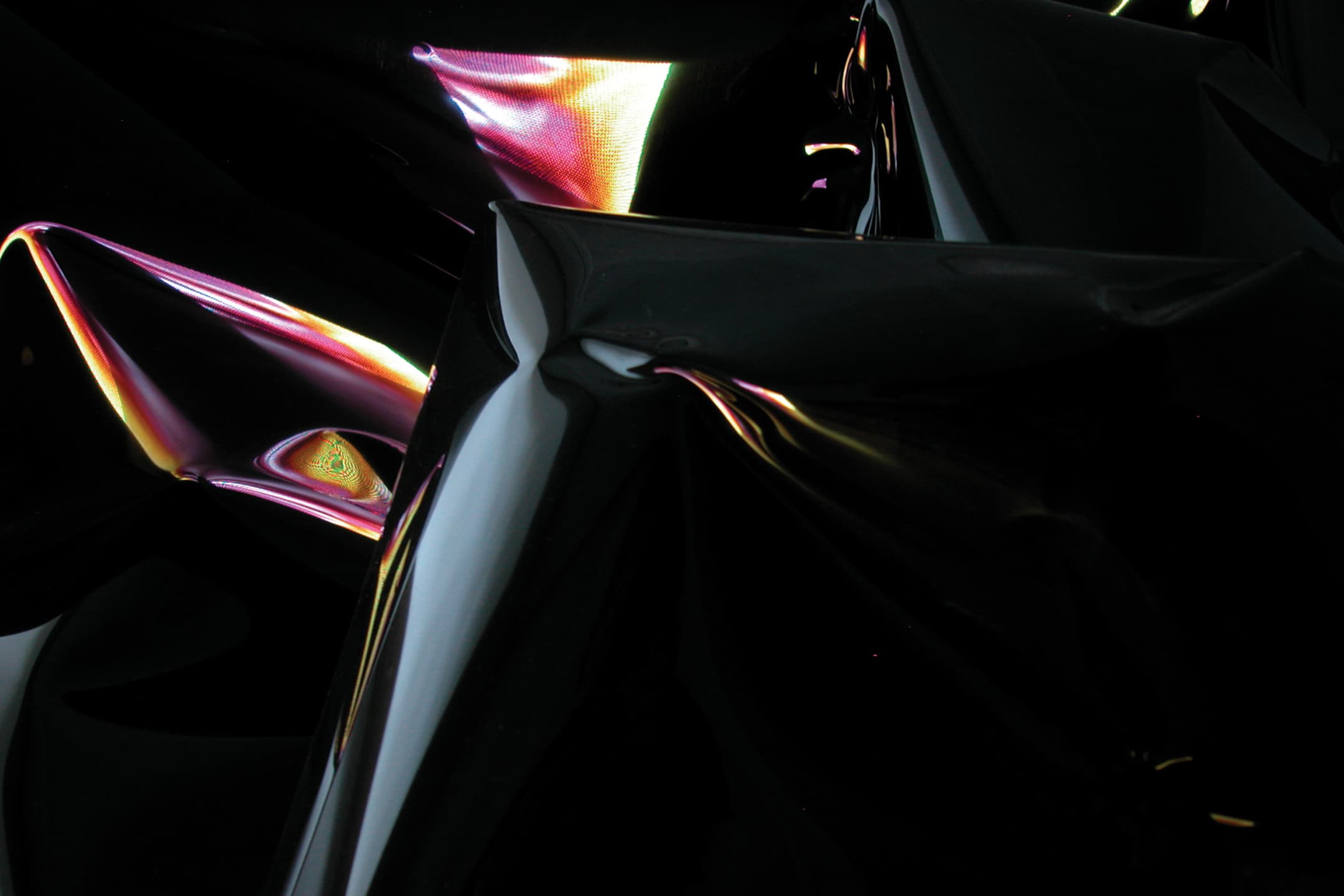
FLUIDS AND TURBULENCE: DEBT PAID TO HERACLITUS
ALI AKAY, MARCH 2008
INDEPENDENT CURATOR / PHILOSOPHER
The written bulletin, starting with the premise of “:mentalKLINIK is open from 4 to 8 pm., every month during 2008” points out to a new artistic experience. The exhibition which will be open during certain times will also have fluidity in time. We’ve known the relation between change and temporality since Heraclitus. Antiquity thinking had created the saying of “everything flows”. Heraclitus the Ephesian, “on those who step in the same river, different and different waters flow” (12nd Fragment). In another proposition, fragmentary writing continues: “We step and do not step into the same river, we are and are not”. Also written in 12nd Fragment that “and spirits born out of the moist”. With his words, would it be possible to make an equation between the evaporation of spirits and the continuity of reasons? The beings of temps humid and human body covered with water carry the reason. So, he has written: “Death, for spirits, is to transform into water; and for water, it is to become earth. Water is born out of earth, and spirit is out of water”. Therefore, the reason remains in the fluid waters, while everything lying down is disappearing. What remains after the volatile parts of the art, is the stability; reason and the art may be born out of the opposition within the reason and the out-of-reason. This opposition lies behind Heraclitus’ saying that “unities totalize and non-totalize”; just as the same as he calls us with another proposition: “Any creepy has share from the earth”.[1] What is at stake is a unity, a Platonic archetype or in other words, ideas or an Aristotelian hylomorphism; thus is reproduced out of the unity of matter and form. When we read this proposition, we oppose with the principle of changeability of Marxist dialectics. Lather, fluids and turbulences had constituted Lucrecius’s physics. Fluxes, which are being fed with the effects of flows in every moment, have contributed the formation of procedural thought. What remain is again eroded in time; what is at stake is kind of long time entropy: Historians and archeologists search for the answer to the question of “what remain from writings written on papyruses, parchments and pelts, as rolled?”
We do not intend to go that back; nevertheless, in order to throw light on the function of contemporary arts, it is important to dwell upon the origin from which big thought of physics of fluidity. :mentalKLINIK uses the word “fragment” in the third order; thus the blur out of fragmentation will appear as a fragment for us. :mentalKLINIK goes on with words: cloud (born out of moist); open source (the openness of where the waters come from); liquid (changes within liquids and fluids: “We step into same river and do not step”); turbulence (Lucrecius physics and the invention of physics in a poetic way), Joseph Beuys (“life is a child who sweeps and plays with stones. Kingdom of a child: dregs that Beuys swept during the exhibition); grains (fragments); nebula (moist in the cloud); accident (each fluidity has an accident; it may not be known to where it will go); immaterial (‘invisible harmony, strong in appearance’: 54th fragment or
“People fail in knowing apparent things, just like Homer even if he was the wisest of all Greeks: 56th fragment) or “Spirits smell the invisible”:98th fragment, writes Heraclitus in his Fragments); light (‘visible, audible, perceptible, all I’ve preferred’: 55th fragment).
In this sense, when we look from this perspective, against all odds, though his name is not mentioned, we can say that this exhibition owes to Heraclitus in a sense; thinking that each philosopher has a legacy and owes to predecessors. Debt means a remainder potlatch; a process of returning back; a principle of reciprocity; and in a sense, it should mean paying for equivalent or if possible, more than the equivalent. It is the economy of gift; art is a gift. That of the artist’s is a debt to pay to big philosophers and to thinkers. :mentalKLİNİK, with its hylomorphic structure, and its produced forms and materials, has paid its debt to thought on whose curves we dwell upon.
[1] We take Turkish translation of Heraclitus fragments from Samih Rİfat’s translation. His contribution to Turkish language is as much as to be unforgettable.
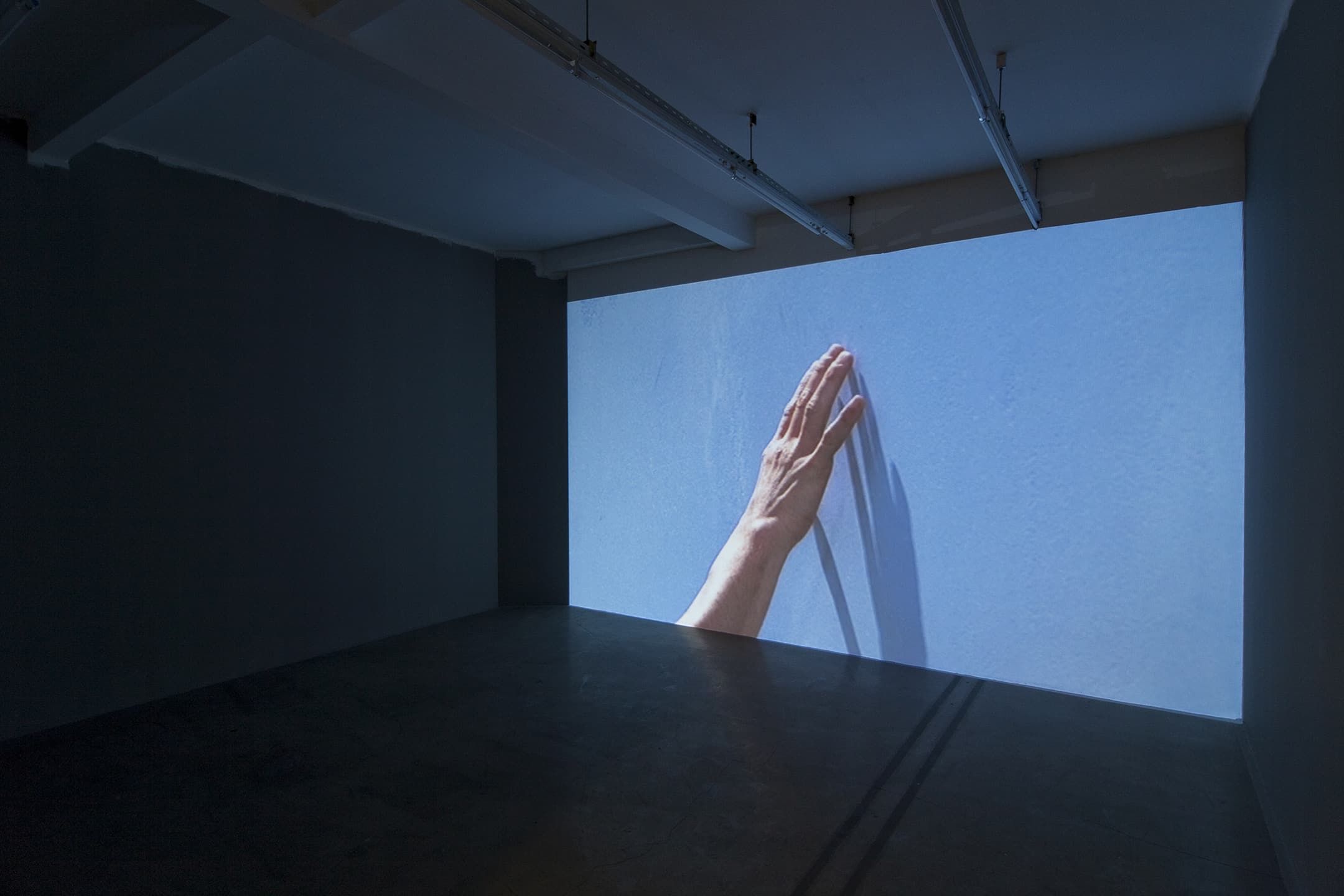
TIME AND IMAGE - IMAGES OF CRISIS
CURATED BY CHRISTINA ANDROULIDAKI
GREEK FILM ARCHIVE MUSEUM
ΙERA ODOS 48 & MEGALOU ALEXANDROU, ATHENS
February 12–March 22, 2015
Artists:
:mentalKLINIK, Rivane Neuenschwander, Richard Whitlock, Manolis Daskalakis-Lemos, Petros Efsthathiadis, Apostolos Zerdevas, Maria Kriara, Jenny Marketou*, Nikos Markou, Yorgos Prinos and the IZOLYATSIA Foundation*
The exhibition focuses on photographic and video works that deal with Crisis as a universal phenomenon seen through the notion of Time. Economic crisis, erosion of civil rights, shortage of natural resources, religious and national fanaticism, social polarization and a more philosophical approach of Crisis as social concept through the work of ten visual artists and groups.
(*) In addition, the second part of the show which will take place between 16-24 of May 2015, shifts the traditional model of presentation of artists-only by expanding and exposing among them a series of documentary films from the interdisciplinary cultural institution Izolyatsia in Ukraine and thus also exploring issues of culture in situations of conflict. In this part five video interviews from Izolyatsia foundation will be screened along with two new projects by Maria Kriara and Jenny Marketou.
The artistic duo :mentalKLINIK from Turkey presents a video projection without sound entitled True Blue (Left). The artists have appropriated the typical scene from the film The Truman Show, where Truman Burbank unwittingly protagonists in a 24-hour show that is filmed by hundreds of cameras and records his life as a reality. :mentalKLINIK’s work focuses in just one point that lasts only a few seconds -when the suspicious Truman has managed to escape by getting into a boat and overcoming his fear of the water he travels away from everything he has known until he falls onto a wall of "sky". Shocked, his hand touches the “sky” only to realize that his entire life was a lie, a false reality, a show taking place on a huge stage. This deeply poetic work by :mentalKLINIK brings us back in an honest and at the same time hard way to Now. Are we always aware of the truth in which we participate? As the character Christof says in the movie when he is asked why he thinks that Truman has never come so close to discover the true nature of his world up to now: "It's just because we have come to accept Reality as it is presented to us."
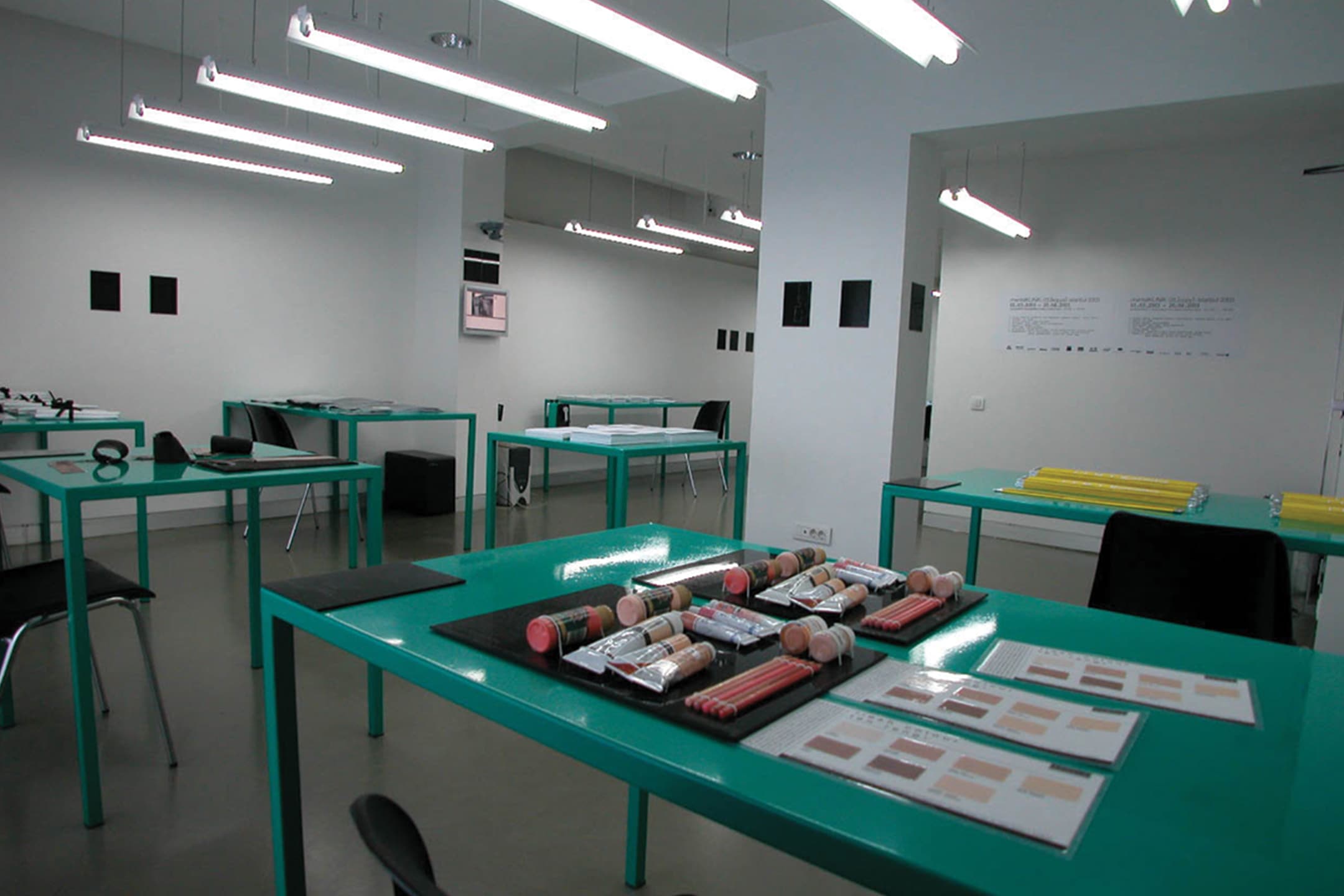
:MENTALKLINIK-03. [COPY]-İSTANBUL2003
COPY-RIGHT / COPY-LEFT
:MENTALKLINIK SPACE
ALİ AKAY, MARCH 2003
Independent Curator / Philosopher
If we consider 'copy', working as a chain of singularity and for today if we agree to Leibniz who claims that every new series will bring forth a new singularity, the thing which is going to be told is to suggest many potentialities, ideas existing before individuality will follow their own proper line and also in every chain of singularity there could be a one-sided individuality. Ideas become current in types and in sections by connecting to this field of individualization. Therefore the types and the sections present us the materials being used while creating a work and the pieces of new inventions. Every kind of material will create the relationships of difference with others; but how will the singularities which are going to constitute the process of individuality work when this material or these forms are copied? If to constitute singularity means to say the differentiation of a series from another series, as at the situation of 'copy' in arts, also the live cells copied by cloning will constitute difference from a series to another series. As the differences between genes and species occur, how will singularity distinguish itself from the other? What will happen when the series of individualities which have the meaning of to constitute a series as much as material problem are copied? Will the same individuality be able to occur? Or will the differences from the copies of the same gene continue reproduction?
We can think of the answers for these questions in an argument which Henri Atlan sets forth. According to Atlan, the nucleus of the cells of adults can be transferred into the enucleated ovule. Thus, in laboratory it is possible to create, in vitro, embryo cells. As these taken ones are put into uterus, a pre-natal or childbirth will not happen. This is not a perfect clonage but it will be the copies made of the origins of the cells. It will be possible to achieve medical progresses by obtaining the tissues and the cell lines genetically same in human being. In that case according to Atlan's declaration in Le Monde (07.01.2002), there is a cloning which is not similar to create 'Dolly' and this is ethically correct as well. This is a process which belongs to body more than cloned mammals should be called as the somatic nucleus transfer. Genetically it is possible to do researches which will be able to cure the ailments of the patients. The tissues or the cell lines taken from the origin cells and planted will be able to be realized on human being.
In that case cloning is not only the creating of human being or animal, but also it will be the name of a process which will be good for being realized of processes which will provide the possibilities of re-birth of illnesses and disappeared cells due to the changing of a tissue. That means we are talking about a new evaluation period. This will have a similar structure to the medical re-evaluation of the human replacing God. This also means that we are coming closer to what Nietzsche meant when he said that with the death of God the human figure also must disappear and that we are beginning to enter a new type of evaluation which is inhuman with the cyborg culture.
This human is rather than a nihilist Dostoyevskian suicide human, interested in the world of Nietzsche which mixes with Dostoyevsky a lot. Being copied, in that context is not a nihilism; but it will be the name of the culture of creating a new value. The subject under discussion is the changing of only "cyborg culture" and as Gilles Deleuze has suggested before is the changing of power relationships of human being. Now the thing being talked of is that the resultant of human being and human being consisting of the power relationships of 19th and 20th centuries with machines. It is neither a fiction; nor an utopia which belongs to the future. The only thing which is discussed is nothing than a breaking of human, called as the last pasteur by Nietzsche with the ethics of new values.
This ethical breaking has carried the technological reflection of the community culture of 1968 with itself. At the beginning of the year of 1970, when Richard Stallman have started his career at the laboratory of artificial intelligence at MIT, he encounters with the problem an indecipherable software code. Like all hackers he complains not to figure out a source code of Xerox, as well and when he wanted this source code from a researcher friend of him; the copyright agreement which had been made with Xenox furiates Stallman. He develops a new free software for the community by leaving laboratory: a new agreement called GNU becomes the founding of the Free Software Foundation in October 1985. In conclusion, the copy-left system is opposed the copyright system and by being involved to the free circulation of the source code, it is put forward the right of using and even the right of modification and distribution, as long as everyone lets this source code. This corresponds to a re-modified organizing as a part of the new formation of the new economy of the flexible capitalism and by deterritorializing the source code.*
Cloning interests in pharmacology as much as bio-genetic. Recently, as the turning towards of disappearing of Africa by being destroyed with AIDS, the number of destroyed people because of AIDS has been increasing. Without accepting the patent rights of the international pharmaceutical companies, drugs with a new anti-copyright movement, South Africa is producing cheap medicine and providing these to the destroyed people. In this situation because of the rights of property and patent, the international companies try to send South Africa to the court and to make this an international case. As Richard Stallman calls our attention, here the "bio-piracy" stands like an alternative approach. However as the writer mentions, the issue of "giving rights" is instead of restricting the existence of the biological monopolies in the new situation of capitalism which it becomes different now, it makes new rights to appear. The "bio-pirate" approach means to give and to deliver some rights of the pharmaceutical firms and bio-technological companies under the monopoly of trans-national capital to other people but in the same time in reply of the genes taken from the people and the plants of the south and east countries containing gene differences, it requires these bio-technology companies to pay back.** In this meaning copy corresponds to a musical, visual and a plastic value transformation. This transformations relevant to the environment which is the product of our humane environment design. Therefore to be re-evaluated will certainly serve a new possibility of analysis to the transformation of the capitalistic world.
*In the 90s, a Finnish researcher Linus Torvalds establishes Linux system. This corresponds to the period of internet distribution and usage. In this distribution, the importance of internet and free software has appeared. Thanks to this, the users and the transformaters start to become widespread to the international area and all the occupations. This free distribution was like the discussion of public property and private property which are discussed at the end of the 18th century mid 19th. While the system in 1793, which Condecet and Siyes were developed in France, recognized the rights of the author as the property right. It also aimed to control, who the authors of erotical and pornographic novels are. The making of an issue of a copyright to prevent the prohibited books conveyed by the junkmen to the people, which is also known as Colportage literature corresponds to the system, which Foucault called "bio-political", and envisaged as "discipline society" before.
**R. Stallman, "Biopirates ou biocorsaire?" Multitude, No:1 2000. Here, Stallman talks about the truth of non-presence of the different characters of genes everywhere.
curator: yasemin baydar, birol demir
editor: ali akay
participants: yazbukey, aziz sarıyer, derin sarıyer, eren pultar, ayşe erkmen, murat avcı,
giray pultar, ufuk kayserilioğlu, emi kayserilioğlu, mehmet irdel, ozan adam, gülizar çepeoğlu,
aysun pelvan, dilek winchester, aykut erdoğan, ethem özgüven, emre doğru, yasemin baydar, birol demir
assistants: kerem akıllıoğlu, kerem sürmelihindi, nusret polat
supported by: wall, netone, sony, mimeray, jotun, first, stil matbaacılık, timeout, 2M,
kuşak, sbs, beydur, açık radyo, bağlan, budun, trendsetter, barın
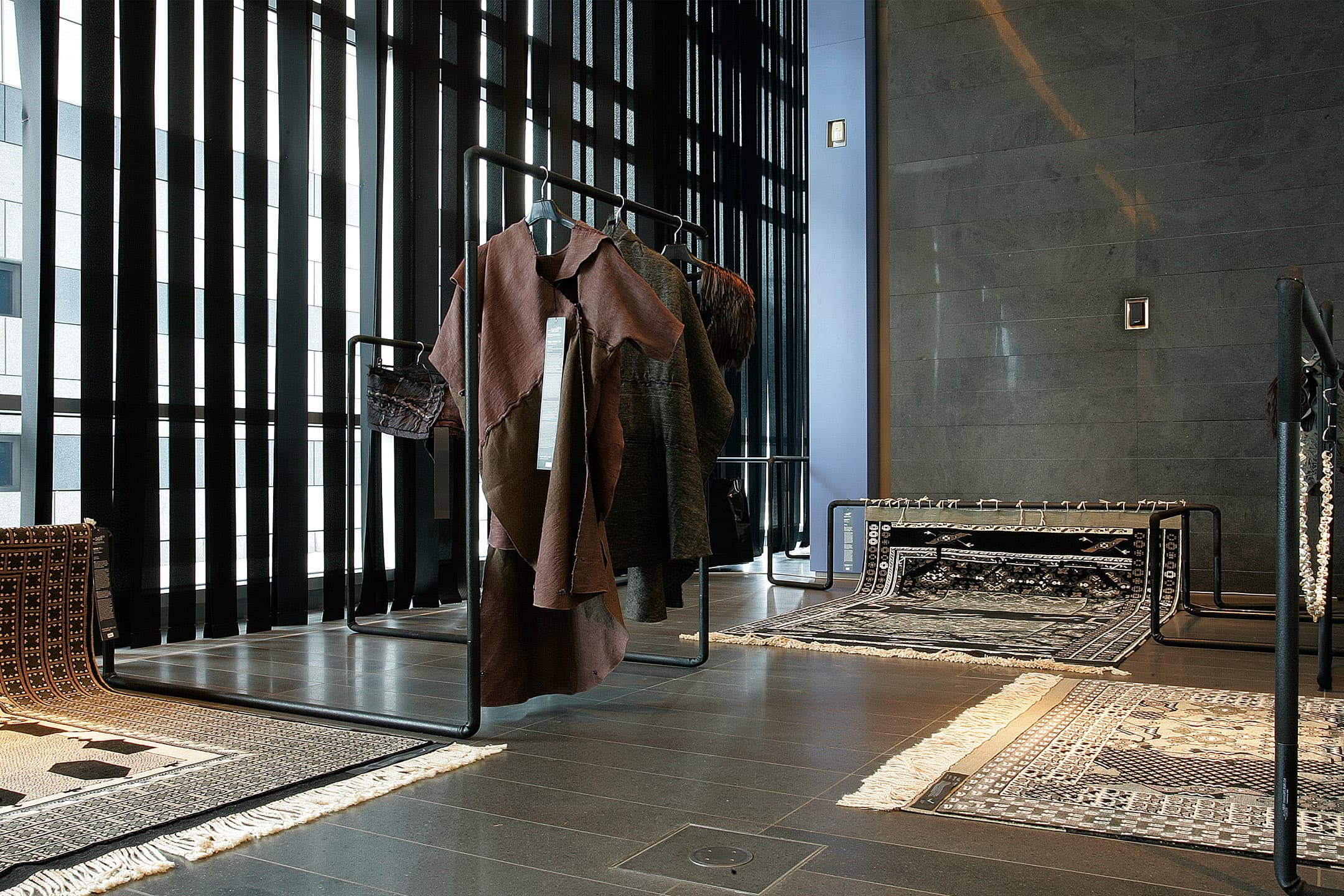
:MENTALKLINIK-04.~SELF 01-LUXEMBOURG2004
MUDAM, MUSÉE D'ART MODERNE GRAND-DUC JEAN
Director of MUDAM, Musée d'art Moderne Grand-Duc Jean: Marie-Claude Beaud
Curators: Yasemin Baydar, Birol Demir Editors: Birhan Keskin, Tül Akbal Süalp
Editorial Support: Olcay Akyıldız, Özen Yula, Ayla Kanbur
Project Assistant: Eren Pultar
Participants: zehra uçar, dilek aksu, ayşe erkmen, gökhan kırdar, engin akın, yasmin iris yağlıyan rostomyan,
tanju özelgin, yasemin baydar, birol demir, maksut aşkar, ahmet elhan, birhan keskin, tül akbal süalp, özen yula
thanks to vasıf kortun, nurcan özaslan, nuran terzioðlu, kaan hanoğlu, berna atila, buket baydar, levent morgök, meral alla, arife şengül,
emrah cengiz, laden yurttagüler, yasemin özcan kaya, protein consultancy co., kobra kauçuk/ hüsnü çep, beydur/hasan koçak, saridan/ necati sezgin,
parkyeri/giray pultar, murat avcı, ofset yapımevi, sermet tolan, cafer aktaş, natura/kemal topal, anadolu cam
~self 01 is a project proposed by :mentalKLINIK for MUDAM Camp De Base, in partnership with Banque de Luxembourg, Supported by CargoLux
a shadowy and undefined, aorist present
Does the "self" have a firm footing? What about "nefs" 1 and "kendi" 2? Don't we use "I" and "the other", "here" and "there" to tell stories? For doesn't the world need, since eternity, a history to be written, and doesn't history need all sorts of stories? And in the final analysis, what are all these but consolations for "being here"? What is the likelihood of "kendi" not being something like the journal of a madman who continuously whispers things from within an "aorist present" and then falls silent, because s/he is just like the universe itself - expanding, containing everything, contracting, shriveling and emptying itself out; an amorphous something whose contents can and do change.
Taking into consideration the overuse and depletion of the concept of "self", both at the level of the arts and in academic discourses, and also cognizant of the threat posed by the fact that this concept is easily inflatable, we planned a gusty voyage to the centre of this concept, at times using byways. Because we believe the world is a place that makes up and tells stories, it wasn't hard for us to combine the concept of "self" with the concept of "voyage".
The modern age has dodged wo/man. With all his/her torn knots dangling in the void, like a string pulled from a wholesome plait, like a stalk, the individual has turned into a dry and cardboard-like object, especially after the advent of psychoanalysis. Devoid of all contexts and underpinnings, this anxious single individual needs a light that will fall on him/her and bring him/her back to life. A light that will darken and deepen its shadows. We believe that this light will shine from a certain place or location, from memory; in other words, from a story. The possible routes, then, are plain to see: it is necessary to sail to certain places and come back from this crusade with experiences that will fill one's being and give it meaning. That way, today's single individual, vacuumed more than ever into an anxiety for the future, will be able to breathe in an "aorist present". And weave his/her own fabric anew in ample time. If, after all the time that has passed since that audacious voice first claimed "I is another"3, I is still another, we still stand a chance for real communication and a sense of justice. And hence, there is still a possibility to keep "hope" for wo/man. :mentalKLİNİK knows that in the streets of life, every soul feels a chill and shivers a little. It knows even better that the soul feels even colder if the wind of the place and the times one lives in is somewhat strong. "This place" is a wide area of myths. As always, we have assumed a stance "from the inside", a "sincere" stance, under a subject heading like "self".
1 "nefs: noun. 1. self, one's own personality. 2. the essence of anything, its very substance or reality. 3. seminal fluid. 4. soul; spirit; life.
5. the carnal man, the flesh, the spirit of concupiscence." New Redhouse Turkish English Dictionary, Redhouse Press, İstanbul, 1979.
2 "kendi: personal pronoun. oneself; self; own." New Redhouse Turkish English Dictionary, Redhouse
Press, İstanbul, 1979. kendi: 1.essential being. 2. pronoun used in a sentence to emphasize the subject. 3. pronoun used to imply there is no i
nfluence of anything/one else in an action or occurrence. 4. belonging to oneself, personal. Translated from Temel Türkçe Sözlük
(Basic Turkish Dictionary), İnkılap Publishing, 1985.
3 "Je est un autre", Arthur Rimbaud.
:mentalKLINIK defined self01, as an encounter with the dangerous images of a blurred culture, in a undefined world. :mentalKLINIK, with this interlayer called ExpoVente, provided an opportunity for the beholders from Luxembourg, to experience one of prototype states. Works/products, produced with participants, were inspired by its excursions on culture layers, by expanding the time upon its standing geography. :mentalKLINIK, with.~self 01 built a new language by making a far-from-authenticity transformation possible, with changing production consciousness and productions that 21st century’s still-hand making production.
The ~self Experience
Doesn’t the moment of finding one’s self coincide exactly with the moment of losing it?
When :mentalKLINIK embarked on the voyage that was the .~self 01 we sort of assumed there was a multi-layered, multi-lingual structure in the horizon, and that this structure was surrounded by fog. The self was a structure you could fill up and empty out and rebuild; it was made up of numerous smaller parts. We marked this structure with some headings that suited our spirit and with some concepts that we thought were relevant to the self; we designated the course of the self as journeys of varying length between these points.
The .~self 01 had light and darkness, it contained opposites, it hid and covered itself, it had proclivities and stances, it could be dressed up and changed but never be owned or assimilated. It had a certain gravity, it belonged to time and space, and yet it always stood in a threshold. It was in some sort of transit, passing from one state to another, and it was multifarious. For us, then, the self was a “shadowy and undefined, aorist present.”
Thus, we and the participants in this project began a new voyage of “construction”, once again inviting in the soul that had long been absent from its self (having escaped from the inside), traveling in the temporarily frozen moments of time and space, and pointing out the things that struck our eyes during this voyage - sometimes less, sometimes more.
In this project we also wanted to see the results to be obtained from various stances/states of being, such as standing alone, being only itself and nothing else, standing side by side with another, contradicting each other, minding its own business, etc. We hoped this would lead each “self” to be a part of a greater whole with other “selves” for a number of times, and to come up with its own work/experience for this project. We felt throughout the voyage that we were heading towards a self that was unadorned, scarred, modest, and moody; that we would weave it and that, in the end, all roads would always lead to it. At some stops we tried to bring it out into the open; at others, we tried to cover it up. That way identity, the structure which is perpetually constructed and torn down, always incomplete and with winds blowing through it, would show us itself, with all its shadows and darkness.
At the end of the voyage very different works emerged, belonging to very different “insides” and experiences: thick, solid, and plain experiences and works that could be neighbors with each other - we could call them the color of the shadow, the shadow itself, the states of an object, the present of memory, the plural of the singular, the product of geography, the body itself, the memory of experience or the like...
The exhibition of the .~self 01 was inspired by the experience of “weaving the self”, and thus it used techniques like wrapping, knitting, and covering to create a space that allowed one to stand beside, in front of, behind, above, and under.
WORKS OF ~self 01
BELLEK, 2004 (DETAIL)
Yasemin Baydar, Birol Demir
100% Wool, Handwoven Carpet
birol demir created this project, based on the idea that the memory of every location and experience has certain layers that come to the forefront, while others are erased or pushed deep down, thus turning memory into a language that is occasionally faint and pale; that in time, memory may approach indefiniteness. birol demir and yasemin baydar formed comparative couples of sixteenth century carpets made in the aegean and inner anatolian regions, re-designing and re-coloring them. these carpets were hand-made with wool on wool by eighteen women from the aksaray region, preserving their own signs of feeling and experience; the carpets came in three sizes - prayer rug, bed cover, and floor cover.
REVNAK, 2004
Tanju Özelgin
illumination
goatskin stretched on aluminum
carcass and 36-zone led lighting
placed on the inside
based on the idea that each being rests on constant mutability, which is shrouded in light and darkness, and forms secrets and shadows, this work was created by tanju özelgin in such a way that it would create different shadows and lights each time it is turned on and off. goatskin stretched on aluminum carcass and 36-zone led lighting placed on the inside of the carcass were used to cast abstract and changing shadows on the back of the goatskin.
KALABALIK
Yasemin Baydar
Cap, Artificial Hair
hair, one of the strongest physical aspects of wo/man, one that is as familiar and customary as it is foreign and savage, crowded and massive, provides the point of departure for this project by yasemin baydar; it is based on the transformation of an image, both continuous and alterable, into a wearable product. it was made with fibrous material and unfinished wigs, sexless and discorporate; it was cut by keeping in mind others may like to remodel it, and was actually tried on a number of people before being modelled. birhan keskin entitled these products as “kalabalık”.
KOYU KIVAM
project yasemin baydar, birol demir, dilek aksu
Garment
yasemin baydar and birol demir constructed this work, and together with dilek aksu they gave it its final form based on the idea of looking at the memory of an age from the present, and moving between the "frozen" creases of the past and a vast region. the products were shaped using the simplest connection details in textiles, such as joining, extending, and attaching; the inspiration for the models came from the everyday clothes of the 1800s. the garments were designed to be sexless and discorporate, suitable to be fitted on all bodies according to one's wish. the fabrics for the garments, specially handmade (silk+silk, silk+wool, silk+linen), were produced by dilek aksu in birgi, izmir. the products were entitled "koyu kıvam" after a poem by birhan keskin.
INŞAAT
Yasmin İris Yağlıyan Rostomyan
Body Attachment-Garment
100% Black Polyester Yarn
On Cotton And Wool Fabric
this work was designed by yasmin iris yağlıyan rostomyan, so that it would create a spine for the fabric, providing different creases, different silhouettes, and a continual change of shape. the idea behind the project was to create a sexless and discorporate body accessory, not a dress, that would be constructed on the body itself, changing shape according to each body. for a start that would be as sexless and discorporate as possible, this work was produced by using a maximum 5 models, and a 100% black polyester yarn on cotton and wool fabric, chosen in three different but almost colorless tones.
RING
Ayse Erkmen
Ring chain
Silver
selected by ayşe erkmen from the archives of raffi şadyan and levon şadyan, these 25 different ring molds were reproduced as molds using 950 silver, which were then used in making rings. these rings in turn were made into a connected but detachable, single chain. the idea was that taken separately, the parts of this sexless and discorporate chain could be used as rings, bracelets, anklets, necklaces or belts; or, when used as a whole, it could serve as a separator of spaces, or could be used as an extension to individuals or spaces. this work is entitled “ring” by ayşe erkmen.
HAL
Yasemin Baydar, Birol Demir
Blinds
Hardened Handwoven
White Cotton Lace
the idea behind the design of this curtain was to be able to create shadow zones changing with the light that falls on it, to belong to both inside and outside, and to create transitions. nine women separately worked in gönen and istanbul with white cotton lace threads to produce it. the patterns were prepared using the archives of yasemin baydar, zehra uçar and sıdıka öymen. yasemin baydar entitled these products as “hâl.”
KÖK
Maksut Aşkar
Alternative Energy Drink
Galingale, Licorice Root,
Ginger, Bitter Melon
(Momordica Charantia), Honey,
Cardamom, Nutmeg (Myristica),
Saffron And Dried Rose Petals
this work was designed by maksut aşkar, based on the idea that a healing power might emerge when matching earthly beings approach each other, melt into each other, when roots meet and another whole is produced. This alternative drink contains galingale, licorice root, ginger, bitter melon (momordica charantia), honey, cardamom, nutmeg (myristica), saffron and dried rose petals; it boosts the immune system and has aphrodisiac effects; its creator called it “kök”.
MAMUL
Engin Akın
Sweet Food
Syrup Made From Grapes
İn Seven Different States,
Ranging From Liquid To Solid
the idea behind this project was to combine the base material with “other” materials, to let them mingle with and transform each other. engin akın used “pekmez”, a syrup made from grapes and consumed widely in turkey, creating seven different states of it, ranging from liquid to solid. in each state she used pekmez as the base material and added spices, flour, starch, dried fruits, fragrant herbs and various aromas. five women and a man used engin akın’s recipes and methods to produce seven different mixtures, all based on pekmez, in various parts of turkey (denizli/yenice, muğla/ula, kahramanmaraş, istanbul). engin akın entitled these as “mamul”.
MUKARNAS
Zehra Uçar
Corner Attachment
Silver
architect zehra uçar created this project based on the idea that one needs to show love and care for surfaces of interiors as well as their points of intersection. she chose certain situations that posed no problems of geometrical structure, and created these corner attachments using 925 silver, designed especially for repeated dismantling and affixing on the outer corners. zehra uçar entitled these attachments as “mukarnas”.
WANTING BOOK ODD NOTEBOOK,
Birhan Keskin, Özen Yula, Tül Akbal Süalp
Book Design: :mentalKLINIK
MUDAM, Luxembourg,
ISBN: 9758614029
(Turkish-French-English)
268 Pages,1000 Copies
this book, which could be described as an attempted journey into the foggy life of a woman character called “lamia” by özen yula, was written jointly and simultaneously by three writers (a playwright, a poet, and an academic). entitled by birhan keskin as “eksik kitap tuhaf defter”, this book is based on the idea that wo/man is a memory passing through the world and that this memory loses its realness with time, becomes old, and turns into a myth; it focuses on the assumption that wo/man is a “project” never to be completed.
CONTENTS
Project and Design: :mentalKLINIK,
Photography: Ahmet Elhan
Editor:Tül Akbal Süalp
Research: Eren Pultar
Book: MUDAM, Luxembourg,
ISBN: 9758614037
(Turkish-French-English)
101 Pages,1000 Copies
“contents” is a project created by yasemin baydar and birol demir, based on the idea that it ought to be a shadow that records all the states and the whole voyage of the ~self project. the selection was made among thousands of photographs taken by ahmet elhan since 1977, which marks the beginning of his career as a photographer. this selection is enveloped by the works of yasemin baydar, birol demir, and tül akbal süalp - works mapping out the states of people in everyday life from the outside. this book, which could be described as an attempted journey into the foggy life of a woman character called “lamia” by özen yula, was written jointly and simultaneously by three writers (a playwright, a poet, and an academic). entitled by birhan keskin as “eksik kitap tuhaf defter”,
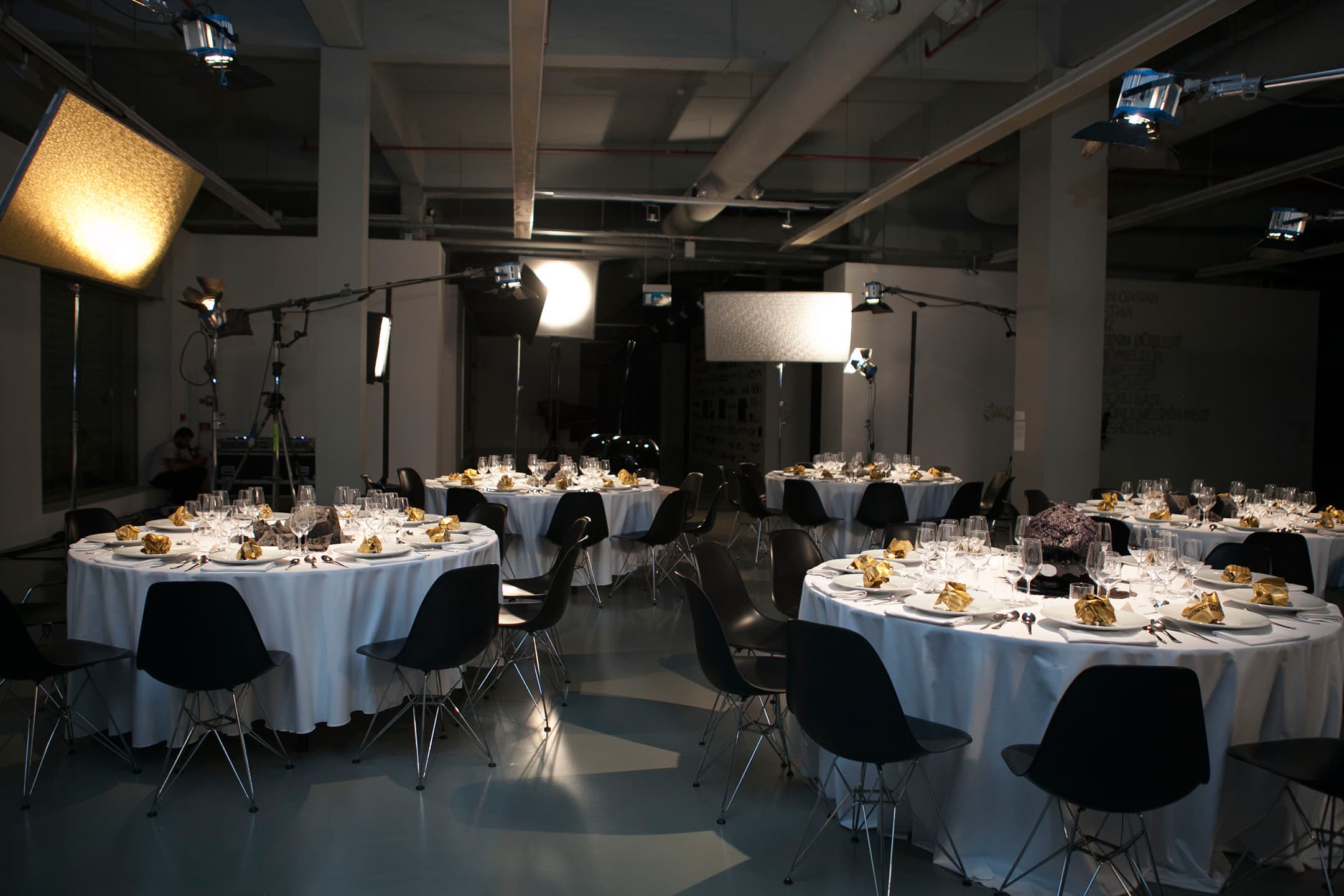
MAGMAONTHEMOUNTAIN
İSTANBUL MODERN
PERFORMATIVE DINNER: DINNER WITH SPOONS
AS AN INTERVIEW BETWEEN :MENTALKLINIK AND CHEF İSKENDER EROCAK APRIL 1ST, 2013
Using different disciplines as a playground, :mentalKLINIK creates a new trans-disciplinary language of art and new dialogues. The artist duo strategically examine the concepts of show business and of time in their performances. Familiar experiences pull the audience into a fictional environment under cinematic lights.
MAGMAONTHEMOUNTAIN that examines banqueting, food culture and the socializing that takes place around it was realized in Istanbul Modern as an experience private to 50 people. These tastes that were recommended to be eaten by 5 different spoons were relayed by means of adjectives
and concepts under the headings of ‘color, texture, smell, sound, style and feeling’ defined by :mentalKLINIK to the chef İskender Erocak. A dialogue was created in which the Chef elaborated his approach to food in reply to the vocabularies designed as a question.
The ritual of the banquet was realized as a real-time performance around a motorcycle helmet and pieces of candle amassed on the table like absurd rock pieces and under cinematic lights like a scene from Luis Buñuel’’s film ‘The Discreet Charm Of The Bourgeoisie’, accompanied by music prepared particularly for the night.
Atmosphere_Ultra Light
Taste: Bittersweet, Fragrant Colour: Pastel/Pale: Bluish/Pinkish/Yellowish, Structure: Fondant, Spumy
Feeling: Airy Sound: Whispering, Gentle Style: Cloudy, Delightful
Space_Light
Taste: Perfumed, Unsalted, Colour: Black With Gold Glitters, Structure: Jelly, Smooth, Glazed
Feeling: Wet Sound: Jingling, Juicy, Style: Sparkling, Charming, Cool
Sea_Medium
Taste: Briny, Sour Colour: Vernal Colours Structure: Crispy, Explosive
Feeling: Fresh, Edgy Sound: Crisp, Grainy Style: Excited, Lively, Rich
Earth_Heavy
Taste: Savory, Smoky, Peppery, Fiery Colour: Darker, Deeper, Fall Colours
Structure: Woody, Fleshy Feeling: Robust, Lusty Sound: Plummy, Rotund, Deep
Style: Powerful, Brave, Outstanding
Heaven_Surprise
Taste: Caramelize, Colour: Bright, Flashy with Gold Leaves
Structure: Slippery Feeling: Crazy Sound: Plop Style: Funky
Hosted by İstanbul Modern & Galerist
Thanks to Levent Çalıkoğlu
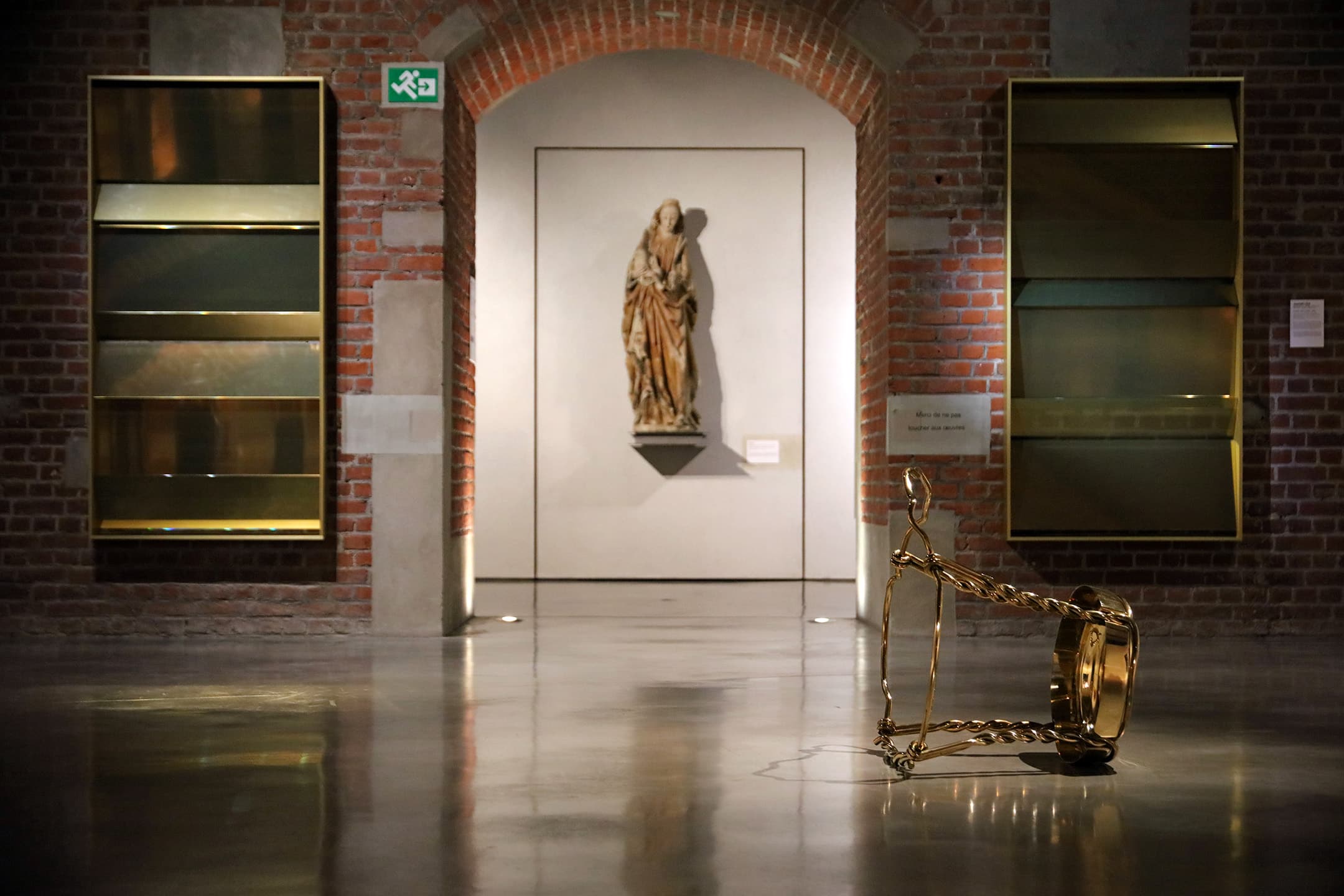
GOLDEN ROOM
CURATED BY JEROME SANS, JEAN – MAX COLARD AND ISABELLE BERNINI,
PALAIS DES BEAUX-ARTS, LILLE
APRIL 27, 2019 – SEPTEMBER 01, 2019
The Golden Room, a treasure chamber or Ali Baba’s cavern : It’s the mythical place sought by all the gold seekers, by all the Eldorados. A marvelous space, monochromatic, where everything is gold, floor to ceiling, with a shimmery heap of golden objects, in an anachronistic blend of all eras and of all civilizations, on through the most contemporary.
During Eldorado, the new cultural season of lille3000, the exhibitions curators Jérôme Sans and Jean-Max Colard, offer to some artists to invest the “undergrounds” room od the Palais des Beaux-Arts of Lille where the permanent collections of the museum, spanning Antiquity, the Middle Ages and the Renaissance, are housed and exhibited. Like a treasure hunt without rules or order, artists develop the possible chapters of a history as universal as it is turbulent, in which their work resonates with pieces in the collections that are inlaid with gold. In this exhibition the quest to find treasure, a metaphor for the thirst for power, takes the form of a rite of passage, but also of a reversal of values.
Gold, the ultimate representation of wealth and success, is both coveted and decried. This glorious, sacred metal is also the symbol of luxury, the only absolute and stable value. Thomas Lélu’s piece makes reference to this fact, ironically proclaiming In Gold we trust to subvert the national motto of the United States (In God we trust), stamped on all American bank notes and coins, into a capitalist slogan.
Olga de Amaral’s textiles diffuse the vibration of gold in space: scintillating in the light they bring to mind pre- Columbian gold artefacts and the historical fantasy of Eldorado. As for the works of :mentalKLINIK, they play precisely on the universal attraction of sparkling and seductive objects, encrypting true and false, the fake and the supeficial, as if everything were a matter of falsification.
Gold is beyond doubt the choice material of this long history of false appearances. It is revisited by Laurent Grasso who, in the manner of a historian of images, creates a “false historical memory” in his paintings, juxtaposing pictorial references borrowed from various periods with climatic phenomena that border on fiction, even on the paranormal. Also troubling our perception, the golden backgrounds of the religious icons in the collections give way to the golden sheen of the survival blankets that cover the walls in Mircea Cantor’s installation Heaven and Hell simultaneously. When confronted by the paradoxical colour of this object commonly cast as a mantle over extreme poverty, we are suddenly reminded of the injustice that characterises the reality of the contemporary world. Like a double agent, the golden colour transforms hell into a dream and vice versa. Thus, while this gallery of wonders sparkles with a thousand golden reflections, it is also tinged with darkness. For it is true that Eldorados are conquered through violence and the plundering of peoples and cultures, in which the lust for wealth also contributes to the collapse of beliefs and ideologies, as addressed in Kendell Geers’ abrasive works.
What if this Golden Room was never more than a cave for thieves and looters? Under the gold leaves, this series of objects in which real and imitation gold combine could readily appear to us as an economic and cultural mirage, a space of illusion or vanity. Or as the already ruined remnant of so many civilizations that have been lost in the quest for prosperity.
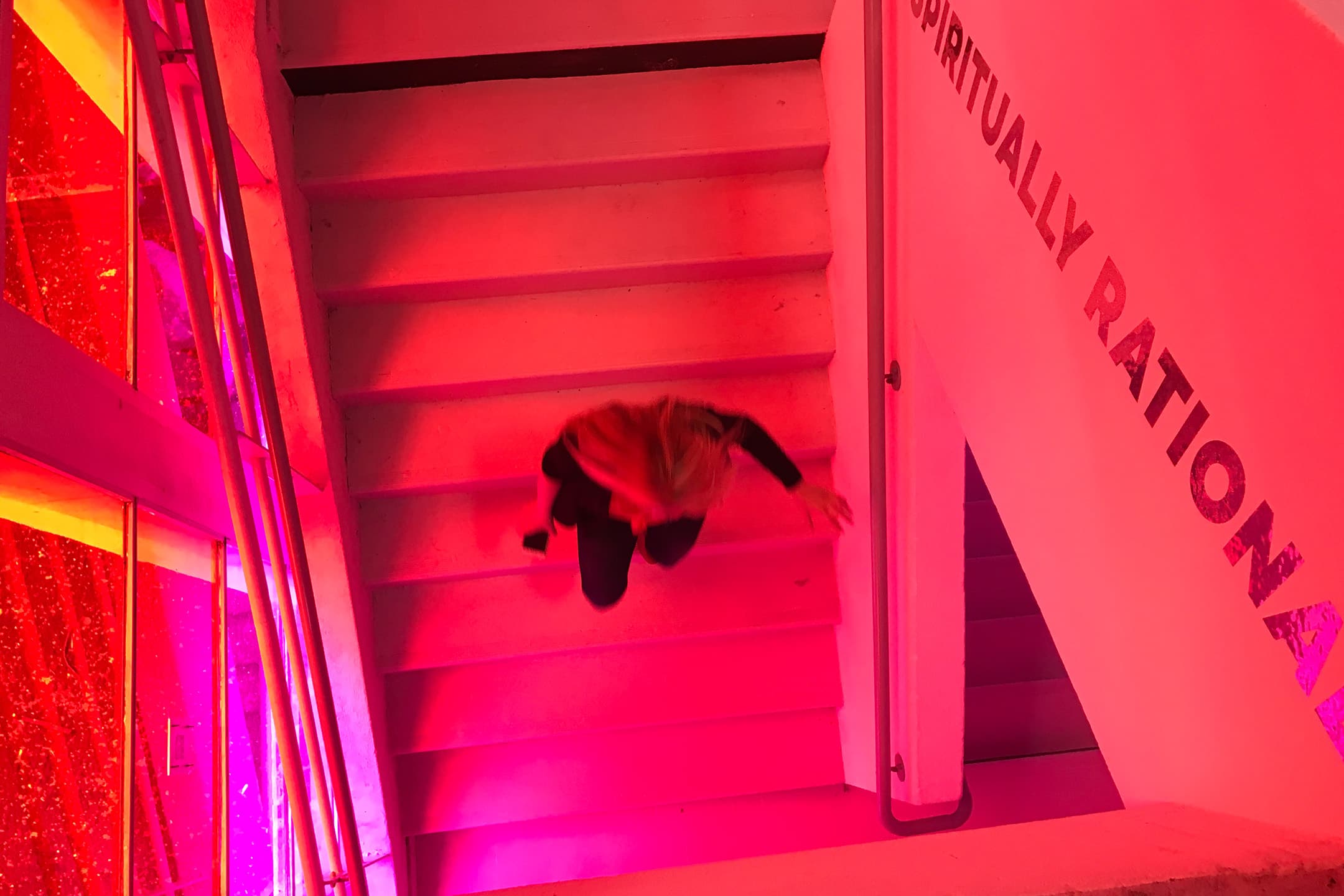
ELDORAMA,
CURATED BY JEROME SANS, JEAN–MAX COLARD & ISABELLE BERNINI TRIPOSTAL, LILLE 3000
APRIL 27, 2019 – SEPTEMBER 01, 2019
The flagship of lille3000, the Tripostal unfolds the great story of Eldorado through a myriad of contemporary works of art borrowed from the four corners of the globe, with more than 40 artists on display. It divides into three chapters, one for each of the building’s three floors: Dream Worlds, The Rush, The New Eldorados.
Artists: :mentalKLINIK, Martine Aballéa, Adel Abdessemed, Abdelkader Benchamma, Francis Alÿs, Korakrit Arunanondchai, Babi Badalov, Jules de Balincourt, Gilles Barbier, Romain Bernini, Hicham Berrada, Stefan Brüggemann, Cao Fei, Till Gerhard, Rodney Graham, Ren Hang, Duane Hanson, Laura Henno, Alfredo Jaar, Mike Kelley, Maria Kourkouta, Christopher Kulendran Thomas, Yayoi Kusama, Ibrahim Mahama, Teresa Margolles, Ryan McGinley, :mentalKLINIK, Jonathan Monk, Lucy + Jorge Orta, Anne et Patrick Poirier, Younès Rahmoun, Peter Stämpfli, Superflex, Claire Tabouret, Thukral & Tagra, Anna Uddenberg, Wang Wei, Marnie Weber, Hank Willis Thomas, Liu Xiaodong, Yuyang Wang, Chen Zhen, Qiu Zhijie.
HOT DEALS, 2019
:mentallKLINIK founded their multimedia and conceptual laboratory -in equal parts vintage and high-tech- in Istanbul and for the last three years have been developing it in Brussels. Through their playful but also abrasive vocabulary, the duo constantly plays with glamorous, rock and post punk references. :mentalKLINIK repurposes the sparkling and authoritative visual language of nocturnal spheres in a climate of sensory hyperstimulation generated by the multiple neon lights, slogans, light beams, disco balls and confetti that compose their works, tapping into our unanimous attraction for sparkling and seductive objects.
TROUBLED PARADISE, 2019
The :mentalKLINIK duo invades the staircase, bathing it in a pink and red atmosphere thanks to filters placed on the windows of the facade. The rising intensity of the colourful atmosphere accompanies the rise of the overall scenario of the exhibition, divided into three chapters (Dream Worlds/The Rush/Endless Eldorado). The walls are decorated with three slogans, oxymorons printed on glittery stickers, an ephemeral and low cost material associated with the entertainment business. Language is a vocabulary of their aesthetics that they constantly abuse to blur perceptions and create new spaces and new meanings. These expressions naturally result from the :mentalKLINIK’s reflection on the rhythm of the exhibition, evoking the frantic and universal quest for happiness.
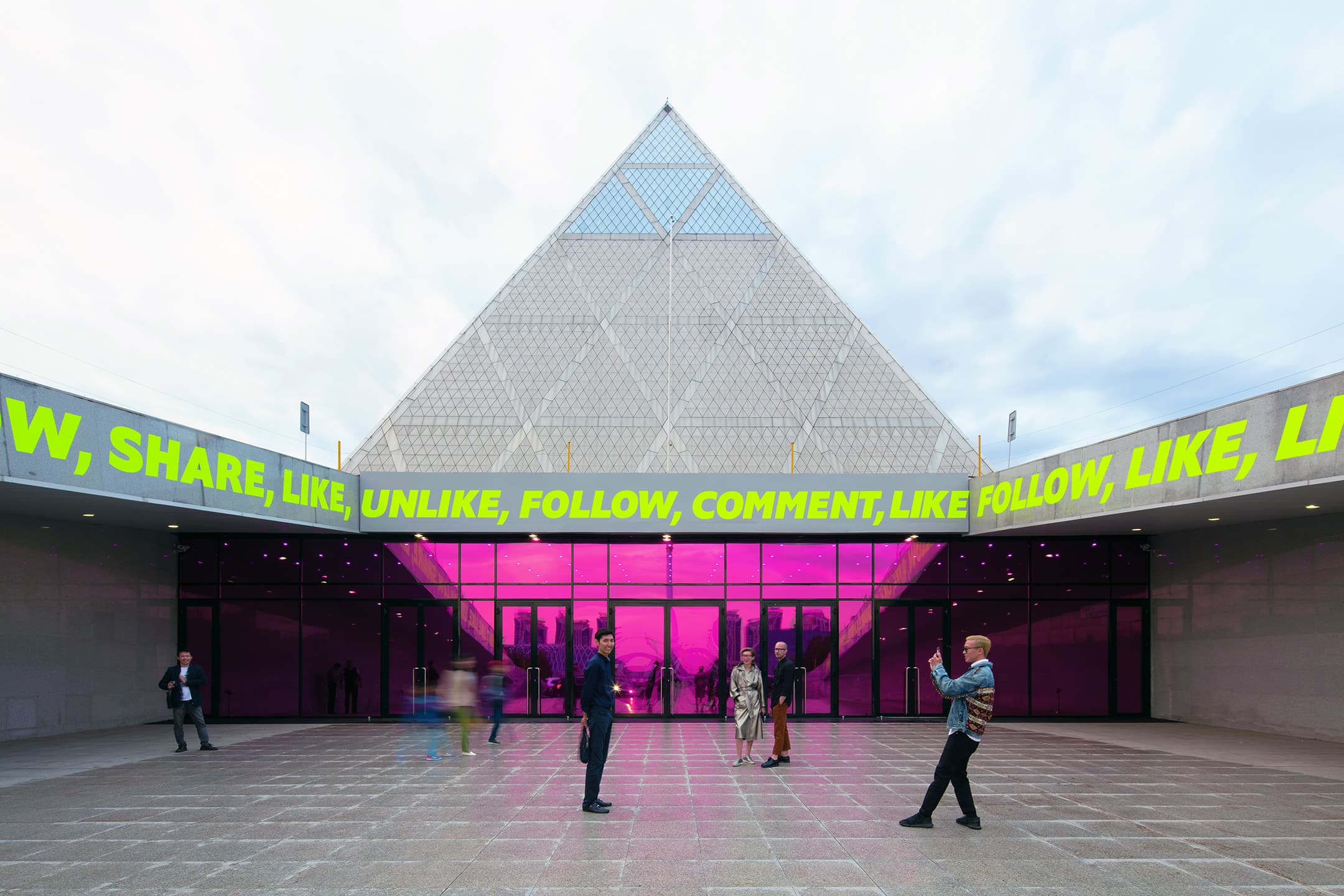
RACING THE GALAXY, ASTANA ART SHOW
CURATED BY JEROME SANS & DINA BAITASSOVA
ASTANA, 2019
JULY 03, 2019 – AUGUST 10, 2019
RACING THE GALAXY is the very first international exhibition in Kazakhstan, bringing together around 20 artists from 15 countries, enriching each other and creating a new intercultural dialogue. The exhibition convenes all artistic mediums to emphasize the impermanence of social, political, economic and aesthetics rules, reflecting on transitions, displacements and mingling, as an echo of the heterogeneous culture of Kazakhstan which is currently experiencing a period of total reinvention and unbridled creativity.
The word “Kazakh” appeared in the thirteenth century in a Turkish-Arab dictionary to signify the “free man”, the “wanderer” (nomad) or the “exiled”. The “Kazakh” meant a free individual who had left his people for freedom. The spirit of nomadism and freedom shared by these artists is the guiding thread of the exhibition which aims to raise awareness on the dissonances of a changing world and its contemporary mirages.
RACING THE GALAXY deals with the gradual dissolution of dichotomies between East and West, in the era of global communication and the confrontation and melting of cultures, referencing the idea that artistic forms travel, mingle and enrich each other, from one continent to another. Dislocation is the event that affects contemporary space. Nothing is independent, nothing is fixed. Dispersal movements, displacements become a way of thinking. Built around the concepts of instability, change and mutation, RACING THE GALAXY brings together experiences, territories, continents and people. It constantly reveals the ambivalence of migrating artists and motionless travellers, always taken between different states, different positions. The exhibition embodies the plurality of the contemporary artistic scene facing the new challenges of our contemporary world such as globalization, multiculturalism, identity, gender, minorities, the quest for the future, the instability of perception and preconceived ideas as well as the appropriation of history.
:mentalKLINIK, Aika Akhmetova, Almagul Menlibayeva, Ange Leccia, Anvar Musrepov, Askhat Akhmediyarov, Aziza Shadenova, Babi Badalov, Carlos Cruz-Diez, Choi Jeong Hwa, Dagoberto Rodriguez, Gulnur Mukazhanova, Joel Andrianomearisoa, Leandro Erlich, Michelangelo Pistoletto, Mircea Cantor,Thukral & Tagra, Vajiko Chachkhiani, Wang Du, Wang Yuyang
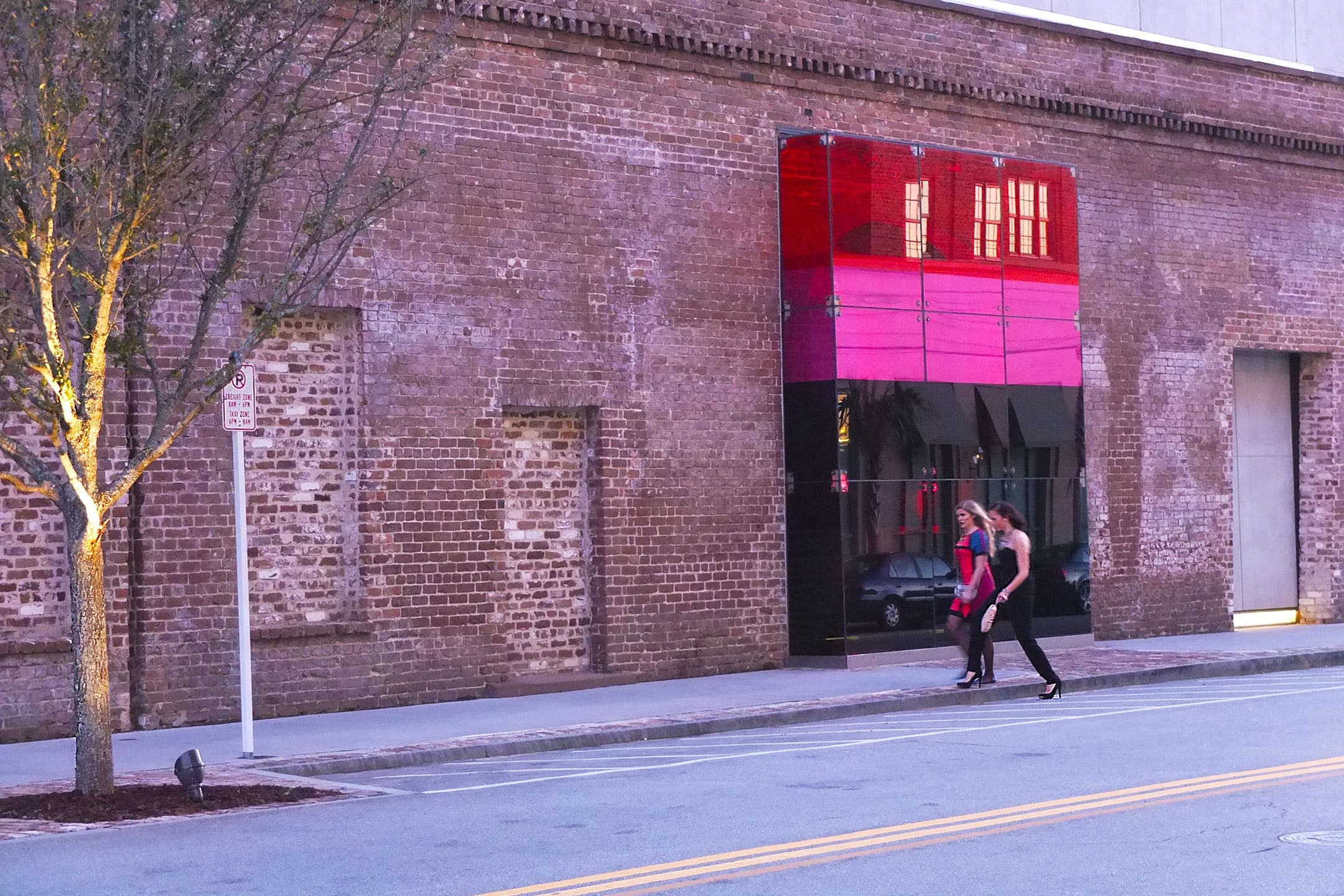
CO-OPERATION WOULD BE HIGHLY APPRECIATED
CURATED BY STORM JANSE VAN RENSBURG
THE SCAD MUSEUM OF ART, DEFINE ART, 2015
FEBRUARY 04, 2015 – MAY 03, 2015
:mentalKLINIK as their name suggests do not attempt to return us to the regular, the normal, the sane or the rational. Rather, they attempt to reveal what our new order looks like: an altered-through-the- looking-glass reality.
:mentalKLINIK play with colorful reflective surfaces, billboard type signs and rhetorical operations to explore new languages and alternative textures of pleasure. By drawing on these elements as the subject and medium of their work, the duo appears to collaborate with the capitalist project they seek to challenge.
While candy colored reflective ‘paintings without painting’ abound in this show, the spectator is captured by a soundscape of ring tones and communicative alerts. The sounds in FOMO, a layered, subcutaneous noise sculpture, are designed to trigger the spectator into that stand by mode of attention that we all maintain now in relation to our gadgets – at any moment, we may be called – not by a person but by the machine itself telling us that it is time...time for a meeting, time to prepare for an event, time to take a pill, to leave the house, to exercise, time to set another alert.
The moving lights here are not refashioned, they are simply given a different context. They remind the viewer of the nightclubs, concerts and special events that employ similar lighting for entertainment, pleasure and celebration. In these settings the lighting manipulates the collective emotional state
of a group of people. As an artwork the robots function as actors set to a choreography that loops endlessly, a repetitive script that remains unfulfilled and unresolved. The lights are choreographed to replicate this shaky flirtation in computer programmed choreography.
With moving lights, the inhuman and emotional stand overlapped and reflect the ways in which robots are being designed to be relatable to humans. Attempts to replicate body language, sensation and feelings result in a playful and dynamic set of movements, reminiscent of play in contrast to the development of human interaction and interpersonal communication which has become increasingly mediated by technology.
In her text ‘On Special Occasions and The Time of The Objects’ Jack Halberstam offers an alternative route for those of us whose individual identities and social relationships have become violently transformed into immaterial capital:
“When cooperation has lost its anarchist sensibility and become a code word for selling out, it is time to dream small, make tiny adjustments and inch towards the next dream. :mentalKLINIK’s work offers us a laboratory for making, marking and inhabiting the next dream of a somewhere, an anyway, a new place to be.”
THANK YOU FOR YOUR COOPERATION
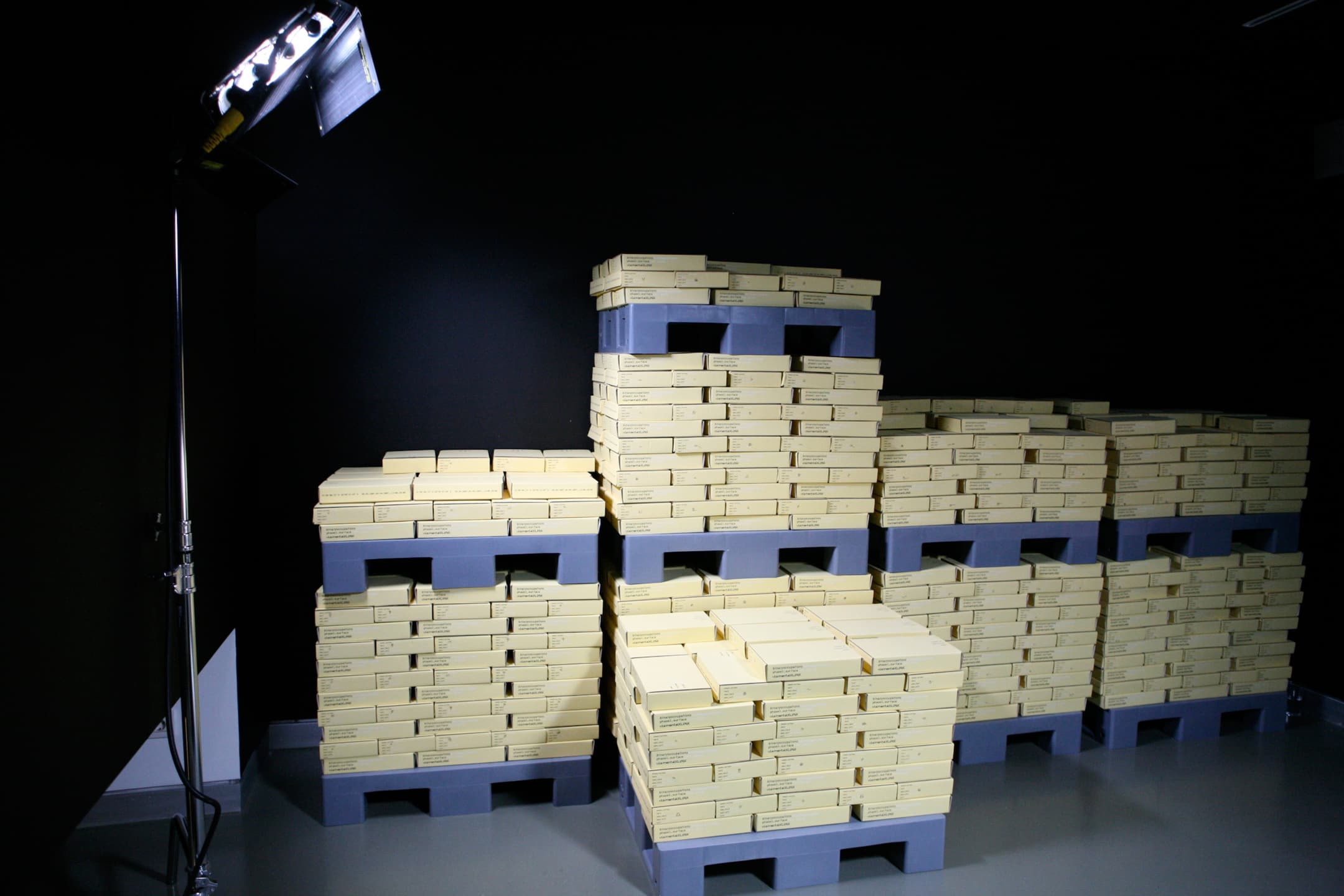
BINARYOCCUPATIONS PHASE1.SURFACE
:MENTALKLINIK SPACE, ISTANBUL, 2007
SEPTEMBER 03,.2007 __18:00_22:00
SEPTEMBER 04-09, 2007__12:00_20:00
consultants: tül akbal, süalp, orkun şentürk
sound: bokkob_ali ergun
taste: alchemist_maksut aşkar
translation: eren pultar
light: V vision&light
thanks to selami şimşek, buket baydar and tuna yılmaz
surfaces: hard, semi-hard, semi-soft, soft
treatment instruments: on the :mentalKLİNİK octagon
wearing gloves is recommended
:mentalKLINIK with _phase1.surface_ proposes the 7-day, 76-hour _binaryoccupations_ at coordinates 41º03´ 05.72˝ N 28º59´ 47.49˝ E for a 21st century collection that it launched in order to transcribe the forms of relationship that human has with objects, objects have with human at these times when objects have begun merging with the body.
:mentalKLINIK evolves the 21st century idea of the frozen collection into the idea of a collection, which can be re-read each time, a collection in which data, open to binary readings, is transformed and its known sources can be tracked. Knowing that data might lack the possibility of inspiration, :mentalKLINIK attempts at different means of conveying data in an extended time and thus proposes a new production. In a formulated space and time, it presents a formulated process of re-construction and re-production.
With the selected material and treatment tools :mentalKLINIK will leave the surfaces to the randomness of the maker/doer and will complete the processes of the source collecting, reading, processing, building and compiling, provided at the stage of the surface phase fictionalized within a certain time interval, with the stages of re-production and presentation and will continue the 21st century’s collection with different phases.
Without using the 'chance' of simulation and by experiencing data's transformation into another structure, _binaryoccupations_ points to the allure of data, to its indestructibility and re-usability. _binaryoccupations_ bears the potential of duality, plurality, uneasiness, indecision and tension. :mentalKLINIK with _phase1.surface_ tempts the relationships of damaging, battering, disintegrating, thoroughly bruising, forcing interfaces in two directions, all of which provoke the most primitive sense of touch. :mentalKLINIK brings senses to the center while working on situations with _binaryoccupations_.
By positioning itself on the thin line where boundaries begin to melt, :mentalKLINIK is collecting data mud in order to disrupt patterns, to create new sources from scattered pieces, to model the jointly experienced production of fictionalization process. With _phase1.surface_, :mentalKLINIK is here with the purpose of selecting time data from manipulated surfaces, of provoking the sense of touch, to store what is done by hand today, today when the skin cannot yet immaterialize and leave it all for the future.
:mentalKLINIK invited the beholders to be donors. The beholders, entered into space, were first supposed to read the text (as if they agreed on softwares’ policy texts), then to accept to be donors. In the work’s alienated space of fiction, the subjects of Binary Occupations pose the possibility of misleading between the activities of creating and doing. They donate the moment of doing in the time of the work, the formed object and its binary data; and their usability by the artist. In this work, participant subject, instead of being a beholder, takes part in the process which is determined by the artist, within a certain time interval. In this process, possible relations with other subjects belong to the initiative of the subject and the situation. In BinaryOccupations, the subject of :mentalKLINIK is the surface data of the object formed by the subject.
:mentalKLINIK team worked around following questions:
“Is production possible without using the ‘chance’ of simulation?”, “Can a significant form be produced out of quantified data?”, “How can the relation between the source and the product be interpreted?”, “Who is the creator of the work, who has the talent?”, Is it possible to create a new aesthetics by processing the collected data muds with software written by the artist?"
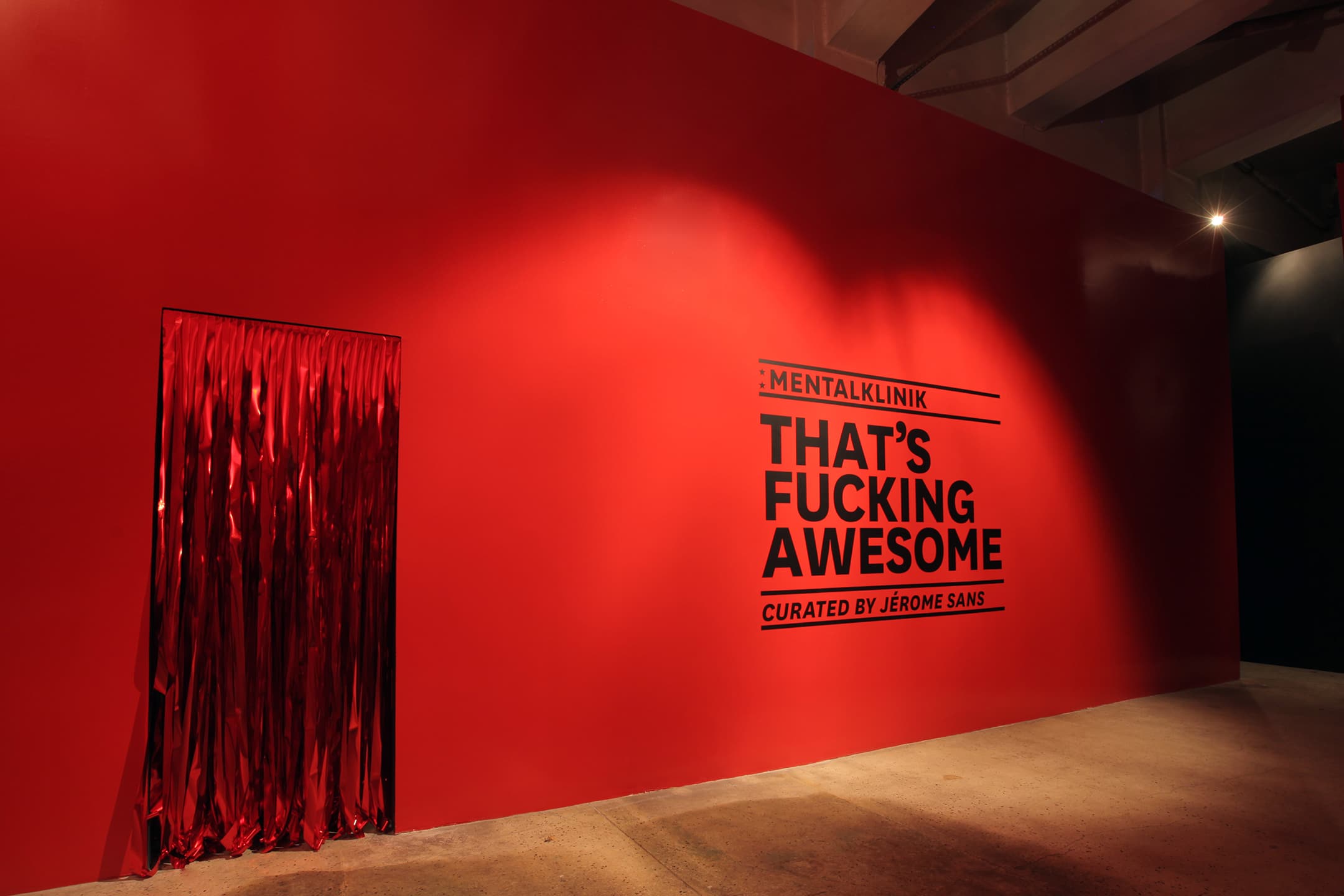
THAT’S FUCKING AWESOME
CURATED BY JÉRÔME SANS
GALERIST, ISTANBUL HASKOY YARN FACTORY
SEPTEMBER 17, 2011 – OCTOBER 22, 2011
A pop up project curated by Jérôme Sans to live the experience of the :mentalKLINIK at Haskoy Yarn Factory.
:mentalKLINIK is an infamous artistic duo from Istanbul composed of Yasemin Baydar (*1972 ,İstanbul) and Birol Demir (*1967, Ankara) known for their reactionary form of an open laboratory to reinvent process, production, roles, conception and presentation. Starting their collaboration in 2000 the creative team began their creative factory that could walk on …. This exhibition presents for the first time the culmination of 10 years of activity, and is an introspective rather than a retrospective.
Like a discoball, this project shows a selection of their multifaceted approach on their universe. Resisting to the limitations of a single vocabulary or style, their world is a playful one full of hedonistic appeal which can be experienced as festive and glamourous but also surprising as one approaches to discover with a closer view an underlying violence suggestive of a bad trip after party or a creepy begining of the end. Their works shift between emotional and robotic attitudes. Is it fake or true, or could it all be about falsification. Does it have to do with Poker face attitudes or with the alchemy of changing lies into truth or fake into real?
To begin, their game requires several players and thus the KLINIK’s interplay with a minimalist ideology of seriality. Some Works begin by slicing or cutting whereby the artists introduce an element of danger, as a métaphore of art. Other works are emotionally charged with connotations set in direct contrast to other works completely devoid of human characteristics such as the series of robots or slivers.
Like the title of this exhibition, 'THAT’S FUCKING AWESOME' :mentalKLINIK often employs oxymorons (figures of speech that combine contradictory terms) in their works with language (He is digustingly handsome/ She is awfully beuatiful) as a reflection on the inevitable paradox of life… or death?
Are you ready to become their patient?
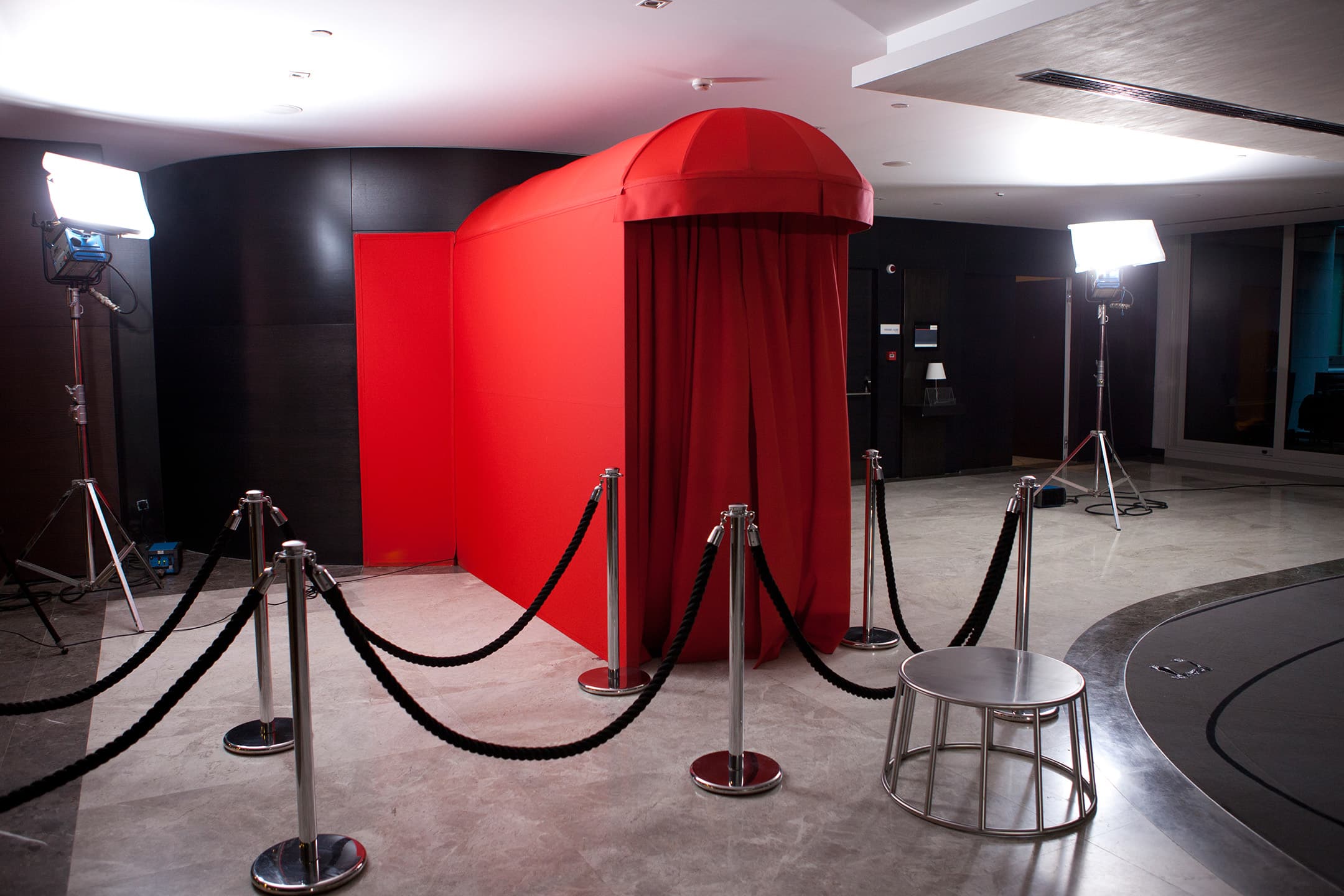
TERRIBLYJOLLY
REAL-TIME SCULPTURE, 30 MINUTES
ISTANBUL, 2012
This constructed experience generates a feeling of being at the wrong place at the wrong time. The audience members enter into the space at the peak of the experience and they experience a sudden mood change as the party comes to a standstill with no apparent reason. The audience never fully gets in the groove since just right before the moment this might happen all pleasure is suspended. The experience juxtaposes the promises of entertainment and of nightlife with the reality and bareness of daylight. Usually working hours and a sense of responsibility are associated with the notion day while fun, entertainment, letting oneself go and irresponsibility are associated with the notion of night. This ephemeral experience subverts all such expectations and before one has time to reflect on it disappears. It disrupts the pleasure and fun at its peak and suspends the expectation for more. This experience also provokes some repressed anxieties since the audience members are confronted with their desire to become a part of a group. They are charmed by the appeal of community and confronted with the problem of belonging. This experience will be unforgettable yet destructive and distractive at the same time!
BACKSTAGE
A room in an hotel lobby is transformed into a club that is covered around by red gelatin curtains. Sound and light systems is set up inside. The music is made up of repetitive short loops. A scent/perfume particular to the space, sensible by the audience will be present. The entrance into the space is through a tented corridor reminiscent of real clubs. At the entrance there is a bodyguard and a host who picks who gets to enter by pointing at them. 3-4 people is chosen each time to enter the club. Not everybody is given the chance to enter the space. This is last roughly about 30 minutes and afterwards the club is closed. Inside the space there is already be a group of people (selected by casting and whose outfits are finalized by styling) dancing. It is crowded inside and the audience members who are let in is able to participate in the dancing/party. However, in a very short time after the entrance of the audience members, the music stops and everyone dancing come to a standstill. The present audience members is shown out and the new ones let in as described above, repeating the same mechanism. In the meantime the cast of dancers is subject to change since there are more people (club/party cast members) in the adjacent room. In short, the community present inside is vary with different agents. In 30 minutes the club closes down.
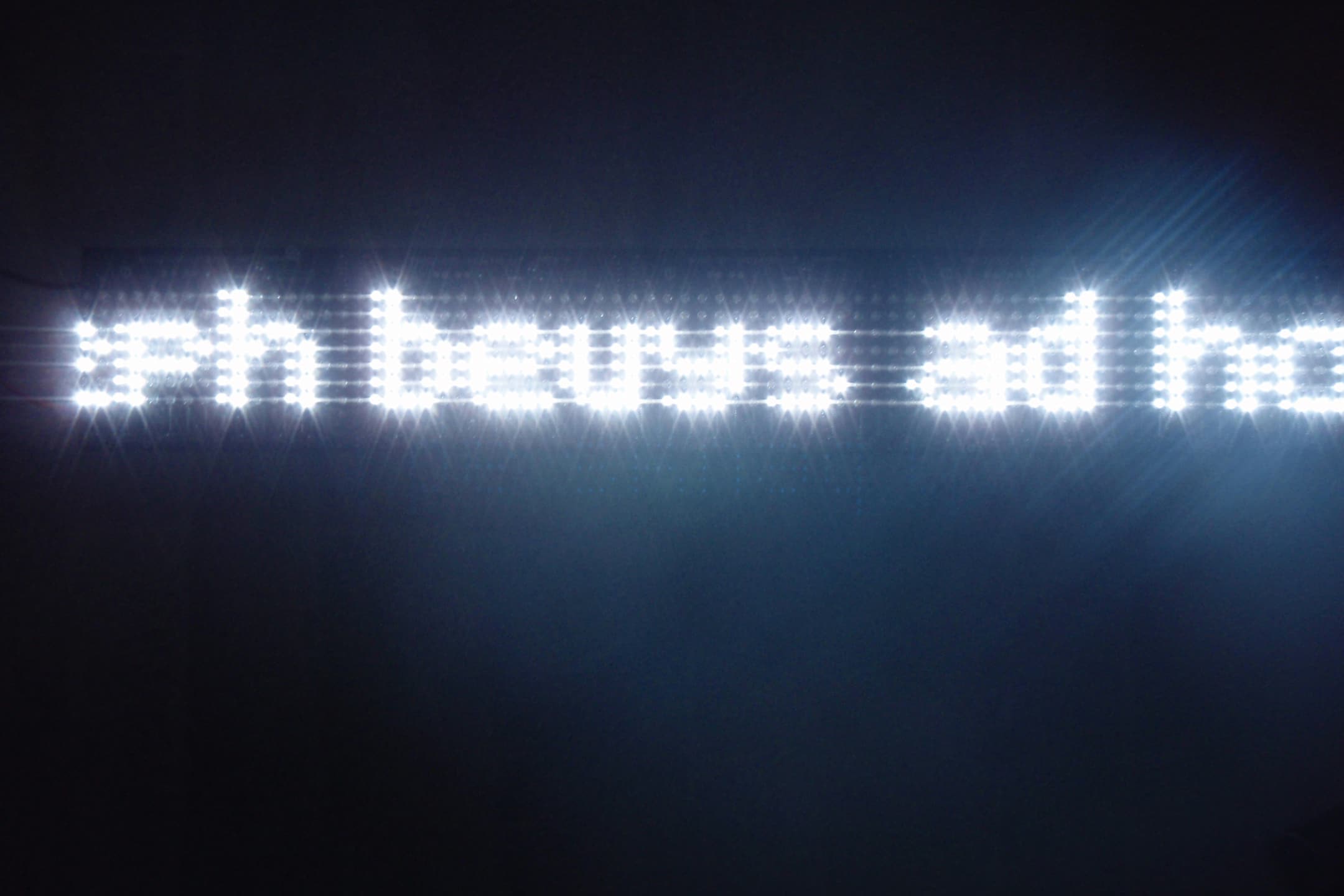
TAGCLOUD
:MENTALKLINIK SPACE, ISTANBUL
MARCH 21, 2008 – OCTOBER 14, 2009
212228294511121819252623910161723243031671314202127284511121819252612891516222329305612131920
2627341011171824253117814152122282956121319202627239101617232430316713142021272867131420212728
since march 21, 2008
:mentalKLINIK 2008 and 2009 productions: TagCloud
:mentalKLINIK opens to pursuit unobscured what it surveys by tagging its concept of frozen time, its way of appending to time, its relationship to art, its perspective and idea of production with tags like dismembering, blurred, fragment, source, arman, chaos, curve, joseph beuys, ad hoc, cloud, nonlinear, explosion, virtual, open source, dust, merzbau, liquid, turbulence, particle, nebula, immaterial, ma, light, carefree, accident.
:mentalKLINIK fictionalizes an occupied time and place at its location in a designated timeframe, on purpose that this requires the spectator’s active engagement, in order to generate a direction of flow, create tension, change the movement’s direction, deposit residue and generate a blur using its right to change, remove and add.
Nothing can exist that is not tagged today. Tags are present both on products, in our memory and in the relationships we establish. With the works of ‘augmented reality’ human beings are being drifted from the material world further and further into a cloudlike zone. :mentalKLINIK attempts to challenge the threshold of the cloud like world born of the tag’s reinforced autonomy, by the constructed reality of the work as tag. The 21st century fragments confronted in the present day and which we have difficulty giving meaning and name to, the topics, concepts and circumstances of a world without materials, are handled by the intermediation of the works identified as interface in the relationship to the material world, while :mentalKLİNİK’s point of view destroys and reestablishes the relationship to place, time and spectator.
‘Tagcloud’ transforming the gallery into a workshop, the exhibition space into a construction site is open till the end of 2008. :mentalKLINIK develops a ‘source’ for the future with works that are replaced at times and that shift place and presentation.
EXHIBITION AS A FORM
TagCloud exhibition actualizing itself by giving up on its state of being continues to be a form itself. It constitutes the idea of past and future in an extended present, within the same plane. The exhibition shelters the state of being a prospective as well as that of being a retrospective.
The structure of the exhibition as a form of continuity, the entrances and exits of the works bring TagCloud closer to the idea of immortality. TagCloud as an exhibition presents an unusual augmented experience. A gallery’s routine of holding 6 exhibitions a year (exhibitions of various artists) is replaced with :mentalKLINIK’s exhibition which hosts the same artists 6 times in a year. This demands repeatedly visiting as a constantly updated webpage.
In arts, an area less demanded, :mentalKLINIK makes more demands on the service oriented and subscriber subjects. It provokes by presenting an exhibition which can be RSS-ed. TagCloud as an object of augmented desires is an exhibition that lusts for its subject. The artworks as interfaces continue to be subjects in all relations, they form courageous relations in a non-hierarchical order.
the open dates of the exhibition:
march 21222829 __ april 45111218192526__ may 23910161723243031__ june 67131420212728__ july 45111218192526__ august 1289151622232930__ september 56121319202627__ october 3410111718242531__ november 178141521222829__ december 56121319202627__2008__january 23910161723243031__february 67131420212728__march 67131420212728__2009
visiting hours of the exhibition: Friday/Saturday 16:00-20:00
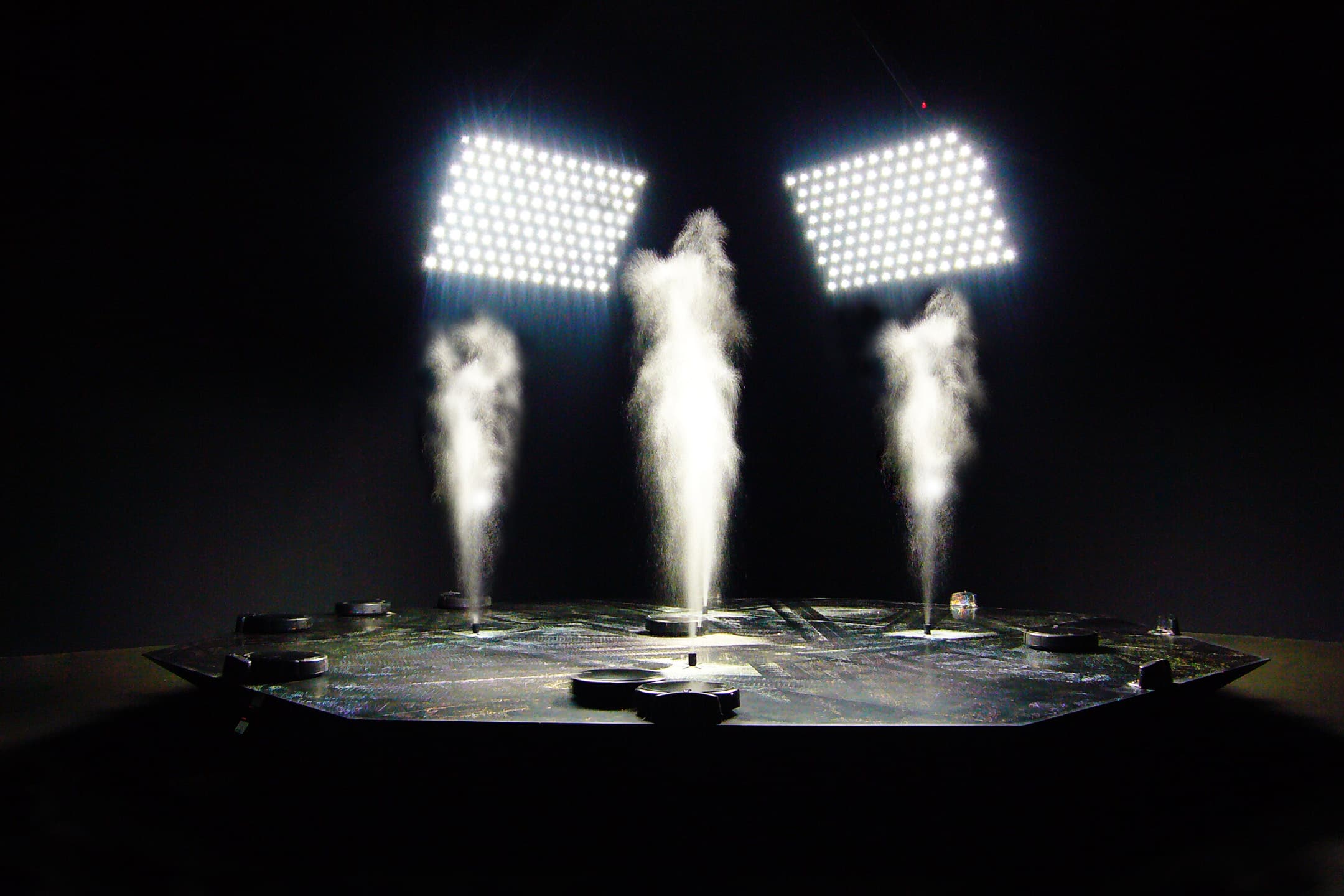
PUFF,
ART BASEL 40, ART UNLIMITED BASEL, 2009
GALERIST
The art of idiocentric duty and idiocentric beauty
Idiocentricty of duty transforms whatever it encounters into an object of its occupation, while the idiocentricty of beauty transforms the onlookers into subjects mesmerized by its aura. While glitters are being repetitively ejaculated, the autonomous cleaners repetitively vacuum the residue of their ephemeral aura. When these two idiocentric conditions apathetically repeat their occupations in the “atmosphere”* of their constructed space, they create the illusion of a frozen time – a timeless repetition – desperately seeking to become a monument which is doomed to decay as soon as its orbit is displaced from its artificial atmosphere.
PuFF does not interact with its audience yet it achieves completion only if the audience flirts with the sway of its insignificance into significance, of its uncertainty into certainty.
Following the stance taken by :mentalKLINIK in its previous works, PuFF attempts to create an unidentified space, an indecisive zone and frozen time establishing various relations with materials and actions which construct an immaterial world.
*in Nietzschean terms
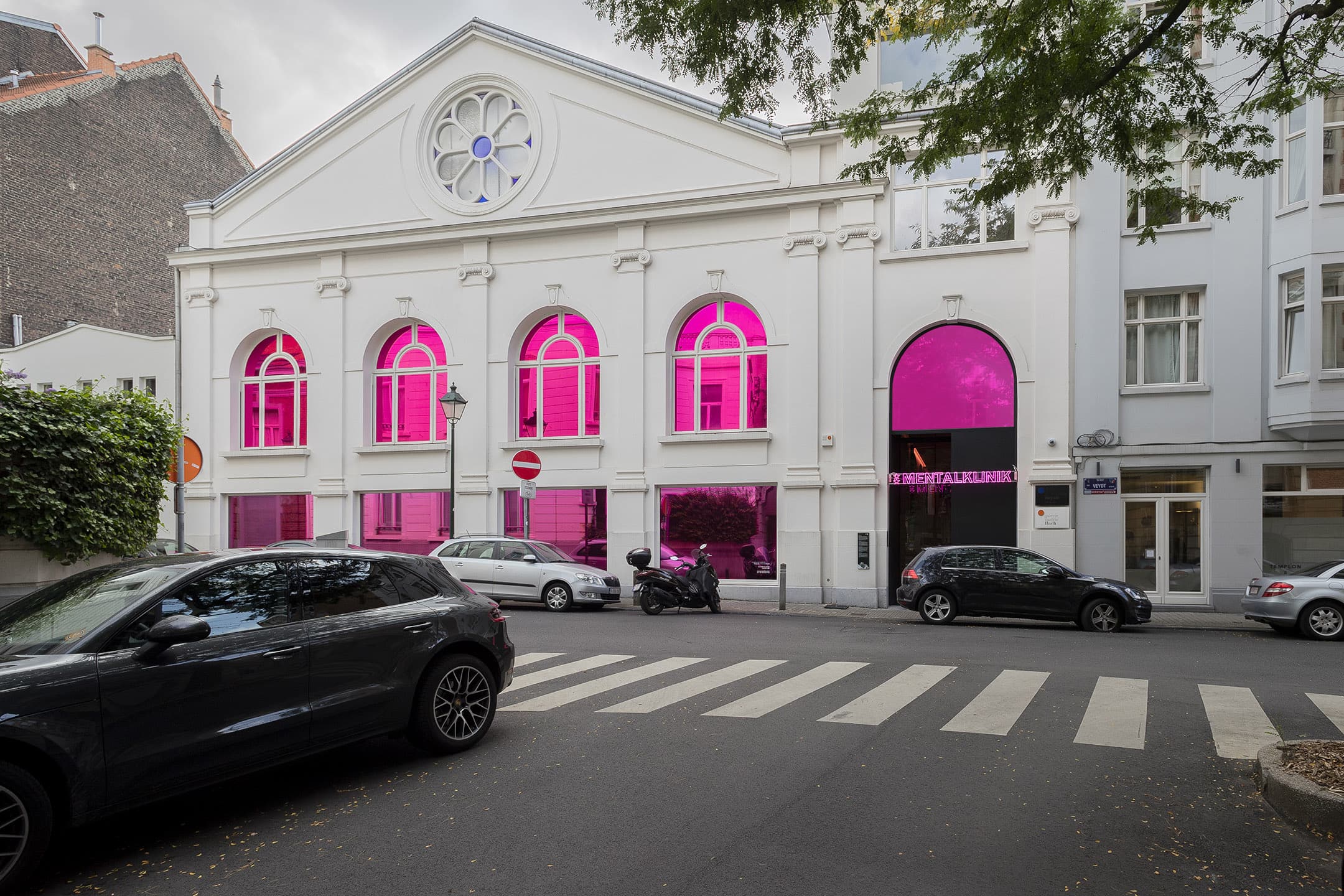
OBNOXIOUSLY HAPPY
CURATOR: JÉRÔME SANS
LA PATINOIRE ROYALE, BRUSSELS
SEPTEMBER 7TH- DECEMBER 8TH, 2018
But Who is Behind :mentalKLINIK?
:mentalKLINIK is an artist duo founded in Istanbul in 1998 by Yasemin Baydar and Birol Demir, whose multimedia and conceptual laboratory -both vintage and high-tech- has been developing since Istanbul and more recently in Brussels for the last three years. OBNOXIOUSLY HAPPY is the first exhibition in Belgium that brings together fifteen years of their activity, as an introspective rather than a retrospective. The exhibition presents a symptomatic set of the multifaceted approach of their universe that constantly blurs the borders. :mentalKLINIK is an allusion to the laboratory where practice and theory coexist, as the mind (:mental) refers to the mind and the KLINIK to the practice.
The oxymoron (the figure of speech which associates two terms which exclude each other) is the central focus of their work; not only through the text, such as the title of the exhibition, but also through the style in which these artists shamelessly set back to back references to conceptual art, minimalism and the pop universe, as well as entertainment.
OBNOXIOUSLY HAPPY questions the fantasies linked to happiness and optimism advocated in the contemporary capitalist culture of the cult of success, as well as the blurring of boundaries between subjects and objects. For :mentalKLINIK, the oxymorons "reveal a deep duality in our world and the complex feelings that people are usually unable to express." Screaming out using La Patinoire Royale, its role as amplifier, intensifier of the experience, in a world more than ever dominated by language. They mix paradoxes and humor, playing with the current world affairs. The duo straddles with undisguised dexterity the invisible political strategies and the social dynamics with ultra-contemporary devices of an obvious lightness and simplicity. The exhibition convenes -in no chronological order- all of their playful, violent and abrasive vocabulary that continuously twists glamor, rock or post-punk references through a selection of iconic pieces and new productions. It is a whole work of encryption to which these artists summon us, between the true and the false, the artificial and superficial, as if everything were a matter of falsification.
:mentalKLINIK speaks about the manipulation of individuals through their magical and hypnotic atmosphere, the visual saturation of incessantly flowing images and words in an era of new technologies and social networks. A flow without beginning or end. The positive, ultra-addictive energy that emanates from the works carries us away at first, but behind this attractive, electric and glamorous façade, there appears another world of far more disturbing meanings. Artists re-appropriate the sparkling and authoritative visual language of the media and night spheres in a climate of sensory hyperstimulation generated by the multiple neon signs, slogans, light beams, mirror balls and confetti that make the exhibition space vibrate. We project in an indecisive atmosphere and context. Is it before or after the evening that we are located?
The duo continually creates new aesthetic forms in heterogeneous materials by playing on our unanimous attraction to glittering and seductive objects, which, through the magic of commodity fetishism, making their appearance as robotic vacuum cleaners spitting glitter, deflated toys that become masks, magazine covers hijacked by emojis, headlines, neon lights or reflective surfaces that catch our eye, rocking and flattening the space and inevitably integrating the viewer. To start, this game requires several players and the KLINIK interacts with a minimalist ideology and series. Impossible to escape from it.
So, are you ready?
Jérôme Sans
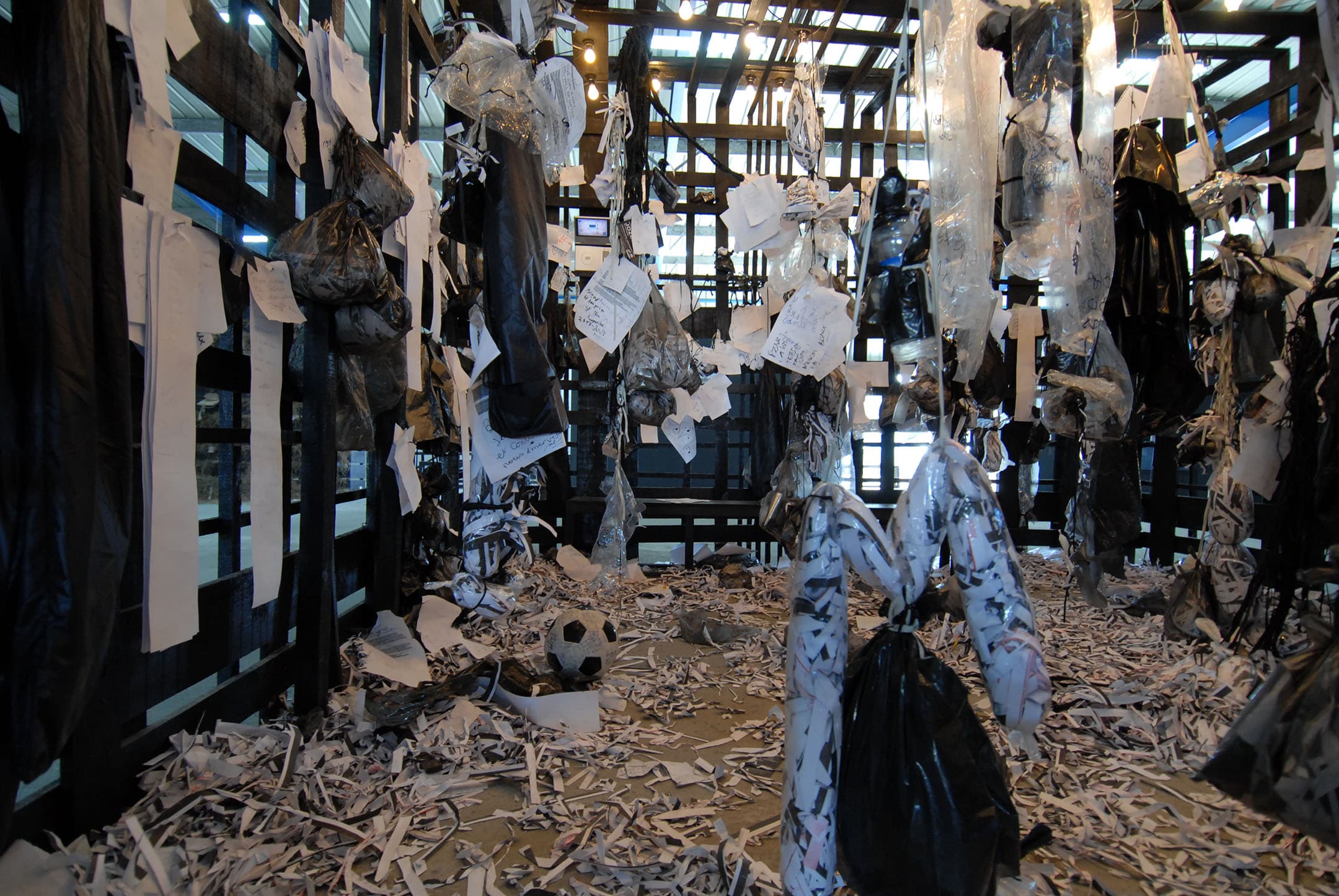
GIVE JOEL A GIFT, YOU WILL BE GIFTED, _VIA :MENTALKLINIK
30 AND ALMOST-DREAMS EXHIBITION BY JOËL ANDRIANOMEARISOA
SEPTEMBER 19, 2007 – OCTOBER 20, 2007
ZONE ZITAL, ANTANANARIVO
In this project ’30 and almost-dreams’ standing between a party/celebration and exhibition, :mentalKLINIK is interested in taking a daily life experience as frivolous as celebrating a birthday or receiving gifts, reviving it as a relationship of “simply giving” between acquaintences and non-acquaintances but also positioning it in a groundless place in the relationship of gift as a tool in the give-take relationship.
Objects, non-objects, emotions, sounds, words, smells, desires, experiences, visions, plants etc. _Via :mentalKLINIK _will host all sorts of gifts/presents.
30 years, gifts for the 30 years that a gifted person, Joel, lived. Simply to be giving, because one has too much, for yesterday, for today, for tomorrow… For age 0 to age 30 and for the future… a treasure… A gift that Joel will also be giving to his audiance, simply to be giving, because he has too much… to remember and to be remembered…
:mentalKLINIK is envisioning areas where giftwrapping can be done, gifts are exhibited and gifts can be collected. For giftwrapping and packages, it envisions/plans wrapping choices (boxes, papers, envelopes, threads, ribbons etc.) Viewers will be able to wrap their presents in the various fun areas in this space but also take gifts from shelves, open them and look at them and then wrap them and put them back. Some tools such as screens, CD players will be available in the space, serving audiance’s needs.
The space will extend a sensation of an unfinished birthday party. Until the end of the exhibition, Joel’s birthday will be celebrated everyday. The joy and weirdness of giving gifts, the curiosity, making the gift public, stripping away its privacy and creating a treasure for Joel Andreanomearisoa. :mentalKLINIK requests all participants (other ~29 people) and audiance to bring a present/gift for Joel’s birthday party_VIA :mentalKLINIK _ space is constantly renewed by the audiance and participants.
Whereas :mentalKLINIK creates this occasion/form, designs the shell, mediates and also, as exhibition participant, is the first to receive the gifts and pass them on to Joel. At the same time, it passes on Joel’s gifts to the viewers in the _VIA :mentalKLINIK _ space.
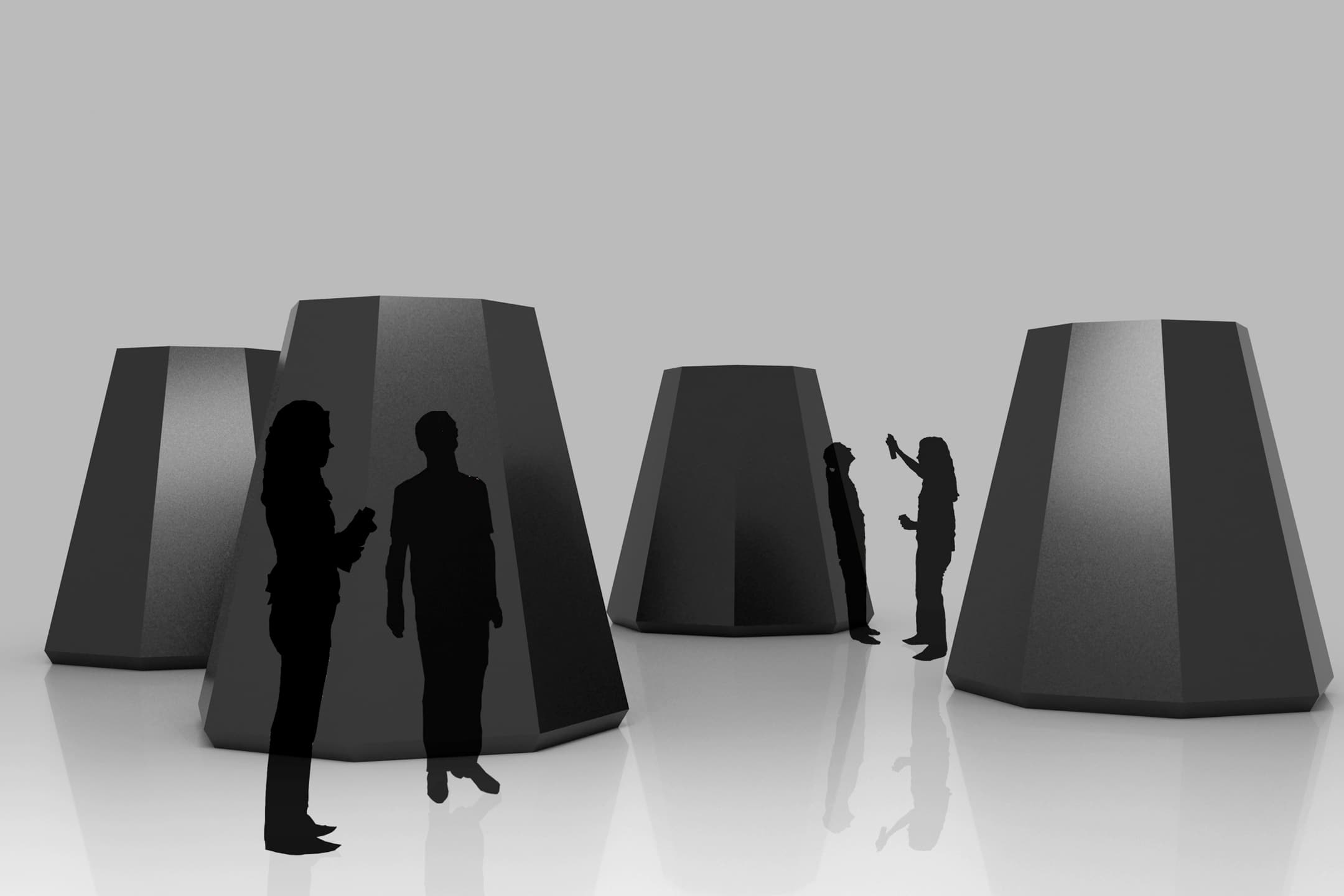
TOMORROW NOW – WHEN DESIGN MEETS SCIENCE FICTION MUDAM CURATED BY ALEXANDRA MIDAL AND BJÖRN DAHLSTRÖM
MUSEE D’ART MODERNE GRAND-DUC JEAN LUXEMBOURG
MAY 25, 2007–SEPTEMBER 24, 2007
EXHIBITION DESIGN: MATHIEU LEHANNEUR
FROZEN45’’
REMEMBER, TIME IS PERCEIVED FULLY WHEN IT IS ‘FROZEN’
45 minutes time-freezer
a unisex product by :mentalKLINIK to use at MUDAM to freeze the time of your face and trap your face in time as a sculpture.
Frozen45˝ is tomorrow’s treatment envisioned by :mentalKLINIK for freezing the time of the skin
Both skin and time are problems of lines. Skin has its own time. :mentalKLINIK recommends you to ‘freeze’ the time today before your skin gets traces of tomorrow. :mentalKLİNİK has developed a special treatment , which allows you to take with you your face of today into the anticipated future. Developed particularly for this facial treatment, the-state-of-the-art time-freezing product contains extracts of the ‘frozen’ time manufactured biotechnologically for your skin. When applied onto your skin, this time-preventive and refreshing treatment activates the sense of time within the pore of your skin.
Frozen45” by :mentalKLINIK forecasts how people will shape their own bodies, becoming both the ultimate consumer and the item consumed in the coming age of “Biot”s - entities which are both object and person, both the shaper and the thing shaped -. The cosmetics industry already uses the methods and the language of a “Biot” technosociety. Frozen45” is an envisioned treatment of tomorrow freezing the time of the skin. Invisible in its application, it attains its visibility in the absorption process by the Biot transformation. The visitors getting the in-museum Frozen45” treatment, allow their bodies to participate in the economy of the museum. Their faces become invisible sculptures in the museum forever, also forecasting how when the boundary between objects and humans disappear, museums might exhibit “Biot”s.
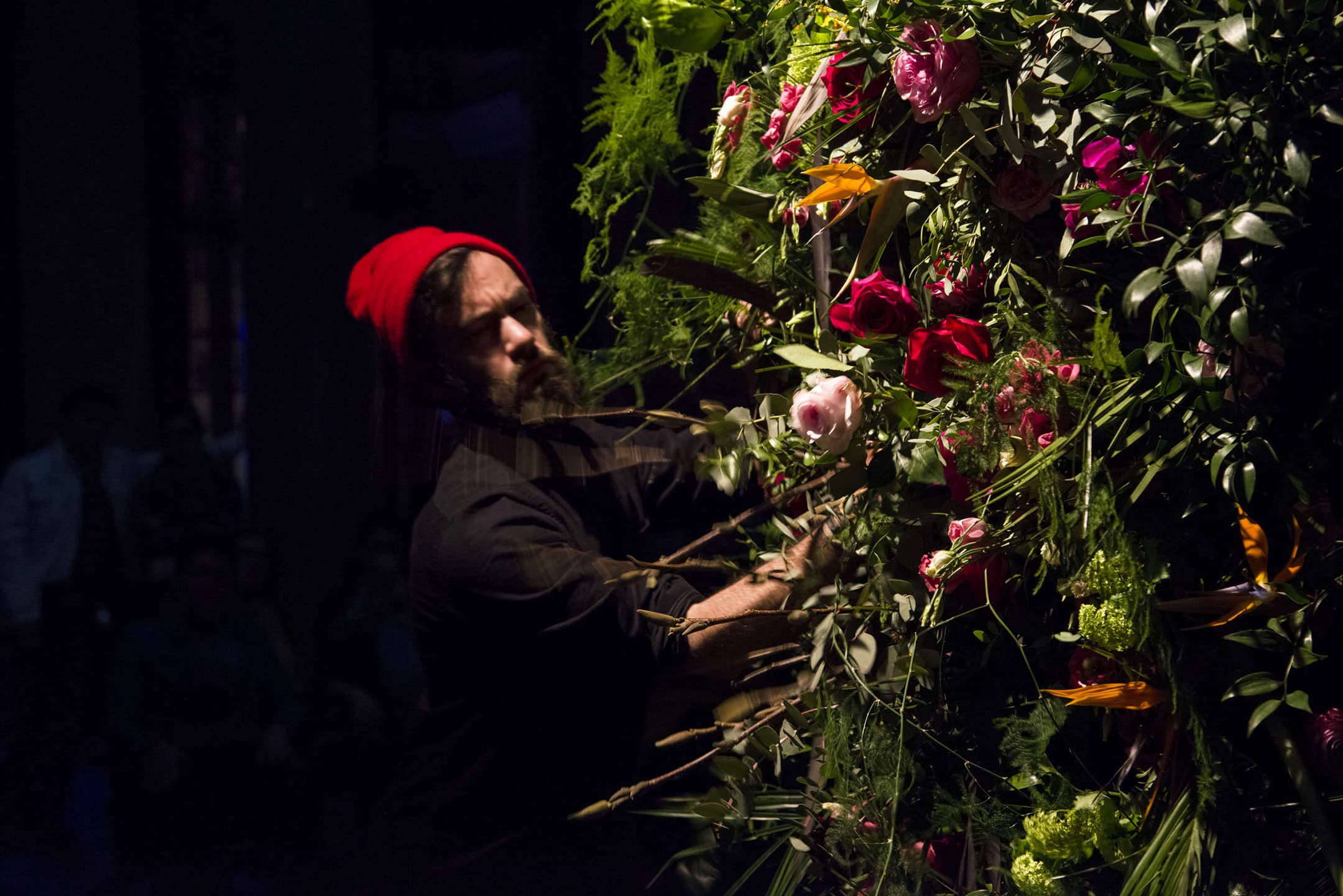
FRESHCUT,
MAK NITE LAB @MAK COLUMNED MAIN HALL MAK- AUSTRIA, MUSEUM OF APPLIED ARTS / CONTEMPORARY ART,
PERFORMATIVE INSTALLATION (45 MIN.)
CURATED BY MARLIES WIRTH
FLORIST: JÉRÉMY MARTIN
SOUND: ORKUN ŞENTÜRK & :MENTALKLINIK
TUE, 26.03.2013 8.00 PM
MAK COLUMNED MAIN HALL
FRESHCUT invites its audience to the flowers’ enchanting world of small wonders and transforms them into actors of an augmented cinematic reality. Bringing under the magnifier a small everyday detail, FRESHCUT creates a fictional world at the threshold of art and craftsmanship where the non-spoken language of flowers reigns. The audience is assigned a role in this fictional world once they are under the ‘spotlight’, and they become a part of the narration.
There is simultaneously a robotic and emotional, tense and violent relationship between the performance and the ambiance while the space is manipulated by different artificial floral scents from different corners.
FRESHCUT brings under the robotic spotlights the violent craft of creating and the emotional art of cutting and slicing where art and craft transform into one another.
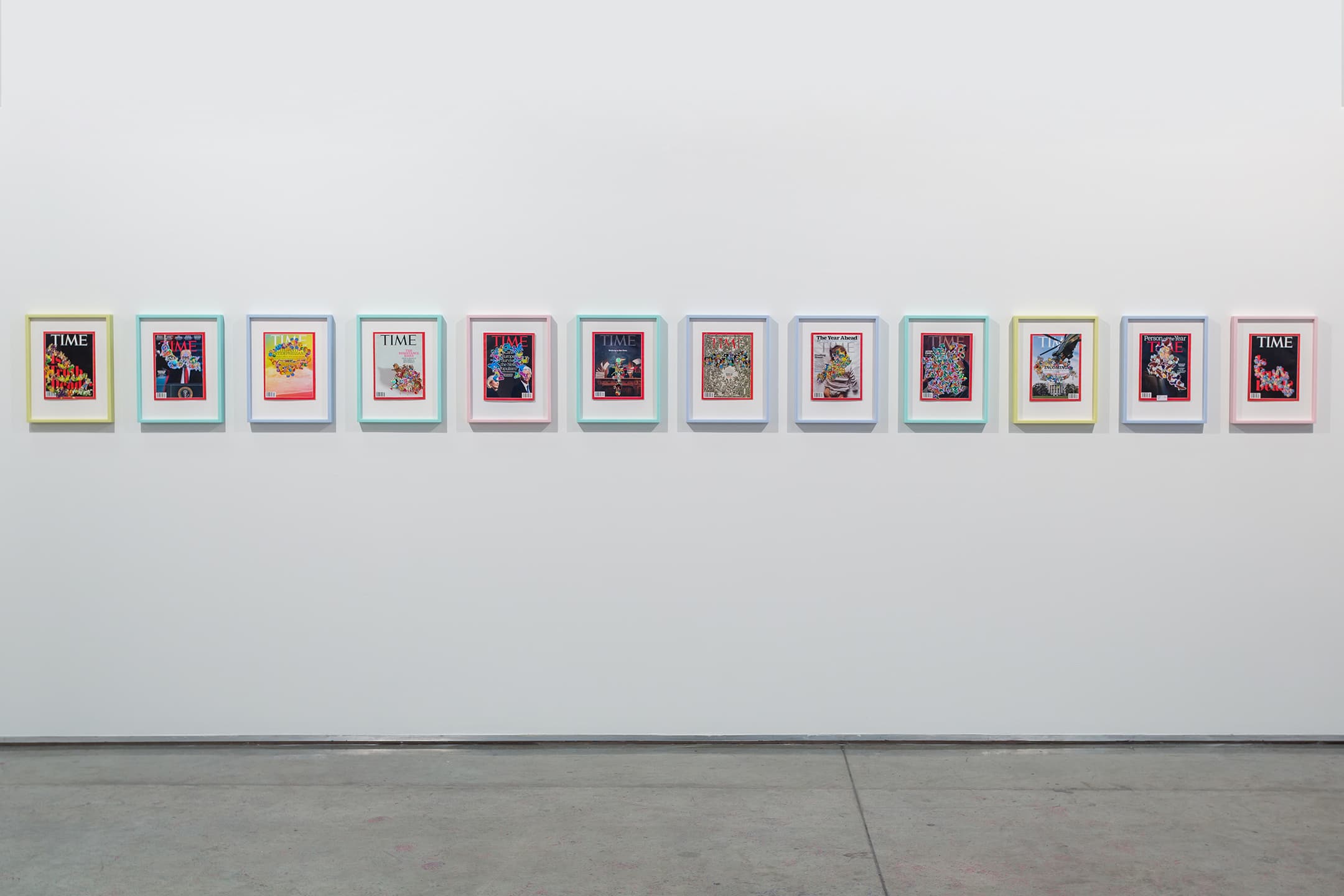
TRUISH
GALLERY ISABELLE VAN DEN EYNDE, DUBAI, 2017
NOVEMBER 07, 2017 – DECEMBER 30, 2017
“How can art lie when the reality is not true enough,” :mentalKLINIK
We are pleased to announce artist duo :mentalKLINIK’s second solo exhibition at the gallery. Truish not only presents an ambiguous scenario, but also asks a pertinent question: What is the truth? How does one gauge the truthiness of something? What you see in this exhibition is perhaps true – or maybe not, and this ambiguity becomes the fuel to question our reality and surroundings.
With a keen interest in invisible politics and dynamics that shape our everyday lives, :mentalKLINIK reveal awkward, alien and surreal elements into the exhibition space. Such is the case in the neon work Are You Popular Enough? that sees an overlapping of their handwritings to challenge the existence of their duo and creates a fuzzy understanding of how much is enough to achieve complete satisfaction. The artists do not attempt to remind us of the regular or the normal, instead they create an uncanny and overwhelming environment that takes a jab at reality (and art) by navigating a slippery slope that is the ‘truth’. This echoes in the non-serious, pastel coloured frames around covers of the prestigious Time magazine, which are overlaid with cheaply produced stickers and popular Emojis to generate multiple layers and surfaces. By manipulating the aesthetics of a credible source of information in this manner, these personalised covers raise an eyebrow on accountability and political strategies.
The truth can be fickle in the age of Internet and digital reproduction, and Phony skilfully brings this into the rhetoric. The round clear glass works embedded with solar film allow visitors to indulge in an involuntary performance as the colours of the work change with the viewer’s orientation. This performative element is also evident in Chromatic Madness, where the artists carry out physically strenuous activities such as crushing, rolling and flattening to temper with a dichroic film. In doing so, :mentalKLINIK allude to Josef Albers’ playful informality of relying
on one’s body and easily available material to create works that take the preciousness out of art. The minimalist Self-Seeking Superficialsalso draw inspiration from Albers’ colour interaction theory where the American-German artist explores how different colours behave with each other. :mentalKLINIK thus overlay brightly coloured polyester solar films and create multiple spaces where the background, the object and the subject are visible at once. The viewer sees their distorted and sublimated self reflected into the work that conforms to the underlying notions of being manipulated in the digital age.
At the centre of the exhibition is Puff Out, a new version of their earlier installation PuFF, which was first shown at Art Unlimited, Art Basel in 2009 and “attempts to create an unidentified space, an indecisive zone and frozen time establishing various relations with materials and actions, which construct an immaterial world.” This idiosyncratic installation almost imitates a theatrical set, where its actors (the robots) go backstage (charging units) to be able to indulge in another day of performance of collecting and discarding sparkling glitter. In doing so, the visitors become just as much part of the performance when they have to navigate the exhibition space around the movement of the vacuum cleaners, which create a constantly changing ‘painting’ on the floor. The dark, sparkling glitter has its own nature of movement and opens up infinite possibilities of creation. Similarly, the video Whiff plays with the viewer’s perception of time by blurring the boundary between the real and virtual, motion image and painting, with 4 seconds of action time-lapsed into the 3 minute 4 second video. “While confetti is a symbol of celebration, this video celebrates a void where the audience is left suspended somewhere between the poetic and political connotation of a therapeutic visual.”
Duality – or lack thereof – is a core aspect of this exhibition, where the objects become whimsical failures that cannot uphold their truthfulness, and leave us wondering about what we see and what we perceive. :mentalKLINIK’s works are not only layered with questions about popular culture, but also allow us to explore new ways of looking by constantly challenging our perception
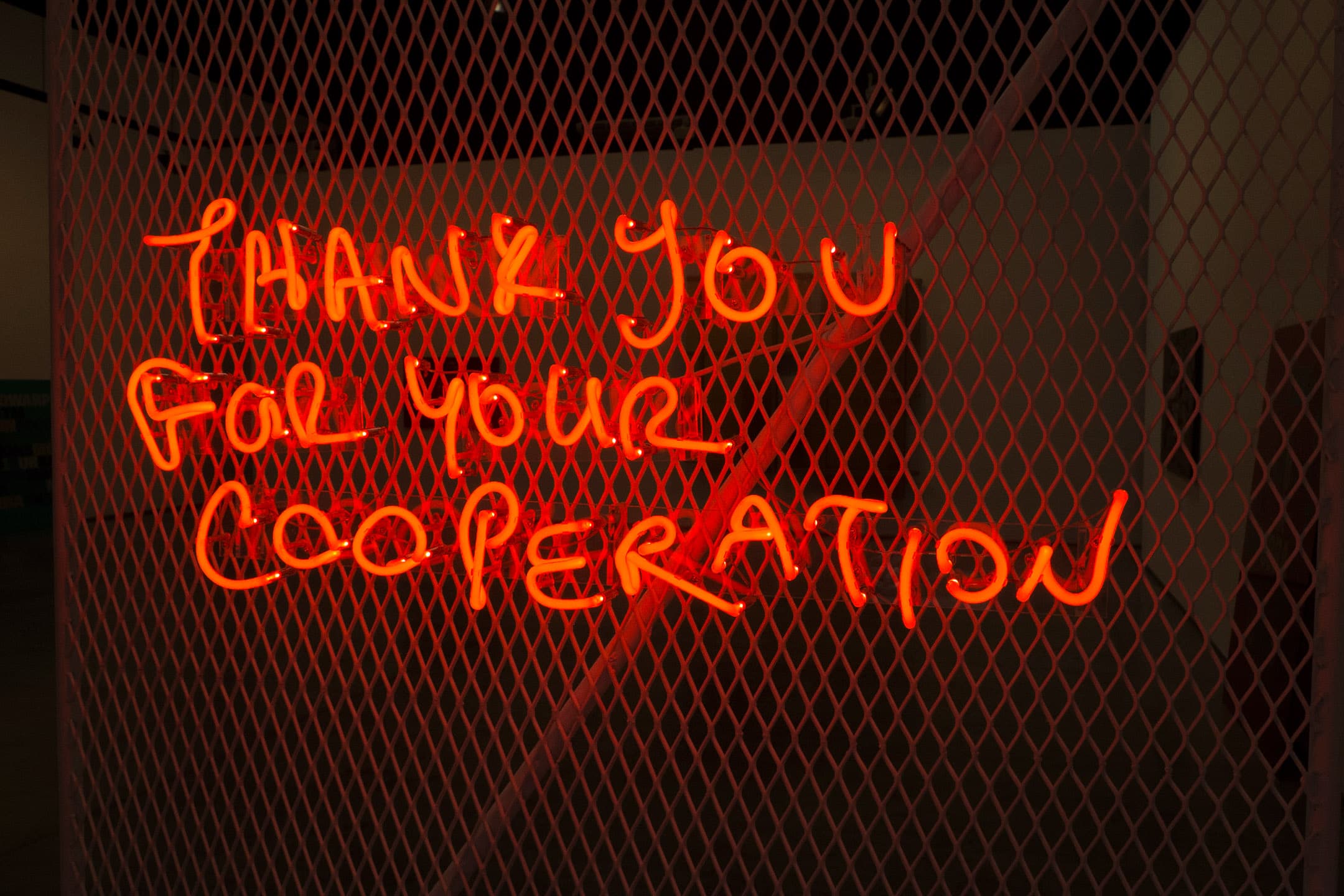
THANK YOU FOR YOUR COOPERATION
MAY 27-JULY 28, 2014
GALLERY ISABELLE VAN DEN EYNDE
A printed catalog will accompany the show and feature an essay by Jack Halberstam, a professor at USC specializing in the areas of popular, visual and queer culture with an emphasis on subcultures.
:mentalKLINIK play with colorful reflective surfaces, billboard type signs and rhetorical operations to explore new languages and alternative textures of pleasure. By drawing on these elements as the subject and medium of their work, the duo appears to collaborate with the capitalist project they seek to challenge
This exhibition presents a fragment of a highly mediated world that absorbs our complex identities and relationships into flattened text and imagery. :mentalKLINIK tackles this phenomenon in hyper-realistic textual portraits that reflect and translate the individual’s preoccupation with creating their self- image. Although the titles of many works refer to individuals, including WALKING ON AIR HANDE and SIMON their materials are stark. These sculptures made of ‘coated aluminum’ and ‘thermopane glass’ reflect our highly active yet increasingly banal and often virtual public personae.
The works in the PROFILE series lean against the wall, and function as a hyper-real ID card written in a vocabulary borrowed from user generated profiles created for marketing entities like Starbucks or Facebook. Phrases such as “FASCIST-OPENLY GAY-DOGMATIC-WHITE COLLAR-ANIMAL LOVER-SUBMISSIVE-ELITIST” are semi-legible, stamped with micro-layered polyester film on reflective planes.
The works confront the viewer with the way people have become branded and categorized as objects, even as they embrace the challenge to visualize and create their individual profiles.
While candy colored reflective spheres abound in this show, the spectator is captured by a soundscape of ring tones and communicative alerts. The sounds in FOMO, a layered, subcutaneous noise sculpture, are designed to trigger the spectator into that stand by mode of attention that we all maintain now in relation to our gadgets – at any moment, we may be called – not by a person but by the machine itself telling us that it is time...time for a meeting, time to prepare for an event, time to take a pill, to leave the house, to exercise, time to set another alert.
In the catalog introduction to the show Jack Halberstam offers an alternative route for those of us whose individual identities and social relationships have become violently transformed into immaterial capital:
“When cooperation has lost its anarchist sensibility and become a code word for selling out, it is time to dream small, make tiny adjustments and inch towards the next dream. :mentalKLINIK’s work offers us a laboratory for making, marking and inhabiting the next dream of a somewhere, an anyway, a new place to be.”
As their name suggests, :mentalKLINIK do not attempt to return us to the regular, the normal, the sane or the rational. Rather, Thank You For Your Cooperation attempts to reveal what our new order looks like: an altered- through-the-looking-glass reality.
Jack Halberstam’s previous books include In a Queer Time and Place: Transgender Bodies, Subcultural Lives (2005), The Queer Art of Failure (2011, Duke University Press) and Gaga Feminism: Sex, Gender and the End of Normal (2012, Beacon Press)
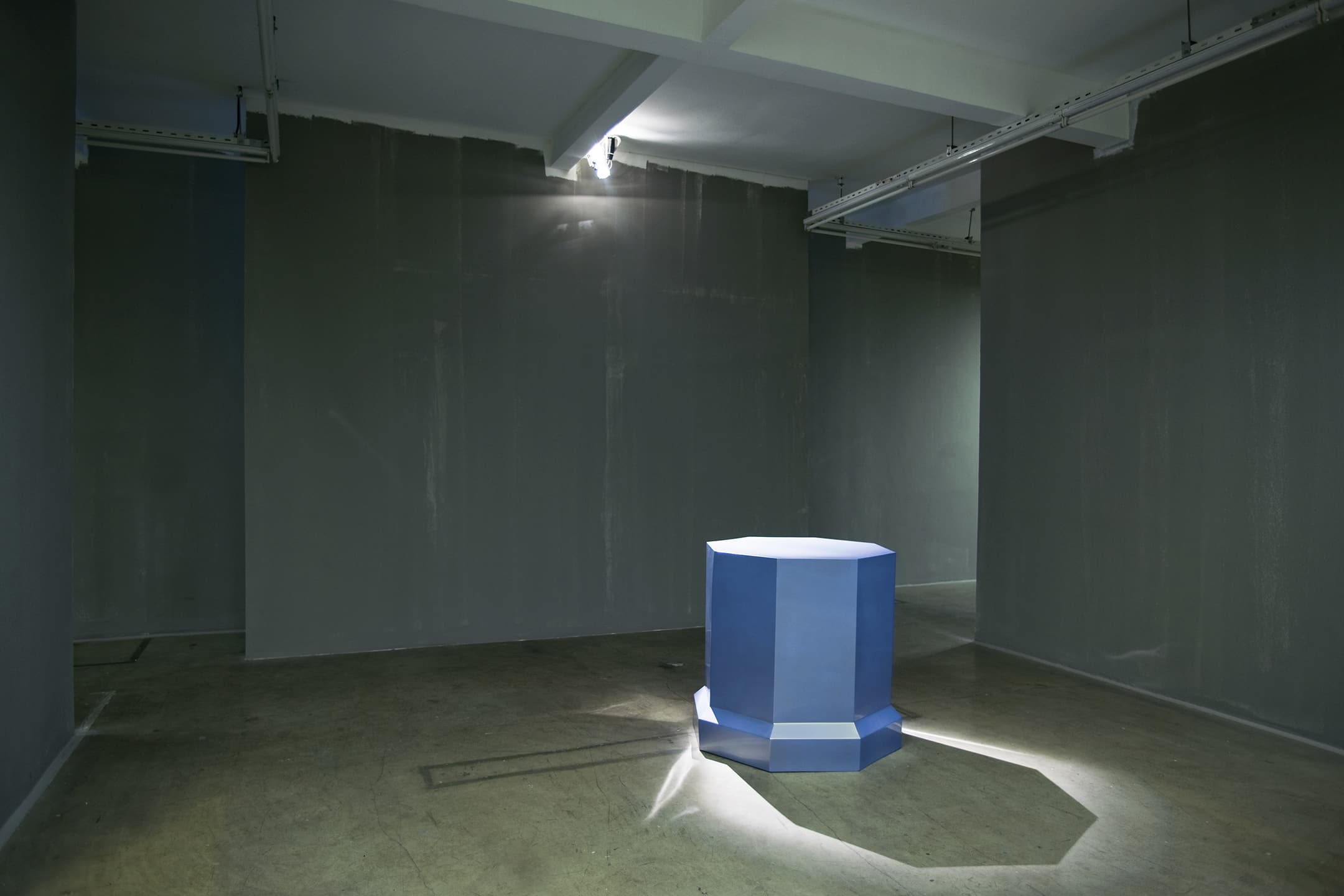
RABBITHOLE
GALERIST, ISTANBUL, 2009
OCTOBER 22, 2009 – NOVEMBER 21, 2009
Movements of the things are creating new forms in the limit of the world we know, in the ignored part of the designed, out of the way. Their impossible perfection and unintended defects are, in fact, the negations of space, form and object.
We deliberately avoid contact into which their seducements drifted us. Therefore, we are wandering on the limits of familiar space. Nowhere is open to corridor and everywhere is a gate. Jam out of this conflict determines the atmosphere of the space. Facing this is a potential for emancipation, and also disaster. We find volumes, extenuated from the real world, as increased in exhibition space. These illusionary images have meant different things, directly or indirectly, in where they belong to. On their owns, when their raisons d’être and qualities are brought to natural ends and their emergent conflicting unities are temporarily frozen, they ask a worthwhile here and now question to us.
While the total, as refugees in the waiting room of the History, was witnessing fragmenting and shattering of successive subterranean continents; we still have time to reflect upon how the reflections of such total, made up of parts, are related. May be, we should ask this question: Is it possible to ever have a consistent language of tense objects, emergent out of the encounters of uncertainties?
With rABBIThOLE exhibition, :mentalKLINIK is wandering around the event horizon of stars without atmosphere.
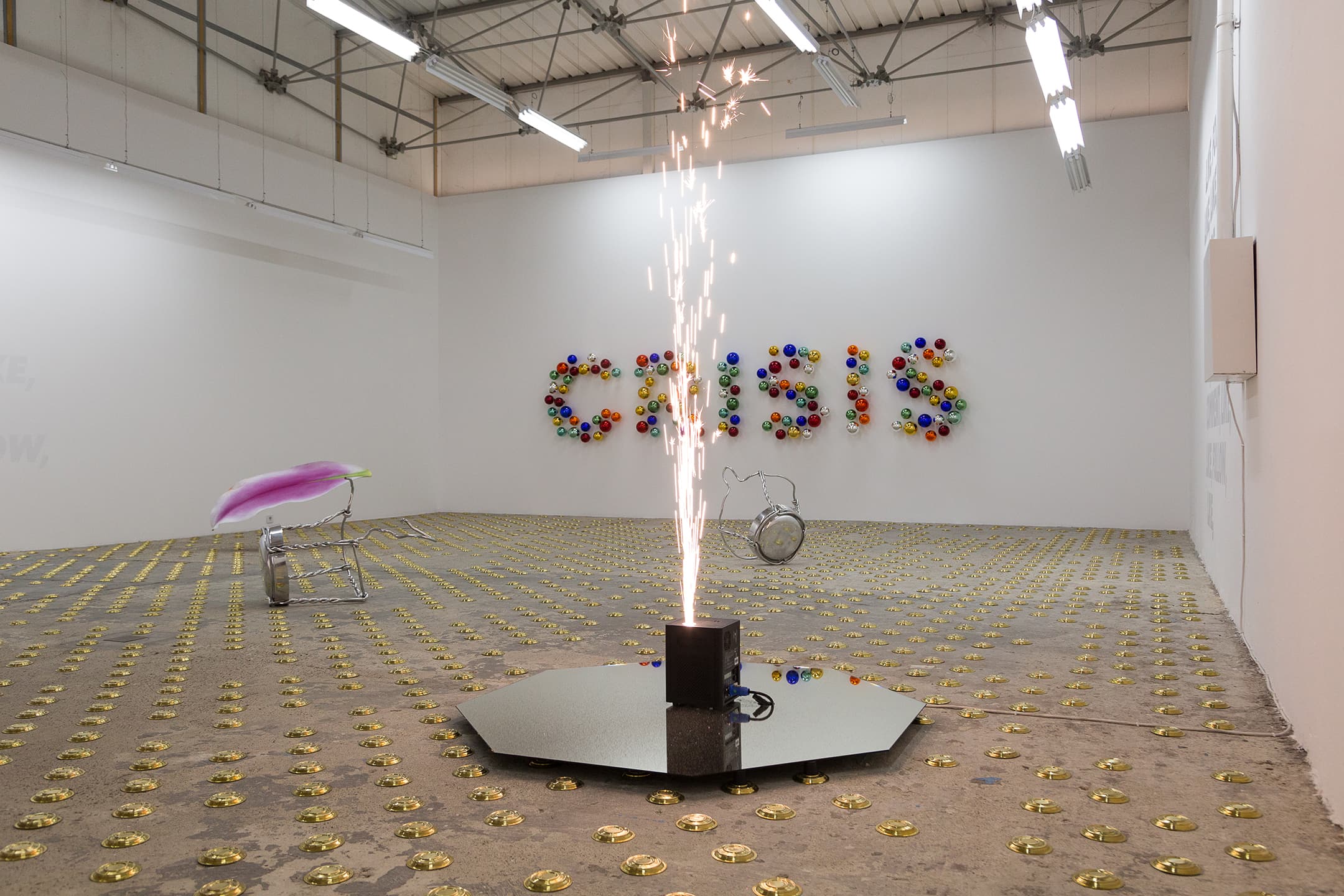
CATASTROPHICALLY GORGEOUS
SEPTEMBER 12TH-DECEMBER 12TH, 2018
CURATED BY YASMINA REGGAD
EUGSTER II BELGRADE
Eugster Belgrade is thrilled to present the first solo presentation of artist duo :mentalKLINIK: Catastrophically Gorgeous. In this exhibition the artists probe a speculative approach of the future in a world triggered by hyper consumption and governed by hyperobjects.
What has just happened? What is it about to happen? What might have happened?
In Catastrophically Gorgeous :mentalKLINIK becomes the mastermind of a myriad of possible scenarios that affects the present state of the gallery space. The duo’s work fluctuates between the potentialities of provoking the event, postulating a plot for a disaster, and simply leave the viewer as sole witness to the aftermath of a crisis or leftovers of the invisible.
In keeping with their usual provocative and audacious humour, :mentalKLINIK have created a seemingly seductive stage set, as if planning a highly personal farewell party to celebrate the end of the world, based on the latent dystychiphobia, the fear of disasters waiting to happen.
The promising use of the oxymoronic descriptor ‘Catastrophically Gorgeous’ could easily stand as the ideophone for the two sculptures Moët, 1804_A and Moët, 1805_A (2018). These large-scale replicas of the opened muselets, the metal wire cages that secure corks, leftovers from bottles of the renowned French Champagne, lie on the floor under the flickering lights, as if declaring: ‘Your time’s run out!’.
In the 24 hour-looped video installation Elevated Bittersweat (2015-2018), a stereotypically perfect female body invites us to take a determined walk to reach sparklers of glory and success. In vain, the sweatless stroll turns out to be disappointingly static and endless. It leaves viewers mesmerised, in a passive attitude, contemplating the unreachable absolute symbols of entertainment, happiness and desire.
Nearby, the sententious word ‘Crisis’ is cheerfully emblazoned on the wall. In this text piece Amazeballs (Crisis), 1801 (2018), the word is spelled in vividly hued colored glass gazing balls mounted on the wall. A popular form of garden ornament, steel versions of this gazing balls are used in the agricultural technique of electroculture as an alternative to noxious chemical fertilisers and pesticides. The balls act like magnets for static charges that fill the air with higher proportion of nitrogen, a natural nutrient plants require.
In an age of advanced consumer capitalism and inherent mass production, the future appears threatening and uncertain, yet we cannot deny it is coming. :mentalKLINIK’s on-going series of replicas responds to the enormity of such system and phenomena, too big to be fixed and whose damage to the environment will outlive us. These works attempt to grasp and map the infrastructures that enable contemporary capitalism, defined as hyperobject (not as ideology or economic and political system), to function and sustain itself. The term hyperobject - coined by Timothy Morton and developed in his seminal essay Hyperobjects. Philosophy and Ecology after the End of the World (2013) – ‘refer to things that are massively distributed in time and space relative to humans. […] Hyperobjects, then, are “hyper” in relation to some other entity, whether they are directly manufactured by humans or not’. Out-scaled by ultimate abstracting systems and by what one cannot represent, we still have an impact upon and are interconnected with hyperobjects such as capitalism or global warming.
Social control is intrinsically embedded in common street furniture and systems of textured ground surface indicators such as paving studs. Like urban planners, in their installation Under the Dark Stars (2018), :mentalKLINIK have inserted over 3000 golden paving studs into the entirety of the gallery floor, calling our attention to these powerful instruments of regulation of street populations. Initially designed and used in the urban environment as tactile signage for both sighted and visually impaired pedestrians, paving studs are also prevention or hazard warning devices for the mobility of a new category of visually impaired, the hyper connected urban creatures that walk the streets looking down at their phone.
FOLLOW, SHARE
LIKE, SHARE, LIKE,
UNFOLLOW,
LIKE UNLIKE, LIKE,
COMMENT, LIKE,
FOLLOW, UNFOLLOW,
UNLIKE, UNFRIEND
:mentalKLINIK, Violently Joyful 1802, 2018. From :mentalPOETRY (2018)
In the streets, these studs can be perceived as hostile deterrents in a defensive urban architecture. In the confined space of the gallery, however, the artists carefully choreographed the movements of the crowd so that making one’s way through this labyrinthine constellation of obstacles becomes an exercise of perceiving, preventing and managing risk. Should visitors succeed in finding their way through this maze, they shall be rewarded with the sound work Wow! Fucking Awesome (2018) that will, when they least expect it, remind them joyfully that a catastrophe is always imminent.
Yasmina Reggad, 2018
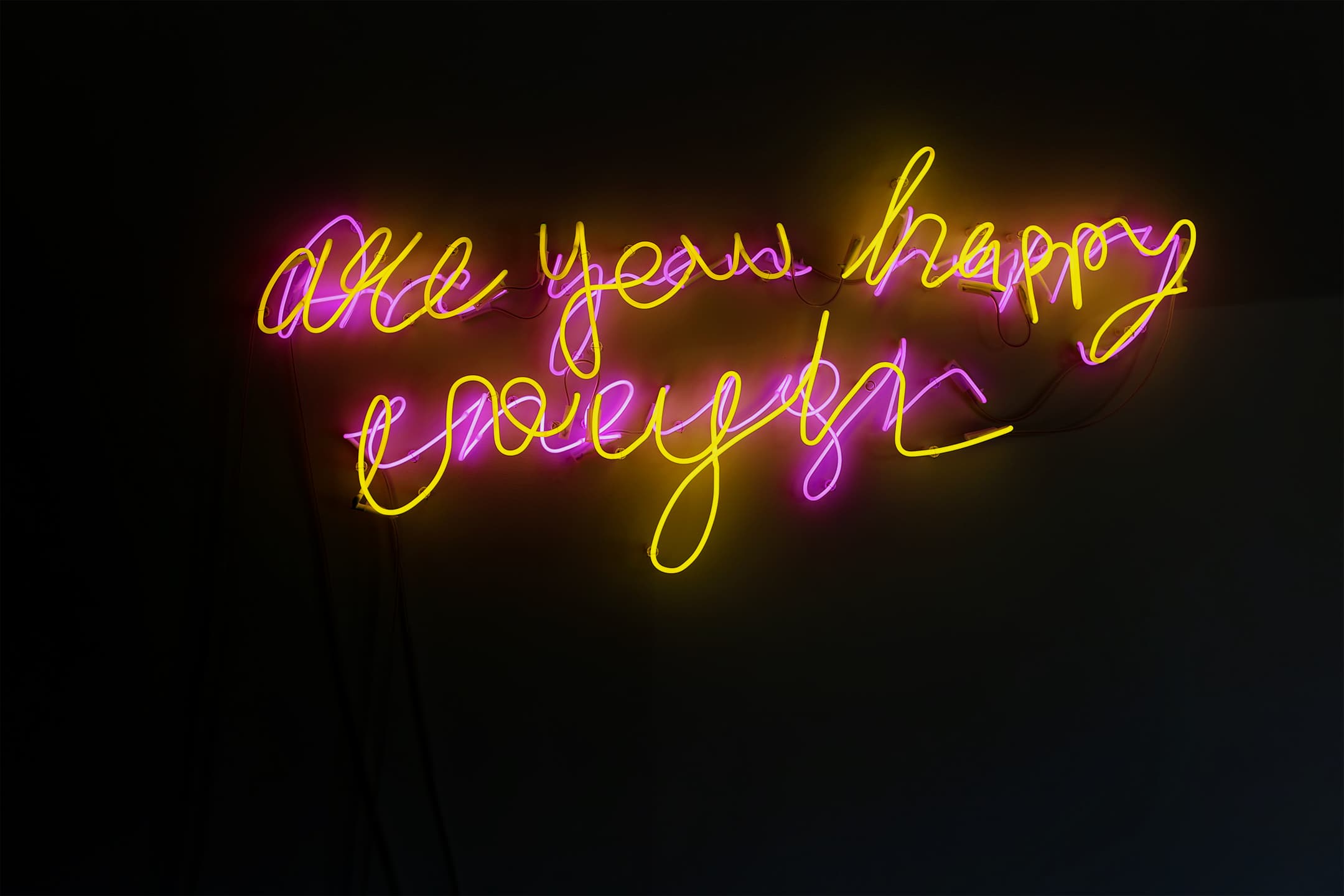
83% SATISFACTION GUARANTEED
LEGACY RUSSEL
LOUISE ALEXANDER GALLERY, PORTO CEVRO, 2015
JUNE 25, 2015 – JULY 26, 2015
The title of this exhibition says it all: 83% SatisfactionGuaranteed. What does it mean to be so close to feeling whole, to feeling happy—but not quite at 100 percent? In what way is ‘satisfaction’ not just a goal, but a socio-cultural metaphor? The idea of satisfaction here operates as a vehicle for capitalism, existing as a media-infused corporate substitute for intimacy as it relates to the construct of desire within the public arena. ‘To be satisfied’ is both a statement of satiation, connoting completion and finality, but is also one steeped in the generic as it borrows from a language of the institutional, inherently mediocre and therefore, paradoxically, eternally dissatisfying. Thus such a statement is simultaneously about being whole and also being hungry for more. Are you happy—are you happy enough?
In :mentalKLINIK’s ‘Airless’ we see copper sculptural casts of their vinyl character counterparts, divorced from their functionality of childhood pleasure-provision in their deflated deformity. Appearing crushed and distorted, these works leave their full potential to be only imagined, codependent commercial objects of playtime-past, waiting to have life breathed into them. The room’s centerpiece, ‘Moët’ is an oversized muselet, a jungle gym of luxury resting on a floor overlaid with a glittering carpet installation (aptly titled ‘CandyCrash’) patterned with lollipops and wrapped sweets. With Moët only part of the whole is present, again leaving the viewer to imagine the rest: the violent pop and orgasmic sigh of a cork being dislodged, the froth of bubbles drooling from the cool mouth of a glass bottle, the clink of expectant glasses.
In the artists’ sumptuous ‘PROFILE’ series we see layered solar reflective films and candy-colored neon with a scale and form that hearkens to the composition of commercial sandwich boards. The material here is key to note: with solar film being used to save energy and also create privacy when placed on otherwise transparent surfaces, these works float in the discourse surrounding both renewable energies, as well as privacy and security. Here the viewer is confronted with a poetic play of words, letters that at first glance seem to be a jumble of nonsense, but with a second look take on a critical lyricism as meaning rises from the chaos. FASHIONABLE. TIMEBANKER. CONSTITUTIONAL. TERRORIST. JEZEBEL. CELEBRITWIT. CAKEBOY. These words call out to those looking on, a siren song that enraptures, each word recalling a symbol, making one conscious of cultural archetypes, stereotypes, and constructs. These symbols fill out the room, crowding the gallery with phantom bodies, whispering economies, dogmatic ideologies.
Such whispers heighten in volume with a series of hand-drawn text pieces that further confront the viewer and insistently inquire, ‘Are you satisfied enough’, ‘Are you popular enough’, or ‘Are you rich enough’. These questions, removed from their implied question marks, become pronounced declarations of a lack, a wanting, underscoring the oft-unspoken obsessive anxieties of a culture made self-conscious via the machinery of commercialism and subsumed by superficial values. The moving lights of window vitrine installation ‘WOO-OOO’ provides an occasional spotlight with its dance, the viewer bathed in light and thus briefly exposed in that instant, before being left in the shadows once again.
Functionality—or lack thereof—is a core aspect of :mentalKLINIK’s 83% SatisfactionGuaranteed. These objects are fantastic failures that cannot perform their duties and so leave us desperately wanting more. Each is heavy with the burden of artful cosmetic and eternal aspiration. Disjointed words, playthings that cannot be toyed with, beautiful lambent bodies that are incomplete, mute instruments that tempt with their gold and gaud. This near-transcendence suspends us in the honey of 17 percent, nearly arrived at a final destination, but never whole.